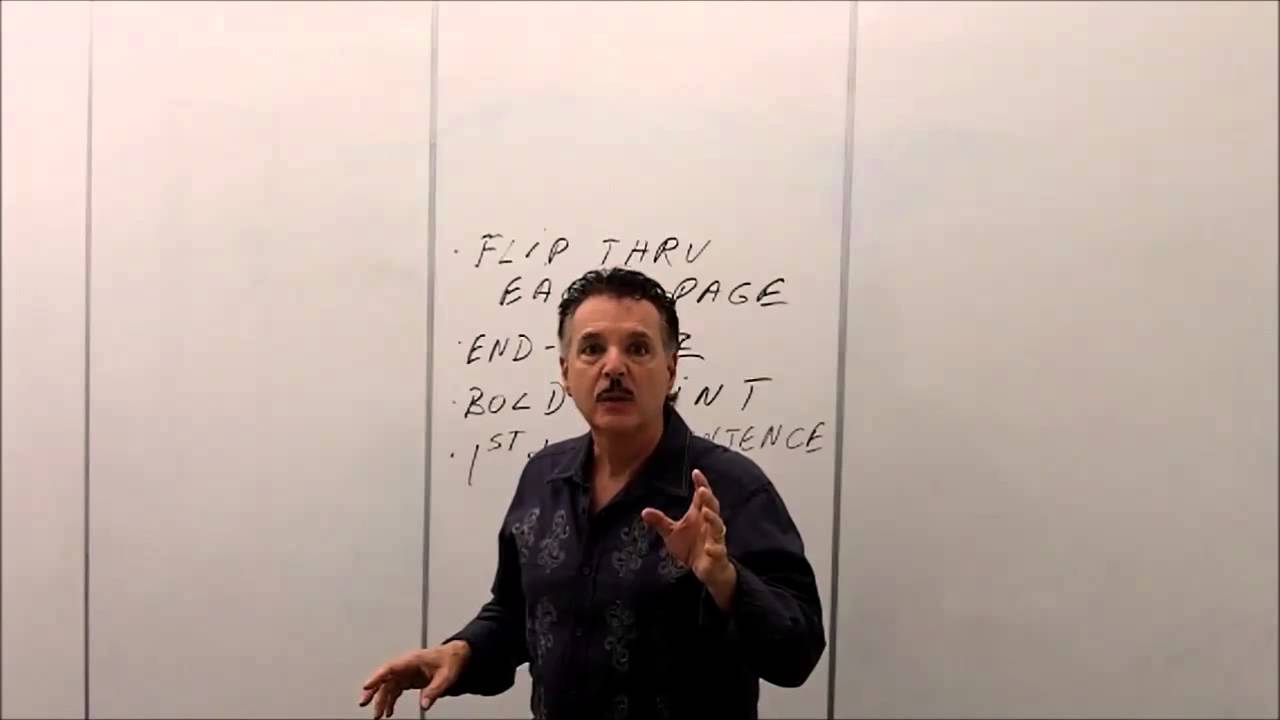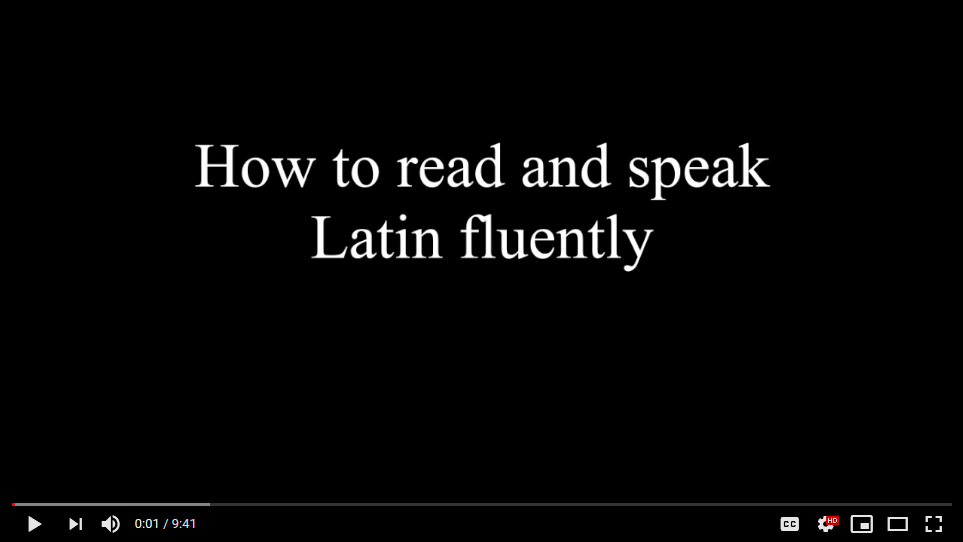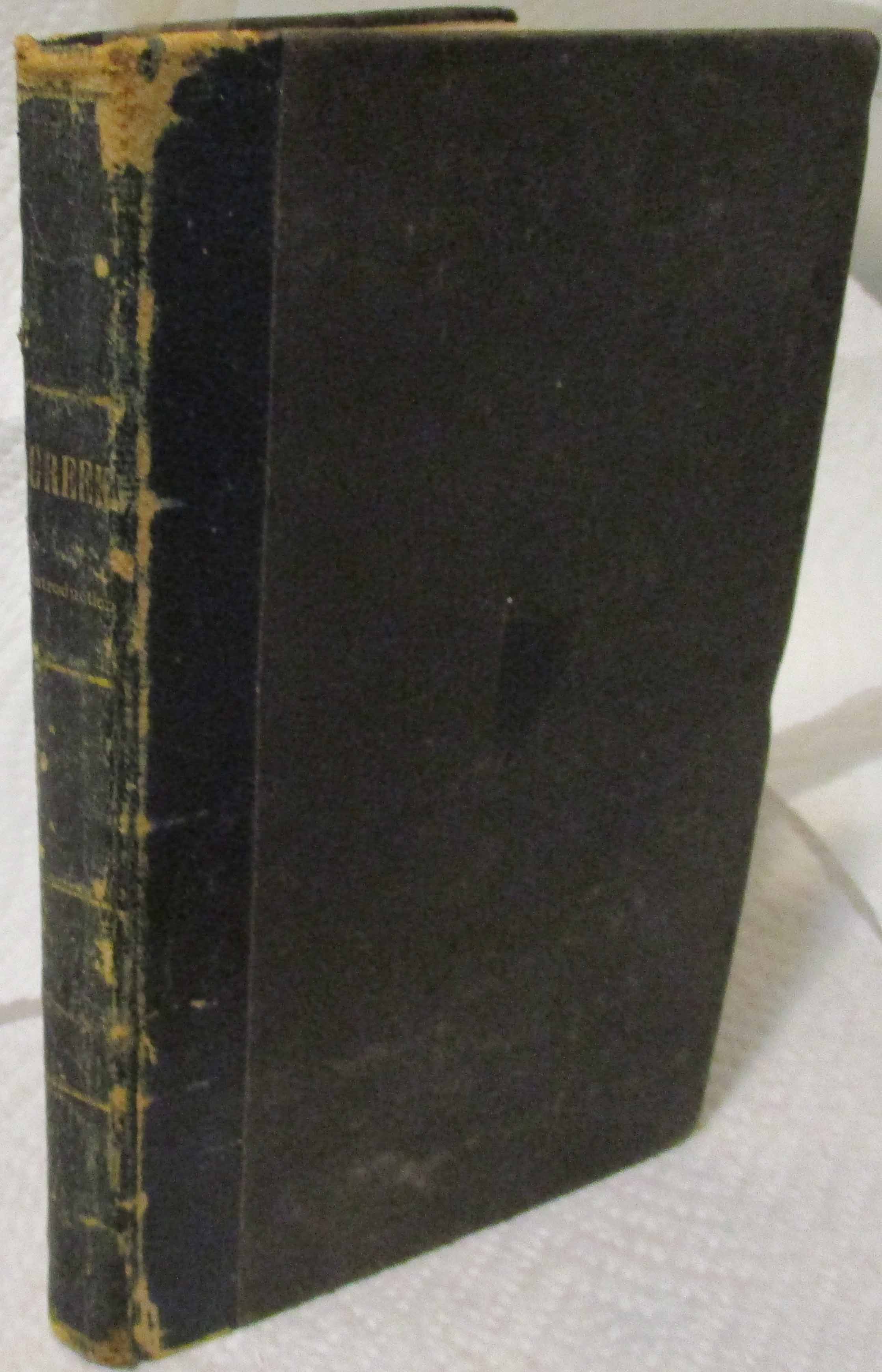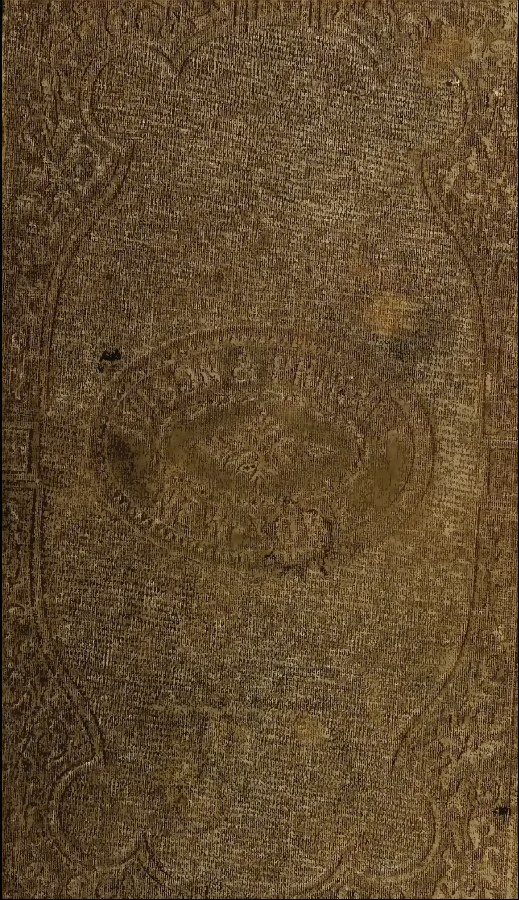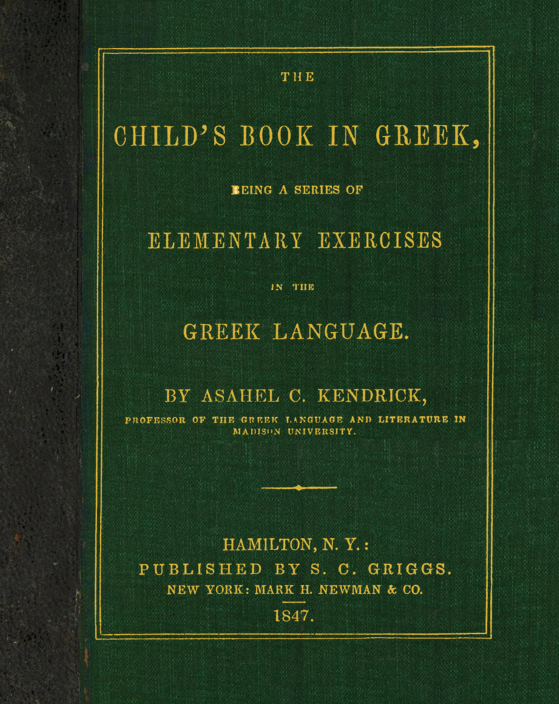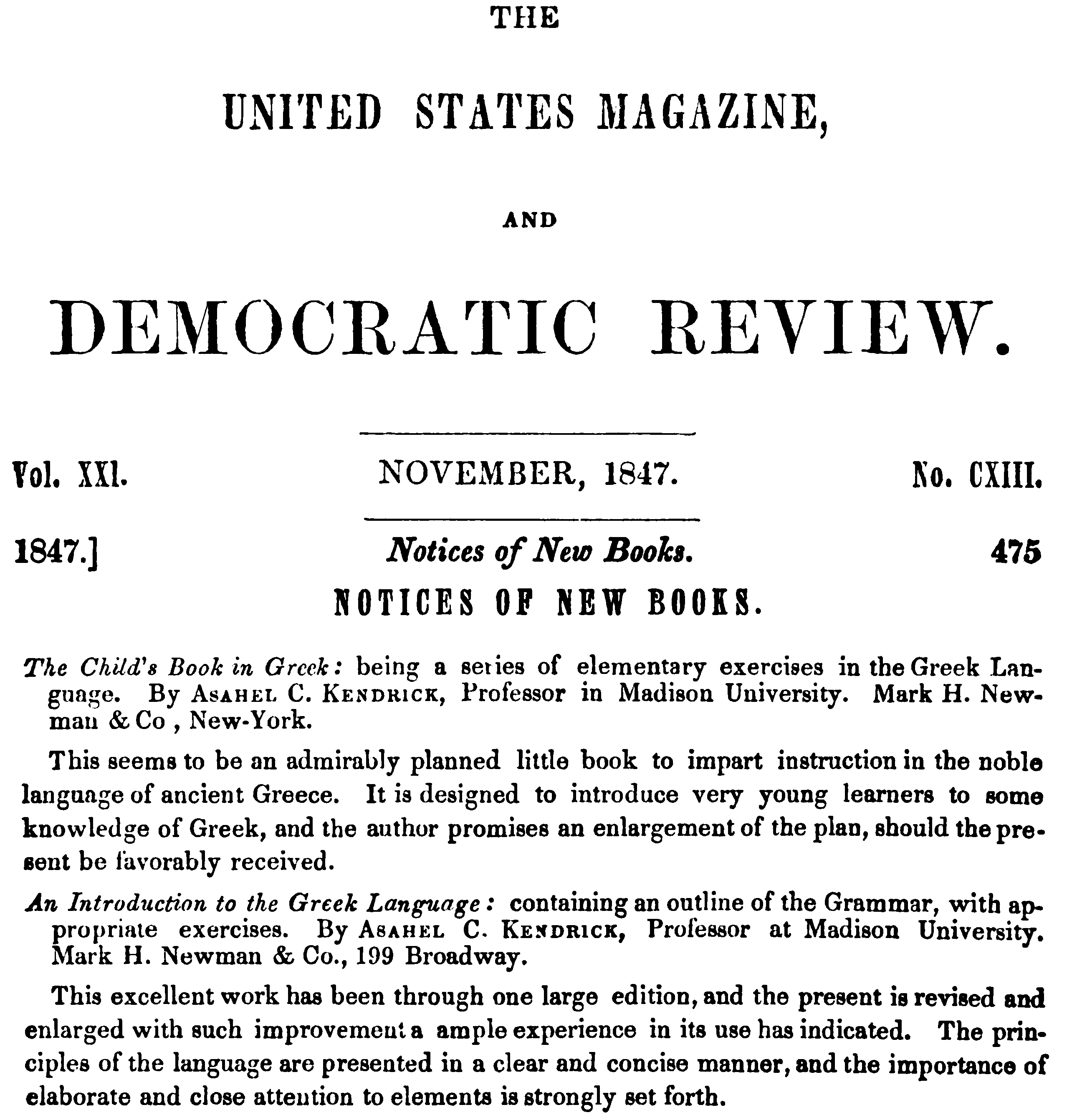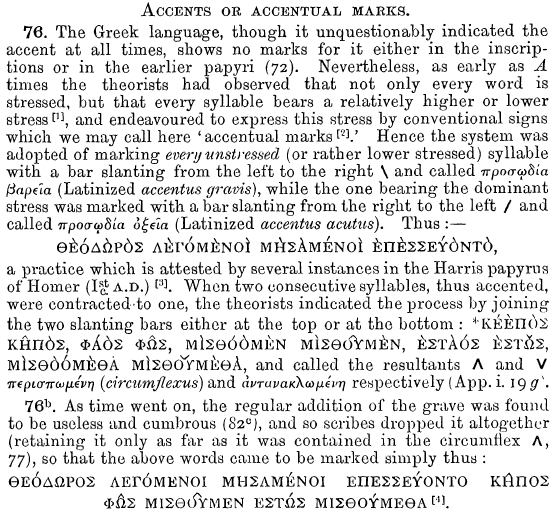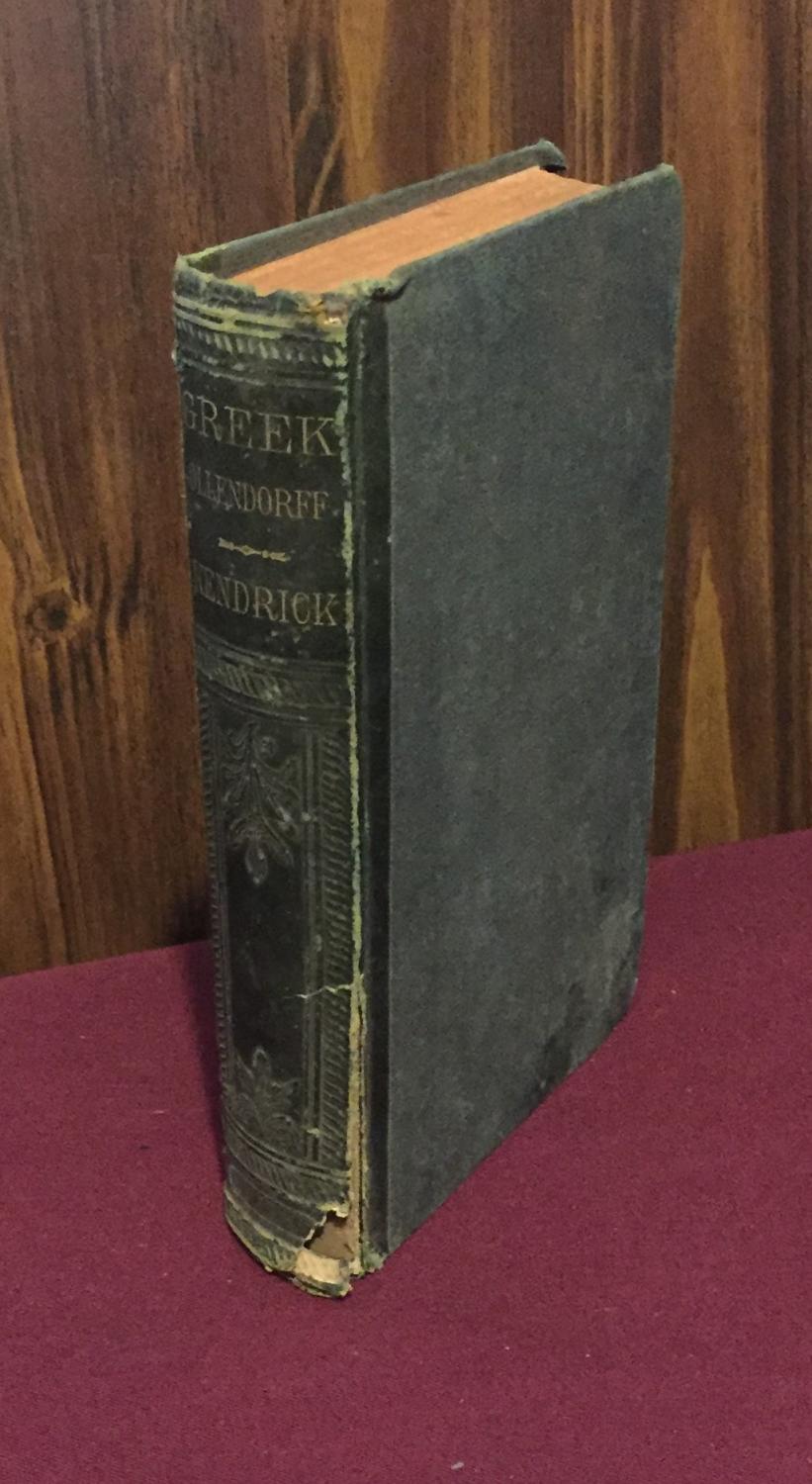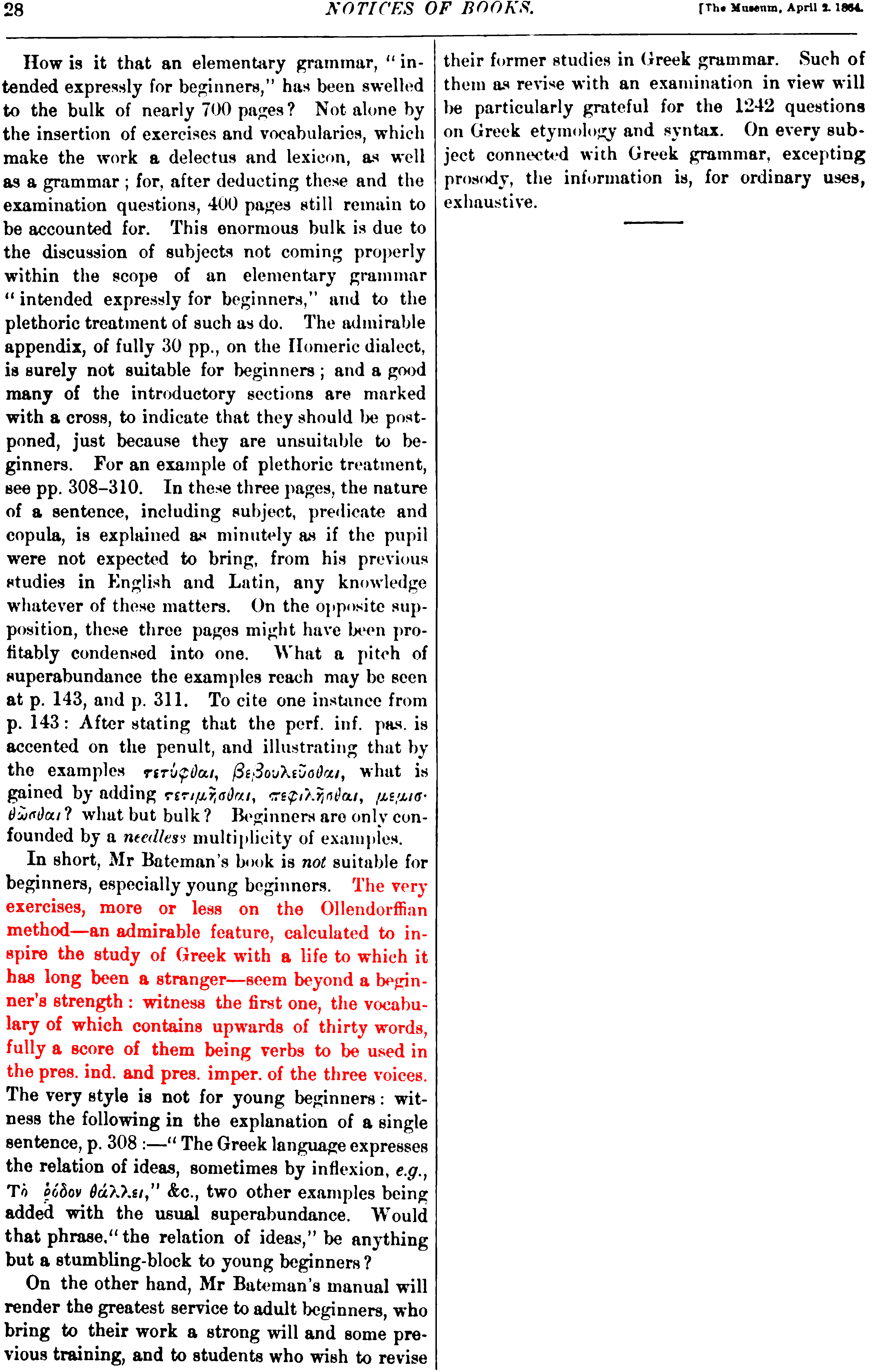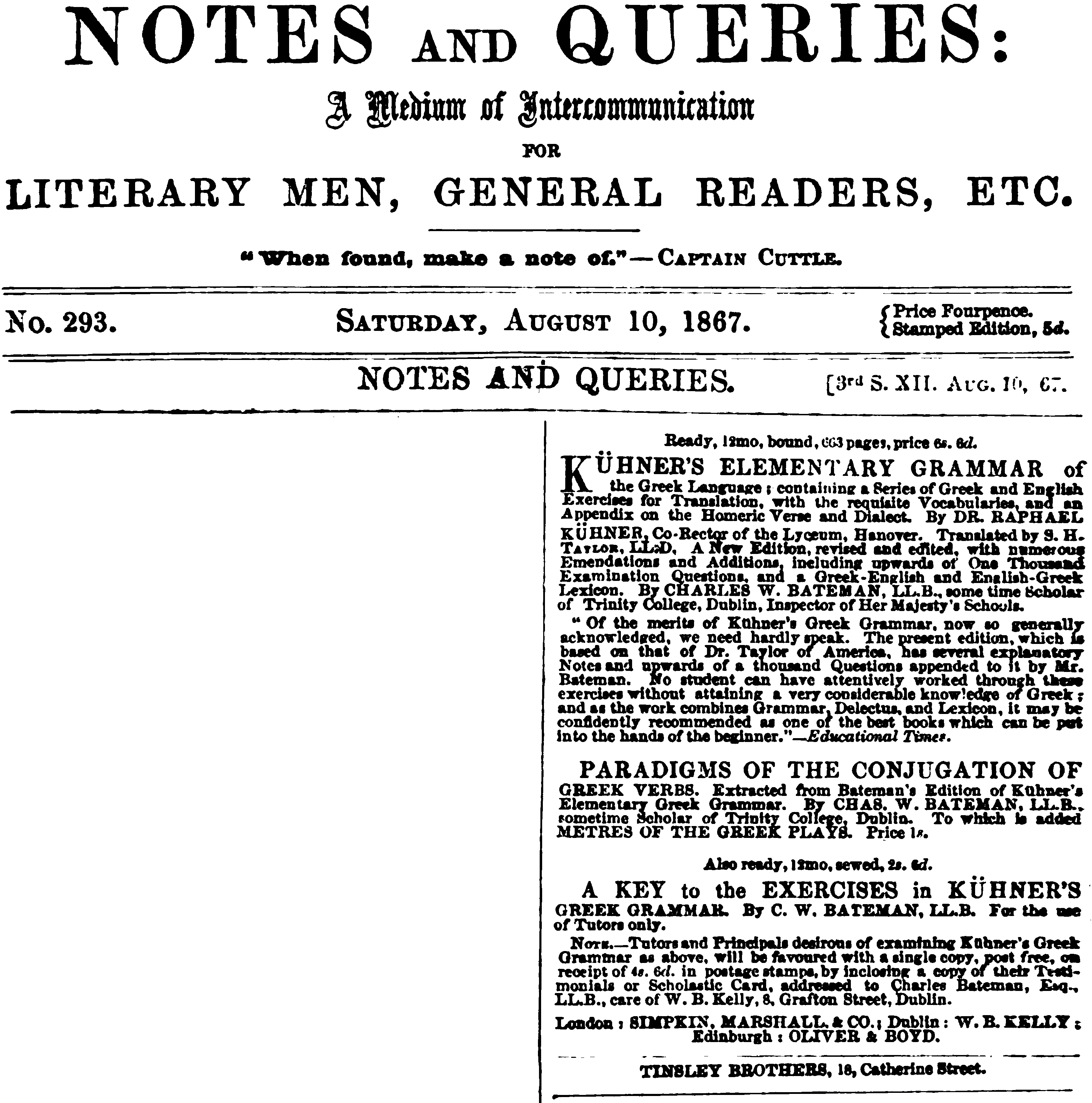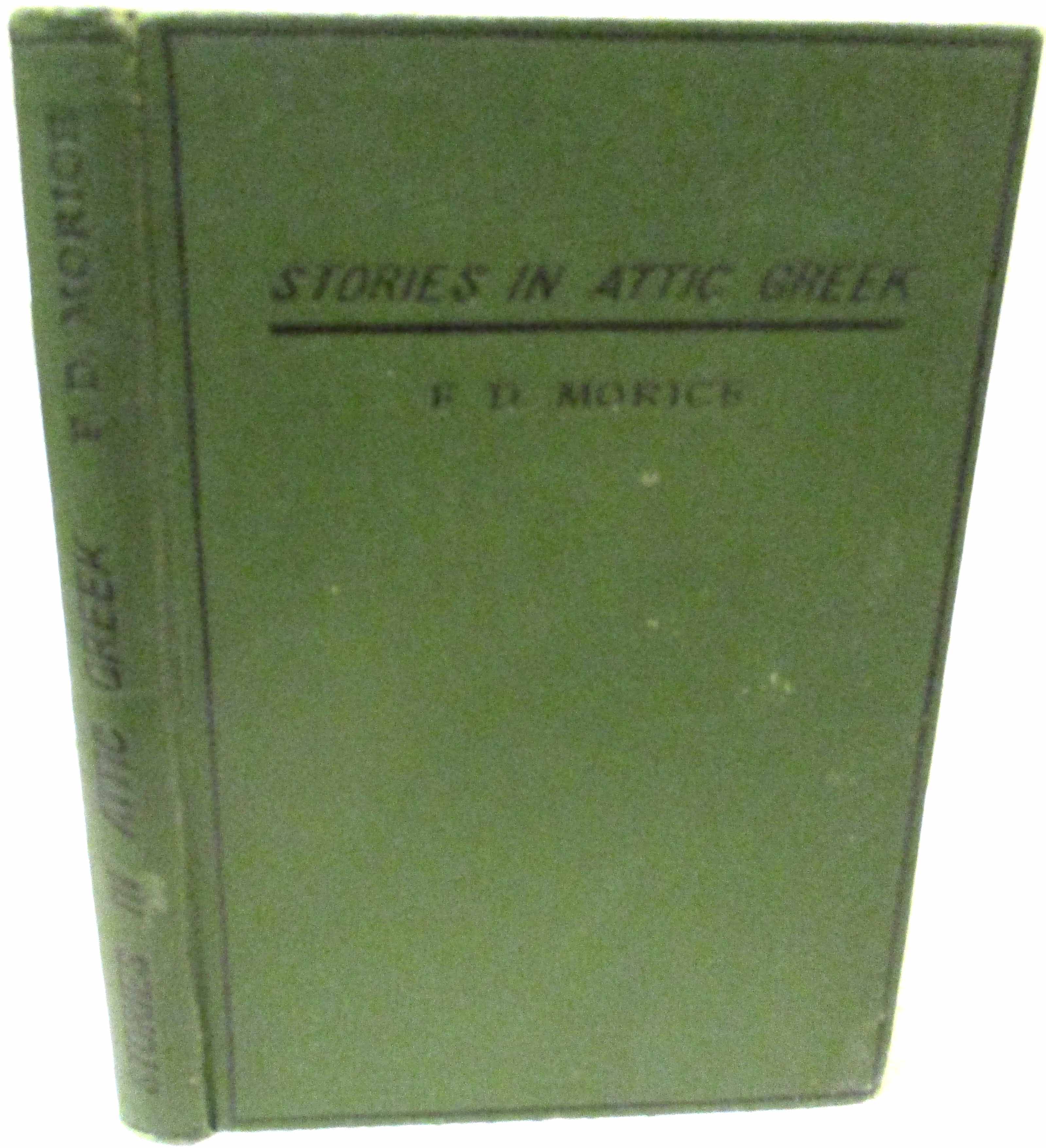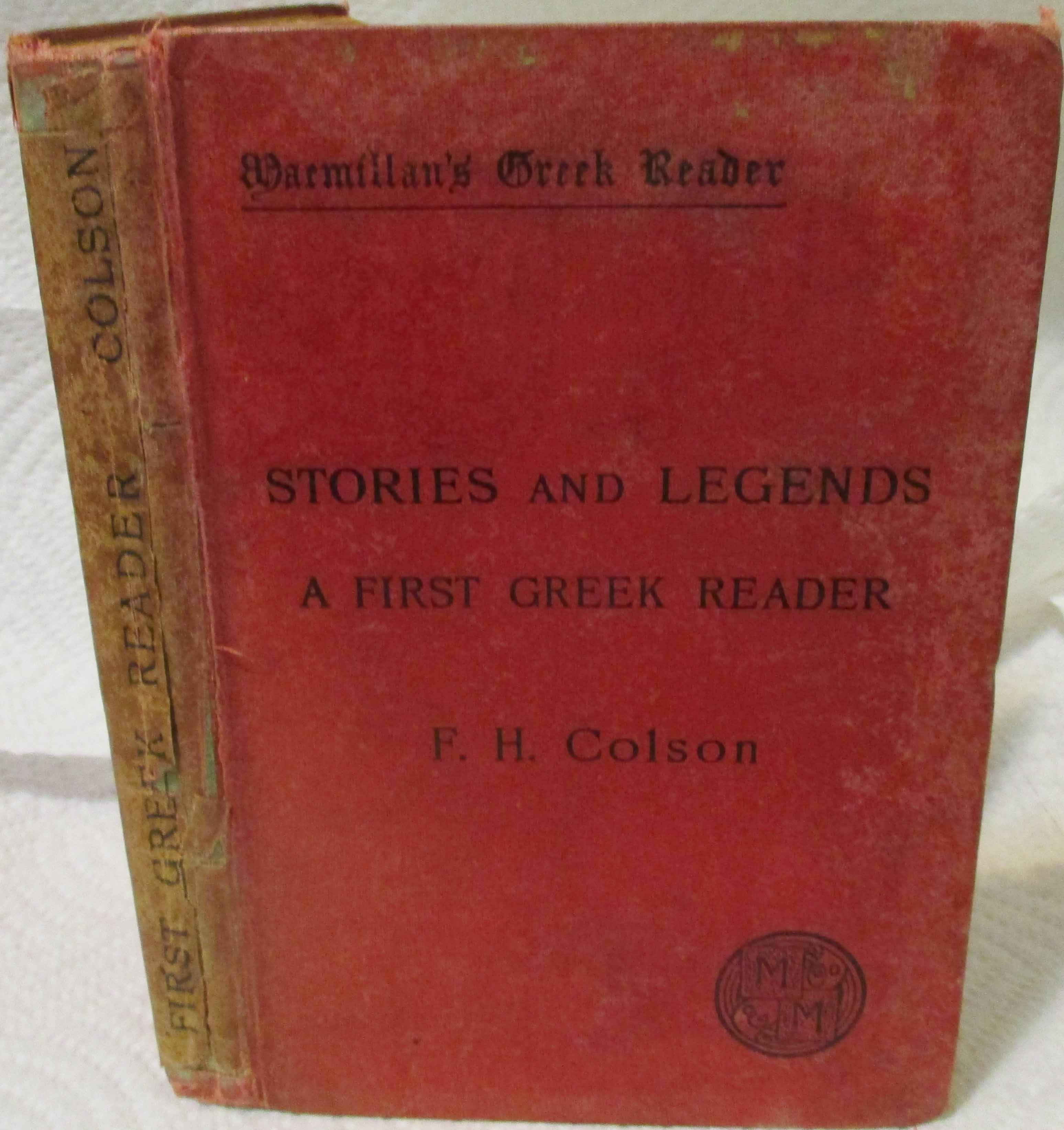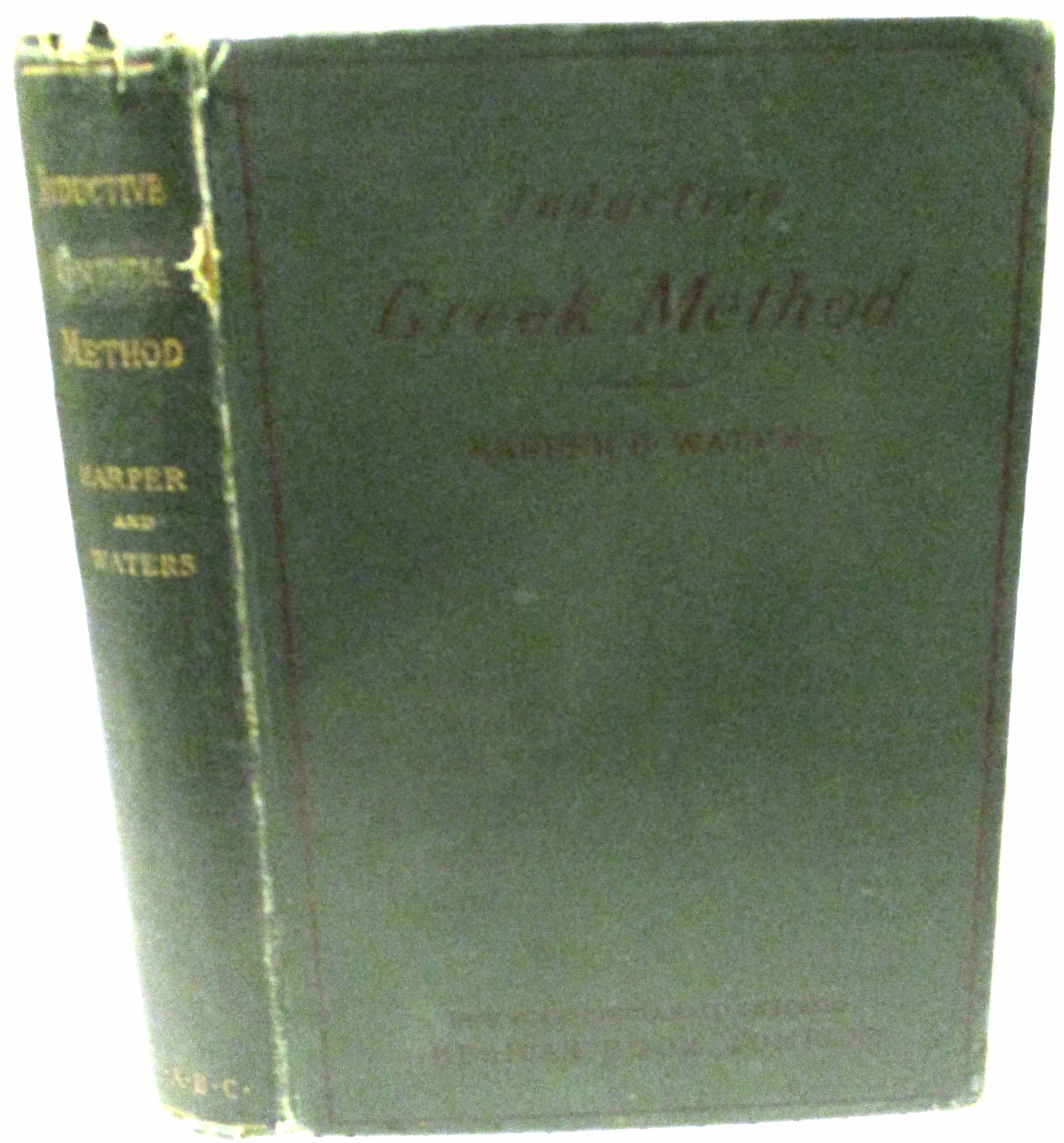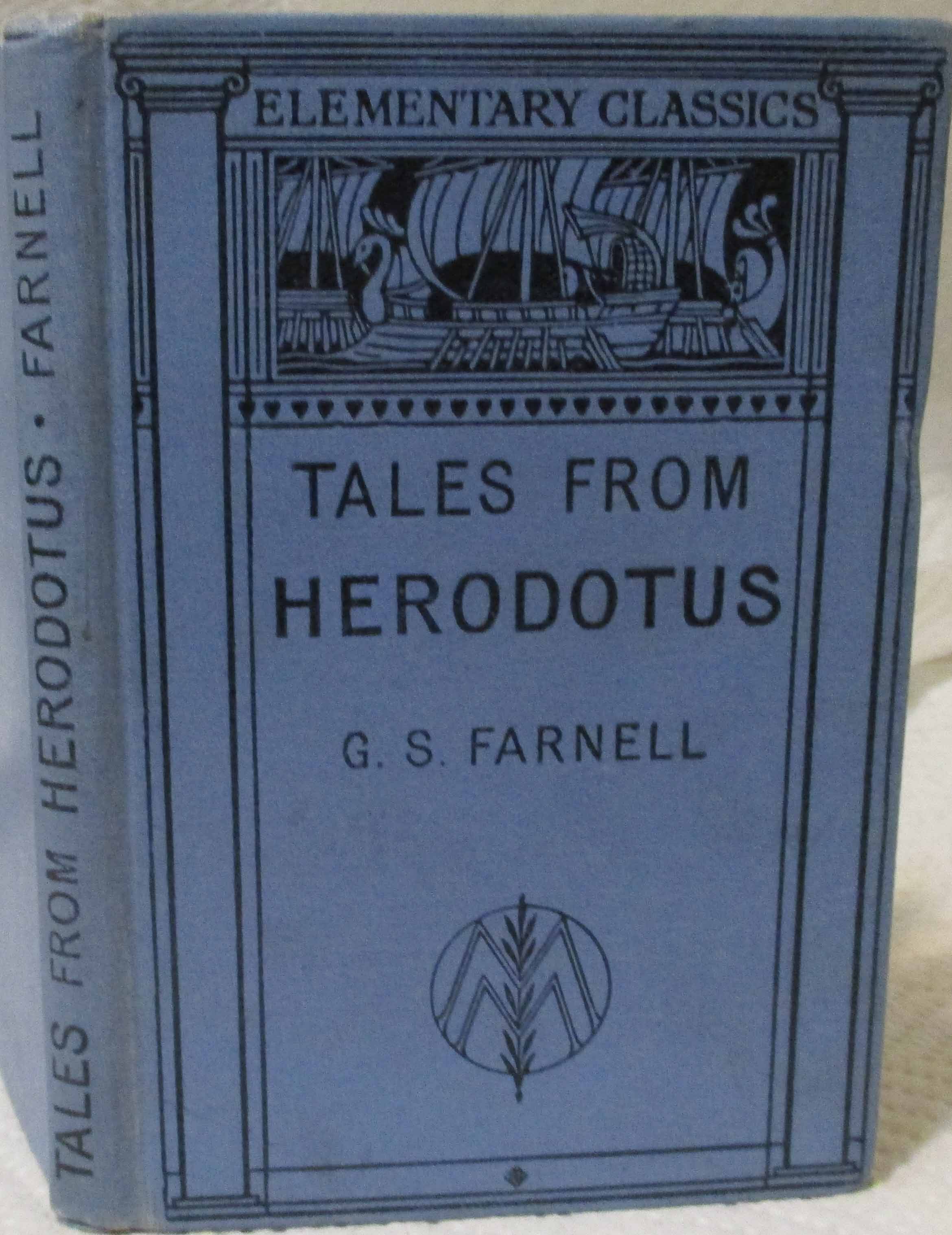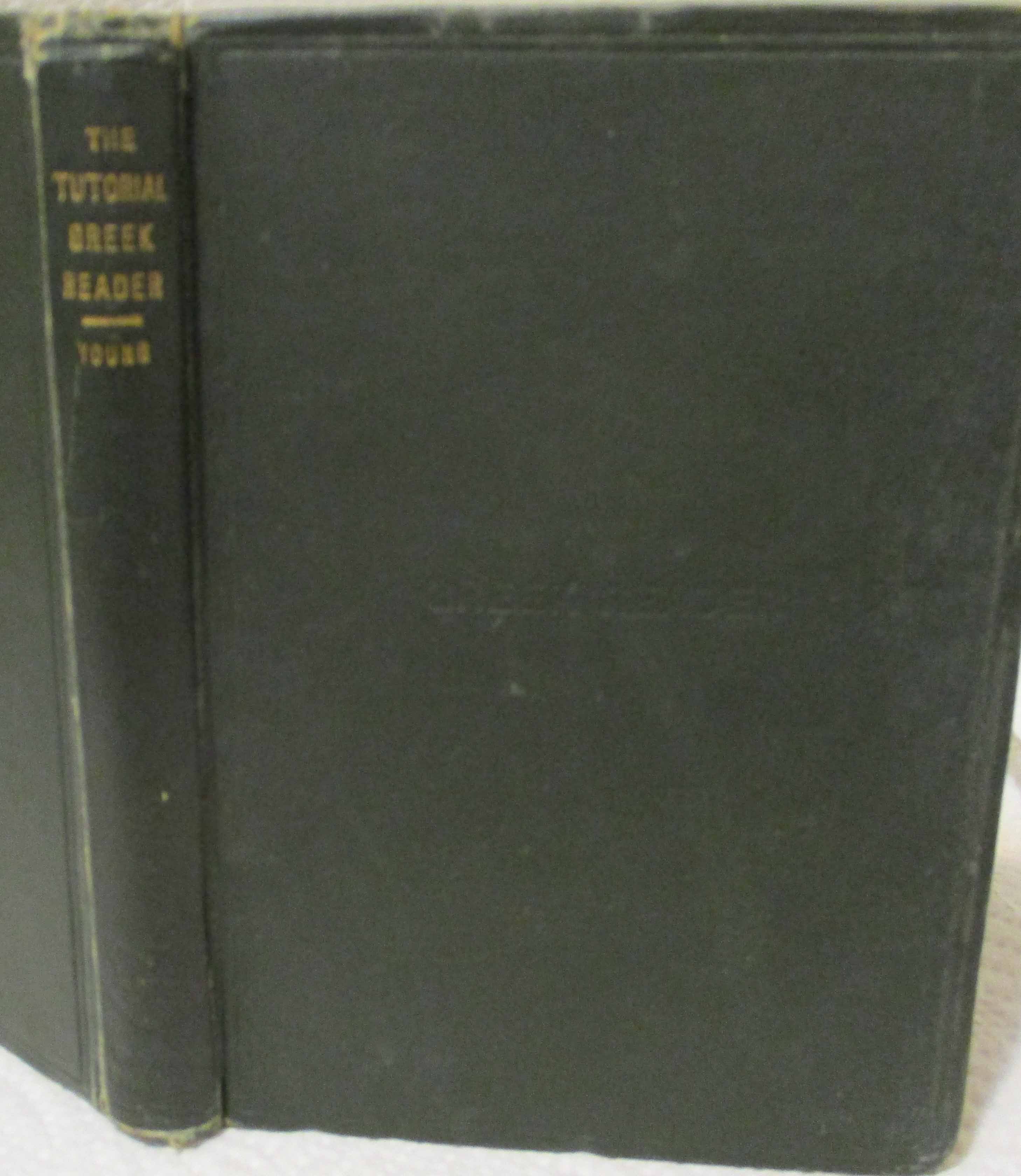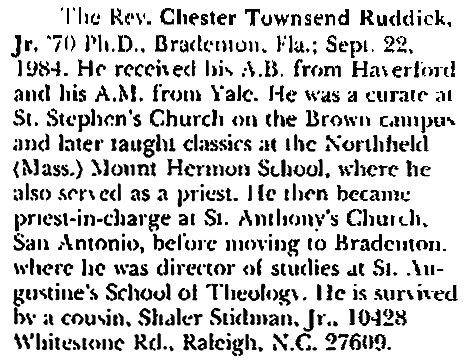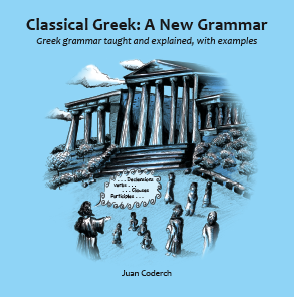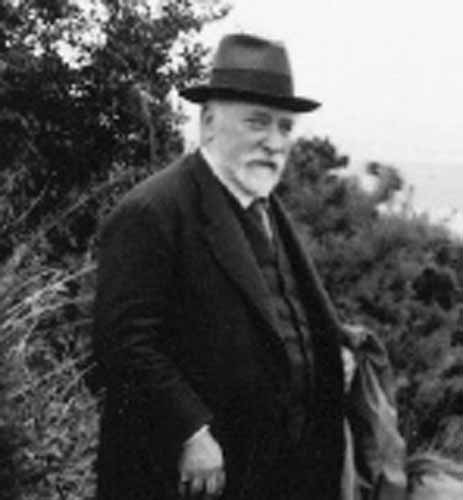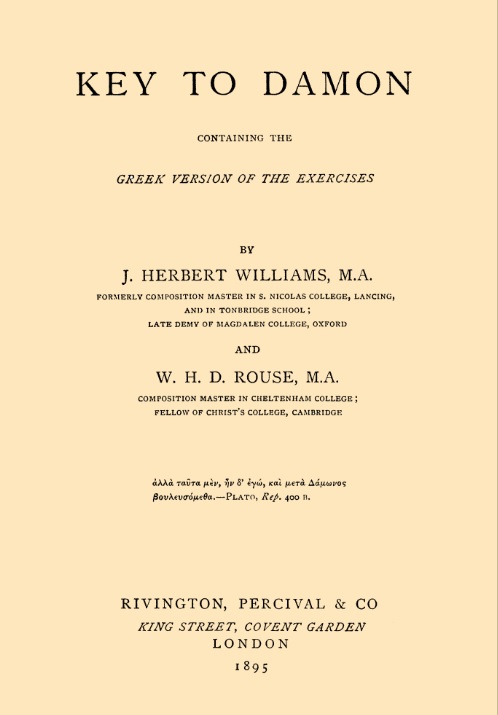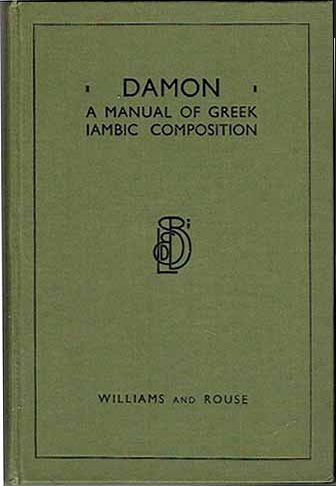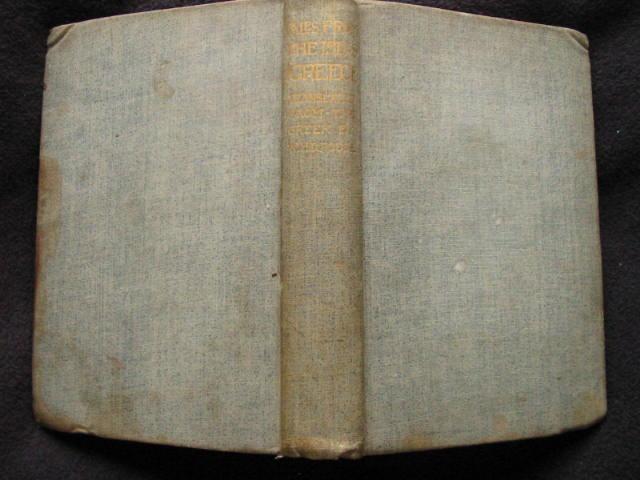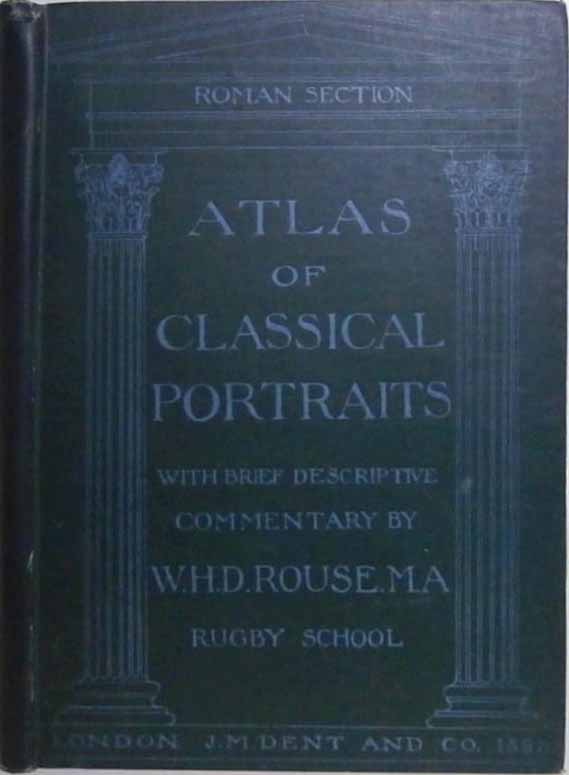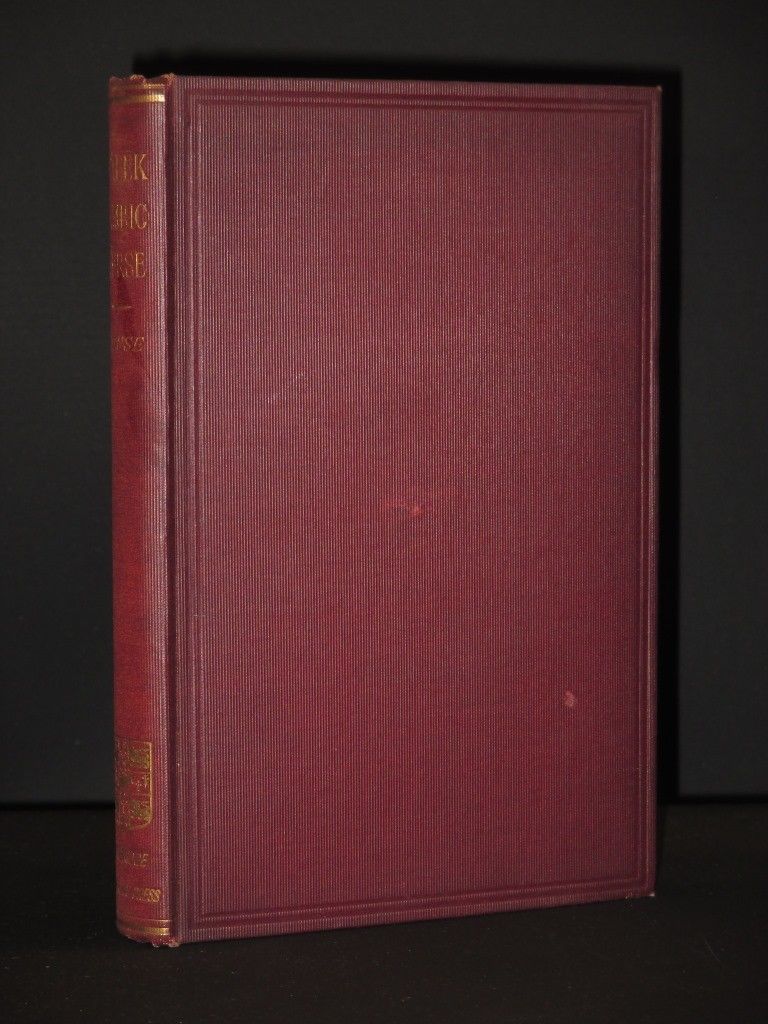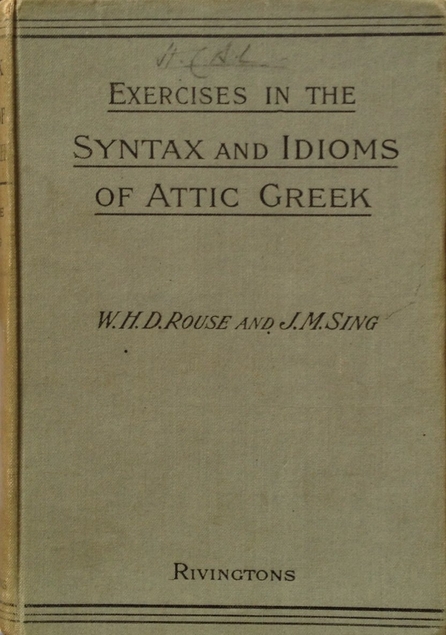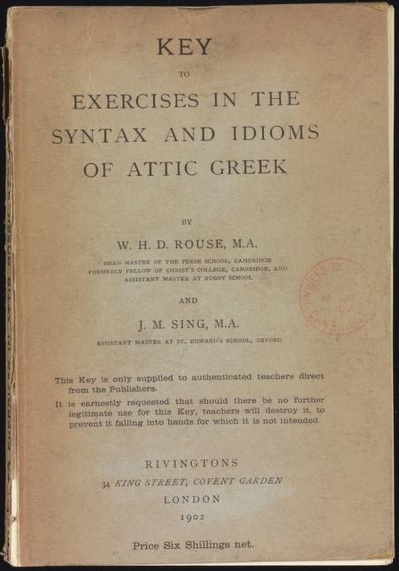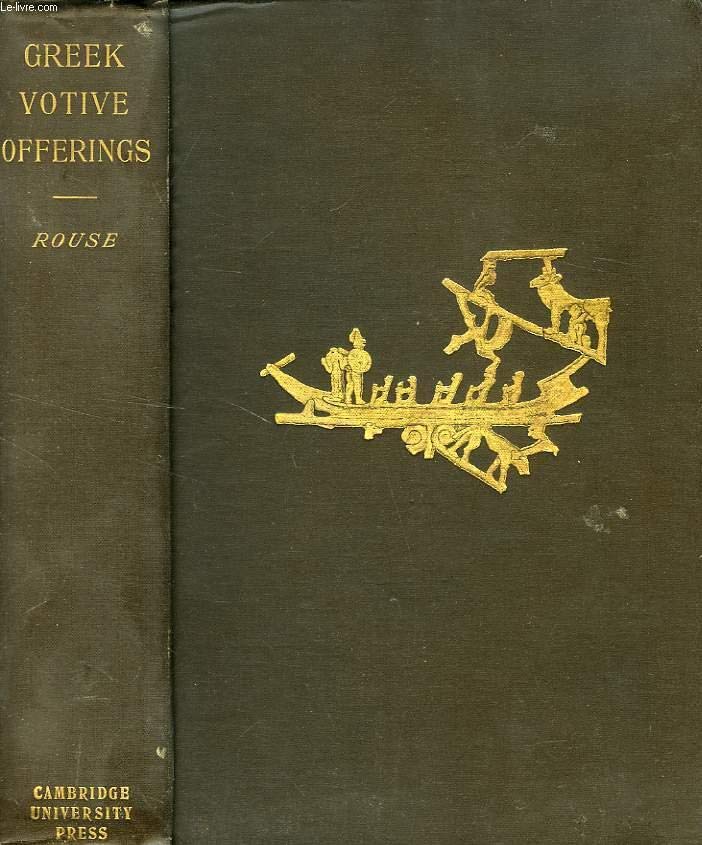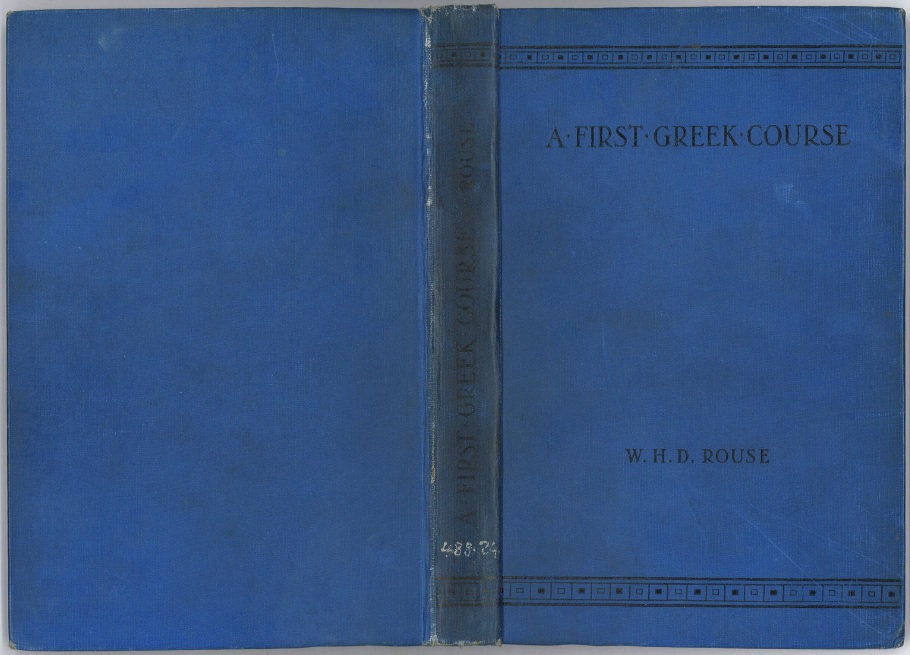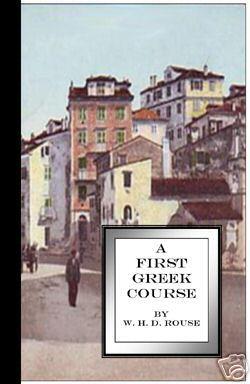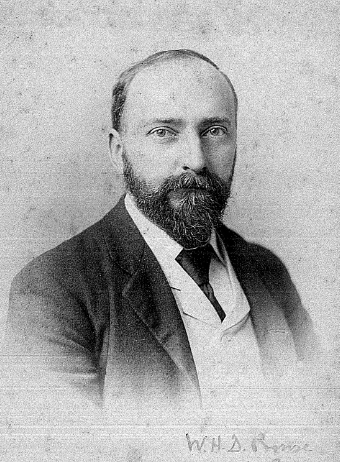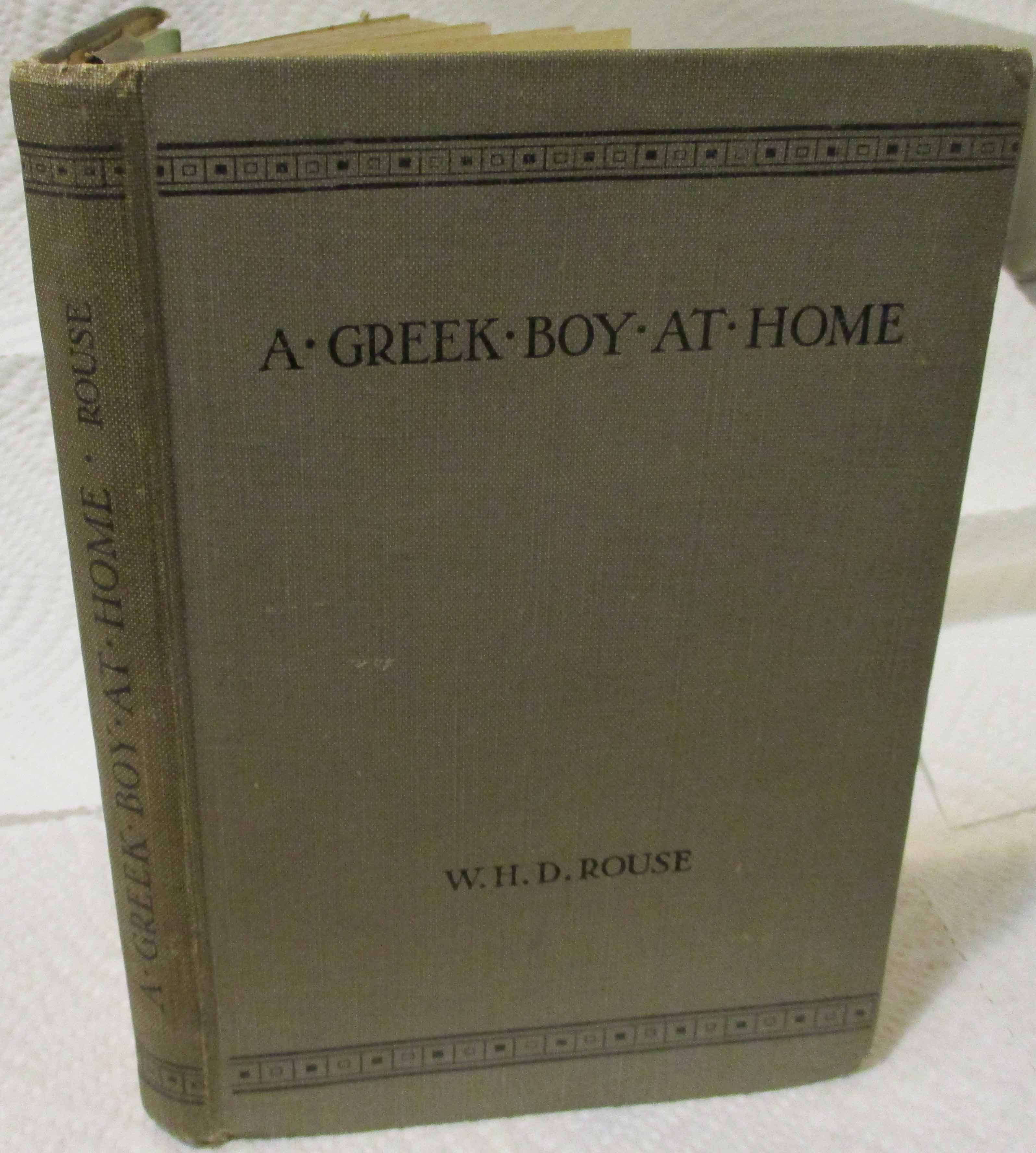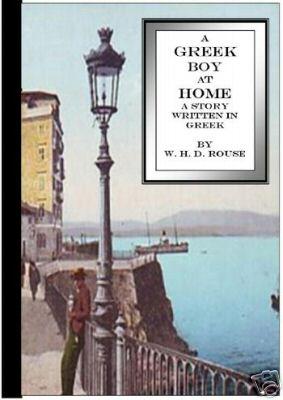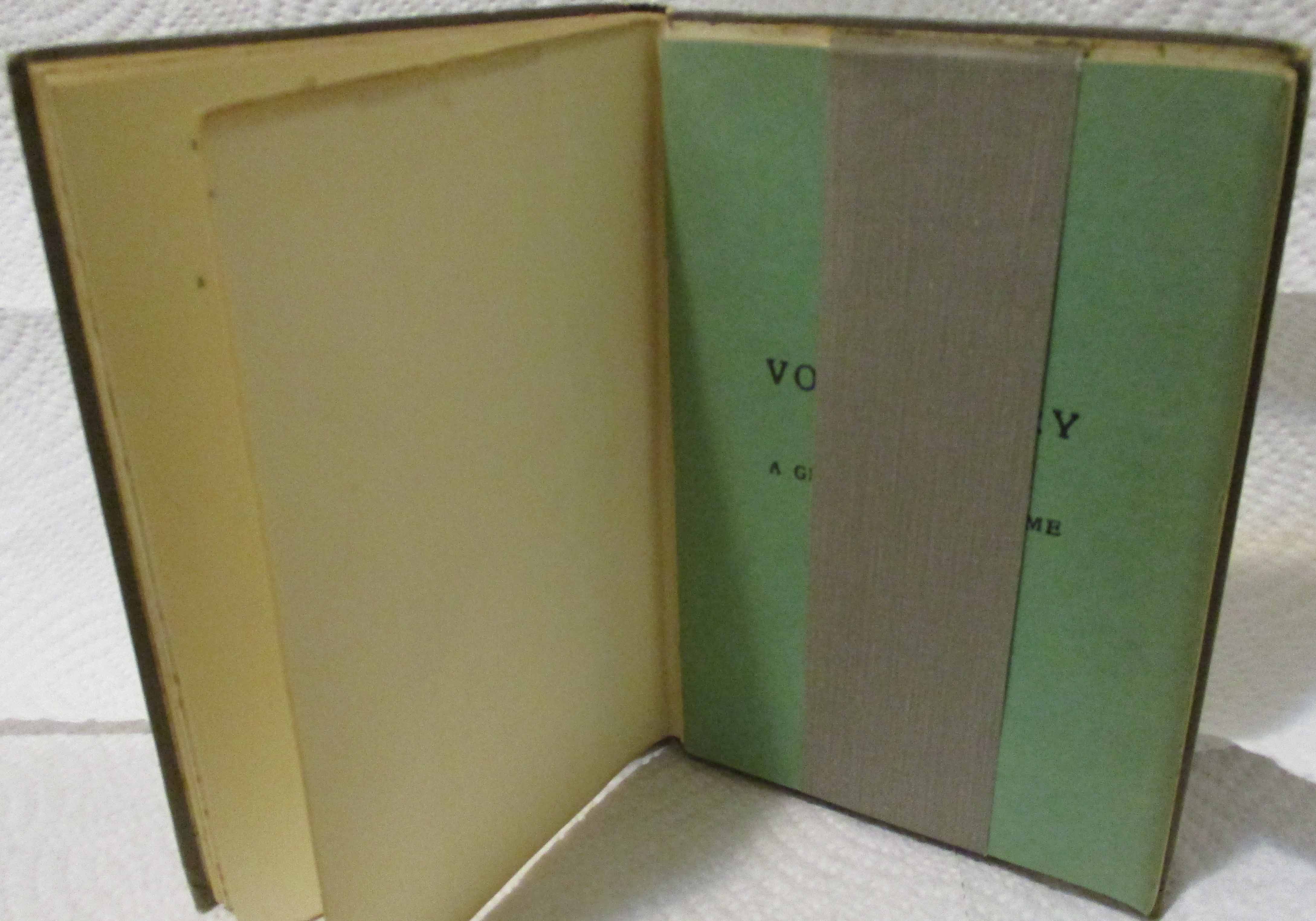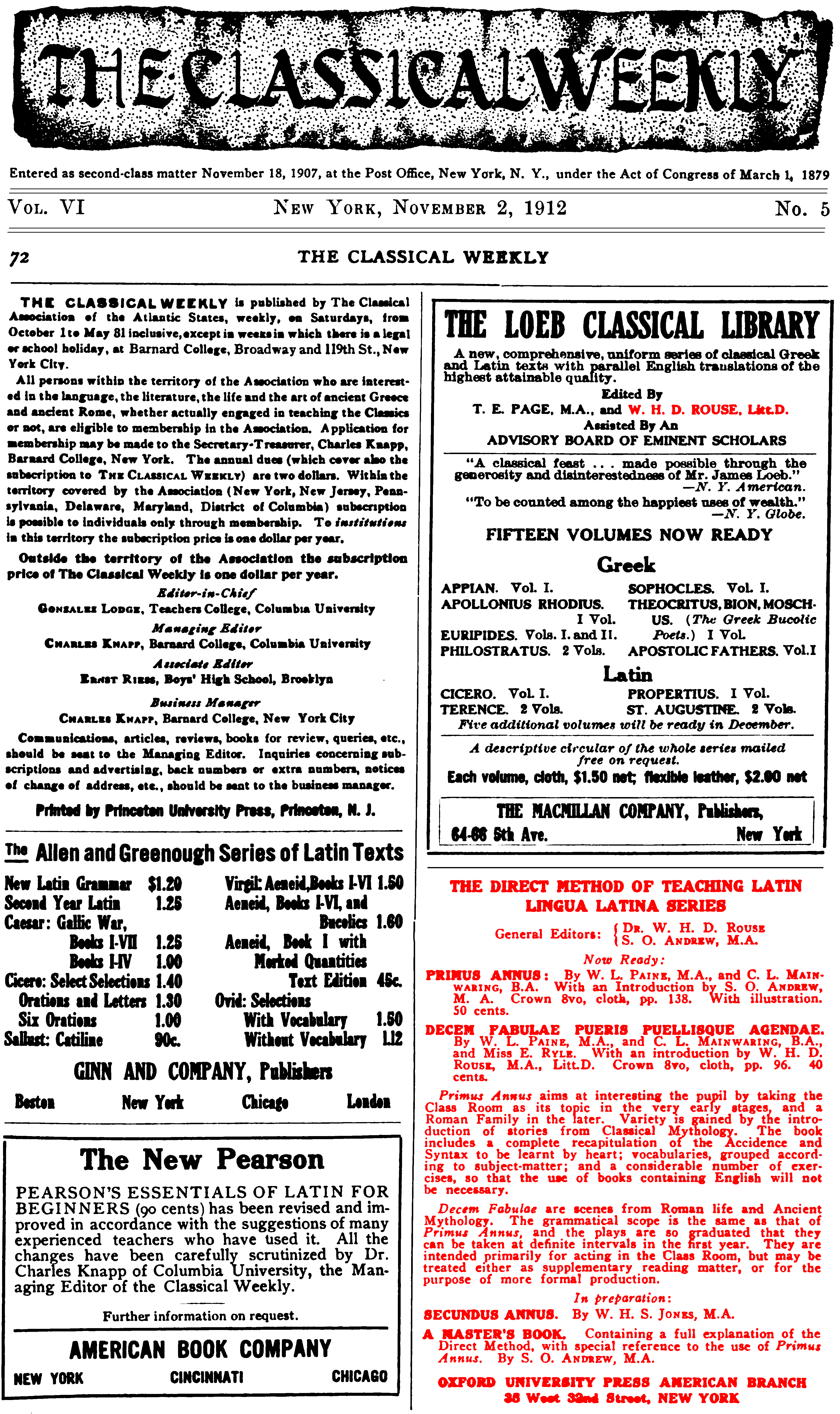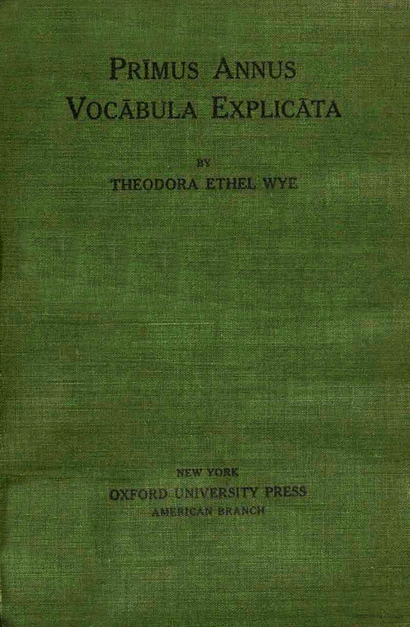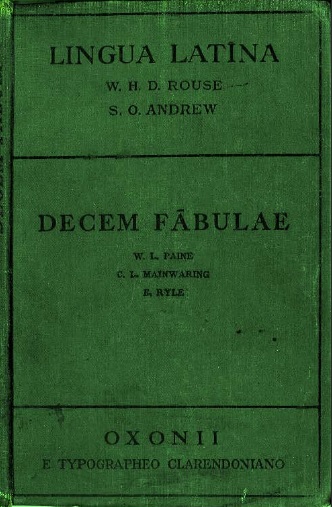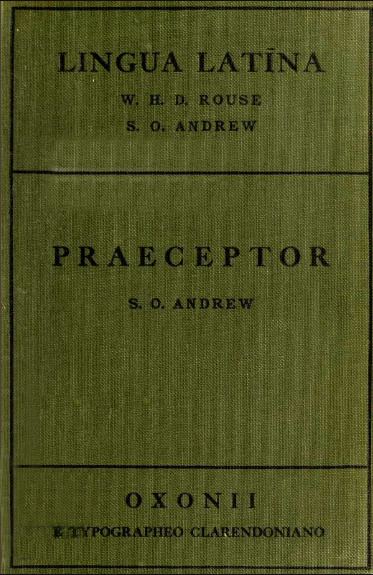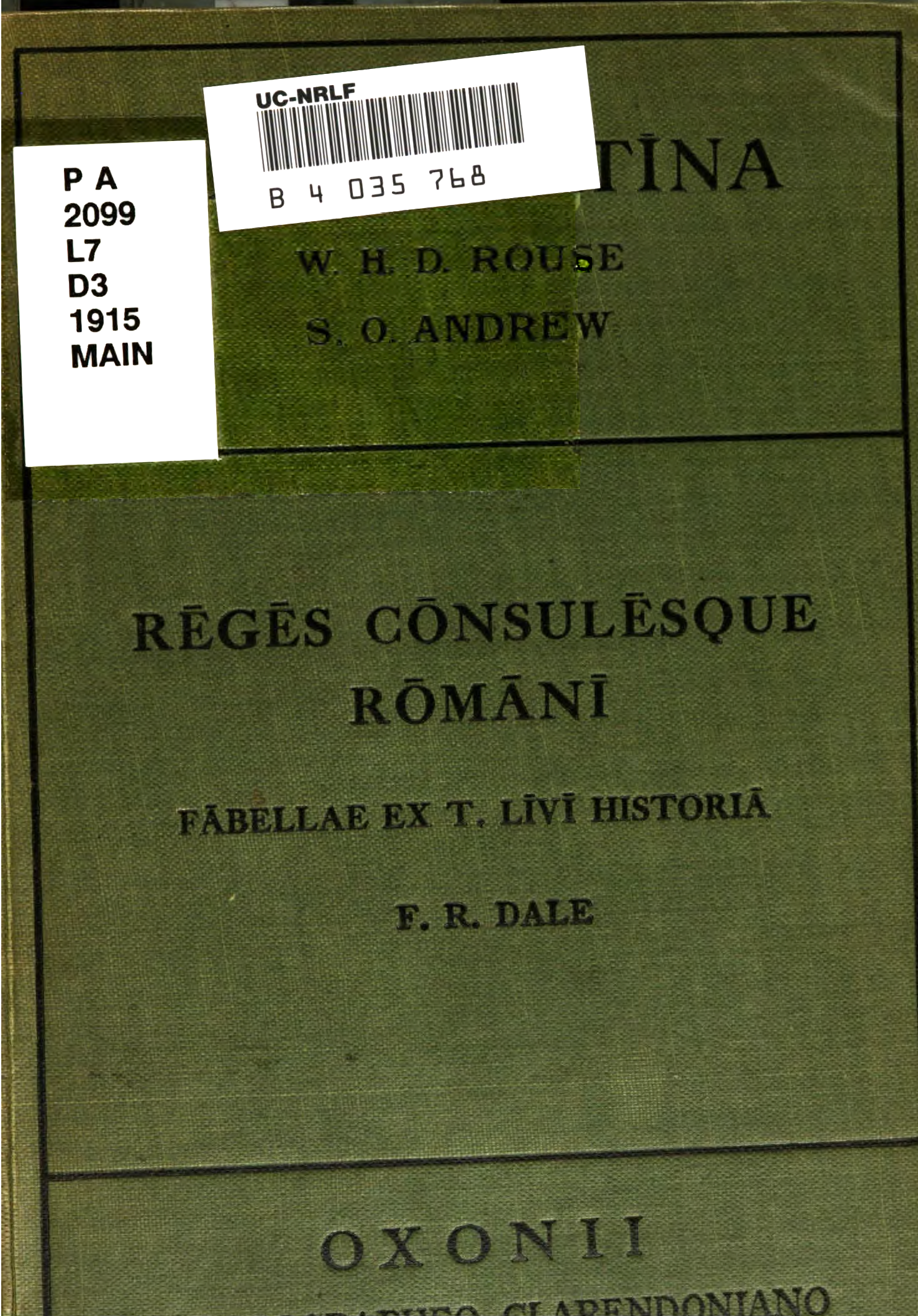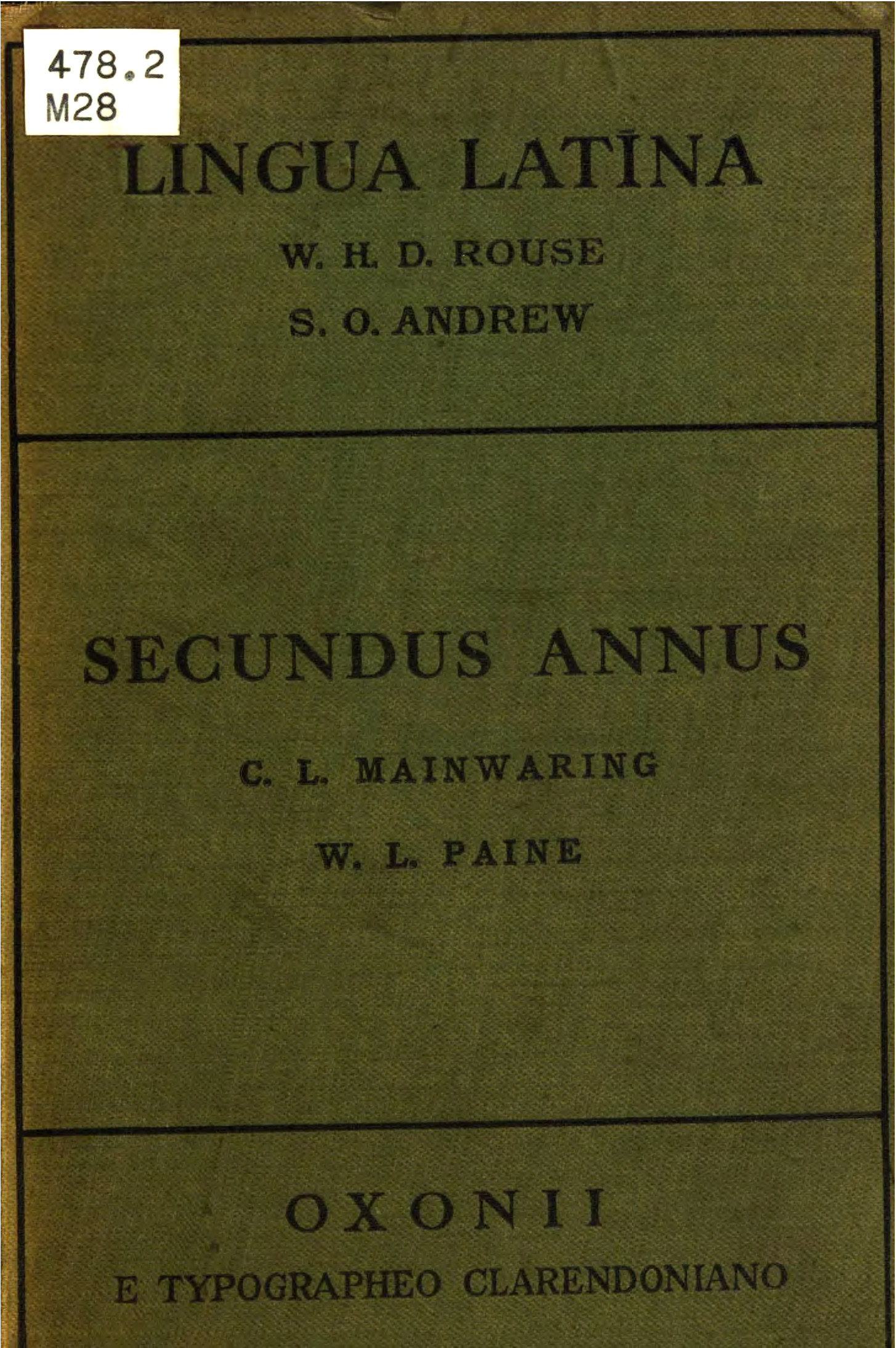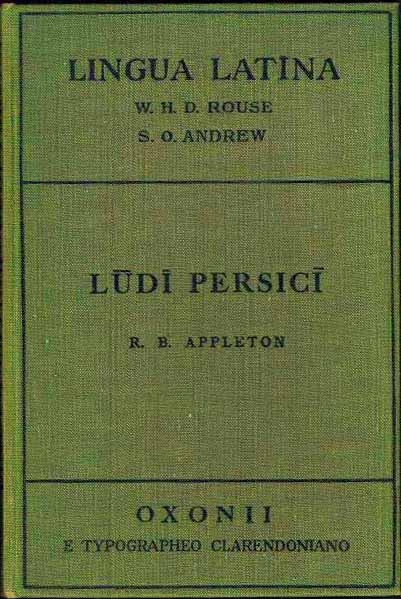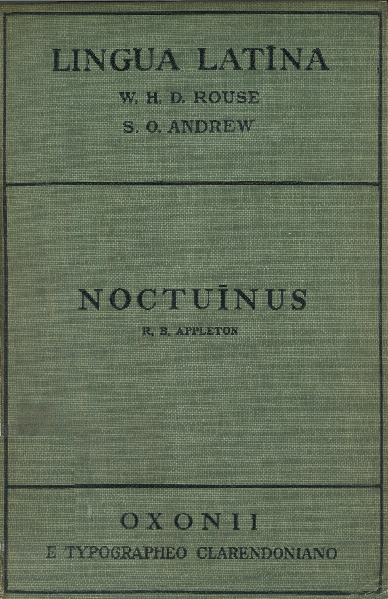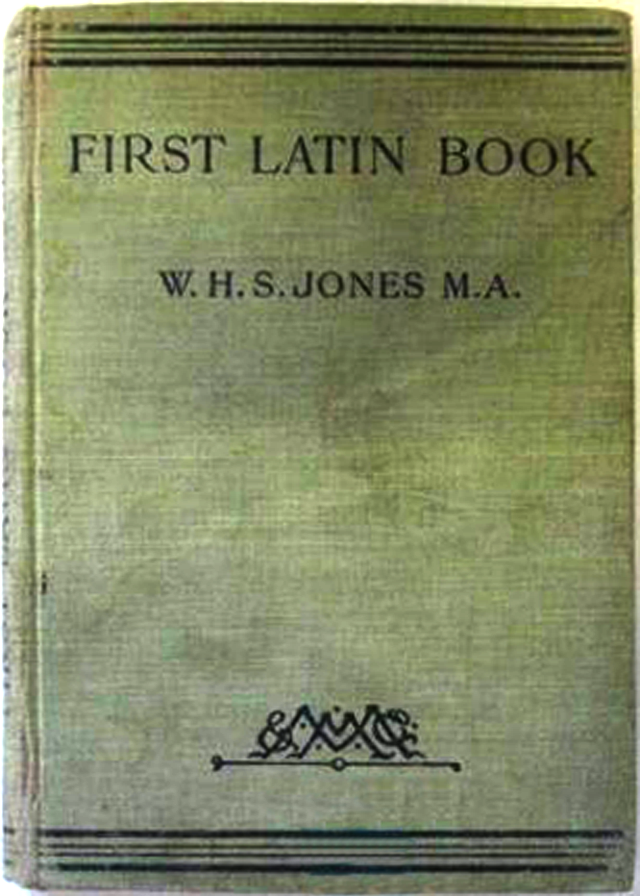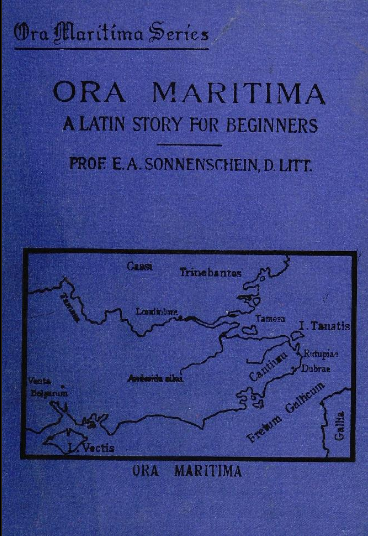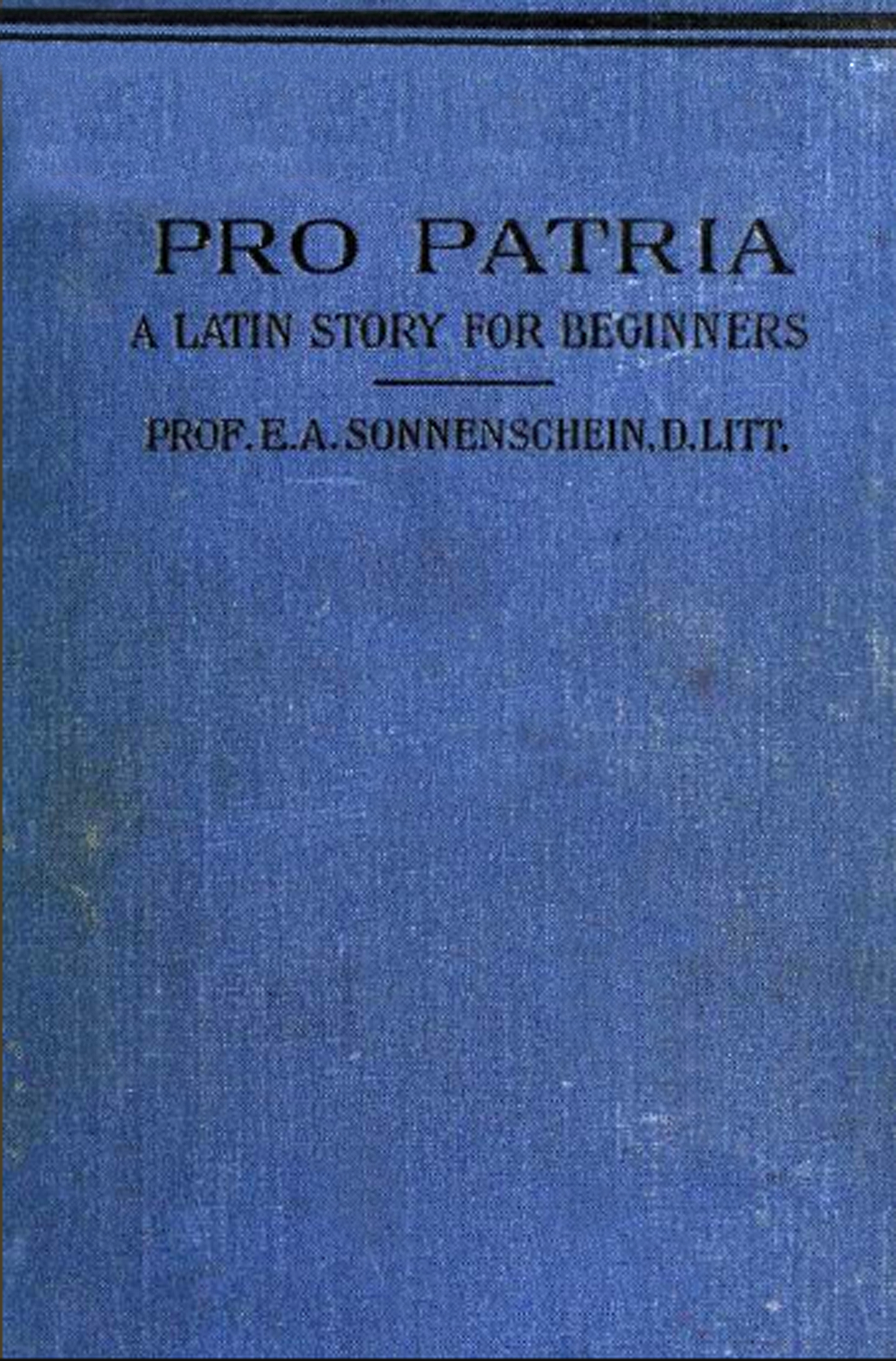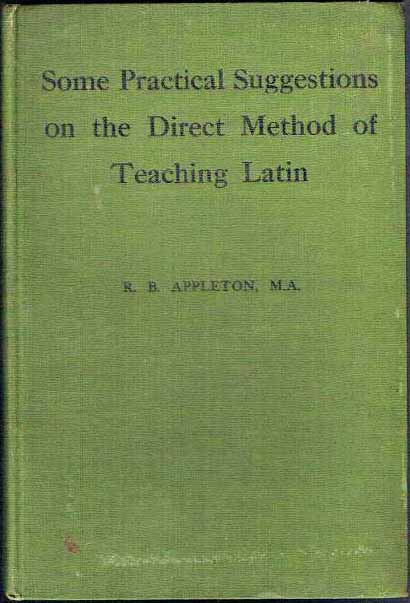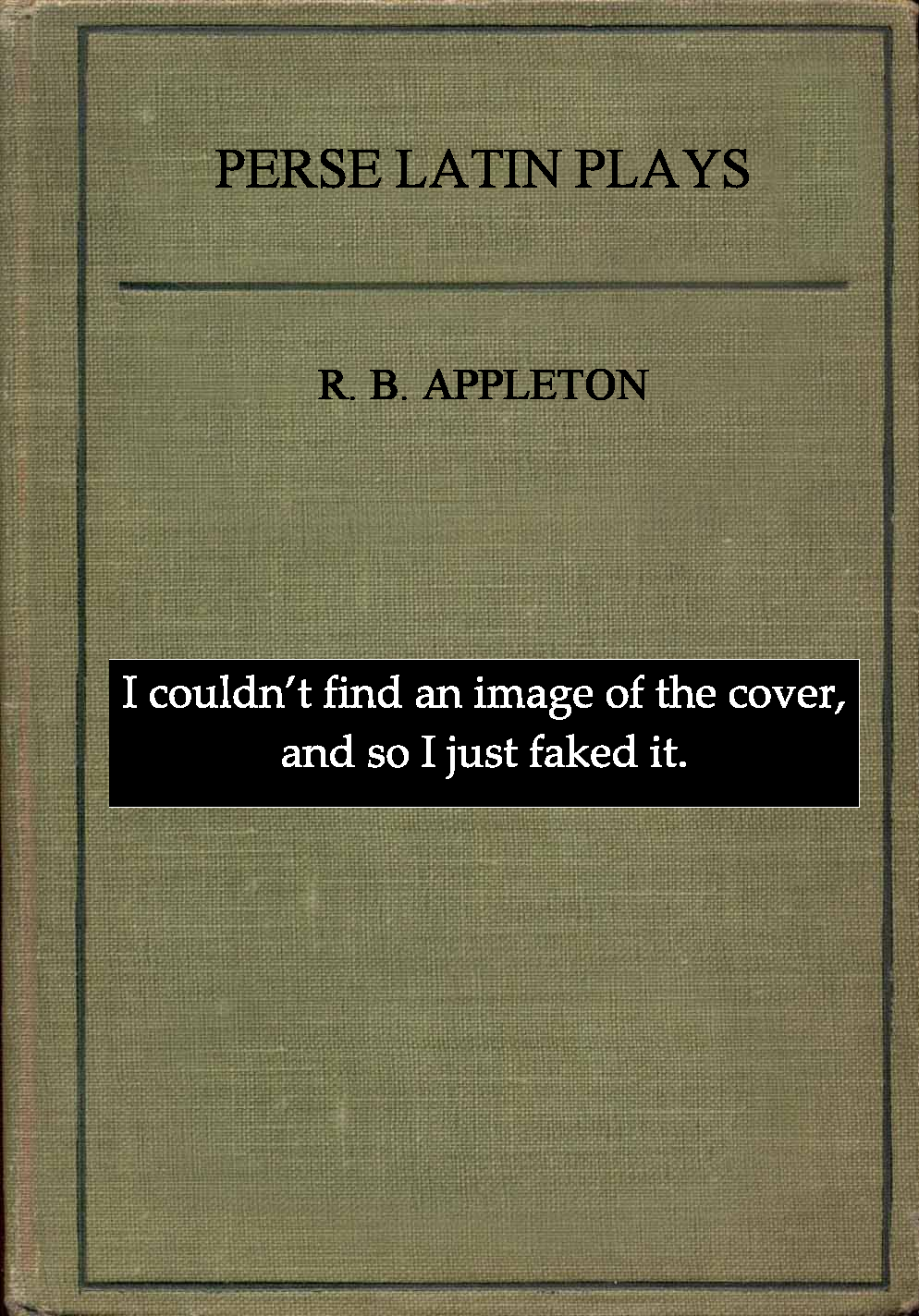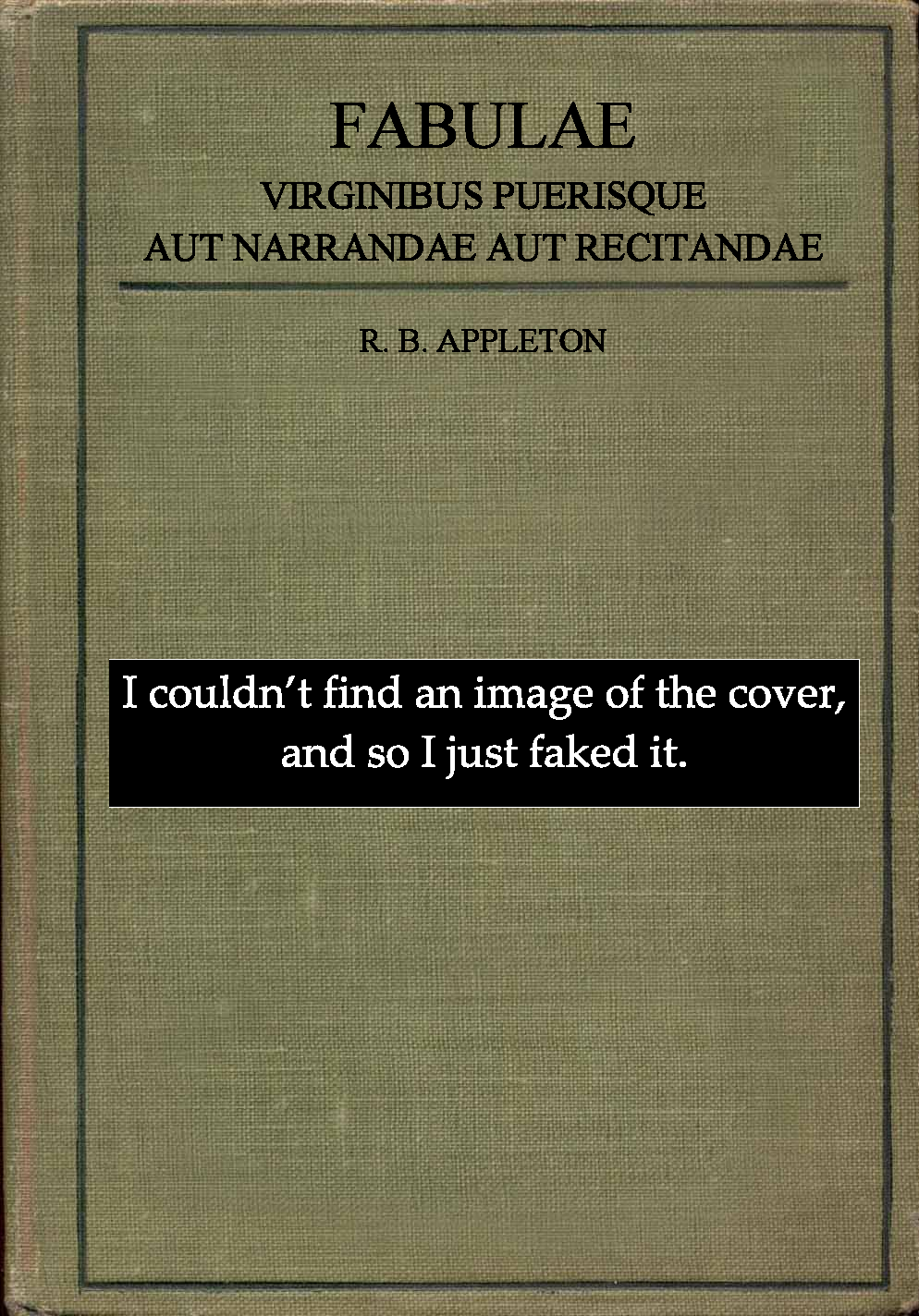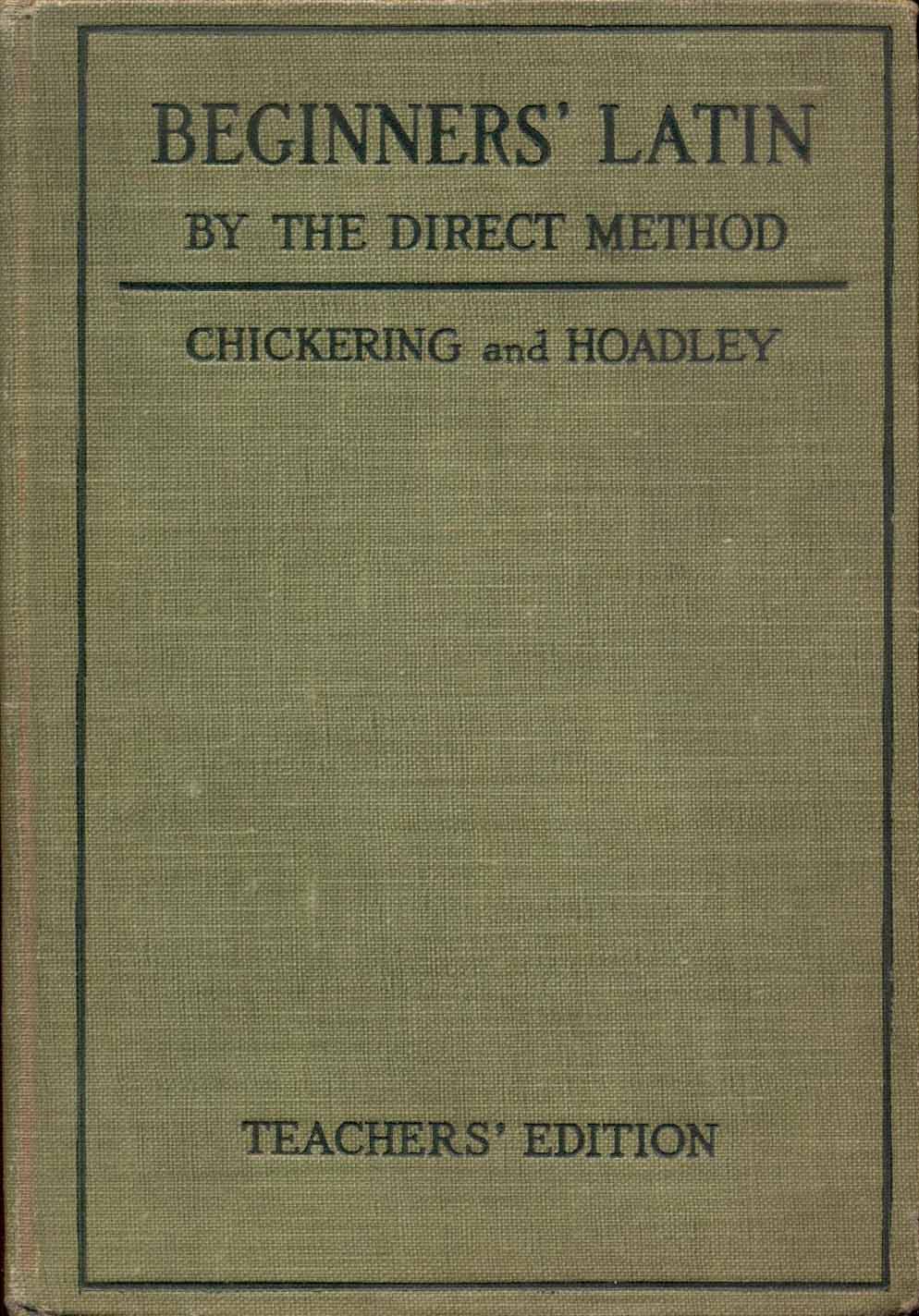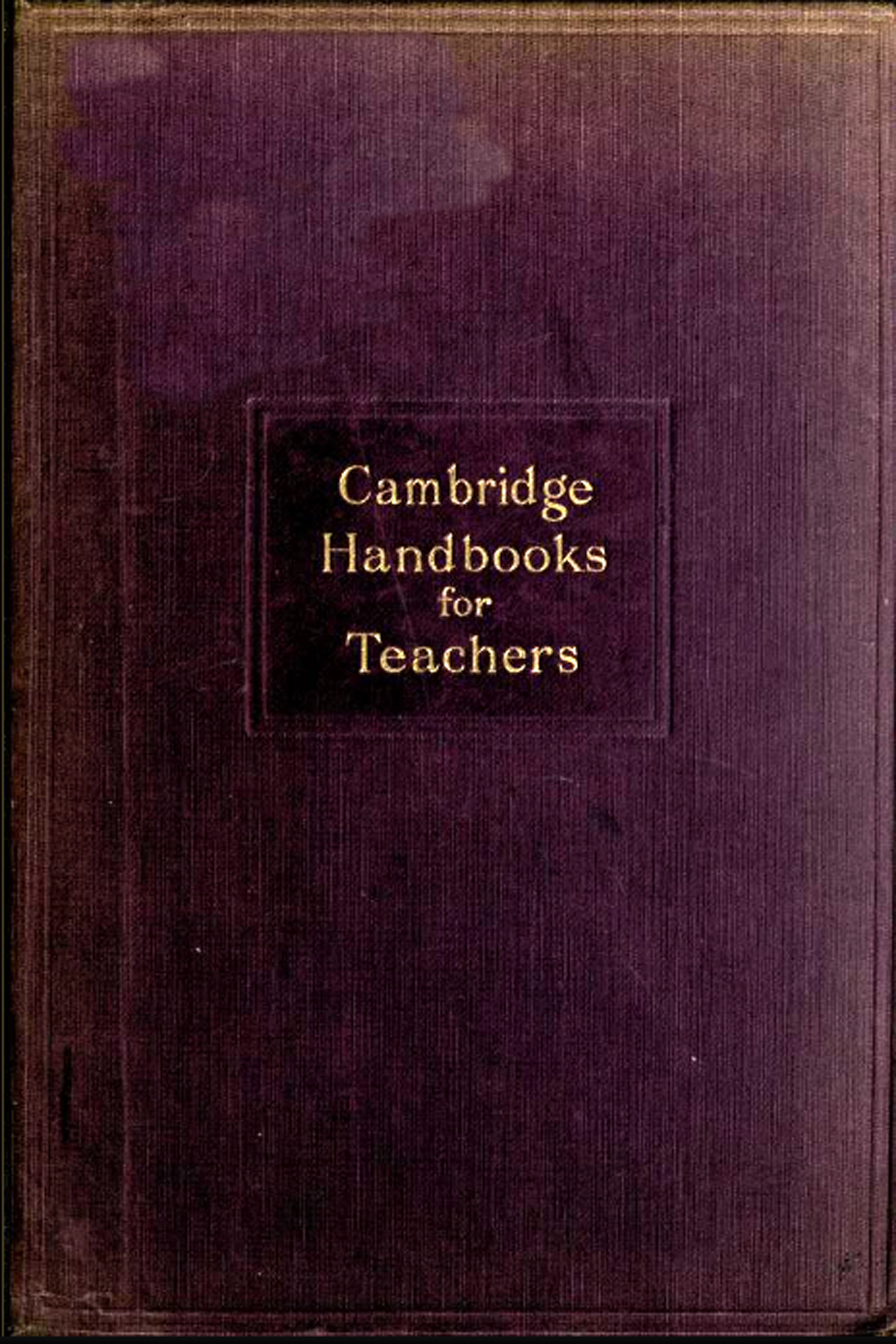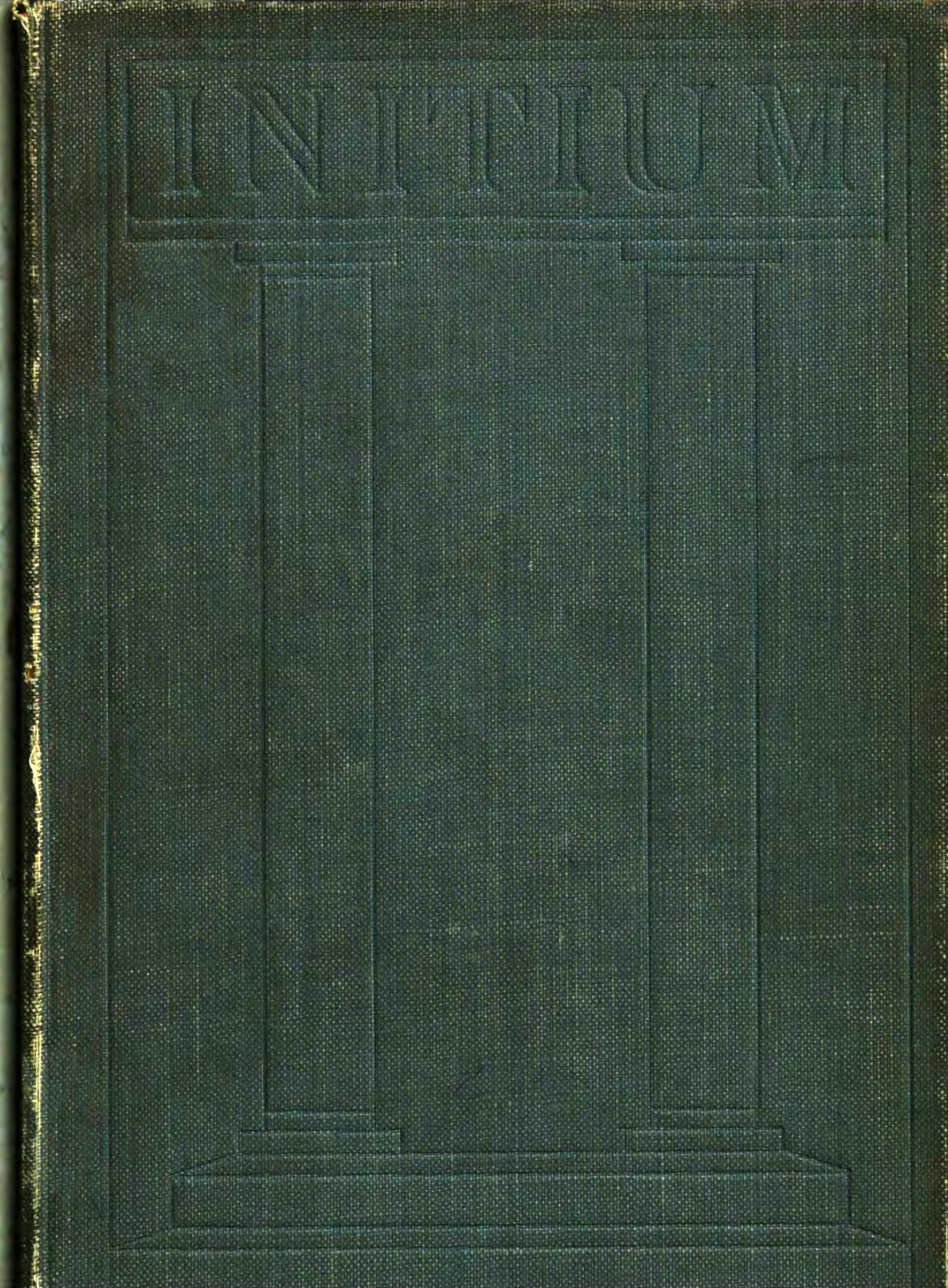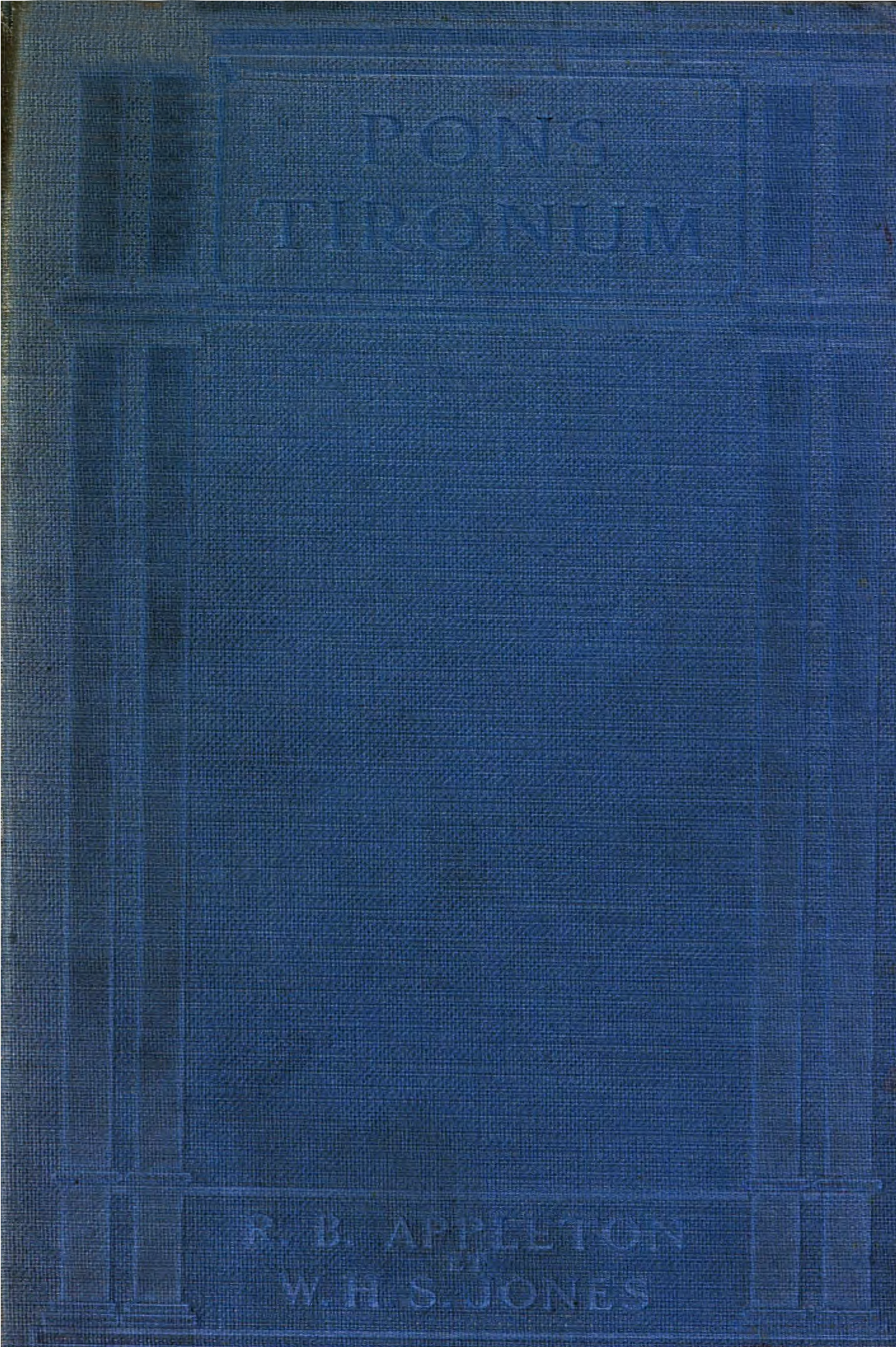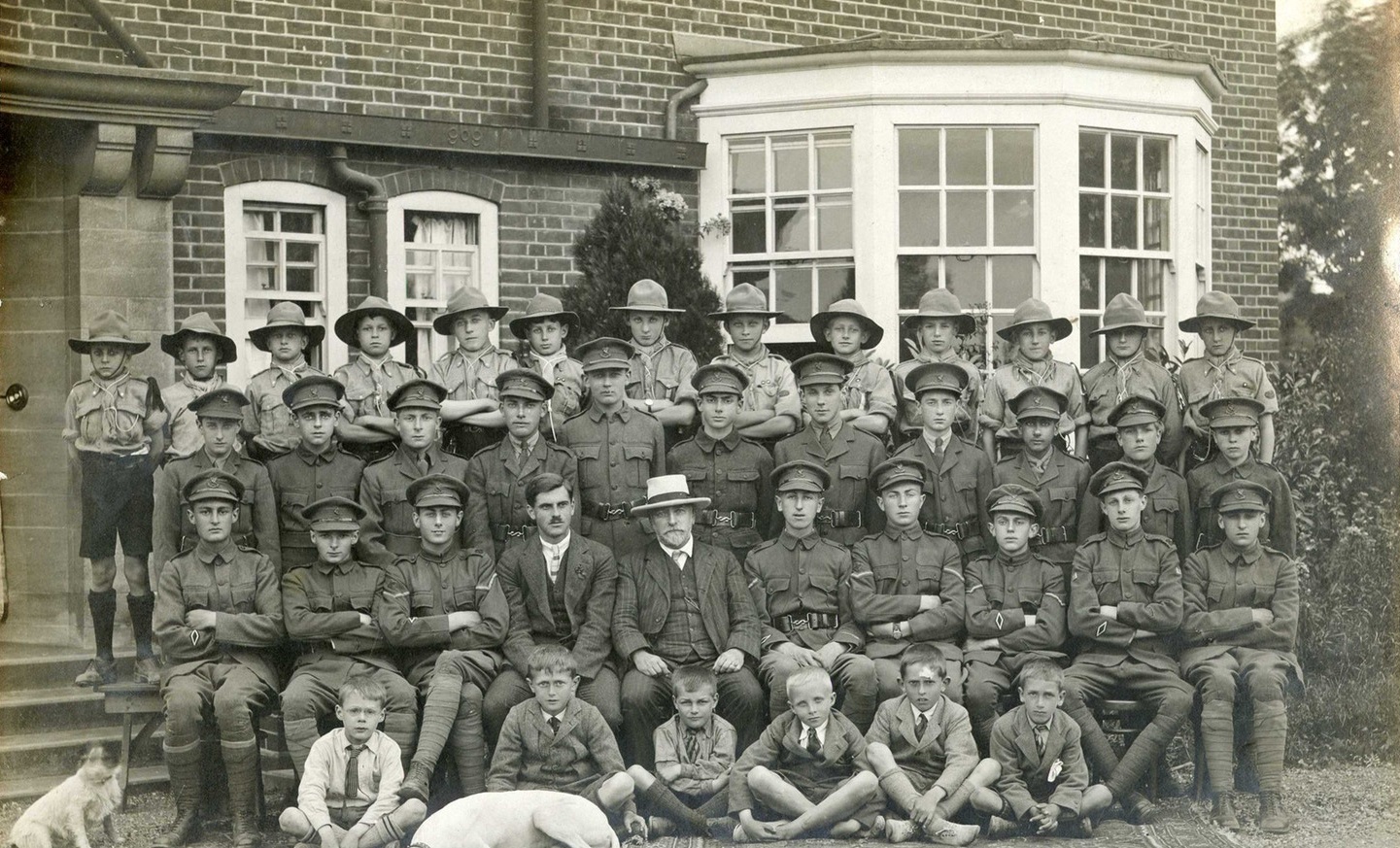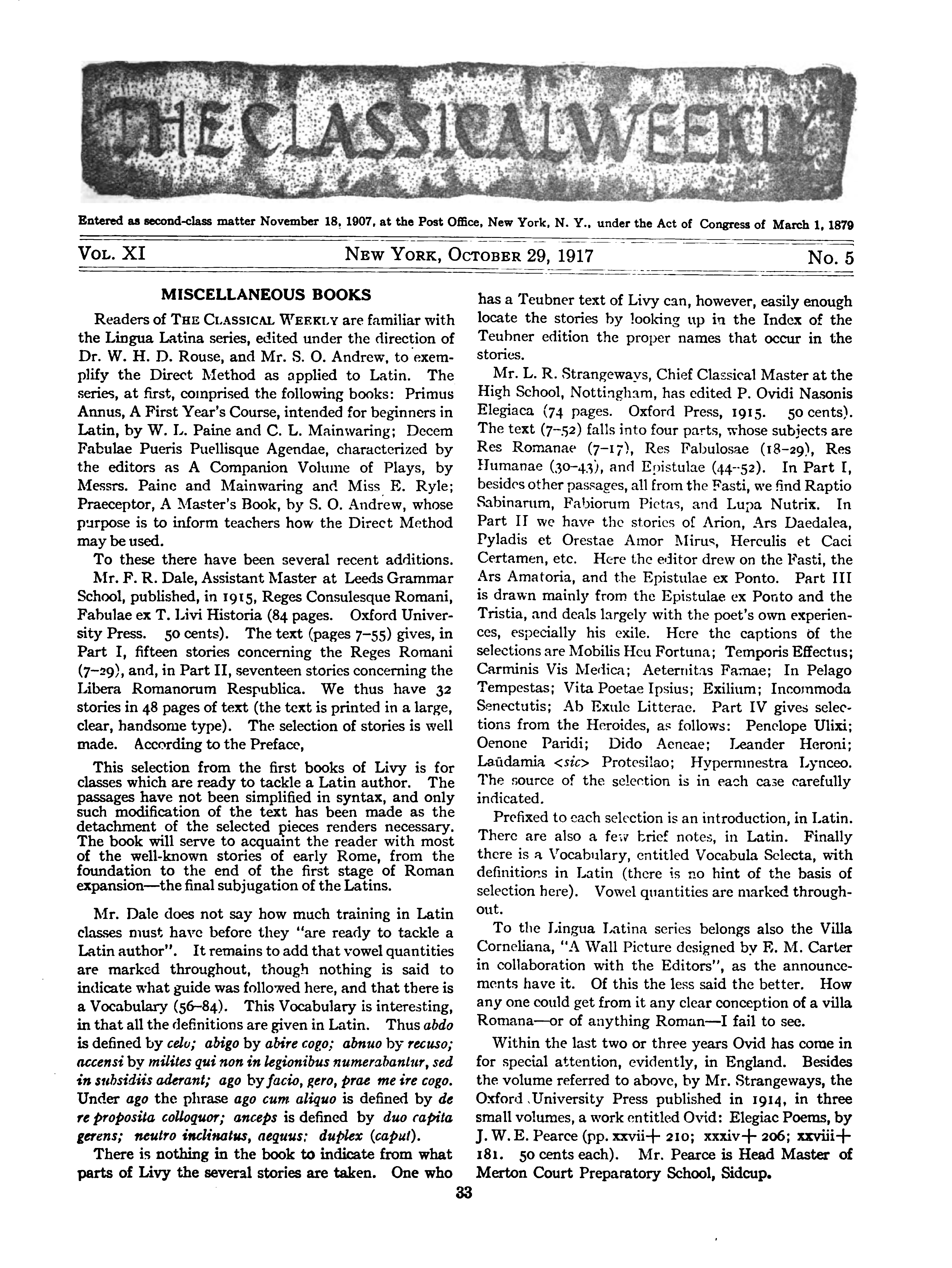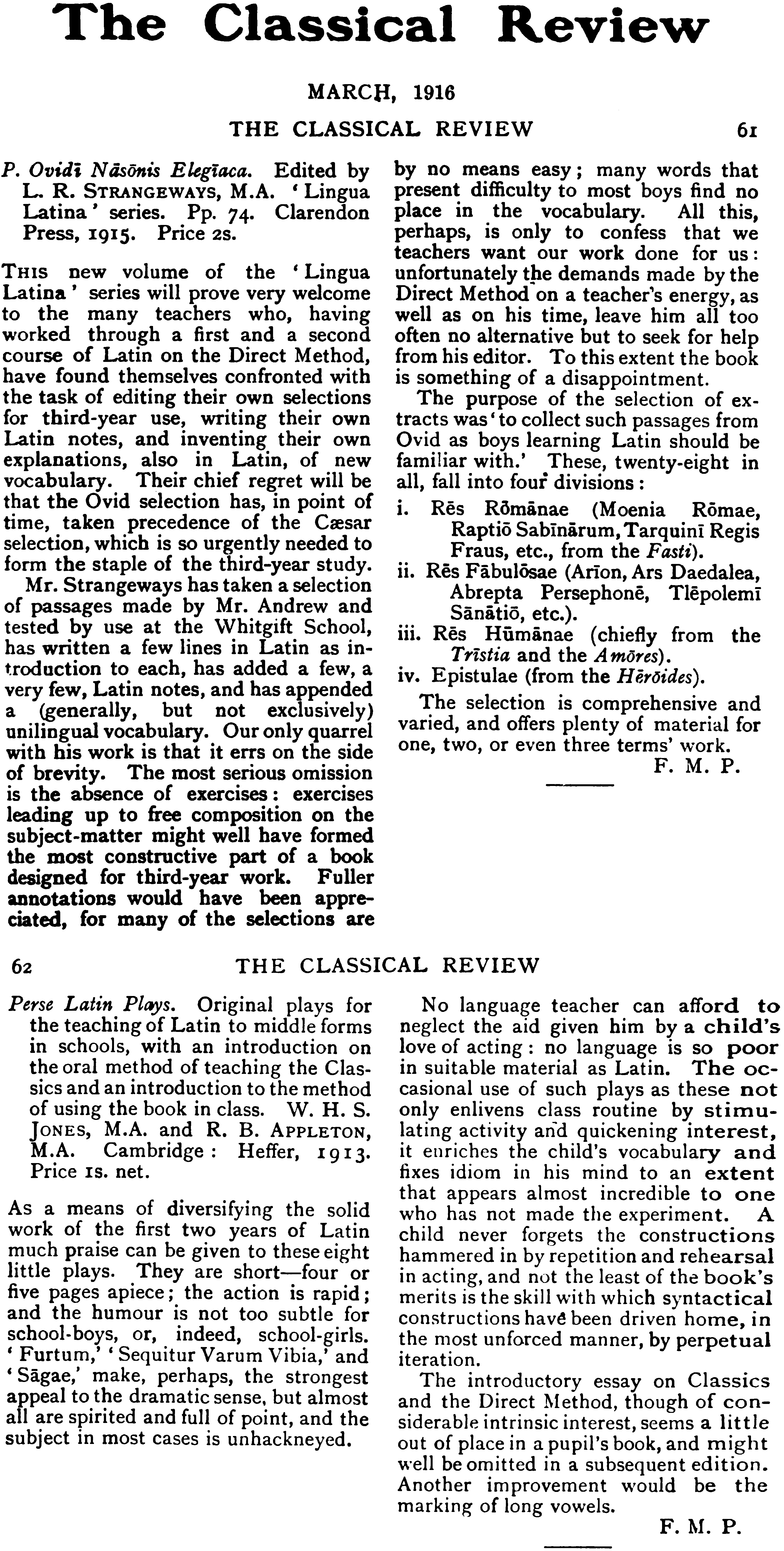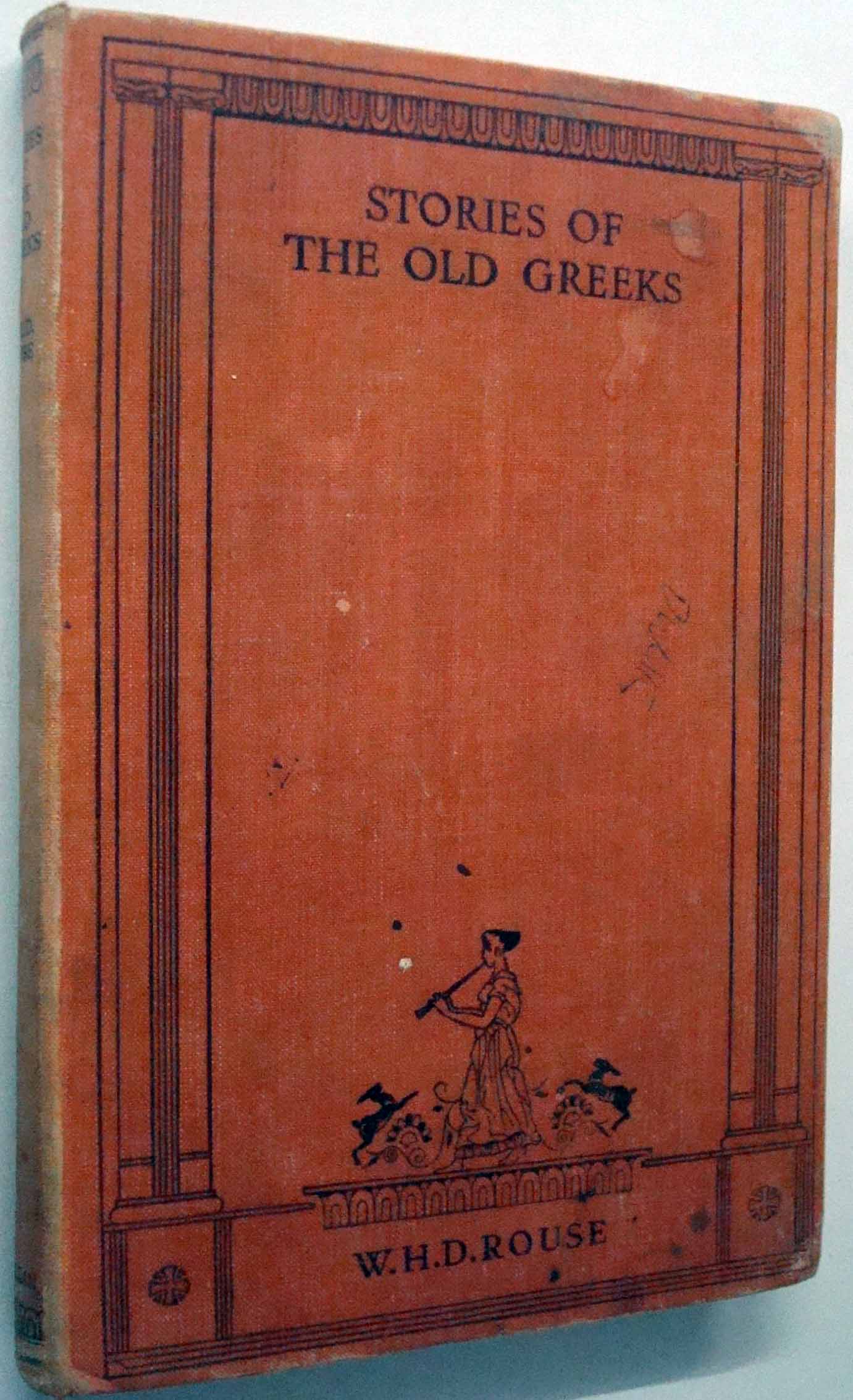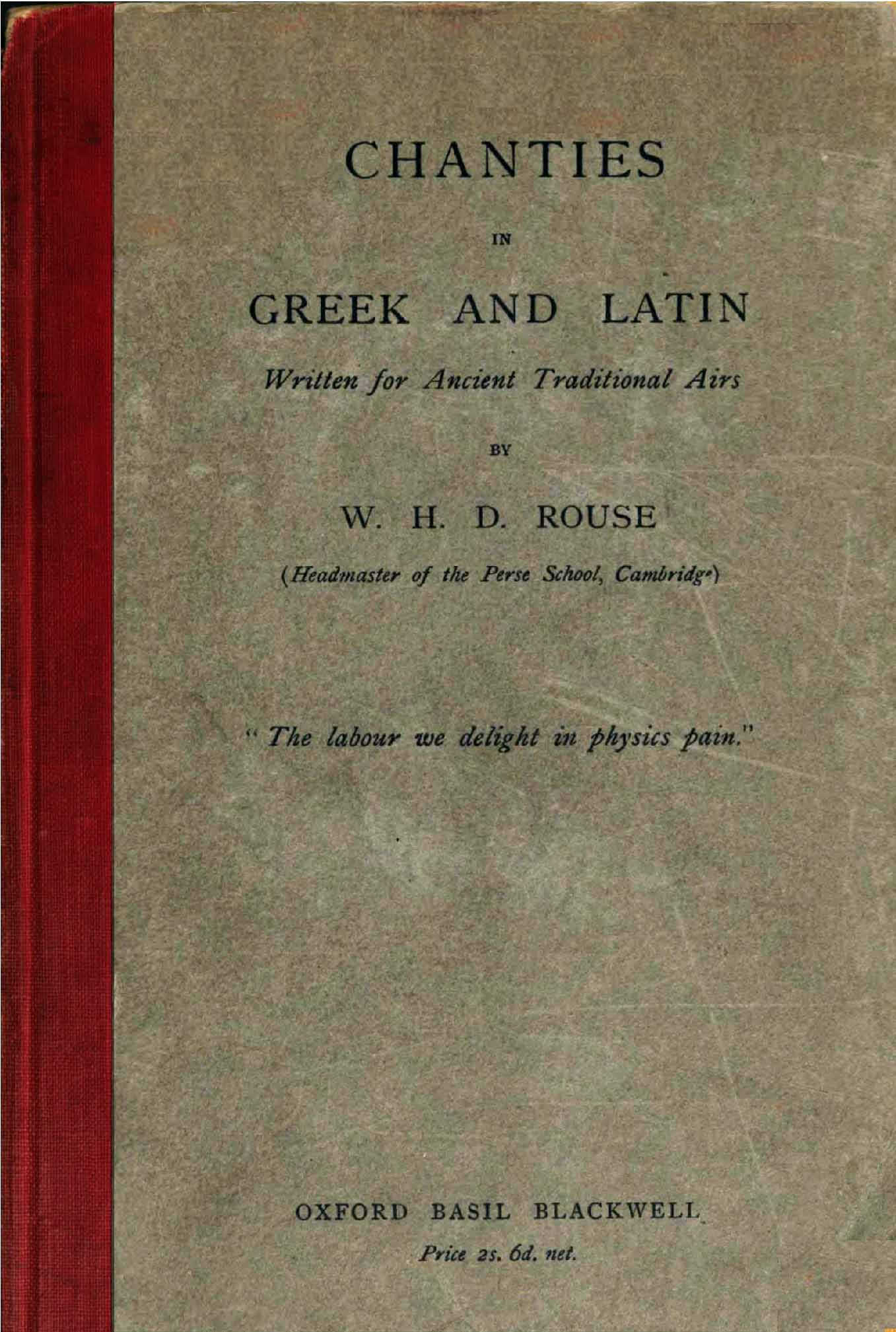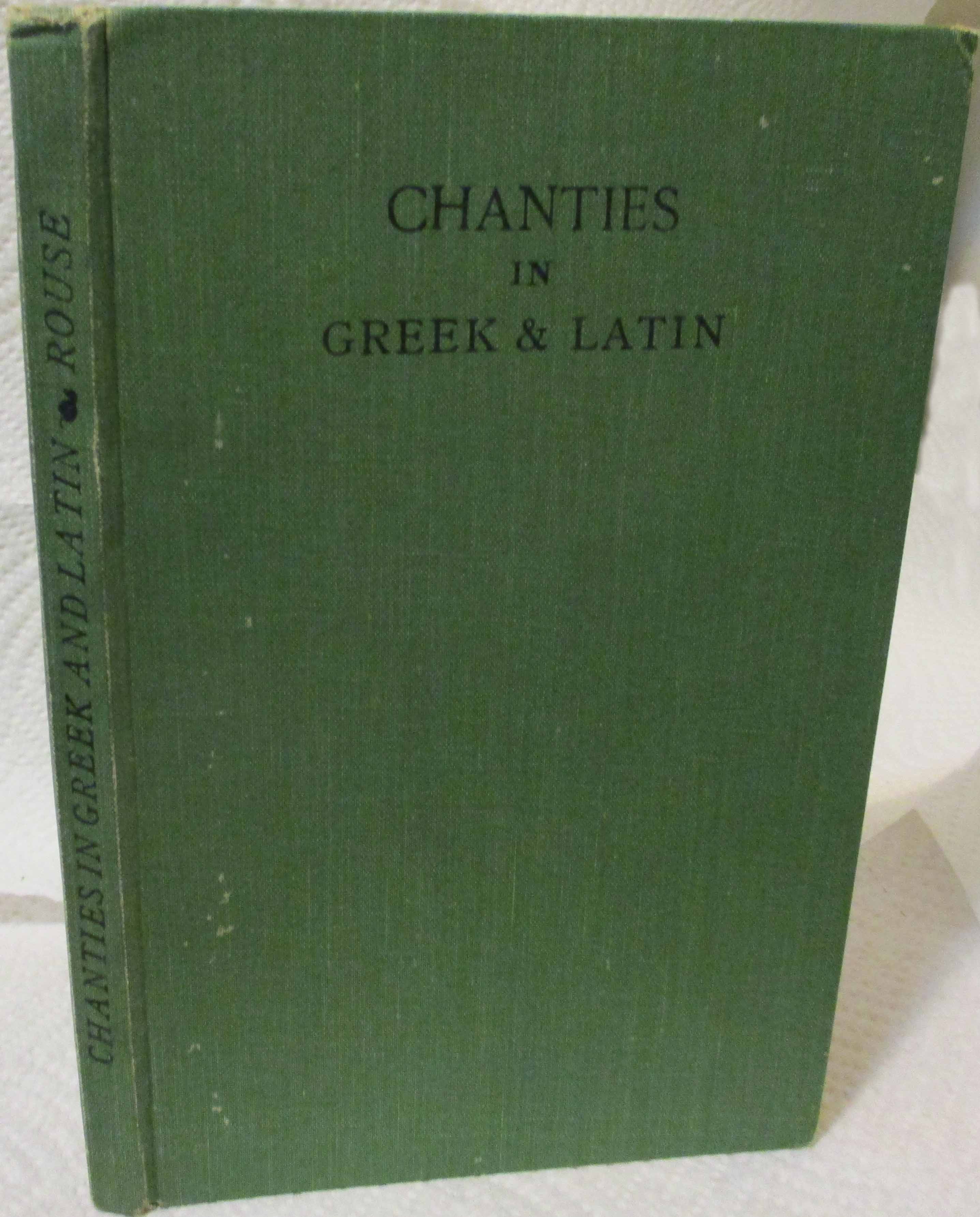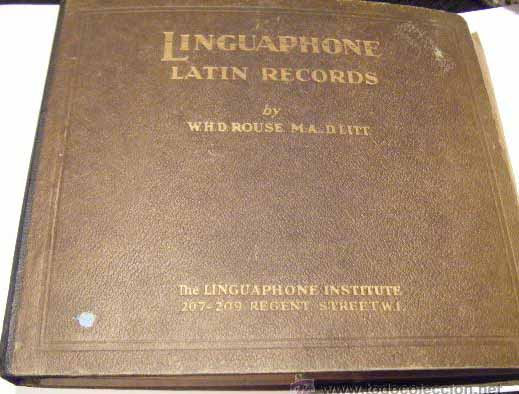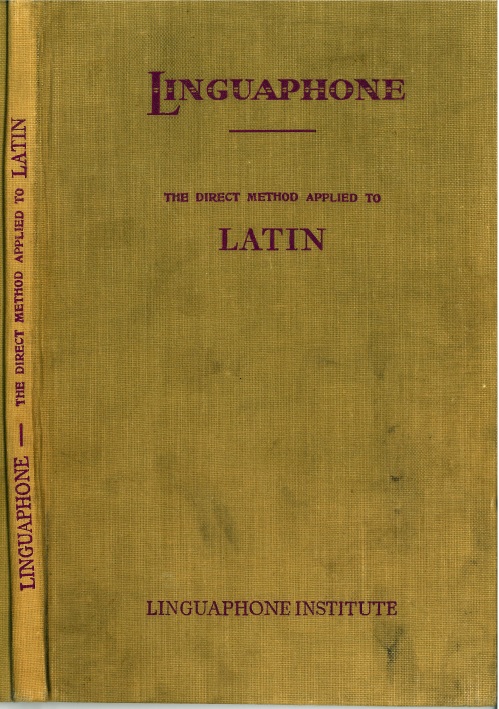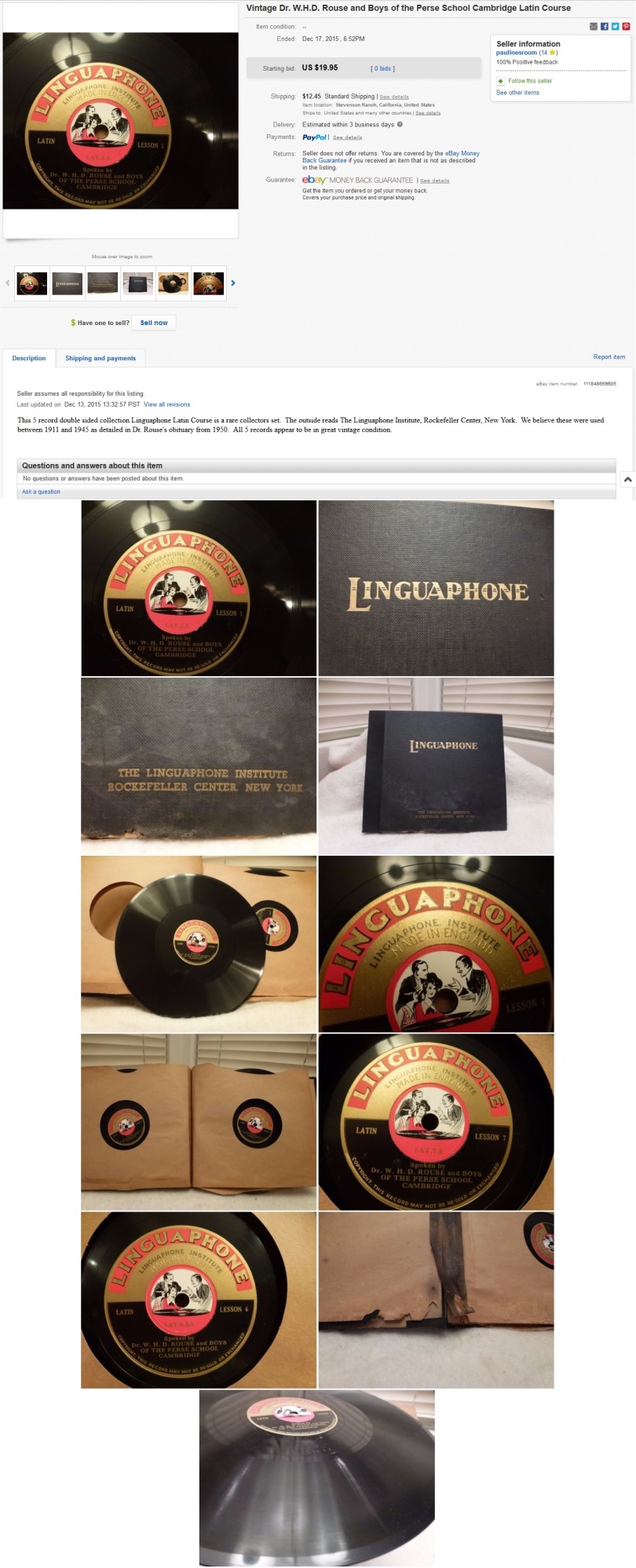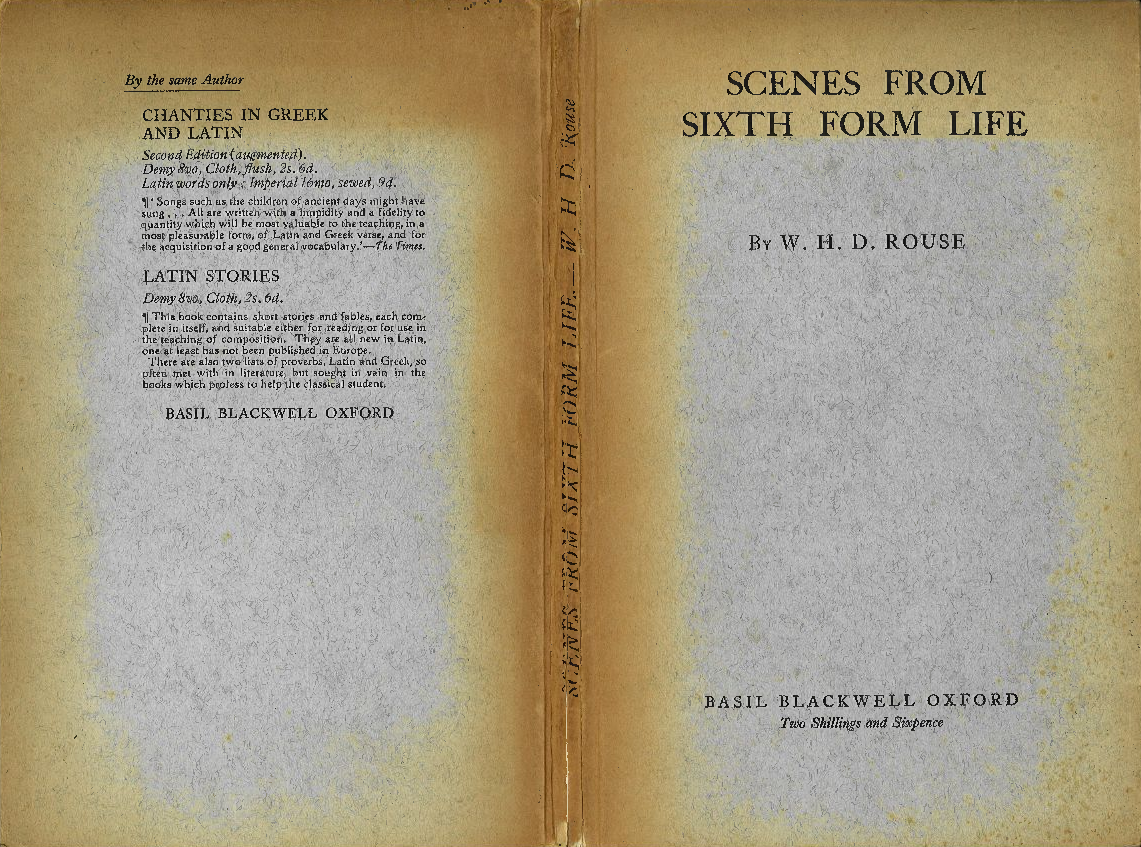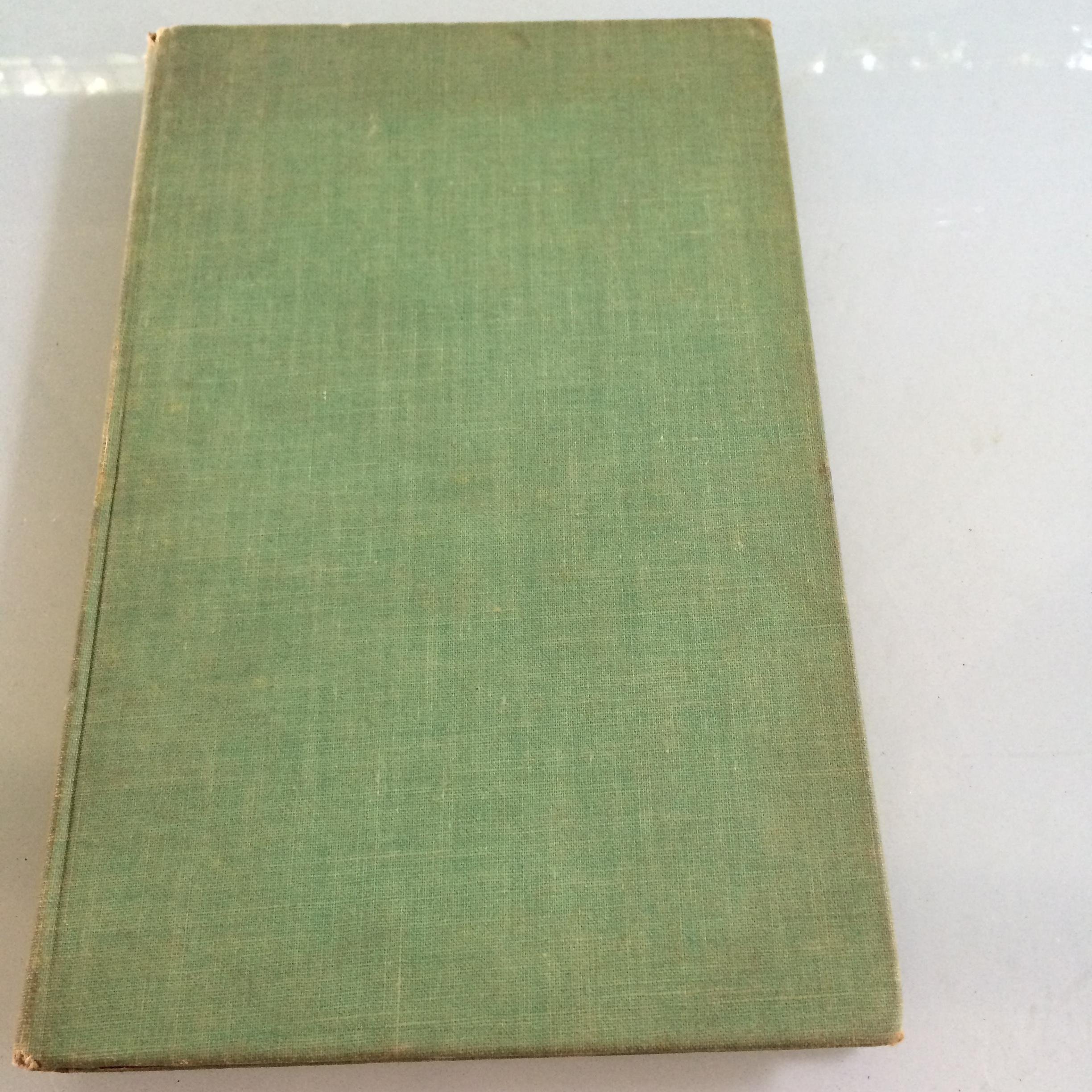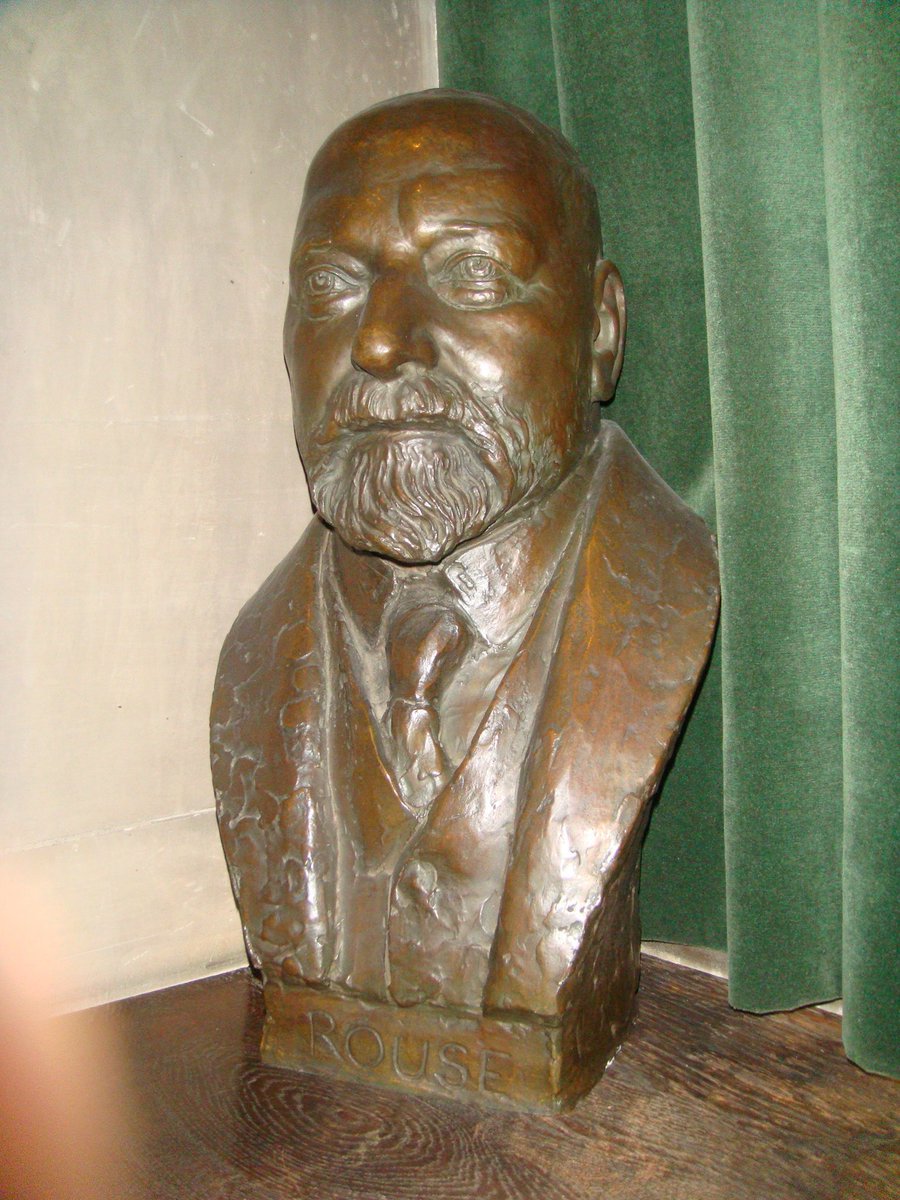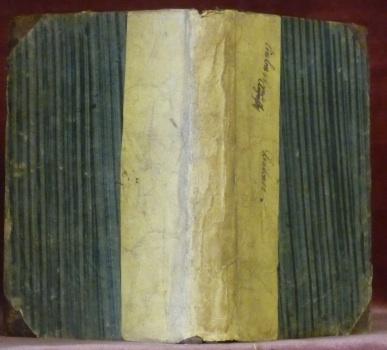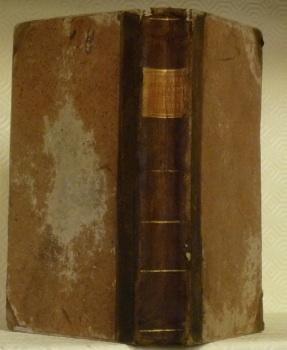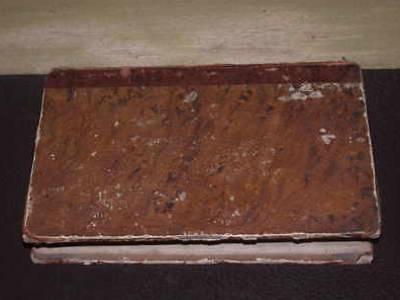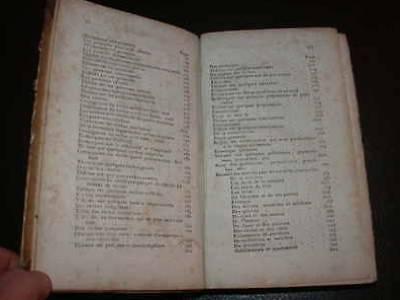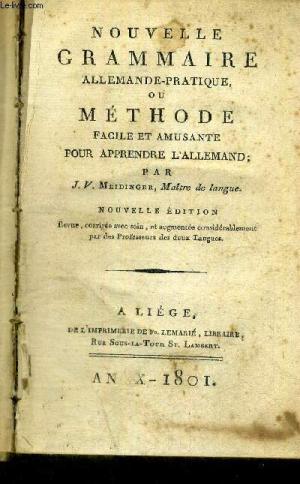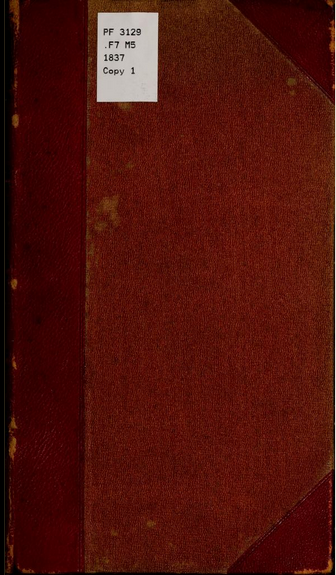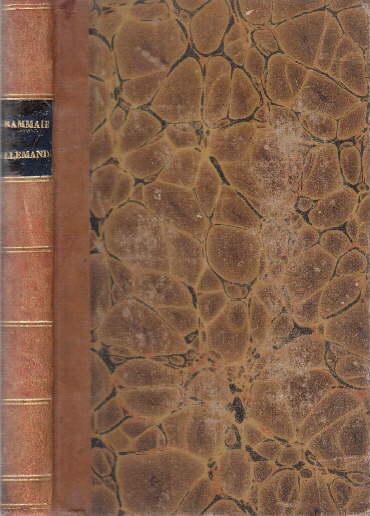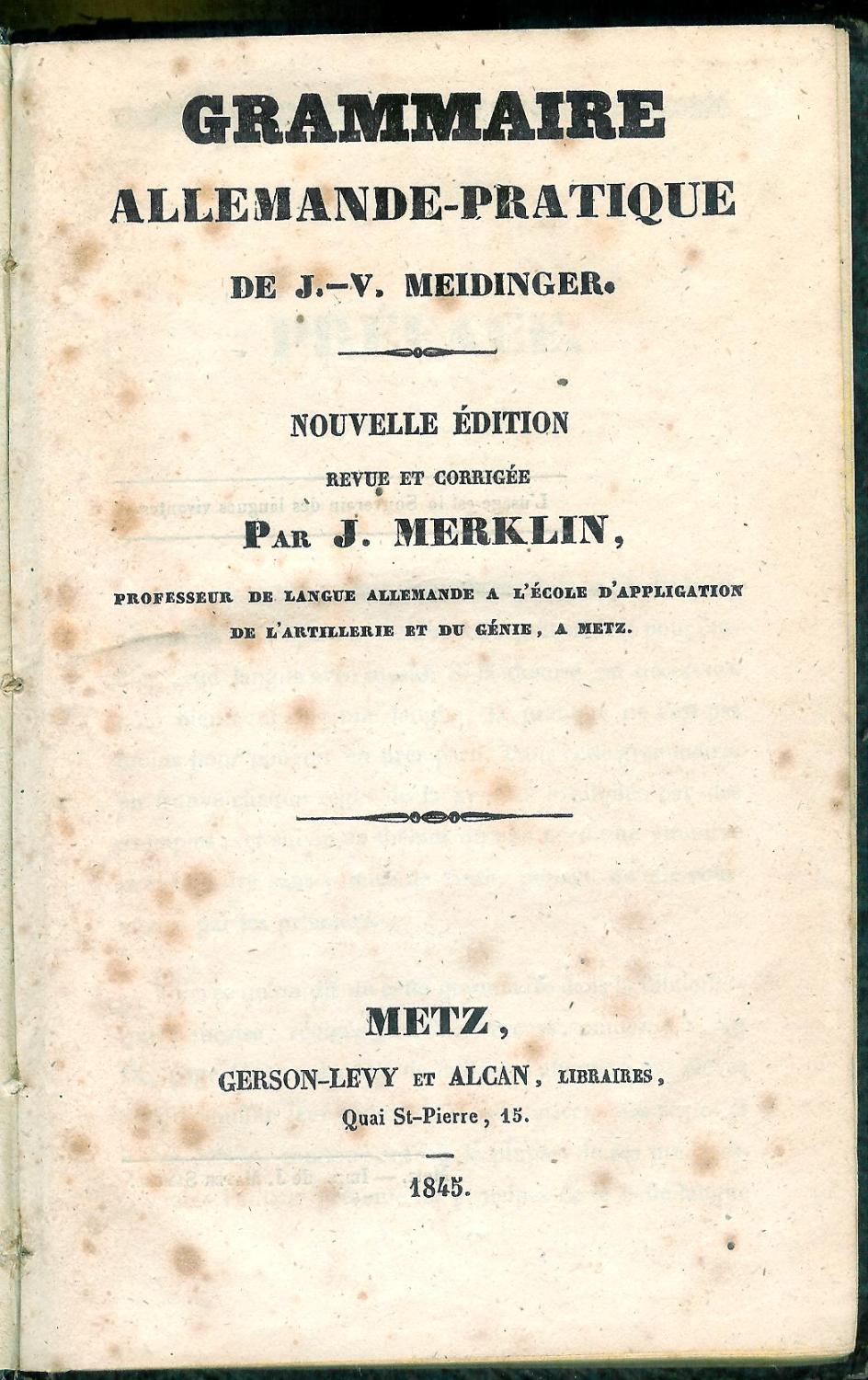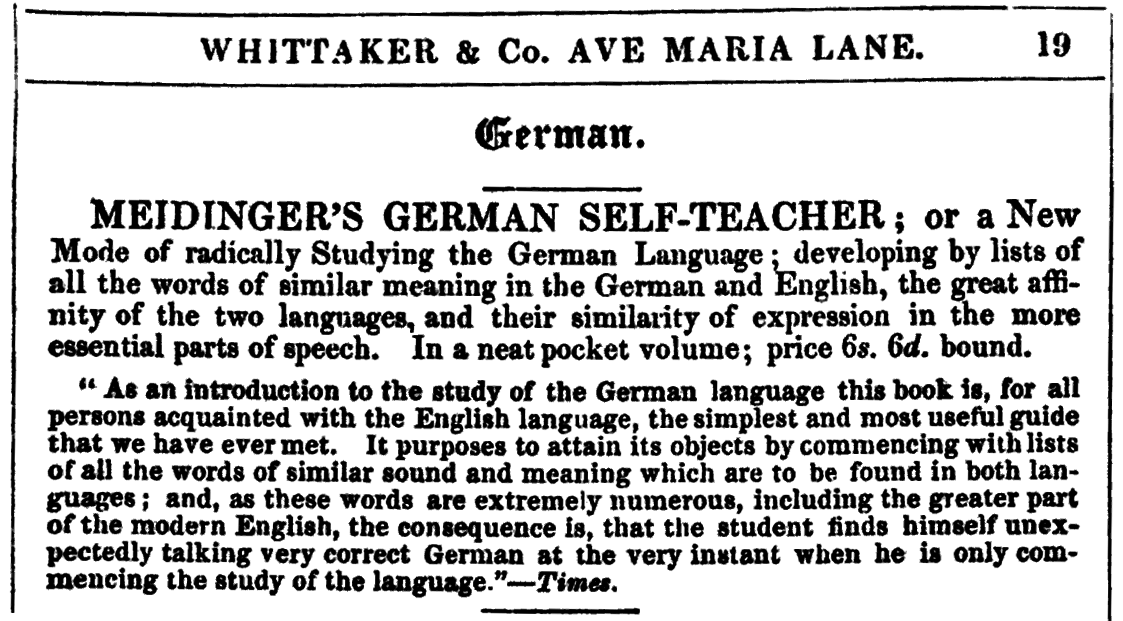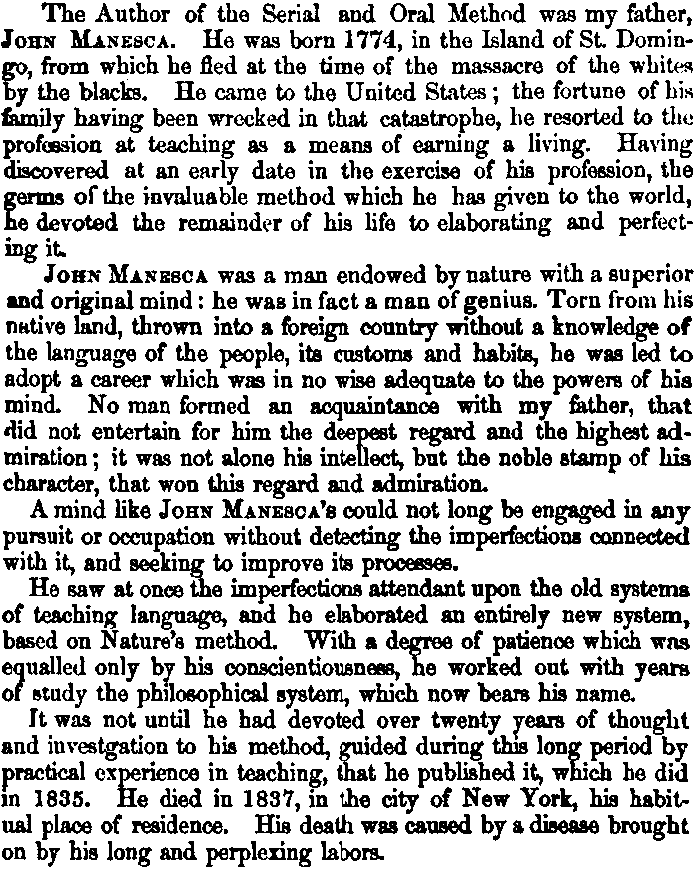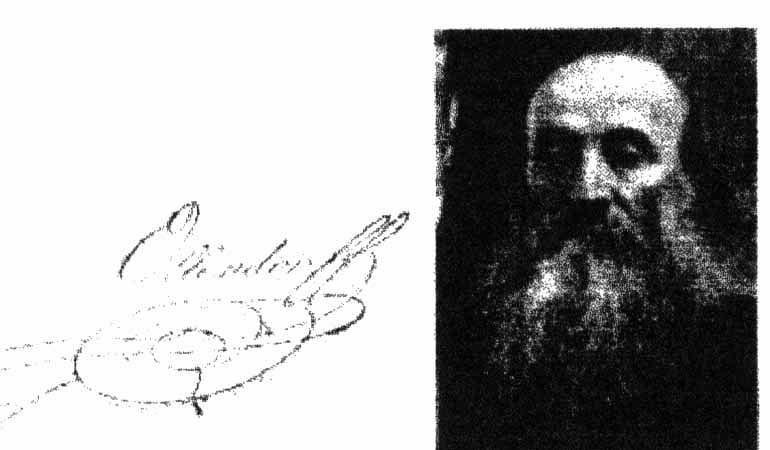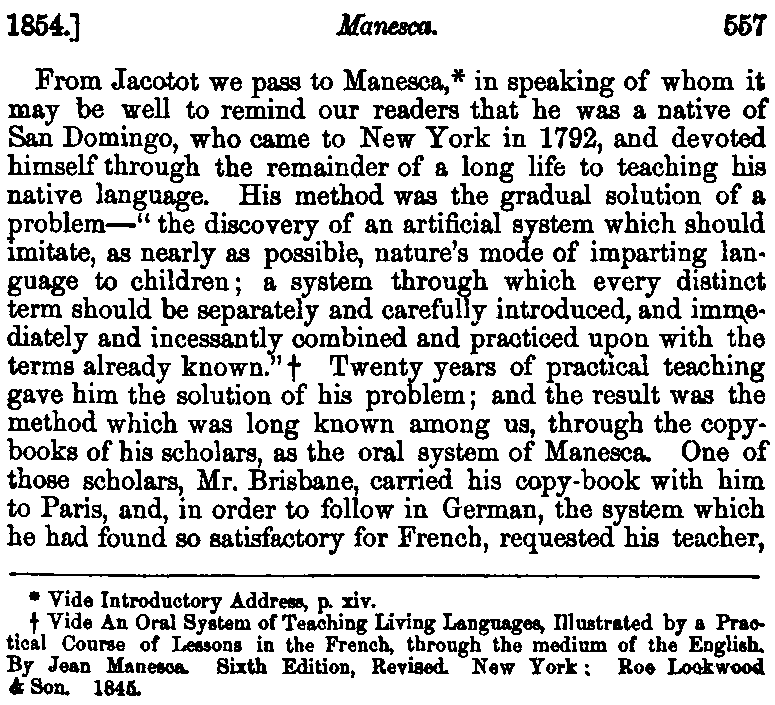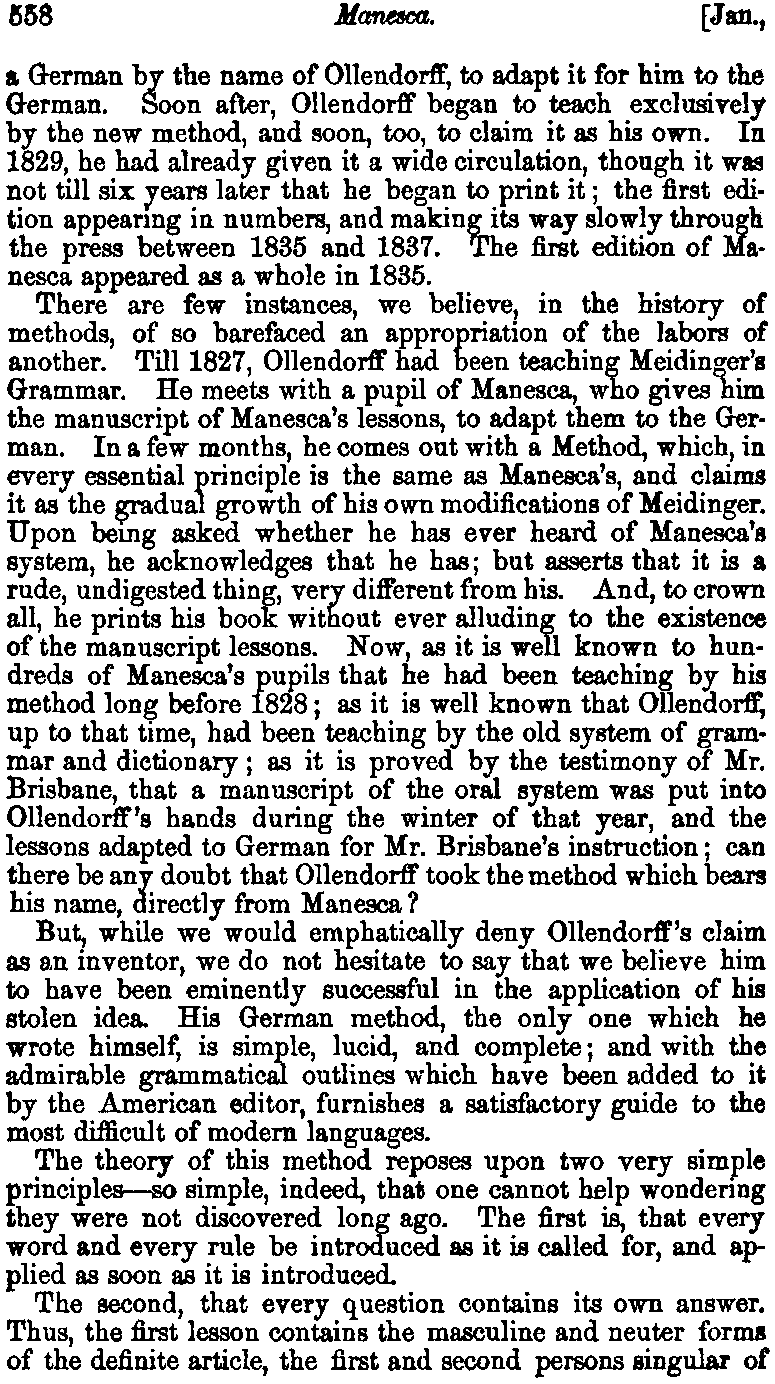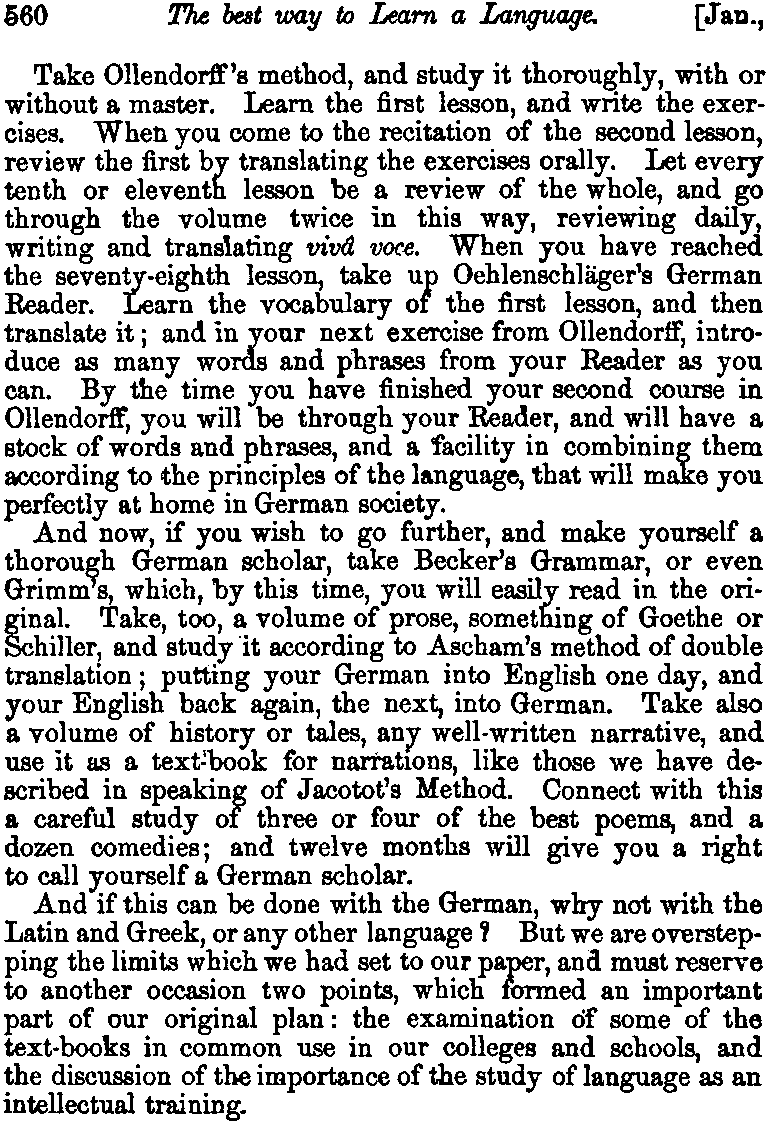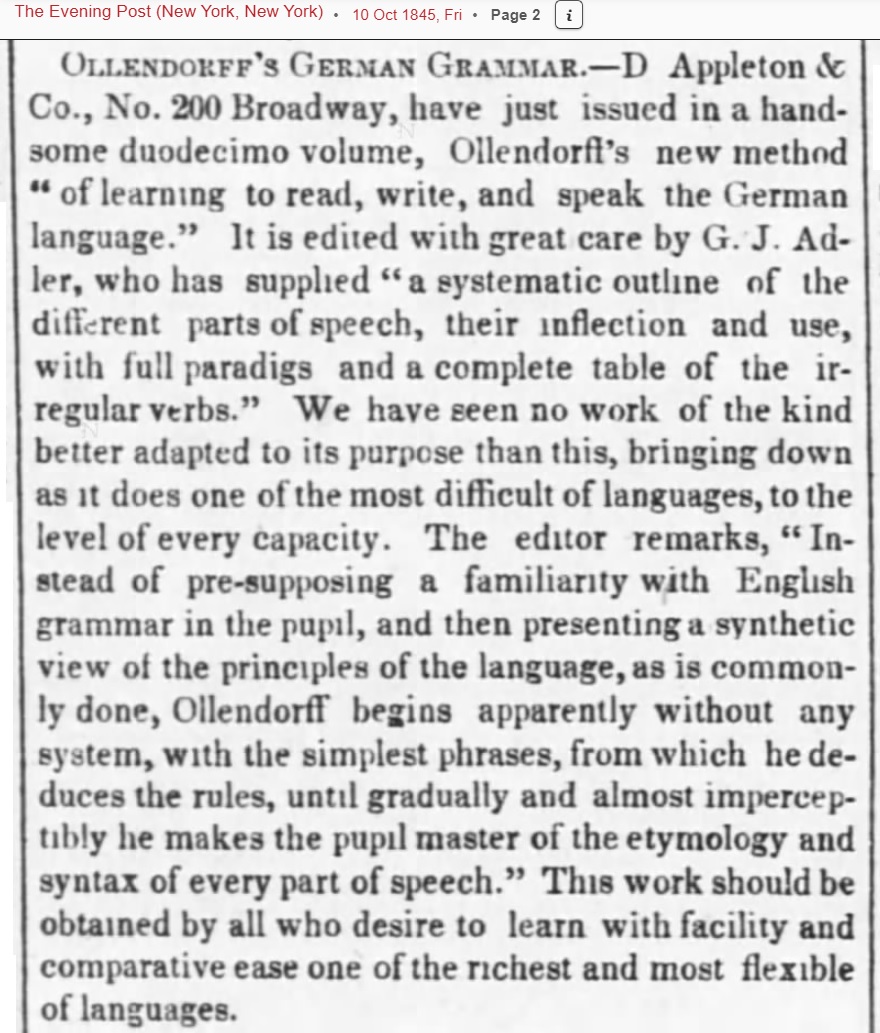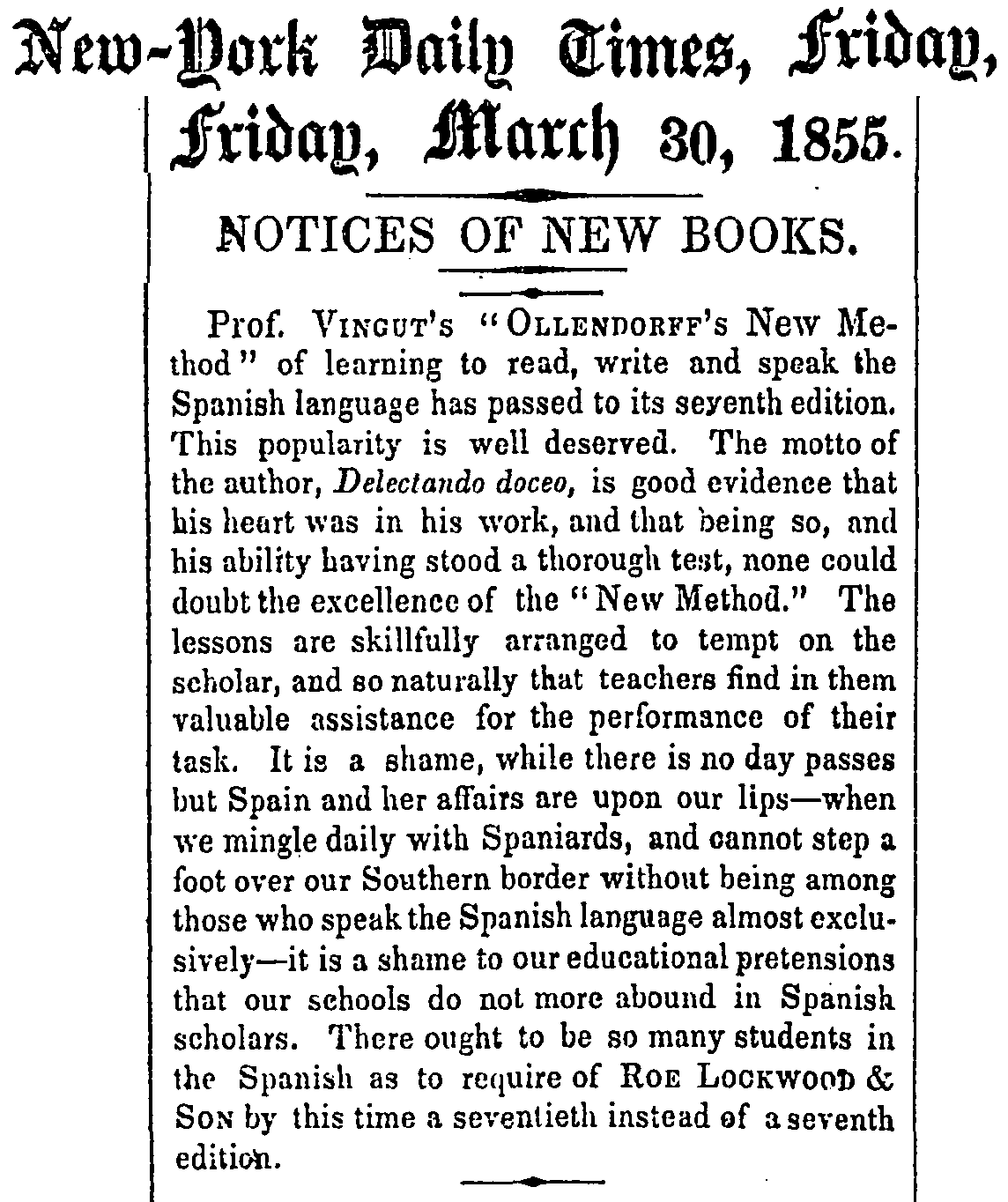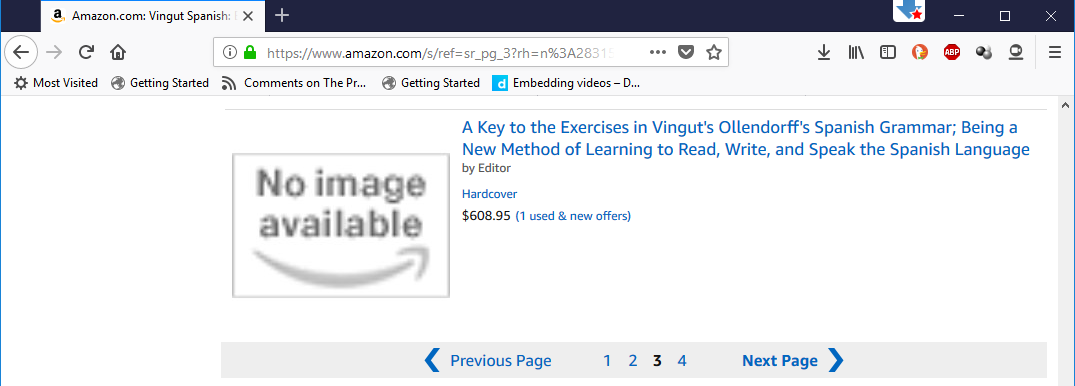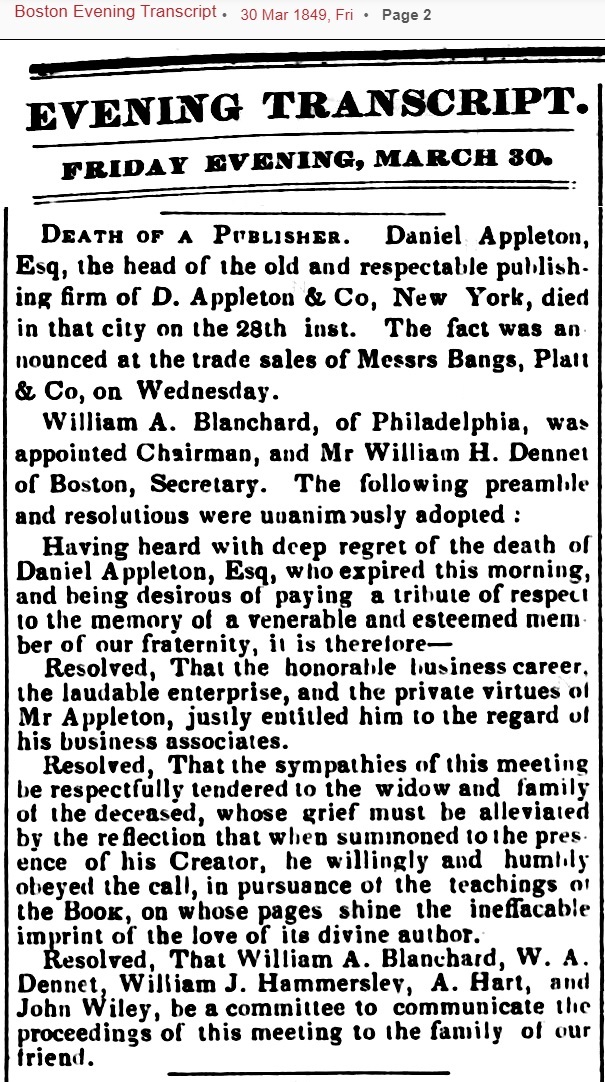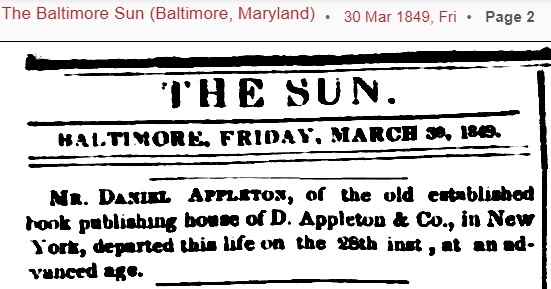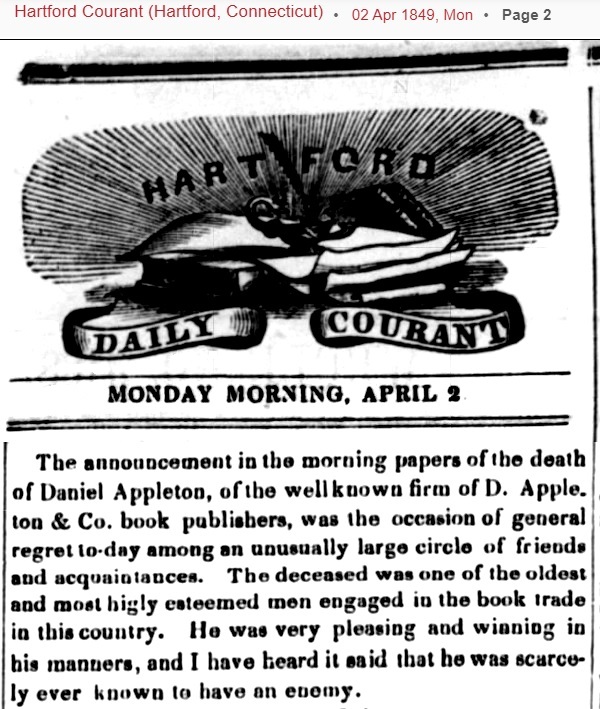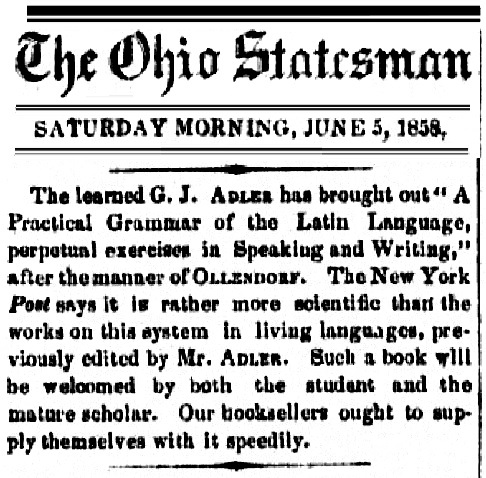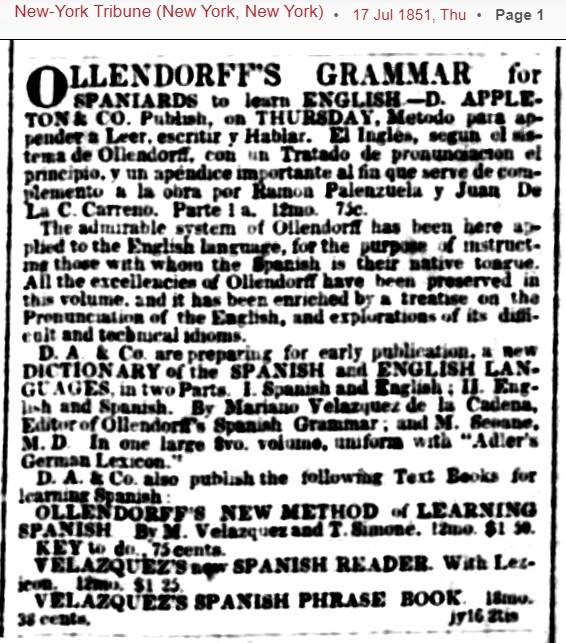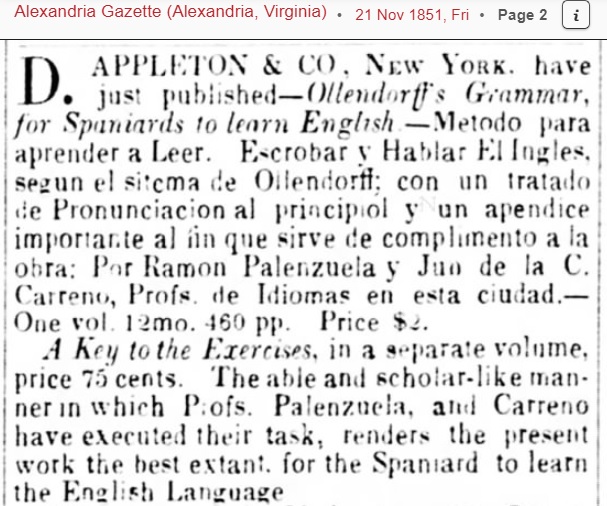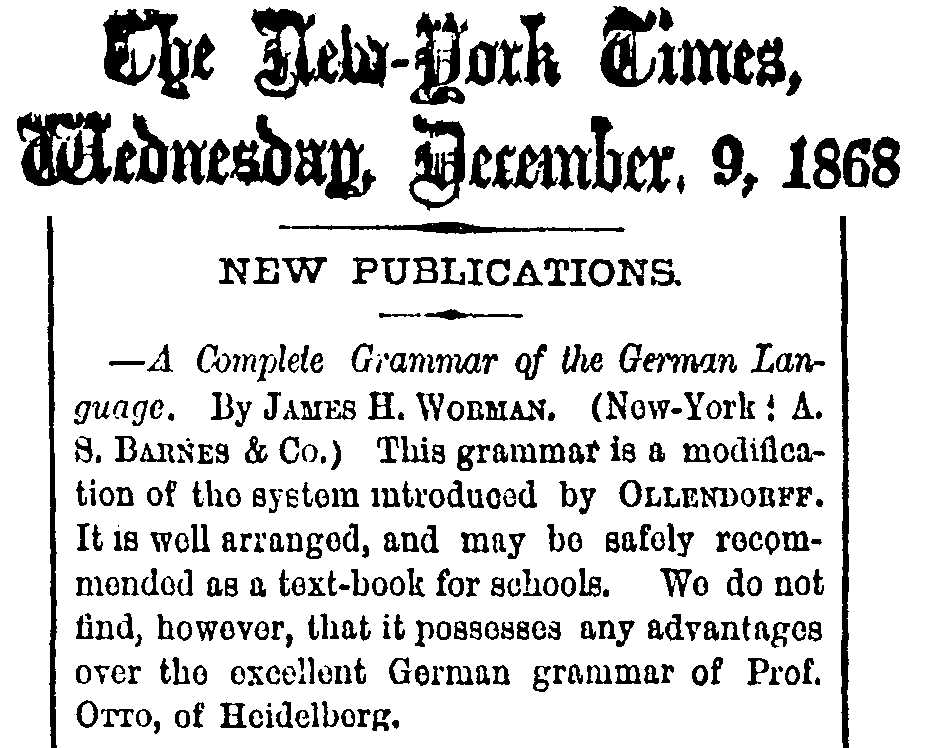The Classics
|
Why does it seem such a difficult business
to acquire a familiar knowledge of any foreign language,
and why is so much brain and so much time spent so
frequently on their acquisition with such scanty results?
The answer can be only one: because your teacher has
ignored the method of Nature, and given you a bad substitute
for it in his own devices; instead of speaking to you
and making you respond, in direct connection of the old
object with the new sound, and thus forming a living bond
between the thinking soul, the perceptive sense, and the
significant utterance, he sends you to a book, there to
cram yourself with dead rules and lifeless formulas about the
language, in the middle of which he ought to have planted
you at the start.
John Blackie,
Greek Primer: Colloquial and Constructive (London: Macmillan and Co., 1891)
|
Before relating my tales of woe and my tedious
|
|
A PLEA:
If anybody wishes to study Ellis/Schachter with me, remotely by Zoom or Teams or something similar,
just say the word and I would be thrilled beyond description.
We could even
|
That’s all you need to know.
Now that we have located the above courses, everything that follows below the fold is hereby rendered naught more than meaningless babble.
No need to read it, unless you, too, wanted to kick your teachers.
Now for my autobiographical ravings, which are probably not too different from yours.
I shall hazard a guess that since you are interested in Caligula,
you are probably interested in Classical history, and you probably enrolled in Greek and/or Latin in high school or college.
Yes?
If so, I shall further hazard a guess that, after several years of studying Greek and/or Latin,
you emerged unable to speak, read, or write either language,
and could translate only with difficulty and constant reference to dictionaries and volumes of paradigm tables.
That is because we were all cheated. Deliberately. Intentionally.
Our teachers and professors never had any notion of teaching us either language, and they made sure we would give up.
Below is my personal story.
It will probably resonate all too painfully with you.
Yes, in this autobiographical story I do go off on tangents, and that’s
simply because I’ve been bottling this all up for four-fifths of my life.
Now I’m opening the bottle, and I’m discovering tons of rage I never even knew I had.
I admit, to my great embarrassment, that I have not learned either Latin or Greek, despite having “studied” them in school,
invariably under instructors and university professors who were unable to speak, read, or write the languages.
As I write this, I am merely at the opening few lessons of Greek, now that I have at long last found the well-designed courses listed in the box above.
So, I am not hammering this web page together to proclaim my knowledge, but my ignorance.
This web page is largely for my personal reference, so that I won’t forget where I recently found some nice resources.
Why do I post it publicly?
Because, unless I have failed, at least a few passages of this page should be entertaining,
and though I tell my stories from a vantage point of inexperience, a little bit of what I write should prove helpful.
Besides, there are fun stories below.
At least I think so.
The few Classics I have read (frightfully few) were all in translation.
I refused to read more, because I resented having to rely on translations.
I wanted to read the originals.
Maddeningly, I should have been able to read the originals.
You see, some of the relatives who raised me were Greek, but refused to speak (Modern) Greek with me.
Yes, they spoke Greek — quite a lot, really — but only with each other.
When I would enter the room, they would switch to English.
The ideology, at least in part, was simple: “We are Americans now! We speak only English!”
(I don’t think they ever used that exact phrase, but that was certainly the sentiment, expressed in various explicit ways.)
More to the point: The children must be raised as Americans.
Goodness gracious!
Truth be told, though, it was not my family that brought about my interest.
Had it been only nasty Greek relatives who spoke a tongue I could not understand, I would not have thought it worth understanding.
The person who lit my fire, in September 1971, when I was eleven, was my sixth-grade teacher at Zuñi Elementary School,
Manny Smith, formerly of Oswego (and Elmira?), NY, of all places, who moonlighted as an Equity actor.
It was funny to turn on the TV set and see my teacher in a public-service announcement and in
The Man and the City and so forth.
The public-service announcement, which I saw only once:
He portrayed a sleazy salesman, dressed, I think, in white dungarees, offering a used TV set at a bargain price.
His final sentence of the spiel: “And there’s no guarantee!” he said as he patted the top of the TV set with his hand,
only to see the screen explode.
He did a quick double take, and that was followed by a caption about caveat emptor.
In The Man and the City, he was the helium-balloon salesman at Uncle Cliff’s Family Land in the first episode,
speaking his single line to Anthony Quinn and a handicapped boy with a horribly exaggerated NY accent —
and I think he was dubbed. I watched the episode, and the next day we students were all amused to have seen him on the tube the night before.
He repeated his single line for us, as he had delivered it on camera, but that was not the line we had heard the night before.
It turns out that he was also in the pilot, The City, which I missed.
I’d so much love to get the entire series on video, but it has never been seen since its original airings in 1971.
Oh. Wait. Whoah. Here’s a clip from an episode.
This is from a 16mm print that somehow escaped from the vault.
Ah. I learn that this was from a TV movie from 1978, called Destiny of a Woman, which was stitched together from two episodes of The Man and the City.
To my genuine surprise, I still find this interesting. I thought I’d be cringing, but no, not at all.
Not great, by any means. It’s basically a soap, but not bad for a soap.
I wouldn’t put it in the same class as Napoléon vu par Abel Gance
or King of Jazz
or Valerie and Her Week of Wonders or
Una vez, un hombre... or
Rhymes for Young Ghouls or
Their First Mistake or
Search for the World’s Best Indian Taco, but it holds up.
Whether we loved Mr. Smith or hated him, we students found him fascinating.
One day a student asked him about his family origins.
He wasn’t expecting that and was rather taken aback.
After a double take, he began his story.
This was a story he had never practiced, and so he began quietly by telling us that his ancestors had emigrated to the US from Latvia.
Since nobody in class had heard of such a country, and since the name sounded funny, we all chuckled.
That was it. He stopped his story before he finished his first sentence.
We begged him to continue, but he refused.
It was surprising that such a tough guy, who specialized in comedy rôles and who loved making everybody laugh,
could be so insecure about such a minor little chuckle.

Ah. Here’s a picture of him on stage, wearing a rug.
The Albuquerque Journal, Thursday, 14 March 1974, p. C1.

Another stage rôle.
The Albuquerque Journal, Thursday, 19 June 1975, p. C1.
Back to the story.
Mr. Smith invented a game to teach us the Greek alphabet, albeit with an appalling American mispronunciation.
The game was simple.
We would have a contest, and whoever could recite the Greek alphabet the fastest would win a piece of hard round candy,
which Mr. Smith for some reason called a “sparkle.”
That was my introduction to the alphabet, and I practiced, practiced, practiced, aloud, at home, but only if my father was away,
because he would blow up at any disturbance, and, in his view, everything was a disturbance.
(To survive in his presence, I had to act as though I did not exist.)
My mother heard me and asked what on earth I was saying.
I told her it was the Greek alphabet, and she said No, what I was saying was horrible.
Of course it was horrible, I explained, because I was speaking it as rapidly as I could.
No, she said, it was horrible, and she taught me the correct Modern Greek pronunciation.
Trigger. That’s the sort of thing that sparks my interest with all the force of dynamite.
I eagerly learned the correct pronunciation from her.
Unfortunately, though she could understand the occasional simple sentence of Greek, she could not speak the language at all.
Darn it!
From the moment she taught me the correct pronunciation, there was nothing else in the world I wanted to study except for that language.
Little did I realize that there would be no opportunity to learn it.
But I won the sparkle.
Paradoxically, the one and only sentence of Greek that Mr. Smith knew,
“Θέλω ἕνα ποτήρι
νερό,”
he pronounced in perfect Modern Greek.
He read to us aloud large swathes of The Odyssey, which enraptured me.
Looking back on it, I think he was reading from the Mentor/Signet paperback edition of Rouse’s translation.
Actually, I’m certain that was the edition he used.
Further, he told us amusing stories about the ancients, and I was on the edge of my seat.
His stories had me salivating for more — but there was no more.
When he finished his stories a week or two later, that was the end of that.
It was time to move on to something else.
There was no place to turn to continue. School library? No. Neighborhood library? No.
That brief glimpse at the Classical world was a tease, one that drove me nearly mad.
The resulting frustration has never left me.
At the beginning of the year I sang praises to Mr. Smith and I loved attending class.
He had a wonderful sense of humor and had me almost rolling on the floor.
Better yet, he was buddies with
George R. Fischbeck, who visited class for a failed “experiment” involving balloons and who autographed my notepad.
Dr. Fischbeck was a weatherman on Channel 4 and he was also the lab-coat-wearing host of Science 6, a science show on the educational channel,
KNME-TV 5 , for use in sixth-grade classrooms.
He was so much fun, with his silly mustache-wiggles and off-beat sense of humor.
He also sometimes popped up on the companion music show for classroom use, predictably called
Music 6, hosted by Nancy Johnson,
and I’ll never forget the Nancy/George version of “There’s a Hole in the Bucket.”
Channel 5, always hurting for funds, re-recorded all its quad tapes and ¾" tapes 70 times and more,
by which time the oxide had all fallen off.
So, in all likelihood not a single moment of those shows still exists anywhere.
Talk about a loss. (If anybody has any of these episodes, please write to me. Thanks!)
People tuned in to the Channel 4 nightly news just to get their giggles from watching this guy.
Dr. Fischbeck was in love with Albuquerque (Al buh kyoo er kyoo as he called it one day on Science 6)
and steadfastly vowed never to leave —
until a talent scout for Channel 7 in Los Ángeles discovered him and lured him away with promises of endless wealth.
The entire city was so sorry to see him go.
Mr. Smith was also responsible for the destruction of my New York accent (the accent peculiar to Westchester County).
The other kids gently poked fun at me, and I had no idea why.
Mr. Smith put this to rights, and he spent probably an hour or so entertaining us with the various accents
found in and around New York City and Long Island.
Once he demonstrated all the differences — Bronx versus Brooklyn versus Manhattan versus Long Island and so forth —
and had us kids screaming with laughter, tears rolling down our faces,
I could, for the first time in my life, hear the differences,
and I could, for the first time in my life, distinguish the standard Kansas City-based prime-time-TV accent.
After that hour or so, I had a Kansas City-based prime-time-TV accent.
From that day to the present, I could not even mimic my old accent.
Many moons later, when a friend and I traveled to and from NYC in 1996, we stopped to get a bite to eat at a restaurant in Hastings-on-Hudson,
and our waitress, who looked so much like a classmate from kindergarten through third grade, had exactly my childhood accent.
I thought she was my old classmate, but alas, she was not, and her name, Katie, didn’t match.
I so much wanted to ask her to sit with us for 30 minutes just so that I could listen to her and see if I could imitate her speech,
but, of course, that was impossible.
She was busy, and even if she weren’t, I doubt she would have taken kindly to such a request.
Back to class.
From being one of Mr. Smith’s best students at the beginning of the school year, I quickly became by far his worst.
All I did was sit and stew with resentment and had not another kind syllable to say about my teacher.
Something called “discipline,” by the way, is the worst thing you can do for a student who is bored to distraction.
Take it from me.
It is not only discipline directed towards me that I resent; I resent discipline directed towards anybody.
(To this day I feel so sorry for a fellow student named Vicky. It was that day that I saw the dark side.)
Well, admittedly, it wasn’t solely the frustration that converted me into the worst student.
It was home life as well, as I can now finally see.
My father refused to allow me to do my homework for the first month or two, which killed my grades dead.
From the time I got home at about 3:30 until the time he ordered me to bed at 9:00,
he would lecture me, nonstop, faulting me for everything under the sun.
At 9:00, he would demand to know if I had done my homework.
I would meekly confess, “No,” and then he would roar at me even more.
“Why didn’t you do your homework? You’ve been here since 3:30! What have you been doing all this time?!?!?!”
I was totally miserable, felt utterly defeated, and discovered, quite by accident, that I could escape his wrath
by the mere expedient of heading not to my room upon returning from the school bus,
but by heading instead to the room where the TV set was.
I would turn on the TV, and my father would stay in his room, silently devoting his time to reading get-rich-quick books, and all was relatively peaceful.
So, I devoted all my time to the worst TV shows just to tune everyone and everything out.
At the time, I didn’t understand the reason for my change in behavior.
I just thought I had discovered lots of good TV shows that deserved careful attention.
When I look back on it all, four decades later, it’s as clear as a bell.
Anyway, before I knew it, I was addicted. I learned that TV is the hard stuff, dangerous to the nth degree.
The occasional Man and the City or educational program, okay, but once you find yourself obsessing over the tube, you need to quit, cold turkey.
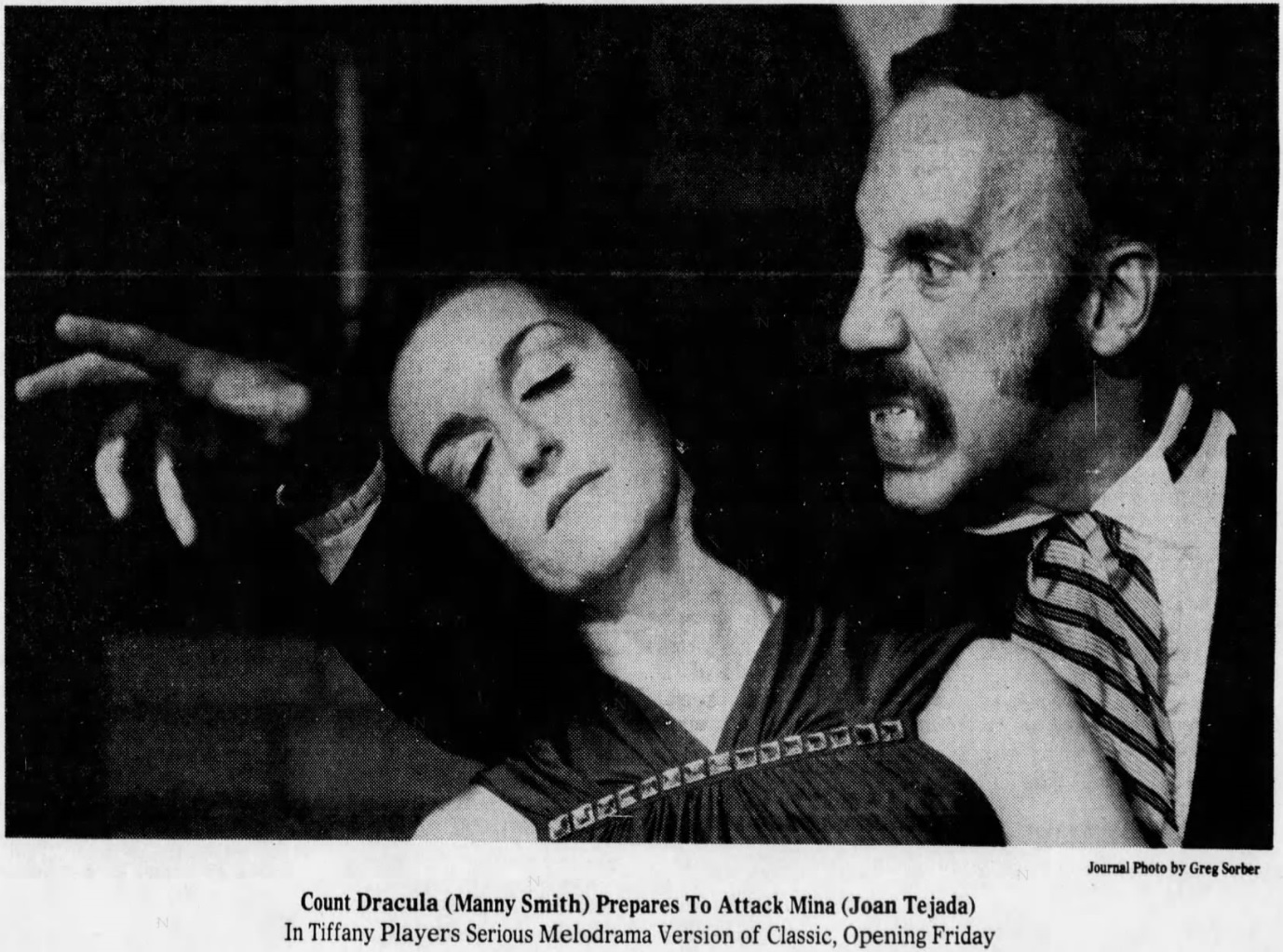
Here he is as his own peculiar interpretation of Dracula.
The Albuquerque Journal, Thursday, 29 September 1978, p. C1.
A few years later I visited Mr. Smith again, in his classroom after school hours, and we finally hit it off.
Then I saw him perform a campy Dracula on stage and later he popped up in a bit part with John Carradine in an abysmal flick
called either Monster or Monstroid
that went straight to VHS, where it was hosted by Elvira, Mistress of the Dark.
Oh, here it is.
Download it before it disappears.

That ain’t his voice. No idea who dubbed him.
My heavens! His voice could almost rival that of Christopher Lee,
and so filmmakers either told him to do silly accents
or they got somebody to dub him.
Go figure.
In my memory it was only months afterwards, but in fact, now that I check, I see that it was decades afterwards that the newspaper reported that he had died.
He wasn’t even old.

The Albuquerque Journal, Tuesday, 29 August 1995, p. C2.
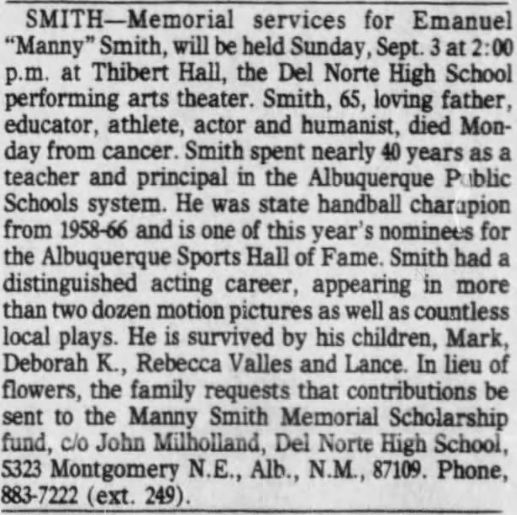
The Albuquerque Journal, Friday, 1 September 1995, p. D15.
By the time I was eleven, the only surviving Greek relatives were my grandmother and great-grandmother .
From the time I was born, my parents moved repeatedly just to get away from them,
and each time we moved, they would move next door to us.
At age eleven, we were in Albuquerque and they stayed behind in Mount Vernon, New York.
Sigh of relief.
Then, when I was twelve, they moved in with us.
In school, one of the many issues that bothered me
was the Greek world and the Roman empire being covered almost every autumn with a week or two of insipid narratives.
The teachers (except for Mr. Smith) and the texts made the ancients an unfathomable enigma, entirely unhuman.
Worse, those dreadful illustrations, supposedly designed to show us what ancient Greece and Rome looked like, made the topic entirely alien.
This may as well have been another species in another galaxy.
I couldn’t relate, but I wanted to.
I couldn’t articulate the problem at the time, but now I can:
I resented real people being distanced from me, from my understanding, from my emotions.
I resented having them depicted as something other.
That bothered me. The descriptions and illustrations were nightmarish.
I wanted to humanize the ancient Greeks and Romans, else I would continue to live inside a nightmare.
I wanted to dig in, and I thought the best way would be through the actual literature.
Oh, if only Mr. Smith had just told me about Edith Hamilton’s seductive book, The Greek Way.
If only he had shown me where I could learn conversational Classical Greek. Ohhhhh....
There was also a further ingredient that got me interested, and this was a further trigger:
The way teachers pronounced the letters of Greek alphabet in school, for math class and so forth,
and the way they pronounced the occasional Greek root of an English word,
was so dreadful, so totally wrong in every way, that I cringed in agony.
I was determined to set this right once and for all.
’Twas a childish ambition.
In tenth grade, age 15, I elected Latin class and took two years’ worth.
I would have preferred Greek, but Greek was not taught in school.
So, Latin would have to do.
After all, Latin and Greek were the two major languages in the Roman empire, and so it would be a nice start, I thought.
Then came the shock.
As with all the other students in the class, I came out of the second year knowing nothing.
We could not speak, understand, read, write, or even translate Latin.
To my surprise there was no Latin conversation. None. Not a sentence of Latin conversation. Not even once. Never.
I assumed, like all the other students seemed to assume, that once we had mastered the basics, we would begin to talk.
Wrong!
You see, our teacher emphasized the importance of grammatical terminology
as well as the technical names of all noun and verb endings.
We all got passing marks because we could distinguish a third-declension noun from a first-declension noun
and because we could distinguish an ablative from an accusative.
Not one of us could understand a sentence, though.
Our job was to translate into English, not aloud, but only on paper.
At first the stories were simple.
After we studied countless paradigm charts and learned endless grammatical terminology,
and as we were being drilled and tested relentlessly on this material,
our teacher (who shall remain nameless) assigned us a simplified version of “The Ant and the Grasshopper,” reduced to six short paragraphs,
as it appeared in our textbook.
What was that textbook?
Hmmmmm. Let’s explore. What Latin texts were used in high schools back in the 1970’s?
Web searches revealed the popular titles.
Was it Ullman/ Henry’s
Latin for Americans I and II (Macmillan)?
Was it Hines/ Welch’s
Our Latin Heritage I, II,
III,
IV, (Harcourt Brace)?
Was it Breslove/ Hooper/ Barrett’s
Latin: Our Living Heritage I and II (Charles E. Merrill Publ.)?
Was it Burns/ Medicus/ Sherburne’s
Lingua Latina I and II (Bruce Publ.)?
Was it Crabb’s
Living with the Romans I and II (Lyons & Carnahan)?
Was it Jenkins/ Wagener’s
Latin and the Romans I and II (Ginn)?
Was it Page/ Beckett/ Rutherford’s
Gateway to Latin (Gage)?
Was it Gould/ Whiteley’s
A New Latin Course I and II (Macmillan)?
Was it MacNaughton/ McDougall’s
New Approach to Latin I and II (Oliver & Boyd)?
Was it Jenney/ Smith/ Thompson’s
First Year Latin (Allyn and Bacon)?
Was it Sweet’s
Latin: A Structural Approach (U. of Mich.)?
Was it Taylor/ Prentice’s
Our Latin Legacy (Clarke, Irwin & Co.)?
Was it Taylor/ Prentice’s
Living Latin (Clarke, Irwin & Co.)?
I couldn’t remember.
They did not look familiar, not even a little bit.
What was it?
A ha! I just visited a book shop and there it was!
What a coincidence! I hadn’t seen this since 1977,
and as soon as I wonder about it in early 2016, there it suddenly is, right in front of my nose!
Is the universe trying to tell me something?
Annabel Horn, John Flagg Gummere, and Margaret M. Forbes, Using Latin,
(Chicago: Scott, Foresman and Company),
Book One (1961) and
Book Two (1963).
Bingo! Five bucks a volume, and each volume was unused, unread, brand-new condition though the paper had inevitably aged.
The hinges were still stiff. These two volumes had never been opened.
These were promotional copies, and tucked inside the front cover of Book Two was an advertisement boasting the virtues of the course.
I couldn’t resist and purchased the set.
My memory is that our teacher selected certain exercises and skipped around,
that she only used Book One, and that in two years of schooling, she never even had us finish that first volume.
We never saw the second volume.
Now that I’m looking through these two volumes, I see that my memory was right.
We were not to speak “The Ant and the Grasshopper” aloud. We were not to have a class discussion about it.
We were to translate it into English, with pen and paper, in our 55-minute class time.
To get some air into our lungs, our teacher walked us out of the classroom and sat us down on a sports field nearby,
breaking us up into five or six groups.
Though “The Ant and the Grasshopper” was the simplest Latin imaginable,
we were reduced nearly to tears at our inability to make sense out of any of it.
Even such a basic statement as “Tu pigra es!”
elicited gales of laughter from those who attempted to force it to make sense:
“You lazy es!” Unforgettable.
Am I saying that I immediately understood that three-word sentence? No. It gave me enormous difficulty.
As a matter of fact, all 30 or so students in the class labored mightily over that three-word sentence.
Not one of us could understand it on first reading — or even on tenth reading.
“Pigra” was in the dictionary at the back.
Most of us remembered that “tu” meant “you,”
but nobody could find “es” in the dictionary at the back of the book.
After maybe five minutes I finally remembered that “es” followed “sum” and blurted that out to everybody in my group. Ah!
At long last we deciphered that sentence.
Why did it give us such difficulty?
You see, we had by then been trained on nominative and accusative singular; subject; direct object; predicate noun/adjective;
ablative with preposition; plural nouns; verb endings in -t and -nt; ablative/accusative with prepositions;
apposition; position of adjectives; case uses; words ending in -ia, -tia/-cia, -ula; genitive case; tense;
forms of sum; person; number; dative case; indirect object; dative with adjectives; masculine nouns in -a;
declension I cases and case uses; first and second conjugations; infinitives; present stem/tense.
Oh heavens above. No wonder nobody could get a grasp of the language.
With painstaking analysis, we could name the forms we were looking at.
We could reproduce these charts in our sleep — actually, I think I did.
We could hic-hæc-hoc-huius-huius-huius-huic-huic-huic-hunc-hac-hoc-hōc-hāc-hōc-hī-hæ-hæc-hōrum-hārum-hōrum-hīs-hīs-hīs-hōs-hās-hæc-hīs-hīs-hīs-ipse-ipsa-ipsum-ipsīus-ipsīus-ipsīus-ipsī-ipsī-ipsī-ipsum-ipsam-ipsum-ipsā-ipsā-ipsō-ipsī-ipsæ-ipsa-ipsōrum-ipsārum-ipsōrum-ipsīs-ipsīs-ipsīs-ipsōs-ipsās-ipsa-ipsī-ipsī-ipsī
with the best of them, we could recite these charts until we turned blue in the face, but to what avail if we never practiced using the language?
What would it profit foreigners in an English class to learn nothing but such chart forms as the following?
INDICATIVE Present: I do, you do, he/ she/ it does, we do, you do, they do.
Preterite: I did, you did, he/ she/ it did, we did, you did, they did.
Present continuous: I am doing, you are doing, he/ she/ it is doing, we are doing, you are doing, they are doing.
Present perfect: I have done, you have done, he/ she/ it has done, we have done, you have done, they have done.
Future: I shall do, you will do, he/ she/ it will do, we shall do, you will do, they will do.
Future perfect: I shall have done, you will have done, he/ she/ it will have done, we shall have done, you will have done, they will have done.
Past continuous: I was doing, you were doing, he/ she/ it was doing, we were doing, you were doing, they were doing.
Past perfect: I had done, you had done, he/ she/ it had done, we had done, you had done, they had done.
Future continuous: I shall be doing, you will be doing, he/ she/ it will be doing, we shall be doing, you will be doing, they will be doing.
Present perfect continuous: I have been doing, you have been doing, he/ she/ it has been doing, we have been doing, you have been doing, they have been doing.
Past perfect continuous: I had been doing, you had been doing, he/ she/ it had been doing, we had been doing, you had been doing, they had been doing.
Future perfect continuous: I shall have been doing, you will have been doing, he/ she/ it will have been doing, we shall have been doing, you will have been doing, they will have been doing.
Would a student be able to purchase groceries with such a skill? Read a book? Listen to the news? Chat over a dinner with a friend?
Yes, we need to know this, but this is not the be-all and end-all of the language,
and we cannot learn it by rote memorization, but only by everyday use.
No conversation. No practice. Just forms and charts and pen-on-paper mistranslations together with the occasional vocabulary tests
and the requisite fill-in-the-blanks-yeah-I’ll-tell-you-what-you-can-do-with-those-blanks exercises.
We had not been taught how to make sense out of any of what we had learned.
We had not been taught how to put this knowledge together to express thoughts.
As I said before, and as I shall say again, there was no Latin conversation.
Think about it. Think think think.
If you’re reading this web page, you are fluent in English.
I bet you cannot tell me how many conjugations there are in English.
I bet you cannot tell me how many declensions there are in English.
I bet you cannot chart an English verb or an English noun.
I don’t know how many conjugations and declensions there are in English,
and I can’t chart English verbs or nouns either.
Many people argue that there are no conjugations or declensions in English, and that English words are not inflected,
which, they kindly explain by way of excuse, is why native English speakers have difficulty learning inflected languages.
English isn’t inflected?
Then what the heck is that fragment of a chart I reproduced above?
What a load of dingo’s kidneys!
English IS inflected!!!!!!
Many languages splice the inflections onto the ends of the words.
English usually staples them onto the beginnings, though in writing we leave a space before the root.
You don’t believe me. Okay:
| vocāre | to summon |
| vocō | I summon |
| vocās | you summon |
| vocat | she summons |
| vocāmus | we summon |
| vocātis | you summon |
| vocant | they summon |
| vocem | I may summon |
| vocēs | you may summon |
| vocet | she may summon |
| vocēmus | we may summon |
| vocētis | you may summon |
| vocent | they may summon |
| vocer | may I be summoned |
| vocēris | may you be summoned |
| vocētur | may she be summoned |
| vocēmur | may we be summoned |
| vocēminī | may you be summoned |
| vocentur | may they be summoned |
| vocātus sim | I may have been summoned |
| vocātus sis | you may have been summoned |
| vocātus sit | she may have been summoned |
| vocāti sīmus | we may have been summoned |
| vocāti sītis | you may have been summoned |
| vocāti sint | they may have been summoned |
| rana | frog |
| ranæ | frog’s |
| ranæ | to the frog |
| ranam | frog (direct object) |
| ranā | by the frog |
| ranæ | frogs |
| ranārum | frogs’ |
| ranīs | to the frogs |
| ranās | frogs (direct object) |
| ranīs | by the frogs |
See? English is inflected, and the inflections are pretty much as confusing as they are in other languages. I just picked up a learned tome by Thomas R. Beyer, Jr., entitled 501 English Verbs: Fully Conjugated in All the Tenses in an Easy-to-Learn Format. ¡Ay chihuahua! As I look through these conjugations, I’m at a total loss. What do they mean? “Express,” indicative, passive, past progressive: “I was being expressed, she was being expressed, you were being expressed...,” passive subjunctive present: “if I be expressed, if you be expressed, if they be expressed....” What on earth does that mean? Has anyone ever used such forms? Ever? “Hop,” passive voice, present: “I am hopped,” “you are hopped,” “we are hopped”; imperative mood: “be hopped”; subjunctive mood, future: “if I should be hopped,” “if you should be hopped”.... What? Who says such things?
Why do so many people insist that English is not inflected?
Answer: Because, in writing, we split the nouns and verbs with spaces between most of the varying inflections and the unvarying roots.
So, I suppose that if in Latin we were to write “voc ētur” and if in English we were to write “sheissummoned,”
we would conclude that English is inflected and that Latin isn’t. Whatever.
Let’s go further.
I bet you cannot identify which verbs and nouns are irregular.
I certainly can’t. I haven’t got a clue.
We do have irregulars, but I don’t know which ones they are, because they all seem regular to me.
(Oh, here’s one that just occurred to me: “go/went.”
Oh, and for a noun, we have “sheep” which serves as both singular and plural.
There are plenty of others. Heck if I know what they are.
I don’t want to see a list, because it would confuse me.)
I know we have more than one conjugation and more than one declension.
I don’t know what they are and I can’t tell the difference.
Yet I never make a mistake in these matters (unless I do so deliberately for satirical effect), and you probably don’t either.
So why, when teachers instruct us in another language,
do they abandon conversation in favor of all this meaningless technical garbage that not even native speakers know?
As has been proved, when a teacher discards all this gobbledygook and instead teaches conversation,
the students learn at lightning speed and nearly without effort.
We shall witness an actual demonstration in a link below,
when we hear an antique recording of W.H.D. Rouse conducting a Latin class.
Why is a language taught without speaking?
How well would we be able to swim if, without ever getting into the water, our only instruction consisted of a 500-page book
on muscle movements and the correlative foot-pound pressures and pulse rates of swimmers, together with water-volume displacement, and if we were to memorize
the circumference and angle of each stroke and every technical term for every physical phenomenon,
upon which we would be tested during lengthy biweekly multiple-choice and fill-in-the-blank tests?
This is how languages are taught.
“Non val la pena d’ impararlo a leggere, senza impararlo a parlare.”
— H.G. Ollendorff (1846)
— H.G. Ollendorff (1846)
In looking through this Using Latin course again now, I see that it’s not terrible.
Not at all. Actually, I have to admit it, this course is pretty darned good,
much better than most courses I’ve run across.
The illustrations are lovely, and the English-language essays about Roman life and culture are splendid.
We skipped all of that.
On the other hand, the readings are dull, but they are fulsome,
and a creative teacher would be able to use this book as a basis for conversation.
A creative teacher, using this book, would have students speaking within the first minute of the first day of class.
Classroom conversation, entirely in Latin, would have been the key to understanding.
If, instead of having us painfully decrypt “The Ant and the Grasshopper” into English,
our teacher had conducted a one-hour conversation with all the students about it, entirely in Latin,
using only vocabulary we already knew, asking simple questions about the story,
that would have made a world of difference.
We all would have understood.
The thought never crossed the teacher’s mind.
That’s not the way she taught.
She would drill us mercilessly on paradigm charts of noun endings and verb endings,
assign us to do the multiple-choice and fill-in-the-blank exercises with pen on paper,
and then have us translate the stories into English, with pen on paper.
She was satisfied when, after an hour in class, we managed torturously to translate a few sentences into English.
It was not her job to teach us to understand Latin, but rather just to decrypt it and render it into English.
The endless charts were the decryption keys. That, apparently, is why we needed to memorize those charts.
The goal, she said, was to improve our English skills.
That was the only stated goal — frustratingly incompatible with my personal goal of learning Latin.
She seemed to assume that understanding followed memorization of technical names and memorization of charts,
that the language would then be so obvious that conversation would be entirely unnecessary,
and that we would somehow figure it all out for ourselves — by what form of magic I do not know.
I was so embarrassed when the other kids in school, upon discovering that I was in Latin class,
would request, “Say something in Latin!”
I couldn’t. No Latin student could.
We never spoke a sentence of Latin in class; we seldom even spoke a word,
but we could recite the verb endings and the noun endings.
Not long after “The Ant and the Grasshopper,” we were assigned texts of considerably greater difficulty.
“Colui che vuol insegnare un’ arte deve conoscerla a fondo;
bisogna che non ne dia che le nozioni precise e ben diregite;
bisogna che le faccia entrare ad una per una nello spirito dei suoi allievi,
e sopra tutto bisogna che non sopraccarichi la memoria loro di regole inutili e vane.” — H.G. Ollendorff (1846)
I’m looking through this Using Latin book some more.
If students would simply ignore their teachers and work their way through this book leisurely,
reading the stories aloud over and over and over and over and over and over again until they become as easy as English,
then students could learn the language through this course.
Skip the multiple-choice and fill-in-the-blank exercises, please.
Skip the numerous sections about Latin roots of English words, please.
Other than that, the book is fine.
Rather, I should say that it is about as fine as such a book could possibly be.
I wish language courses would be taught without books, without writing.
There should be only speaking. Students should not see anything written until after they’re speaking with confidence.
Even with a good book, though, the problem is that the class work and the homework consisted only of written translations and fill-in-the-blanks.
In my view, translation should be forbidden. The students should simply speak Latin in class.
English should be used only sparingly. By the end of the first semester English should be dropped altogether,
and class should be conducted entirely in Latin.
That would solve all the problems in a moment.
That isn’t done, though, ever.
The normal excuse is that it is literally impossible to speak a dead language.
Drop that lame excuse. Latin is not a dead language.
It has been continuously spoken for over two thousand years.
It’s no longer a native language, but it’s not dead by any means.
Speaking, though, is not what happens in any course.
Translation is the rule — the only rule.
So, students labor through a lesson and stop, dead exhausted, when the homework assignment is finally finished at eleven at night.
That is so wrong.
That method is entirely counter to the goal of the Using Latin book.
It is amazing to me that, using a text like this, our teacher was able to render the language incomprehensible.
She was typical, though. I doubt there was ever a teacher anywhere who, using Using Latin, did it any differently.
Our teacher should have named her course “Misusing Latin.”
The homework, which converted simple readings into impossibly difficult readings, should never have been given.
If the subject — any subject — cannot be covered in class time, then homework cannot make up for the deficit.
Homework is nothing more than useless and unproductive labor, much like Bentham’s Panopticon.
It is designed to keep idle hands busy and to bore students nearly to death.
As such, it’s a great way to flunk out the brightest students (whose minds are too active to endure tedium)
and to heap all credit onto mediocre students (who have no problem with mindless tedium).
If class were taught well, no homework would be necessary or helpful in any way at all.
Let’s think about homework for a minute.
School begins at eight in the morning and ends at about three-thirty in the afternoon:
seven and a half hours, usually six classes a day, to which must be added travel time, an average of about 30 minutes each way.
So, say school is eight and a half hours per day.
Each class demands about one hour of homework a night.
Eight and a half plus six equals 14+ hours a day that students need to take copious notes as boring teachers drone on and on
and then suffer through boring reading and writing exercises in the evening.
Homework is doubled or trebled for the weekends.
When I was in school, I thought that was a bit much.
(Home life was, if anything, even more maniacal than school life,
and so for the sake of my sanity I would skip homework and sometimes even skip class just to get a breath of fresh air,
chat with a friend, see a Lloyd or Chaplin movie at the Sunshine Theatre,
stroll the streets in downtown to admire the old architecture that nobody else noticed, read a Dostoyevsky novel,
something, anything, to escape the madness for a few hours.
I could never catch up on missed lessons, my grades suffered, and that led to countless panic attacks.
My attitude was horrible, I was about as approachable and snuggly as a cactus,
and there is good reason that a number of people disliked me intensely.)
With such a schedule, it is impossible to lose oneself in any topic.
Learning can happen only by losing oneself, and school forbids that.

“Why Finland Has the Best Education System in the World,”
https://youtu.be/nHHFGo161Os
So there.
I have had this DVD sitting on my shelf for years but never watched it.
Then I discovered this sequence posted on YouTube.
I guess I should have watched that DVD.
Now let’s return to “Tu pigra es!”
Even without ever having learned the technical names of formal second-person present singular, emphatic personal pronoun, and so forth,
anyone raised speaking English can, by the age of three, easily understand the sentence, “You’re lazy!”
or even “Lazy you are!”
Nobody needs to know how to chart the phrase and break it down and provide the technical name for each part of speech
in order to speak such an impromptu sentence or to understand it.
We don’t — and shouldn’t — learn the technical linguistic terms
until after we know how to speak with ease.
The linguistic studies are to refine our understanding of a language we already speak fluently.
Latin class was all backwards.
I did not understand this at the time.
I just thought I was stupid. I was embarrassed half to death by my stupidity.
For two whole years I kept trying harder and harder and harder not to be stupid anymore.
The harder I tried, the harder I failed.
Looking back on it, how I wish someone had simply given me the simplest advice:
“Go over the first volume again, beginning on page one, and read each story twenty or thirty times over, aloud,
until it becomes as easy as English. Take your time. Don’t rush. Do it over summer vacation.
You’ll be surprised at the result. It’s like magic!”
There was no such advice.
Two years did I suffer failure after failure after failure, each worse than the last, as the class got harder and harder and harder.
We would spend hours — in groups! — attempting to translate a mere few lines.
A week or more could go by, in sheerest torment, before we succeeded in translating a single paragraph into English,
only to discover upon submitting our result that we had translated it incorrectly (only the teacher had the answer book).
In succeeding years, I looked into various language courses taught in schools and universities and even enrolled in a few.
They are all backwards.
The students never learn to speak the languages they are studying.
The rare student who is rich enough to spend a year or so in the country of choice, of course, comes back with fluency.
The majority who do not have that luxury conclude that they have no talent for languages.
Just discovered there was also a
Using Latin Book Three in 1968. Never seen a copy. I have one on order.
22 February 2016: Just arrived. As-new condition.
Wow. Impressive. Previous editions were copyrighted in 1939 and 1954. Who knew?
Why isn’t this course being used anymore?
Did you notice that I mentioned the answer book? Answer book. Answer book. Answer book. That makes me wonder something.
Yes, each volume had answer books and teachers’ guides:
Using Latin 1 Guidebook,
Using Latin 1 Translation Key,
Using Latin: Answer Key to Tests and Practice for Book One,
Attainment Tests for Using Latin Book One,
Using Latin 2 Guidebook
(earlier edition here),
Using Latin 2 Text Edition,
Using Latin: Tests for Book Two,
Attainment Tests for Using Latin II,
Using Latin 2 Translation Key,
Exercises in Writing Latin for Using Latin III,
Tests and Practice for Using Latin III, and
Guidebook and Translation Key for Using Latin III.
Isn’t this ridiculous? Why on earth would this rubbish be needed? If the teacher knew the language, the teacher would not need cheat books.
So apparently the authors of Using Latin understood from the outset that their exceptional text
would be in the hands of incompetent teachers who were unable to speak a sentence of the language.
Now, let’s think this through.
When your mommy took a few steps in front of you and said, “I’m walking,”
and then when she held up your hands and helped you take a few steps and said, “You’re walking,”
and then when she took a few steps along with you, saying, “We’re walking!”
you began to learn English.
Now, suppose your mommy hadn’t done that.
Suppose, instead, that your mommy had taken a few steps and said,
“First-person singular present gerund of the regular intransitive ‘walk,’ ”
and then held your hands up and helped you take a few steps with the explanation,
“Formal second-person singular present gerund of the regular intransitive ‘walk,’ ”
and then walked with you to say,
“First-person plural present gerund of the regular intransitive ‘walk,’ ”
you would have burst into tears and to this day you would never have learned a word of English.
Evening: “Tell your daddy what we did today!” Silence.
Mommy gets worried and nervously prods you along:
“First-person singular and plural and formal second-person singular present gerund of the regular verb ‘walk.’
Don’t you remember, dear?”
Daddy would not have been pleased. Why couldn’t his child answer right away?
Yes, that’s how we were taught Latin.
“Pop quiz: Write an active-voice sentence using a second-declension masculine-singular nominative
with past participle and plural third-declension neuter genitive
with a third-conjugation third-person-plural pluperfect main verb
and a perfect-tense third-person-singular intransitive fourth-conjugation auxiliary verb with plural feminine accusative in the third declension
and neuter dative and masculine ablative both second declension, and be sure to emphasize the locative, while ending with a subjunctive phrase.
Geraldine, what’s taking you so long?
If you can’t follow such simple instructions, why don’t you drop and take an F and switch to some Mickey-Mouse class
like basket-weaving or something?”
(I’m exaggerating a bit, but not much.)
The only way to learn. Yet we all got passing marks.
Despite my passing marks, the class wore me down, defeated me, made me feel like a total idiot, an abject failure.
It also made me much more hostile, much more of a nasty cynic than I had ever been before.
If memory serves, I got straight B’s.
Remember when you learned arithmetic?
You didn’t spend one night staring at an addition table and at a multiplication table to master the topic.
It took a lot of practice, didn’t it?
It took hundreds and hundreds and hundreds of hours of practice for seven or eight years, didn’t it?
After you were done, you never thought again about an addition table or a multiplication table, did you?
You just know how to add, subtract, multiply, and divide, right? You see 8×7 and you know that means 56, yes?
You don’t need to think of the table anymore, do you?
Similarly with languages.
Languages are more than tables and charts and rules.
Without conversation and/or immersion, you can’t learn a language.
There is no conversation or immersion in any school that I know of, at least not in this country.
(Well, there is, but only at the FSI, and admittance is restricted to diplomats.)
Right at the beginning of Using Latin, Book One is a story about Roman aqueducts, all of six lines,
and that is followed, in the next lesson, by a story about American aqueducts, all of six lines.
My memory, which I’m quite sure is accurate, is that we spent several days on those twelve lines, and that we performed horribly.
A good teacher, instructing by conversation, would get through those two little stories in 30 minutes or less.
A good teacher, instructing by conversation, would happily get her students fluently to the end of the first volume before the end of the first semester,
and there would be no confusion at all.
We did not have a good teacher, yet we got passing marks, because we could recite the noun endings and the verb endings.
Unfortunately, my memory of high-school Latin class is incomplete.
Our teacher was a nice gal, I admit, but she had not a clue about how to teach her subject.
The ebullience she displayed on the first day of class steadily declined over the months, as she became ever-more exasperated with us hopeless students.
She was quite young, and I wouldn’t be surprised if this was her first time teaching.
During the first year, she drilled us mercilessly on word endings and grammatical terms.
When she saw that not a single one of us could understand a sentence, she did not alter her teaching method to accommodate us.
Eventually she would offer translations from the answer book,
and we would see that, yes, the translations seemed to make sense, but we could never understand why, and we could never do such a translation on our own.
If she were to have graded us fairly, she would have awarded each of us a zero percent.
That would not have pleased the school board, though, and so she passed us all with A’s, B’s, and C’s.
Now, if a teacher sees that not a single student can understand a single sentence, then that teacher should begin to question her teaching method.
She did not. She assumed the students were at fault, not she.
She did no soul searching. She asked nobody for advice. She just kept drilling us on word endings and grammatical terms.
When we failed to understand a sentence, she would drill us more on word endings and grammatical terms and assign us written homework to drill even more.
So, we never dwelled on any of the book’s stories.
We never understood one. Not one. Not a single one.
As the first year dragged on, she told us to bunch up our desks and work in duos or trios.
We did. It helped not a bit.
In the second year, she operated out of a different classroom, one that had tables in place of student desks.
We worked in groups of three or four or five or six.
As we struggled, the teacher just sat at her teacher’s desk, doing paperwork that seemed unrelated to class,
and simply left us to sink on our own and drown.
By the last semester, nobody was putting any further love into the class.
It was with resignation that we sat ourselves down at our tables, knowing that there was no way out of this mess,
that there was no way to make head nor tail of the readings,
that our brains were far too small to memorize all the paradigm charts,
that when we saw, for instance, tēlæ,
we could not figure out whether it was nominative plural or genitive singular or dative singular maybe something else altogether.
Only the context would tell us,
but the problem with context was that we had the exact same problem with every other noun and verb and adjective and adverb and gerund and participle in the sentence.
So, we sat together in our groups, pens and notepads in hand,
discussing with no enthusiasm about how to piece the jigsaw together,
looking up every chart to see which endings matched, waiting in agony for the bell to signal the end of class.
When after twenty minutes we figured out how to decrypt a sentence in a way that kind of made some vague sort of sense,
we would give up on it and move to the next sentence, which completely mismatched the previous sentence.
We no longer cared.
We would perform the same surgery on the next sentence, and then discover that the third sentence was another mismatch.
Oh well, we knew we could never get anything right, but we knew also that no matter how goofy our mistranslations were,
we had enough excuses to provide the teacher that she would pass us anyway.
I remember a high-school chum showed me a page from National Lampoon.
He thought I’d be amused.
Which issue? I don’t know.
Which year? Sometime between 1974 and 1981, I guess, though probably 1977 or 1978.
It was a little one-page photo-novel that showed us two guys in cheap imitation togas, and it opened with the guy on the left speaking to the camera:
“Do you remember how hard Latin was in school? Well, it was no easier for us Romans.”
The guy on the right says something in Latin, and the guy on the left asks what that means.
“I don’t know.”
Then the guy on the left says something in Latin to the guy on the right.
“What did you say?”
“I haven’t got the foggiest idea.”
The guy on the left turns to the camera again: “See what I mean?”
It was too true. Too true.
As I now leaf through this Using Latin book, I discover to my surprise that, after page 55, there is not a single story I remember, not even vaguely.
It is as though I am seeing these stories for the first time.
I remember only the tables and the grammatical terms, on which we were so abusively tested.
So, I’m curious, and I’m looking through Using Latin, Book One,
while searching the cobwebbed corners of my memory, to see if I can recognize where we left off.
I think that by the end of the second year we were midway through Lesson LXX, page 354.
Two years. Two years. Two years to get to page 354 of a book that, I can now see, is incredibly easy.
I think the ablative absolute (page 348) was the last formula we were told to memorize,
and because the year was grinding to an end, not one of us bothered to memorize that formula.
In looking at this passage again, I see that what it presents is not even a formula.
There’s nothing to it at all.
I don’t even know why students need to learn the term “ablative absolute,”
since anybody can understand it and speak it without any explanation,
without knowing that linguists take an interest in this entirely unremarkable, entirely self-evident sentence structure.
The meaning is obvious without explanation, and anybody encountering it a few times would unconsciously begin to adopt it.
What’s the big deal? Sheesh.
Then we all just sleepwalked through the opening of Lesson LXX, and we were done, not caring any further,
all of us knowing we would get our passing marks and then be done with this rot forever.
By the end of the second year, spring 1977, my impression was that the teacher was nearly as relieved as the rest of us that the agony was drawing to a close.
By the next semester, autumn 1977, she was gone.
Had she resigned? Had she transferred? Had she been canned? I never learned.
Here’s what’s so crazy:
Suppose that, without ever having enrolled in Latin class, I had found Using Latin at the nearby Goodwill second-hand shop for twenty-five cents.
What would I have done? Simple: I would have begged my parents for twenty-five cents,
and then I would have walked back to the Goodwill and purchased the course and whizzed through it without a problem.
I would simply have treated it as anything else I studied on my own:
I would have spent a winter vacation or a summer vacation on it, I would have lost myself in it, and I would have reviewed, reviewed, reviewed.
It would have been so easy.
I never once treated class work the way I treated self-study, unfortunately,
simply because, during a school year, there was never a moment in which to do so.
That was my scholastic doom — and not only mine.
Since the teacher was teaching, I let her do the teaching.
I was convinced that a professional would be better at teaching me than I would be at teaching myself.
When the class proved impossible, I was certain that I was at fault.
It never occurred to me to try a different method.
I simply thought the topic was beyond my ability.
I was determined to try it again, though, after maturing a little bit.
In my decades on this planet, I have discovered that what I perceive is not what others perceive,
that my conclusions differ entirely from other people’s conclusions.
When I speak, others misunderstand what I say.
When others speak, I am continually caught off-guard and do not know how to respond adequately.
There is nothing to be done about this.
A year or so after having completed those two torturous years of high-school Latin, I bumped into a fellow alumnus at the Coronado Shopping Center.
We chatted for a while, and I began to remark how odd and how preposterous and how criminal it was that, after two years of torment in Latin class,
neither of us could speak, read, write, or understand a single sentence.
I began to make that remark, but I did not finish.
You see, as foreigners cannot help but notice, with the blessed exception of the American Indians, US citizens do not converse. Not at all.
Instead of conversing, US citizens aggressively cut one another off in mid-sentence.
Apparently, US citizens consider that to allow the other person to complete a thought is to concede defeat, and US citizens hate to be defeated.
So, before I could get more than three or four words out, my fellow alumnus cut me off at the utterance of the word “Latin.”
He blurted out that, now that he had mastered Latin, he was planning to conquer a different language (I cannot remember which one).
I was dumbfounded.
Mastered? Mastered? What had we mastered?
That was my first encounter with the idea that students are convinced that they have “mastered” a discipline
by simple virtue of having attended class and gotten a passing mark.
Skill is not the issue, as far as they are concerned.
Only the mark on the report card counts for anything.
Thus, a good mark in Latin means mastery of Latin, even though the student cannot understand, speak, read, or write a single sentence of the language.
I find this nightmarish, worse than surreal.
Few would agree with me.
At about the same time I started Latin class, I deviously picked up a little bit of Greek, too, courtesy of Sofroniou’s little
Teach Yourself book and the
Cortina book with its accompanying 12" vinyl records
(I think the set included ten records, which seem not to be available anywhere anymore for any price — I should dig mine out of storage —
oh, wait, the entire set was just posted at Yojik),
and when I could finally understand some of what my grandmother and great-grandmother were saying behind my back,
I discerned at once the real reason why they had not wanted me to learn Greek.
(Life Lesson Number Two: Genuinely sweet people never make a show of being sweet.
People who make a show of being sweet are putting on an act. Beware.)
Other members of my family did not speak a single word of Greek and had no interest in learning.
My father grew up speaking Hindi, Punjabi, and Urdu, and the RAF taught him some French and German.
(How do I know this?
I know this only because my seventh-grade English teacher at Cleveland JHS was John Duran, who reminded me so much of
Mitch Miller.
Mr. Duran asked my father to address class one day for a couple of minutes,
and this is what my father told everybody. It was all news to me.
In those few minutes I heard nearly all I ever learned about his earlier life.
He was an extremely uncomfortable public speaker, by the way.)
Only once did I hear him speak one of those languages.
We were in a car with one of his acquaintances from the old country, and the conversation was in English.
Then, for just a few seconds, when he said something that he didn’t want me to understand, he switched to one of his native languages.
Then it was right back to English.
Never again did he speak so much as a syllable of any of these languages in my presence. “We’re AMERICANS now!!!”
He was disgusted beyond words when I showed interest in Greek.
Now, when I discovered, around age 16 or thereabouts, that Classical Greek and Modern Greek were different animals,
my Greek grandmother and great-grandmother blew a million gaskets.
They were screaming that I was telling lies, lies, lies — lies for which god would never offer forgiveness.
They insisted that Greek had never changed since god established it at the beginning of the universe
a few thousand years ago as the original and only true human language.
Because Greek was established by god as the only true human language, it could not possibly change — ever.
To suggest otherwise was a sin, a sin so vile that not even confession on Sunday would absolve it.
As for my statement that the pronunciation had changed over the past three thousand years,
that, too, was an unutterable offense against god and all his creation.
Any attempt at reconstructing an earlier pronunciation was offensive, worse than offensive,
it was an outrage that put me at grave risk of spending all eternity in the fires of hell.
They were convinced that
the current pronunciation was the original pronunciation.
It was anathema, apostasy, heresy, blasphemy to say otherwise.
Realizing that she was on the verge of cardiac arrest, my great-grandmother tried to psych herself into relaxing,
and then, forcing on a smile, she recited a prayer in the Modern Greek pronunciation,
which proved, to her satisfaction, that Greek had never changed.
Irrefutable logic.
Of course, anything can be mispronounced, which is an argument my familial Greeks would never have understood.
Also, never mind that the prayer, from Byzantine times, had from its beginning been in pretty much the Modern Greek pronunciation,
because it was essentially Modern Greek.
After that lengthy scene, unwitnessed by any other family members, I learned that it was best to keep my mouth shut.
I discovered, at age 21, that this was the common perception among Greeks —
not all Greeks, of course, but certainly the Greeks who were known to my family.
My great-grandmother , normally devoid of any form of curiosity,
decided that she wanted to learn a little bit about Spanish.
That was, I think, in 1980.
She asked if I could go to the library and get her a book, any book, in a parallel Greek/Spanish translation.
No problem.
I checked out a volume of Plato’s dialogues, and she could not make head nor tail of them, but would not admit to such.
She just quietly gave it back and said that the Spanish was too advanced for her.
I was expecting the standard excuse that there were better things to do than to look at the works of a heathen,
but she did not make that excuse, I assume because she had no clue who Plato was.
I doubt her education extended beyond age eleven, and by age twelve she was assisting at a military hospital when the First Balkan War was declared.
She was shattered by what she witnessed, with skulls blasted off revealing brains.
I wanted to hear stories, but she did not know how to tell stories.
That was the only detail she revealed.
Then she had a shotgun marriage at age fourteen.
She never said that it was a shotgun marriage,
but the details she inadvertently let slip left room for no other interpretation.
My grandmother and great-grandmother blew even more gaskets and went on screaming rampages
when I pointed out that they were mispronouncing the word “Byzantine.”
I knew to keep my mouth shut, sealed shut with glue, but I nonetheless made the dumb mistake of saying something.
They pronounced the word as “Bison Teen,” and went through the roof with blood-curdling shrieks that “Bison Teen”
was correct.
“It’s Bison Teen, Bison Teen, Bison Teen!!!!!!” came the deafening screeches.
My offer to open the dictionary was rebuffed, for the dictionary was certainly wrong, because the Greek was
“Βυζαντινός,”
“which means it’s Bison Teen, Bison Teen, Bison Teen!!!!!!”
Again, that was irrefutable logic.
After all that, why did I later point out that their pronunciation of epistle, EH-pist-əl , was incorrect, and should be, instead,
e-PIS-əl.
Screams, shrieks, endlessly.
Grandmother: “In Greek it’s ἐπιστολή,
and so it’s EH-pist-əl , EH-pist-əl , EH-pist-əl!!!!! ”
Realizing, again, that her dangerously enlarged heart was about to give out, my great-grandmother tried to calm herself down,
and then made a joke, forming her fingers into a hand gun, saying that my pronunciation was a mistake for “a pistol.”
I never made a comment to them again, about anything, unless it was false flattery to calm their rattled nerves.
When they later asked for my opinions, I just said whatever would make them happy,
and tried not to cringe at their defiant looks of smug satisfaction.
My grandmother had a fourth-grade education, which convinced her that she was smarter than any other lay person,
and which also put her, I think, a year ahead of my father, who was similarly convinced that he was smarter than almost anybody else.
I went to the university. I didn’t want to, but my father’s word was law, and he was paying out of his meager funds.
Meager the funds were, and meager was tuition: about $400 per semester and a further $400 per semester for textbooks.
(Nowadays the price has gone up ten-fold.)
This was about the last thing in the world I wanted.
I so much wanted to get a job and move out on my own.
Surprisingly,
I had gotten a job while still in high school: minimum wage and fired within four months.
This was Albuquerque: If you were a CPA or a nuclear physicist, the gates would swing open wide.
If you were anything else, good luck.
Maybe after a year of searching you could land a job as a janitor or busboy and then be fired without pay after two days.
New Mexico was the third-poorest state in the union, so what do you expect?
(Things have improved, though. Now it’s the sixth-poorest,
with the second-highest poverty rate and third-highest unemployment rate.)
Since I couldn’t find employment anywhere, I continued to live at home where I was at my father’s mercy.
He had no mercy. So, I went to the university.
I soon came to a conclusion that I never had the courage to utter aloud until just these past few weeks: Higher education is a scam.
“Racket” might be a more appropriate word.
There are rituals, but there is no learning, or almost none.
Higher education, just as lower education, is designed not to enlighten us,
but to turn us all into automata, and to give the illusion of learning.
As for the frequent complaint from the far right that universities are bastions of liberal propaganda, my response is simple:
That complaint was invented by people who had never sat in on so much as a minute of a university class.
Universities are bastions not of liberalism, but of suppression and stultification.
Universities do not indoctrinate liberal ideology; they indoctrinate apathy.
It’s all a fraud — kindergarten through graduate school, it’s all a fraud.
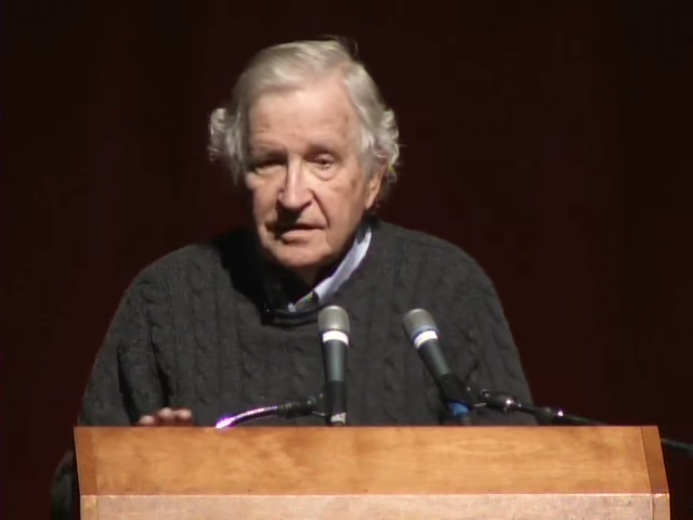
“Education: For Whom and for What?”
This was an invited lecture presented, ironically, at the University of Arizona.
I enrolled in Latin 101, hoping that this time it would be better and that I would finally master the language.
I was slightly older, slightly less immature, and determined never to give up on anything.
Since we were required to take four semesters of a foreign language, I took four semesters.
Text: Frederic M. Wheelock, Latin: An Introductory Course Based on Ancient Authors (Harper & Row, 1971),
supplemented, of course, by the professors’ own ideas and mimeographs.
There it was again: chart after chart after chart after chart after chart after chart
of noun endings and verb endings and the technical names of each,
along with rules, rules, rules, rules, rules, rules, rules, rules, rules,
followed by maybe 50 words of vocabulary for memorization,
then ten practice sentences, and finally a fill-in-the-bank quiz and a three-line translation exercise.
No conversation. No spoken Latin. None. Ever. Never never never never never never never never never.
Next lesson: charts and charts and charts and charts and charts
and rules and rules and rules and rules and rules,
50 words of vocabulary, ten practice sentences, a brief fill-in-the-blank quiz and a three-line translation exercise.
Then the professor (whose name I cannot remember) would hand out mimeographed sheets, saying,
“Now for some real Latin.
Your homework tonight is to translate this poem by Vergil.”
Nobody was learning anything. Most students dropped out. I couldn’t blame them.
Now, in all fairness I should confess that I was a moron.
I tried to look at the bright side, and, since Wheelock’s sample sentences were
not silly new readings about aqueducts or the ant and the grasshopper, but were instead all taken directly from Roman authors,
at the beginning of the course I said I was impressed,
and I really really really really tried to make myself believe I was impressed.
I was a moron.
Out of curiosity I just ordered a used copy of Wheelock’s 1971 edition.
I see now that my description above is not quite accurate, but who cares? The gist is correct.
Dreadful book. One of the worst books ever written.
Impossible to learn anything from it, except how to write a truly awful book.
Worse than philosophy books.
Worse than sacred religious books.
Worse than Krishnamurti.
Worse than von Däniken.
Not as bad as The Courage to Heal.
Worse than
Finnegans Wake and, if anything, even less comprehensible.
|
Suppose you want to make sure that,
no matter how many years you put into studying Latin, you’ll never be able to really “read” a sentence.
Is there a recipe for disaster here?
There is.
Here’s how to do it:
(1) begin studying from Wheelock’s Latin: An Introductory Course Based on Ancient Authors,
(2) following the book, learn little snippets of Latin grammar, always moving around among categories so that you’re thoroughly confused —
e.g., study a couple of verb forms the first week, then learn a noun declension, then learn a different verb tense, then move to adjectives — and
(3) make sure that your reading consists of short sentences taken from Latin authors about how the Romans hated money.
This way, you can make sure that you’ll never be able to read Latin even if you study it for forty years.
It passes the time.
|
And that, in a nutshell, is how we were all taught Latin in school.
You probably think I’m exaggerating about how badly languages are taught in school.
Well, read Daniel R. Streett’s
“The Man Behind the Curtain — or, The Dirty Truth about Most New Testament Greek Classes (Basics of Greek Pedagogy, pt. 2),”
καὶ τὰ λοιπά, September 10, 2011.
As you can see, I’m not the only one griping.
That’s about the most damning indictment of higher education that I’ve ever encountered, and it is true, completely true.
So, my grouchiness has good company.
Appropriately, The Life of Brian premièred at about this time.
Nice movie. Clever movie. Not a great movie, but a nice movie.
It had some good points to make about the authoritarian mindset and about the disordered desperation of the followers of Falwell and Bakker and their ilk.
It had one of the most tragically heartbreaking scenes in all cinema history (the hermit, if you’ll recall).
Overall, it was an extremely sad movie, but it did have some really good laughs (my personal favorites being the
rooster and
the space battle),
though one of the funniest moments hardly got a reaction:
It was a fairly large house that opening night, all things considered.
There were maybe 200 or so people in the auditorium of the Fox Winrock Twin Screen 1
(pitilessly carved out of the once-glorious Fox Cinerama).
By 1979 it was rare for an auditorium to get so many as 200 people at a time.
The audience, without exception, enjoyed the movie, and the laughter was frequent.
The above scene, though, got almost no response.
There were a couple of forced chuckles, here and there, which came at the wrong moments.
Apparently, most of the people in the audience had never been tortured by Latin instructors.
But... apparently a few had.
It was so easy to spot them.
I remember in the third semester we had a substitute professor one day when our regular instructor called in sick.
I can’t remember his name either.
He had us painfully translate some authentic Latin jokes, which he had recently discovered,
and he told us how shocked he had been by this discovery.
He had never before realized that the ancient Romans had had a sense of humor.
This, for him, was a revelation.
I listened in disbelief.
This was a professor? A professor, a Ph.D., who had passed his oral exams and had been admitted to teach at a university,
who didn’t comprehend that people 2,000 years ago could joke around and laugh??????
I didn’t even know how to react. I remember that my mouth was agape.
What did this guy grow up believing? Did he grow up believing that laughter was a US invention first patented in 1950?
It was in our third semester — no, not the third, the fourth semester — that our instructor chose not to instruct one day.
Instead she walked us a few buildings over to be the guests at a class in Roman history.
Out of discretion, I shan’t mention the historian’s name, except to say that I had never been at all impressed by him.
When class let out, I walked out with my instructor by my side, as she chatted with the historian.
He was quite intimidated to be speaking with a Latin instructor.
I can’t remember his verbatim comment, but I have no doubt that my paraphrase is nearly verbatim:
“Any other language, you just study it for six months and you’re speaking it.
But Latin, no. You study it for eight years and you still can’t read it!”
My instructor did not disagree.
By the fourth semester I was one of only four remaining students.
No. What am I saying? I’m misremembering. I was one of only three remaining students.
Lester gave up after the third semester.
With such a small population, there was no need to meet in a classroom.
We met instead in the instructor’s office. (I refuse to provide her full name.)
Our instructor grew excited when she discovered a passage of prose she had never seen before.
“Let’s translate this together!” she exclaimed.
She examined the first sentence for maybe ten or fifteen seconds,
trying with difficulty to figure out where the verb was.
“Maybe this is the main verb. Let’s see.”
Then she got lost and started looking up words in the Latin-to-English dictionary.
She tried the sentence again and again, “No, that’s not it.
That’s probably the verb in the subordinate clause.
So, this is probably the main verb.”
She tried it again, “Yes, that’s it. This is the main verb.
Okay. Let’s see. Hmmmmmm. That ablative must mean something else.
Let’s see what else it might mean.”
She looked it up in the dictionary. Maybe five possible definitions.
She tried them one by one until she found something that seemed to work.
This went on and on and on.
At the end of the hour, as we left her office and walked down the hall,
I asked her, “Diana, can you speak Latin?”
“Of course not! Nobody can!”
She said that happily, with a wide smile on her face.
“Can you think in Latin?”
“Of course not! Nobody can!”
“Can you read Latin without translating?”
“Of course not! Nobody can!”
That’s when I finally understood why I could never understand.
Never before had the light bulb come on. Never before had it clicked.
So, it wasn’t me after all!
It wasn’t my fault!
I wasn’t stupid! I was being taught by someone who didn’t know her topic.
I thought back and realized that none of my Latin professors and teachers was qualified to teach,
since not one of them could speak the language.
That’s why there was never any Latin conversation — not one line of Latin conversation. Ever.
That explained the historian, who specialized in Classical Rome, who also could not read, write, or speak Latin.
Why were these people teaching?
Why did they think they were qualified to teach?
Why were they allowed to teach?
As for Wheelock’s book, we never finished it.
This was just like high school:
two years and we never finished it.
It was too difficult for the students.
It was too difficult for the instructors.
So, we never finished it.
Hmmmmmm. Where did we leave off?
I leaf through the pages, and to my surprise I discover that we struggled through all 40 chapters,
but we barely touched the readings and exercises that filled the second half of the book.
Two years, four semesters, to suffer through a mere 195 pages.
This is what higher education is all about, yes?
How did the other college kids manage the language requirement?
I watched. I observed. I learned.
The kids who had grown up speaking French at home all enrolled in beginning and intermediate French.
Easy A.
The kids who had grown up speaking German at home all enrolled in beginning and intermediate German.
Easy A.
The many, many, many kids who had grown up speaking Spanish at home all enrolled in beginning and intermediate Spanish.
Easy A.
Lower-class scum like me who had grown up speaking only English at home had a really tough time.
Listen to this guy.
First of all, he cautions that some textbooks are not written well, and that some are not written by good authors.
Excellent observation.
Courageous observation.
Second, he explains that textbooks are not written the way narratives are written.
Excellent observation. That is a failure of writing.
Third, he explains how the authors attempt to direct your attention, and notes how you should pay attention to the concepts they try to emphasize.
Excellent observation.
Yes, this does make a world of difference, as I learned the hard way.
More importantly, notice this guy’s delivery.
He is not a polished speaker.
He never took voice lessons.
That doesn’t matter.
He speaks clearly, and he is pretty light with the plosives and and with those horrid new gutterals that have now become all the rage in English.
Listen to how he says “how.”
Listen to how he says “head” and “class” and “what’s” and “quiz” and “can”
and “questions” and “author,”
and compare that with the pronunciations of those words as spoken by the average American these past twenty years or so.
The average American would turn the h and the c and the w and the k and even the au into gutterals far more extreme than what we find even in Dutch.
Americans now sound like they are 13-year-old boys showing off how loudly they can spit up phlegm.
It is those gutterals, and only those gutterals, that make me incapable of watching much of the programming on MSNBC.
When I hear those editorialists on MSNBC coughing out those disgusting gutterals, my back arches and I need to shut the report off.
This guy doesn’t do that.
He should win an award.
Okay. Two can play at this game. By this time, I had no choice but to play the game. I don’t like to play games, but I played the game.
You see, by my senior year my GPA was so low that I would not be allowed to graduate.
I needed to act quickly. I needed to make straight A’s to up my GPA to a C and graduate else my father would become violent.
I enrolled in the easiest qualifying courses I could find
and I employed short-term memory tricks, such as visualization and mnemonics, which are utterly useless for understanding or for long-term memory
but more than good enough for cramming.
I had never used these tricks before and have only once used them since.
To hedge my bets, I needed a sure-fire Easy A.
That is why I enrolled in New Testament Greek for just one semester.
The course was conducted entirely on computer, and the computer graded the students.
There was almost nothing for the professor to do except grade the occasional handwritten test to make sure we weren’t cheating.
This was the same professor, by the way, who had not known that Romans could laugh.
Predictably, he could not speak Greek, and I winced every time he attempted to pronounce a word.
He ignored the written pitch accents and he stressed rather than lengthened long syllables.
That was wrong, but we must remember that many or most Greek dialects had already lost the eccentric off-beat Classical pitch several centuries prior to the New Testament
(see Wikipedia).
By the time of the New Testament, the pronunciation was closer to Modern Greek, and so it stressed the syllables that several centuries earlier had had higher pitches.
That meant that half the time the professor was stressing the wrong syllables.
His other mistakes were perhaps even less defensible.
Ψ is properly pronounced as the ps in “upside.”
This professor pronounced it as though it were s, just the way English leaves off the initial p sound in “psycho” and “pseudo.”
Ξ, which is pronounced as the x in “axe,” he rendered as the z in “zebra,” such as the way “xylophone” is pronounced in English as opening with a z sound.
Ο, which is the same as the Spanish o in “nosotros,” he rendered as an ah sound such as “not,” “cot” “lot.”
Ω, which is the same as the broad vowel sound in “awe,” “soft,” “loft,” “caught,” “bought,” he converted into “owe.”
Χ, which is essentially the same as the kh in “Lockheed,” he rendered simply as k.
Θ, which is essentially the same as the th in “anthill,” he modernized as the lisping th in “thin,” “thorn,” “myth,” “theory.”
Φ, which is essentially the same as the ph in “top hat,” he modernized as the f sound in “physics,” “phantom,” “dolphin.”
His pronunciation was exactly as thudding as English, rather than the lighter-than-a-feather Greek.
It was torture. It was sheerest torture to listen to that nonsense.
He also insisted that I cease writing my tests in
current-day Greek cursive.
He had never learned cursive and had trouble reading it.
He said that since we were learning New Testament Greek,
I should print, using the authentic writing style of the time, as displayed in standard upper/lower with diacritics on the computer screen.
He didn’t realize that the standard upper/lower displayed on the computer screen was
the typography first introduced in 1806 in England,
that New Testament Greek used only uppers without diacritics, that lower case had not yet been invented,
and that the diacritics displayed on the computer screen were not included in manuscripts of the Christian Bible until many centuries later.
The early manuscripts didn’t even have spaces between the words, for goodness’ sake.
How do people such as this get to be professors? How? How? How? Can anybody explain this to me?
New Testament Greek (ἡ κοινὴ
διάλεκτος)
is so surprisingly similar to Modern Greek
that it was no problem for me to fill in the blanks and choose the correct multiple-choice answers. Ha ha.
I knew all the vocabulary already and had almost no studying to do.
Sofroniou and Cortina, which supply only the most basic of basics, not nearly enough for you to speak the language,
were enough that I just breezed through the course almost with my eyes closed.
So, this is what the other kids did, huh?
Easy A indeed! The irony: I still could not speak the language!
That’s how pitifully basic my understanding was.
Pitifully basic was sufficient for an Easy A.
I recognized, also, that no student coming to this cold would understand a single thing.
I mean, Lesson One was the opening of the Gospel according to John.
Lesson One. Really, Lesson One.
If you were to teach your Albanian friend English, would you open Lesson One with Twelfth Night?
I bet you would rather your Lesson One be more along the lines of:
“Hey, how’re you doing this morning?”
“Well, I stubbed my toe, but other than that I’m fine.”
Fortunately, I already knew the opening of the Gospel according to John. Yay. No prob — for me, at least.
The computer gave us fill-in-the-blank exercises, which teach me nothing, and multiple-choice quizzes, which teach me nothing,
and translation exercises, which teach me nothing.
If memory serves, the computer even gave us the equivalent of flash cards, which teach me nothing.
(The computer was DOS, and so I don’t remember how that worked. Maybe the flash cards were actual cards? Or maybe this never happened?)
To top it off, there were vocabulary lists for memorization, which teach me nothing.
How on earth can anybody remember a vocabulary list?
Once I get used to encountering a word, I know it.
I can’t stare at
“ἡ ϑύελλα —
storm, tempest” and remember it!
On the other hand, if I read a nice and easy paragraph about a
ϑύελλα I’ll never forget it.
A guided conversation about it would make the memory stronger still.
Humans are the world’s only story-telling animals.
We learn only by listening to stories, telling stories, retelling stories, changing stories, and exchanging stories.
We do not learn by staring at lists. Why do so few people comprehend this? It drives me totally mad!
A professor or computer hands us a list of 200 words to memorize and then tests us on all those words the next day and expects us to pass?
Oh, give me a break!
Yes, I passed with 100%, but only because I already knew all the words from hearing and reading them.
That was an advantage no newcomer could possibly have.
I can’t learn languages with vocabulary lists, fill-in-the-blanks, flash cards, translations, and I doubt anybody can.
I need simple readings and (my dream) conversation!
I don’t mean those dull and meaningless synthesized mini-conversations memorized from textbooks,
but guided conversation at first and finally impromptu real-life conversation.
That is not what schools or universities offer.
By luck of the draw, I had a little taste of that — very little — by eavesdropping on my relatives
and looking up words in Divry’s dictionary.
Eavesdropping and catching maybe one-third of what’s being said, though, does not teach anybody a language.
Eavesdropping is not the same as conversing.
So that’s how I got my Easy A. What had I learned? Nothing!
Well, almost nothing.
I learned that to pronounce κοινή
as though it were Modern Greek, as Greek Orthodox churchgoers do, renders the language too ambiguous to understand
(to give just one example, the ancient ἡμεῖς, we,
and ὑμεῖς, you,
are pronounced exactly the same in Modern Greek, and that can lead to some considerable confusion).
I had suspected as much, and I was right.
By the time of the New Testament, Greek pronunciation was pretty close to the current-day pronunciation,
but there’s just enough of a mismatch in the vowels and diphthongs to cause much gnashing of teeth.
To make sense of it orally, we really do need to learn the old vowels and diphthongs, and, preferably, all the other traceable differences as well.
Just for fun, should we wonder if schools in Greece are any better?
Answer: Nope.
Classical Greek is taught to Modern Greek students the same way it is taught to US/UK students:
endless rules and charts, but no conversation. Witness:
|
One of the comments in response to the video is from a George L., who writes,
“This video is wrong.
Your question should not have been if Greeks speak ancient Greek because they don’t.
Why?
Because THEY ARE NOT SUPPOSED TO.
Ancient Greek and Latin are dead languages which means that people cannot speak them, only understand them.
Many Greeks understand from simple words to whole passages.
Also, you need a better sample.
Next time ask more people from different backgrounds.
It matters.”
See?
This is the same logic behind schooling in the US:
We are not SUPPOSED to master a topic that we are taught in school;
we need only stumble through it enough to bluff our way through, and then forget everything after the final exam.
Other commentators reach for parallels:
Italians cannot speak fluent Latin; Brits and Yanks cannot speak fluent Elizabethan English,
and neither can they speak Middle English or
Why should UK/US/Aussie/etc. students be required to learn at least the basics of Elizabethan English?
Here are two anecdotal responses.
In eleventh-grade humanities class (autumn 1977), Mrs. Tinnin tried to explain what the Puritans believed,
and she misquoted from the King James translation of Exodus 22:18, “Thou shalt not suffer a witch to live.”
She gave it as, “Suffer not a witch to live.”
She paused, and asked us to ponder what this meant.
I understood it perfectly.
Nobody else did.
There was conversation for a minute or so amongst the students, murmuring painfully in their attempts to parse the statement:
“That means we shouldn’t suffer because a witch is suffering because...,” and so on and so forth,
until, having lost patience, Mrs. Tinnin shouted out, “It means, ‘Kill the witches!’”
Another anecdote offers further reason.
In the
|
School was crazy-making time, and university was even dumber than grade school. Home was worse. It didn’t help that all through school, from kindergarten through senior year at the university, I was caught in the crossfire of a multipronged religious war. Greek Orthodox GOC versus Religious Science versus Christian Science, with hints of Sikhism and Protestant prosperity theology thrown in for good measure. That is why every moment of every day I was in trouble — big trouble — with one or another of my relatives. It helped even less that my father, he of the perpetually volcanic temper, insisted that I sign on to his crackpot sales schemes (Amway,
Life is so easy. Life is so simple.
Civilization complicates it by forcing us to compete for jobs and by forever threatening us with loss of said jobs.
Even so, life is easy; life is simple.
We are designed to be each other’s caretakers, and we are designed to be the caretakers of this planet.
That’s it. Simple.
The Doug Coes and the Kochs and the Paul Singers and the Robert Mercers and the Rebekah Mercers and the Bushes and the Trumps and the Tillersons
and the Gorsuches and the Rockefellers and the Stephen Millers and the Jared Kushners and the Stephen Bannons and the Mitch McConnells of the world,
with their deformed brains, will never be physiologically capable of understanding this, but it is the truth, and it is a simple truth.
Why do parents and churches and sales firms and teachers and professors and schools and universities and bankers and real-estate developers and military strategists
and television programmers and entertainment promoters feel so compelled to throw so many monkey wrenches into the works, wrecking the lives of nearly every creature on the planet?
There is a reason — not a good reason, but a reason —
and so it is no wonder to me why most people do nothing with their lives apart from quarrel and bicker and fight
and hypnotically repeat-until-belief-sets-in the patently obvious lies of media pundits and then defeatedly tune everything out
so that they can accept more bombing of Syria and Afghanistan and Libya and Yemen and Iraq and more poisoning and murdering of American Indians
and anyone else with a darker complexion and convince themselves that this is all the right thing to do.
They’ve all been emotionally sledge-hammered into submission by a fiendishly brilliant
Eddie Bernays-like
social-engineering machine
and so spend every waking moment numbing themselves with parties and beer and television and Smartphones and antisocial media and celebrity gossip.
Our current survival mechanism is to live as though we were already dead.
This is something new.
Such an attitude prevailed among subjugated peoples,
but never in pre-modern history did this attitude prevail almost universally.
Now it does.
Oh, I remember something now.
During my senior year at the university, employing dumb little memorization tricks, I was getting top marks everywhere, with relatively little effort.
I was just going through the motions, and that’s when I finally realized that I was doing what most of the ace students had been doing all along:
going through the motions.
So that explained it.
People who simply memorize facts by rote, who simply go through the motions, are assessed as “intelligent.”
People who, on the other hand, try to think things through, who try to understand, are assessed as feeble-minded.
Okay. I went through the motions.
Not a darned thing did I learn in class, but I could ace any assignment or test.
So, at long last I learned the lesson the hard way: If you want a good grade, don’t think things through.
If you think things through, you’ll fail.
Just memorize what the professor said and what the illiterate textbook proclaimed.
That’s it. Do that and you’re automatically a straight-A student.
Whoopeedoopeedoo. Why was I not impressed?
Now that I at last had that problem licked, I needed to detoxify.
Through Interlibrary Loan I ordered the first volume of the
Foreign Service Institute course in Modern Greek
with the accompanying cassette tapes.
Whoah! This was pretty good.
The second and third volumes were not available through Interlibrary Loan, and so I pleaded with my mother to purchase the full set with money she didn’t have.
(I think it was $200 when ordered directly through the FSI, which is what we did.
Two hundred dollars, in my family, was almost inconceivably vast wealth. I had rarely seen so much money all at once.
The price was considerably higher when ordered from a reprinter such as Barron’s or Audio Forum.)
The course arrived and I just breezed through Volume One.
Despite that, I was only half-learning — or tenth-learning — because, as good as the books and the tapes are,
they are not the course; they are supplementary materials for a “direct method” course designed for classroom use only, with guided conversation.
To take the course minus an instructor is to cripple one’s learning.
Nonetheless, I kept at it, and, almost with a broken heart, discovered that no amount of self-study
with this or any other course would grant me an ability to speak, read, write, think.
Still, though, it was a good departure point, a thousand times better than Sofroniou and Cortina.
Between classes in my final semester, I played with this, and it was really fun.
It helped me hold onto what little sanity I still had left.
Maybe, maybe, just maybe, someday, I’d be able to escape Albuhkyooerkyoo and hang out with some Greeks to practice the language.
It was a pathetic hope for someone who had no job prospects whatever.
(I didn’t dare visit the local Greeks because my Greek elders would have gone ballistic — all because of some dumb religious feud,
GOC versus Greek Archdiocese, ya know. That means as little to me as it means to you.)
School ended for me at the close of spring semester 1982.
I finished my final final and walked away feeling fine,
but as soon as I took my first step off the campus grounds onto the sidewalk I almost fell over.
Never had I realized how much the university had taken out of me.
I was so fatigued that I could barely make it across the street to the bus stop in front of Frontier Restaurant.
I vowed never to set foot on any campus ever again as long as I lived.
Except for one day, I slept between 20 and 21 hours a day for the next four weeks.
In junior year, almost deathly ill, I looked like I was in my sixties, with grizzled hair, dried-out wrinkled skin, hollow cheeks.
Strangers assumed I was a professor.
When I mostly recovered, I looked maybe like I was in my thirties.
After sleeping those four weeks I woke up and looked sixteen.
You think I’m exaggerating. I’m not exaggerating.
I have no photographs of myself during those years, and so I cannot prove my claim.
You are free to disbelieve me, but I’m telling the truth.
A friend called just a few days after my graduation to say
that someone by the name of Wolf Mankowitz would give a “Lecture under the Stars”
at the university the following Monday evening, 14 June.
Had I ever heard of him?
“Wolf Mankowitz? No, I’ve never—.
WOLF MANKOWITZ!?!?!?!?! Of course I’ve heard of him!
He did Expresso Bongo! He worked with Tinto Brass!!!! He worked with Orson Welles! He worked with Peter Sellers!”
That’s why I forsook my vow and stepped onto campus again.
Once I had done that, there was no reason to reinstate my vow.
I started haunting the university’s library again,
and one day I stumbled upon a book — three volumes + teacher’s guide —
entitled
Latin by the Natural Method, written by a Catholic priest named Father William George Most.
Huh, what’s this?
I pulled out the slim Teacher’s Manual for Latin by the Natural Method, First and Second Year (Revised, 1962) and read, among other things:
|
Present deficiencies: Most Latin teachers will readily admit that Latin is not taught with very
great success today. Even after as much as eight years of Latin, students often find it quite an
effort to translate fifty lines of Cicero in an hour and even then, they will not always get the sense.
Things were not always thus: for about a thousand years after Latin ceased to be a native
language, it was taught with far greater success, so that students, even those of very ordinary
intelligence, actually learned to read, write, and speak the language fluently. The methods used
then were not very much like the method that has now come to be considered as “traditional”.
Actually, the
Former more successful methods: During the Middle Ages, students began the study of Latin
between the ages of 5 and 7. The method used was the purely direct method (we do not propose
here to revive a purely direct method, for reasons to be indicated later. Rather, we would use
its basic principles and advantages and combine them with additional techniques suited to the
difference in the age at which students today begin Latin). Only very easy materials were used
for reading, chiefly dialogues. Works like Caesar, and Cicero’s orations, even when they came
to be used commonly, were not attempted until after the student had spent from 3 to 5 years on
easier materials. The result was that when he finally did begin to study these works, he was in
a good position to gain a real appreciation of them, for he had learned by that time to read,
write, and speak Latin with fluency.
|
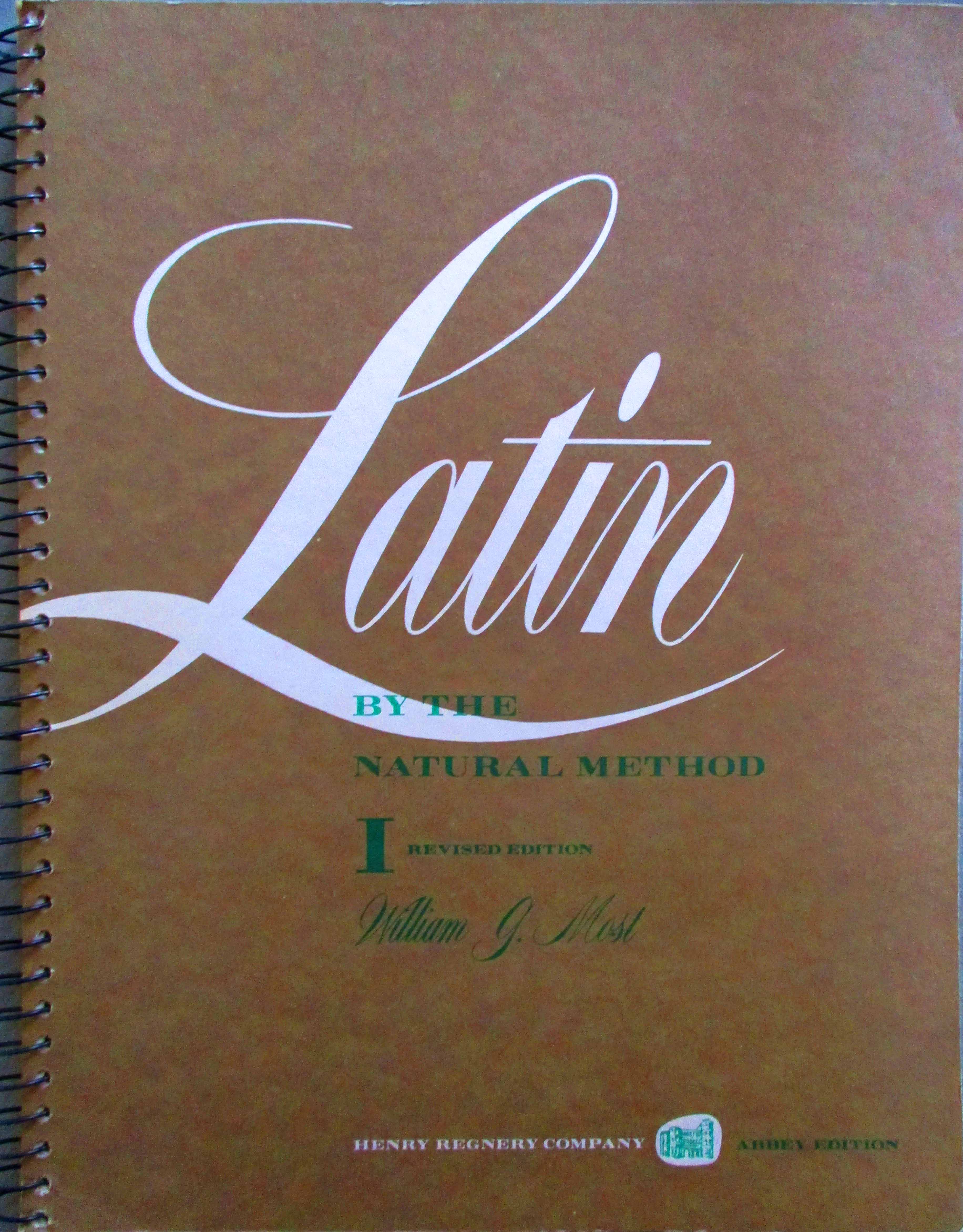
Interesting, yes?
I did the first lesson, which consisted of three short and simple children’s stories.
Not really children’s stories. Baby stories.
It doesn’t matter that they’re historical nonsense.
(Nobody thought the world was flat. Columbus did have money.
I do not admire him and neither should you. Never mind.
These nonsense stories are a good way to adjust your thoughts to a new language.)
The vocabulary was short, 25 words, and the few grammatical rules were explained simply.
Before I even finished reading the first lesson, I was no longer thinking in English. I was not translating.
I was just going with the flow in Latin.
Effortlessly. That had never happened before.
You don’t believe that’s possible, do you? By permission, here it is.
(I added macrons and whatnot. As far as you should be concerned, whenever you see ͂ , treat it like
̄́ , a macron with stress.
My use of the ͂ is highly unorthodox, but not unique. There’s a reason, but never mind for now.)
Try it yourself. Go ahead. Try it.
LÉCTIO PRĨMA De tértia persõna in número singulãri in témpore perfécto De cā́sū nominatĩvo et de cā́sū obiectĩvo in número singulãri |
||
María hábuit párvum ágnum. |
Mary had a . . . (three guesses) |
hábuit — had |
Ágnus fúit álbus. |
párvus — small, little |
|
María vẽnit in schólam. |
ágnus — lamb |
|
Ágnus vẽnit in schólam. |
álbus — white |
|
Ágnus vẽnit cum María. |
fúit — was |
|
Márcus vĩdit ágnum in schóla. |
vẽnit — came |
|
Ágnus dĩxit: baa, baa. |
cum — with |
|
vĩdit — saw |
||
dĩxit — said |
||
WE
ARE
DISCOVERED
Colúmbus fúit náuta. Sed Colúmbus nõn hábuit nãvem.
Colúmbus vẽnit ad Rēgĩnam Isabéllam. Colúmbus dĩxit:
Múndus est rotúndus. Múndus nõn est plãnus. Rēgĩna
dédit pecũniam. Colúmbus nõn invẽnit Índiam. Colúmbus
invẽnit Américam. América nõn fúit párva.
NOW LET’S THINK Here is an English sentence: Marcus saw the lamb
(Márcus vĩdit ágnum). There are three important words in
it: Márcus is the subject; it is in the nominative case.
The verb is saw. The object is lamb; therefore, it is in the
objective case. Notice that the Latin verbs above all end
in -it. Notice that the word lamb in English, comes
after the verb. Lamb is the object. In Latin we do not
depend on the order of words to show the object — we
depend on the ending. Notice that many words above
end in -m. That is the ending for the object. Some have
-am: some have -um: some have -em. Notice the various
endings for the nominative case. We need not be concerned about them today. After words like ad, cum, and
in, we have still other endings. Do not bother about them
today. We can understand the story without knowing
about them. |
Notice also that Márcus is just one person. So we say
the subject is nominative singular. There is also only
one lamb in school. That is singular too. More than one
would be plural. It would be too much. So we could say that
the object in our sentence, ágnum, is objective singular.
And we could say that the subject in our sentence,
Márcus, is nominative singular. There is no Latin word
for the, no word for a or an. Just supply these in English
when you need them.
COLUMBUS AND
LAMB
STEW
Colúmbus nõn fúit puélla. María fúit puélla. Colúmbus
nõn fúit plãnus. Fúit Colúmbus rotúndus? Colúmbus
nõn hábuit pecũniam. Isabélla hábuit pecũniam. Isabélla
nõn hábuit párvum ágnum. Isabélla hábuit pecũniam.
Colúmbus nõn hábuit párvum ágnum. María hábuit
párvum ágnum. María nõn dédit pecũniam. Isabélla
dédit pecũniam. Sed María nõn dédit párvum ágnum.
Isabélla nõn vẽnit in schólam. Colúmbus nõn vẽnit in
schólam. Colúmbus vẽnit in Américam. Colúmbus nõn
vẽnit in Américam cum ágno. Colúmbus nõn vẽnit in
Américam cum Isabélla. Isabélla nõn vẽnit in Américam
cum Colúmbo. Isabélla nõn vẽnit in nãvem. Ágnus
álbus nõn vẽnit in nãvem. María nõn vẽnit in nãvem.
Ágnus álbus nõn fúit in Índia. Colúmbus nõn fúit in
Índia. Índia nõn est ágnus. Índia nõn est nãvis. Colúmbus
fúit álbus. Sed Índia nõn fúit alba. Múndus fúit
rotúndus. Sed Índia nõn fúit rotúnda.
EXERCISE
Find all the English words that are similar to those in the
vocabulary. This should be done with every vocabulary.
|
||||||||||||||||||||||||||||
“This is easy!” I exclaimed to myself.
Note the section entitled “Columbus and Lamb Stew.”
This is a template for the teacher to conduct Latin conversation.
Imagine a teacher interacting, verbally, with each and every student in the class, one by one,
asking questions based on these sentences for a full thirty minutes or more.
After such an exercise, you would never need to be reminded of what you learned in Lesson One.
You’d know it forever. It would never pose any difficulty for you to the end of your days.
I was still apprehensive, though: “The second lesson can’t be as easy, I’m certain.”
So, I did the second lesson, and it was, again, a short vocabulary, another grammatical rule,
and a highly repetitive reading, with the same minimalist story told many times over with different wordings.
No problem. My brain never once switched to English.
“This is too good to be true,” I thought to myself.
So I did the third lesson, and it was every bit as easy.
My heavens! WHY DIDN’T THEY TEACH IT THIS WAY IN SCHOOL????
Yes, the first few lessons are at infant level, but only the first few.
Students need to start at infant level. They really do. Always.
This course grows rapidly but painlessly.
With Lesson Nine we finally put sentences into traditional Latin order: subject, object, verb.
Beginning with Lesson Twenty-Five we start putting sentences into every possible random scrambled order, as fluent Romans did.
By the second volume we’re reading Cæsar.
By the third volume we’re reading Cicero and Seneca.
By this time, I had just finished Lesson 29 of the FSI Modern Greek course.
What a conundrum! Oh, this was agony.
What was I to do?
Finish the FSI course, or put it aside for a while so that I could delve into this beautiful Latin course?
I chose the latter.
Immediately I checked through Books in Print and placed an order at a nearby book shop for the course.
Against all odds, I was thus able to acquire an original of Volume One (3rd rev. ed., 1964)
as well as the accompanying 1960
Tape Script for Pattern Practice for Latin by the Natural Method, First Year:
The Henry Regnery Company of Chicago still had a copy of each in its warehouse after all those decades!
Volume 1 had at last been typeset, I discovered,
unlike the earlier 1960 typed edition at Zimmerman,
and it included nice color maps of ancient Italy, the Roman empire, and the biblical world printed on the inside covers.
How did I manage to pay for these two items?
My father would occasionally give me a few dimes, or, if I was lucky, even a dollar or two to ride buses and whatnot,
but I cheated: I walked many miles each day so that I could hoard everything until I had enough to make a purchase.
I also collected enough nickels to go to Zimmerman and photocopy, page by page, the entire remainder of the course held there,
and I then walked the photocopies across the street to Kinko’s to have them comb bound.
That is how I got my copies of Latin by the Natural Method, Second Year (Revised Edition) of 1960 and
Latin by the Natural Method, Third Year (1st ed., 1961).
Every spare moment (between debilitating bouts of job hunting) I went right back to the course.
Addictive. Indescribably addictive.
If you want to learn Latin, THIS is the course you should use.
(There is another excellent course too, which we shall get to below.)
All the other Latin-instruction manuals that you’ve collected should go into the recycling bin.
There is no other useful purpose they can possibly serve.
I wish all languages were taught the way Father Most taught Latin.
No such luck. It’s a one-off. Fiddlesticks!
Don’t let that stop you from writing one, though.
All you have to do is license the rights, translate Father Most’s Latin text into any other language,
et voilà, you’ll have
Comanche by the Natural Method,
Veps by the Natural Method,
Hungarian by the Natural Method,
Albanian by the Natural Method,
Chuvash by the Natural Method,
Shmuwich by the Natural Method,
Navajo by the Natural Method,
Iñupiat by the Natural Method,
Latvian by the Natural Method,
Choctaw by the Natural Method,
and so on. Any language you choose.
Of course, you’d have to make some adjustments for each language’s distinctive peculiarities,
but Father Most’s course is so slow, so leisurely, so long,
so insistent on never moving to the next step until you’re incapable of making a mistake,
that I’m certain it could be adapted to any other language.
Why hasn’t anyone done this? I don’t understand.
The only thing that comes even vaguely close is Pimsleur, but Father Most was light years ahead of Pimsleur.
I know little about Father Most except for this course.
As I drift about in the waves of Googles, I discover a little — very little.
There was a short essay about him in Chapter 6 of John M. Janaro’s book,
Fishers of Men: Apostles in the Modern Age
(Manassas, Virginia: Trinity Communications, 1986).
Oh, and here’s his obit:
The Arlington Catholic Herald,
19 September 1996.
(The original page was taken down, and so I archived it.)
It figures. I would have given almost my last cent to have met him, but I had no idea how to find him until long after he was no longer with us.
So, I didn’t even pursue the quest. My loss.
Though I know little about him, what I do know from his course, though, is that he was brilliant, more brilliant than probably anyone I’ve ever met.
(It’s neither here nor there that my religious inclinations are nonexistent. I can generally get along with religious folks, no prob.)
He published his course in 1957, and there were a few reprints, which I suppose went to a handful of churches.
A fellow in Québec by the name of Victor Coulombe issued an edition in 1963 for his French-speaking students who wished to learn Latin:
Le latin vivant par la méthode naturelle —
click here for libraries that own copies.
Better yet, click here to take the course!
Only the first two volumes have been posted so far. The third is soon forthcoming, I’m certain. Keep checking back at that link.
That, though, was about the entire extent of the recognition of Father Most’s magisterial work.
Perhaps a problem was that Father Most wrote specifically for Catholic students,
with the result that some of the lessons are from the bible and one even preaches against communism!
Perhaps that’s why educators ignored the course.
If that was the reason, that was a grave error.
If a handful of the readings were inappropriate for secular schools, it would have been so simple to request rewrites.
By 1964 it was all over.
Only a scant few copies of the course survive.
There was never a Teacher’s Manual for Volume Three. I doubt one would have been needed.
There were reel-to-reel language-laboratory tapes to accompany the first two volumes, but despite my searches, I have never found them.
The tape script for the second volume was never published.
How do we find these items?
I do not know who acquired Father Most’s effects, but as we learn from his obituary,
he “taught for more than 40 [years] at Loras College” (1450 Alta Vista St, Dubuque IA 52001, 563-588-7100).
Further, “he taught at the Notre Dame Graduate School of
Christendom College” (4407 Sano St, Alexandria VA 22312, 703-658-4304)
and “also was active at St. Lawrence Parish” (6222 Franconia Rd, Alexandria VA 22310, 703-971-4378).
So, we have three leads of institutions that likely maintained some of his works.
I suppose that Victor Coulombe also had copies of the tapes. What ever happened to him???
If you can locate any of the tapes or the second volume of the Teacher’s Manual, please write to me!
 .
.“Textbooks in Greek and Latin, 1966 List,” The Classical World, March 1966
https://files.eric.ed.gov/fulltext/ED012548.pdf.
I have never found a copy of Fifty Units of Basic Latin Grammar.
Before we proceed, it is now time to watch a movie.
Another quick interlude.
On 22 July 2019, I heard from a reader of this page about another course that presented Latin as a spoken language:
Arcadis Avellanus (pseudonym of Arkád Mogyoróssy),
Palaestra; Being the Primer of the Tusculan System of Learning, and of Teaching Latin to Speak; for Class Use and for Self-Instruction
(Brooklyn, NY: privately printed, 1911).
Looks fascinating, and the author’s life story is beyond fiction.
Avellanus’s work influenced W.H.D. Rouse, who now enters the story.
As I was working (“working”? — no, playing) through Father Most’s first volume,
I began to wonder if there was, perchance, a comparable course for Classical Greek.
(I only recently learned that there was, but we’ll get to that below. Keep reading.)
In my search I discovered that there had once been another William, an English public-school teacher by the name of W.H.D. Rouse.
Ahhhhhhhhh!
I ordered every available language-instruction book of his through Interlibrary Loan, and as the books arrived one by one my heart sank.
His First Greek Course was only marginally superior to the regular charts-and-rules books,
and I understood immediately that he used his books only as memory jogs or quick notes to help him guide his instruction,
since his classes were primarily spoken.
(Click here for a detailed description of his teaching method and its results.)
His books were certainly never meant for self-study and cannot be used for such.
Nonetheless, I photocopied them all, though I never managed to scrape up the money to bind them.
It tormented me (and torments me still) that he never wrote down his spoken course.
All we have left are his small, slender textbooks.
I learned also that he had recorded himself speaking Classical Greek with what he wrongly claimed was the Classical pronunciation.
I found a library in Britain that agreed to make a cassette recording of the two 78rpm shellacs
along with a photocopy of the accompanying brochure.
The library staffers didn’t do a professional job.
They just pulled out a wind-up gramophone with a steel needle and plopped a cassette recorder in front of the horn.
The package arrived and I listened to it and read along and I was in heaven.
By that time, I was half-way through Volume One of Father Most’s course,
and that’s when the unthinkable happened:
I got a job.
No. Not a job.
No. “Job” is too generous a term.
A lousy, stinking, demoralizing, less-than-minimum-wage, back-breaking, day-and-night-and-weekend job that sapped all my energy.
The Bank Vault Restaurant and Sugar Daddy’s Saloon (formerly the Montana Mining Company), if you must know.
I assure you: When you work fulltime or overtime under tremendous stress —
especially stress derived from a hostile forever-nagging unshutupable supervisor —
and have to carry a single can filled with hundreds of pounds of garbage up a flight of stairs
and lift it above your head to toss it into the dumpster,
every day, often several times a day, you don’t do something fun when you crawl home.
You just collapse.
You don’t wake up until it’s time to go back to work, and waking up while still exhausted is not an easy task.
Your personal life is over.
That was the definitive end of my short and happy life as an autodidact.
The Bank Vault soon went bankrupt, and so I ended up working briefly at three restaurants that were even worse
(the last one, Kashmir Palace, was downright terrifying —
the owner was a screaming lunatic who should have been committed; I hope he never killed anybody, and I certainly feared for his girlfriend).
With only a few brief breaks that did not allow me to recover from emotional fatigue,
I was day-and-night 24/7 busy almost every day from early 1983 through 1994, with a semi-break in 1991 when things calmed down a bit.
There’s a lesson here too, and please take it to heart.
When you get a series of lousy jobs that suck up literally every minute of your spare time,
and when you discover that you’re working for a series of vampire bosses who make themselves feel good by cutting you down,
and when your fellow employees are nasty gossips who make up vicious rumors about you out of whole cloth,
you will get depressed.
You will. No two ways about it.
I didn’t realize that my inability to go back to Father Most’s course or the FSI course,
even on those rare months when I did have time,
was not the result of a mysterious onset of inexplicable laziness or of a newly acquired character flaw.
You see, the restaurants were followed by the United States Postal Service,
at which depression was not merely rampant among the staff; it was universal.
The Post Office specialized in a contagion of depression.
Everyone was affected. No one was immune.
The USPS was the most abusive employer I have ever had.
No other employer even came close.
Working at the Post Office was rather like working in a prison factory under screaming guards who never ceased making threats.
It did not surprise me in the least that so many employees committed suicide or burst into work one day with machine guns to mow their supervisors down.
So, I was depressed, but I had no idea that I was suffering from depression. I really didn’t.
I tried to make friends at work, but what was the point?
It was impossible, as Stockholm had infected the entire staff with its loathsome Syndrome.
Every day before work and after work I’d see the Most course and the FSI course sitting on my shelf waiting for me,
and I could never work up the energy even to open the covers.
I didn’t know why.
All I knew was that I couldn’t.
I physically couldn’t.
I’m not exaggerating.
I physically couldn’t.
I often thought about opening the covers and glancing at the texts again, but it was impossible.
Adding to my misery, there was also a moonlighting job at the Sunset Drive-In .
Awful, awful, awful, unspeakably awful. Abusive. Crooked. Evil.
During my rare spare time, again,
I just stared at the tube and nearly went broke paying outrageous cable bills and purchasing countless blank VHS tapes to record everything possible.
Again, I had no concept of why I was doing this. I just was. Obsessively.
Looking back on it now, I can understand.
It is only now that I finally understand that compulsive television watching is no different from alcoholism or drug addiction,
that I at long last read Jerry Mander’s supremely brilliant Four Arguments for the Elimination of Television,
a book I cannot recommend highly enough.
(It has some errors and poor observations and poor arguments, but never mind! Overall, it’s great!)
I first encountered it not long after escaping the Post Office to take a rotten job in Buffalo.
The book was on a shelf at Talking Leaves on Main Street back in 1987, but back then I was not ready for it.
I looked at the back cover and put it back onto the shelf.
The Buffalo outfit for which I was working was forever begging, with quite a lot of success,
to get onto network-TV talk shows, TV news shows, and TV documentaries.
The firm viciously mocked all primitive cultures.
The former behavior I understood and lauded.
The latter I found deeply offensive, as I was (and still am) quite fond of the American Indians
and found (and still find) primitive cultures endlessly fascinating, and, in many ways, superior to our own.
Nonetheless, at my new job I was being indoctrinated with something wrongly called “science” and “reason”
(those idiots wouldn’t have recognized science and reason if it bit them), and the indoctrination was having a powerful effect.
Mander would have none of this, advocated against television, and encouraged us to learn all we can from primitive cultures.
Now, thirty years later, I’m more than ready for Mander’s book, which, among other things,
coincidentally makes sense of my previous aberrant behavior.
The exhaustion and defeat and the lousy life I was living with lousy employers and lousy coworkers and lousy neighbors
and lousy pay was a trap from which I did not know how to escape.
There was no energy to spare on fun stuff, and, in any case, I no longer regarded it as fun.
I convinced myself that such interests were childish things best left behind.
’Twas better to concentrate on a pressing issue of much greater urgency: finding a way out of my trap.
I had originally thought that the Buffalo job was my salvation, but it was only a worse trap,
and my moonlighting job was even worse (a firm not far from Buffalo that shall also remain nameless),
and when I quit that, I got an offer for moonlighting from yet another offer from out of the blue (another firm not far from Buffalo that shall remain nameless).
So, I was depressed and dragging.
At work (which was nearly every waking moment), I tried to be upbeat, for the sake of appearances,
but down inside I was ready to die, though I really did not realize it.
Well, duh. What else could I have expected?
So, don’t let depression win.
I let it win, which is why now, all these decades later, I’m still a dunce.
Had I just put in a few months’ worth of effort back in the 1980’s, I would by now have been able to write my own ticket anywhere.
Instead, I didn’t, and so I’m still a dunce.
When I moved to Buffalo, I discovered that a full-time salary was insufficient for the combination of rent, utilities, groceries, and car maintenance.
I was delighted to be ordered to work extra hours.
I was not delighted to discover that overtime was not paid without prior written authorization, which was never forthcoming.
Much of the time I was working not merely unpaid overtime, not merely a second job, not merely a third job, but even a fourth,
and, even then, I was surviving only by means of borrowing on credit cards.
The prob with credit cards, I soon learned, is that even the smallest debt is impossible to repay, because it grows exponentially,
and also because no matter how early you pay the monthly instalment, it is misrecorded as arriving late,
which exacts a penalty and increases the compounded interest by many multiples.
The more I earned, the less it mattered, because the more I owed.
Then my main employer “urged” us (euphemism for commanded us) to transfer our bank accounts to Fleet, and that’s when I learned why:
No deposit is recorded until after you’ve made payments against it,
resulting in penalties for insufficient funds, and closing the account incurred a further $90 penalty,
which, in my case, proved to be $90 less than less than nothing.
(I have since learned that other banks perform precisely these same hijinks with their poorer clients.
It is a de rigueur game. I hate banks. All banks.)
When we went broke, our boss offered us company credit. Yummy.
Sleep was far too often relegated to the hours between 5am and 7am.
My main boss wondered why I was dragging, and voiced his suspicion that I was taking drugs.
I wanted to kill him.
(If you haven’t read it already, read it right now: Barbara Ehrenreich’s
Nickel and Dimed.
She tells the truth.
My conclusion, and not only mine:
The northern states fought the Civil War not to free the black slaves, but to replace chattel slavery with wage slavery and to make nearly all of us slaves.
Arbeit macht frei? Try to explain that to the countless full-time employees who live in cardboard boxes under bridges.
Higher education can make us into well-paid professionals, you say?
Try to explain that to the Ph.D.’s and commercial airline pilots and college instructors who need food stamps and Section 8 housing to survive.)
Unexpectedly, there were a few nice stretches, lasting a few weeks or months each, when I would have a few hours to myself each week.
Then, after more than a decade of these punishments, I experienced a miracle that lasted from summer 1994 through autumn 2000:
only one job, and with mere eight-hour shifts!
This was a brand-new experience for me.
I got occasional moonlighting gigs during that time, but they were not oppressive, and I could dash each those assignments off in a week or so.
Had I not been drowning in debt, the salary would have been livable.
I spent my spare time researching and writing a book dealing with local history, but then the police chased me out of town.
Something about keeping the neighborhood safe, they said.
I was never able to finish that book, and now I never want to.
Volume One is a gem and I’ll publish it some year, but I never wrote a word of Volume Two and I never shall.
Beginning in mid-2004, my newly found busy-ness has all been self-imposed, and you know what that is:
200 Degrees of Failure: Caligula —
and now, of course, even that has been set aside now that I’ve found a mountain of important information
which forced me to realize that the 1,600+ pages have been rendered somewhat obsolete. Always sumpn.
Then I got into a terminal disagreement with my coauthor and then I got booted out of the new archive and then my cat got a lethal heart tumor
and that’s when it struck me that I have wasted every minute of my life.
I also realized that, except for fourteen chapters, the book is wrongly thought out, or not at all thought out, really.
Do I have the gumption to rethink it and rewrite it?
Do I feel like axing my right arm off?
Narcissists, violent maniacs, bullies, psychopaths.
They were my elders growing up, in the family and in the church(es).
They were my employers (Post Office, theatres, cinemas, restaurants, publishers, charities).
They were the local law enforcement.
I never dared say “No.”
I never dared disagree.
To have done so could well have been my death sentence.
I couldn’t leave.
It was a trap.
By the time I was nearly 43 years of age, I worked out a partial strategy:
Never look directly at anybody’s face;
never talk to a stranger;
never disagree;
never answer the phone;
run away from the job;
run away from the family;
move out of town to get away from the cops.
Fortunately, by some miracle, in my current job, my direct supervisors are okay folks.
Amazing.
When, nowadays, I chance upon more narcissists and other maniacs,
it is simple to take Dr. Les Carter’s advice.
It was not simple when I was growing up.
It was not simple when they were my bosses, while no other jobs were on the horizon.
It does a prisoner no good to tell a murderous prison guard, “I don’t look to you to define who I am.”
Upon hearing that, the murderous prison guard would define the prisoner as a mutilated corpse.
Dr. Carter’s advice would have been useless in my younger years;
nonetheless, I wish I had had it, simply to provide a perspective.
He has a great accent, too, doesn’t he?
I mention all this why?
Because Father Most’s incredibly rare, almost-impossible-to-find course is back in print!
At a pretty darned good price, too!
Mediatrix Press,
a Catholic publishing house, just typeset it anew and is running it off.
Yay!
One word of caution:
If you decide to study this course, please look up each word in a dictionary so that you’ll know which vowels are long and which are short.
Church Latin doesn’t make the distinction.
Classical Latin most definitely did.
So, if you learn only the ecclesiastical pronunciation,
then you’ll have the horrendous onus of learning every last word all over again to read the Classics. Ugh.
If you learn Classical first, then learning ecclesiastical is easy:
Just pronounce every vowel as short. There are a few other changes too,
which you can read about here, but they’re no big deal to learn.
After you learn Classical Latin, you can master the ecclesiastical pronunciation in five minutes.
If you learn the ecclesiastical pronunciation first,
no, you can’t go the other way without doing double work.
Mediatrix is currently typesetting Volume Three.
If you really can’t wait, you can read it here.
Since nobody could find the tapes, the staff recorded them anew, but only for the first year, because the second year’s tape script had never been published.
Funny thing, you know: I was planning — really, no kidding, I really was —
to inquire about licensing the rights to Father Most’s course
so that I could post it online on this Caligula site for free.
I would have added macrons over the long vowels, too, along with other diacritics to help with pronunciation.
Well, the church beat me to it. Well, uh, like, you know, hey.
I’m just so glad I never had kids, because I wouldn’t wish school on anybody, unless, of course, class were taught by a
Bill Most or by a
Bill Rouse — but will their likes ever be seen again?
As for me, school, from the first day of kindergarten to the last day of university, was mental/emotional torture. It was not education.
I aced some classes, true, and there were a few teachers I really liked and learned a great deal from
(here’s lookin’ at you, Blanche Griscom),
but for the most part my grades were about the lowest, though few of my classmates realized that or would have believed it.
When we were given those federally mandated annual standardized tests,
if my memory is not failing me, I usually came out right at the top, close to genius level,
though once every few years I was ranked right at the bottom, at retard level.
Go figure. It’s all so useless.
The questions on those standardized tests measure only what you’ve recently been practicing.
If you’ve recently been practicing mathematical word problems and geometric puzzle drawings, you’ll pass with flying colors.
If you’re a bit rusty with mathematical word problems and with geometric puzzle drawings, you’ll flunk.
(The same holds true for IQ tests: The more you practice, the higher your scores will be, and if you practice enough,
you will rank as high as Wile E. Coyote, Super Genius,
but the score really doesn’t mean much.)
That’s all. Totally stupid.
The tests don’t measure intelligence or education.
If you want to learn, nobody’s stopping you.
If you want to be an illiterate moron, nobody’s stopping you.
School makes no difference in that equation.
If you want a good job, be born into a prominent family.
If you want to struggle to get by and never get ahead, be born into any other family.
School makes no difference in that equation, either.
On the other hand, if you want to be in the school-to-prison pipeline, then yes, absolutely, you should go to school,
and make sure to taunt Officer Slam.
If you were ever a child, you might remember long ago when your parents and grandparents and their buddies
all complained about “kids nowadays.”
Not only were “kids nowadays” disrespectful,
they were also stupid, misbehaved, and uneducated, unlike the parents’ and grandparents’ generations.
They all griped about how lousy schools were nowadays, unlike the schools that they attended in their own day.
Yeah.
It’s an age-old complaint, and it nearly wanted to make me scream,
for the complainers were generally spoiled brats and brainless dunderheads whose education was nonexistent beyond third-grade
spelling and addition, and even in those areas they were weak, at best;
and it was they themselves who exhibited no respect for anyone other than their paymasters.
I dreaded the times when my father insisted on “helping” me with my homework,
which invariably meant a grade of 0% the next day, along with a tongue-lashing from my teachers,
one of whom, in fourth grade, wanted to send me back to do third grade all over again.
Here is a useless anecdote.
It was, I think, in 1977 that the 1973 movie The Sting was reissued.
I was at a party hosted by some friends, and one of the couples brought along their ten-year-old son,
who had just seen the movie and couldn’t stop talking about Scott Joplin,
whose music permeated the story.
Good for him, I thought, since Scott Joplin is one of my favorite composers and easily one of the greatest ever.
After several hours, as the party ended and as we were all getting ready to leave,
the kid’s mom could take no more and gently chided her son, explaining that he only likes Joplin because he is modern;
that if he were to listen to the old-timers such as Sinatra he might form a more mature opinion.
Whatever.
So much for parents’ and grandparents’ endless complaints about “kids nowadays.”
Surprisingly, there is “nowadays” some truth to this farcical complaint.
Please take a look at the ungrammatical
“Crisis Point: The State of Literacy in America,” in
Room 241: A Blog by Concordia University – Portland, 5 March 2018.
The anonymous author correctly states that literacy was used as a weapon of oppression:
“Education was provided to only a select few,
and this preserved a class system that kept the poor powerless and the rich powerful —
a practice, we’ll see later in this piece, that continues today.”
Correct.
Absolutely correct.
Schools, textbooks, and teachers go through the motions to make it appear as though they are educating the youth,
when, in fact, they are just frittering the time away.
The abysmally designed tests prove only that cramming has a temporary effect,
the term papers get passed no matter how dreadful they are,
and the kids are moved up and out of the system with no effective skills at all.
Am I saying that I was a better student than my classmates?
Hardly! If anything, I was worse.
From kindergarten through the end of college, I kept all my school papers in binders.
I went back to storage to look at them recently, to discover, to my horror, that my father had discarded everything,
save a few sheets that he somehow missed.
Those few sheets reveal to me a school child of embarrassing idiocy,
utter illiteracy, total thoughtlessness, overbearing ineptitude, and shameful incoherence.
They show me something else, though, something that makes me feel a little less horrible about myself.
Papers and tests were demanded absent any significant training.
How was I to write an essay about, say, ancient Egypt, when my entire education consisted of a few pages in a dull textbook
and fifteen minutes of a teacher droning on about it?
My essays were illiterate padding, nothing more.
What else could they have been?
School was seventeen dispiriting years of which I still suffer nightmares.
Helpful hint: If you have no choice but to go to school, first grade or university or anything in between,
do your research to find the best self-study books, master the topics during summer vacation before class starts, and just whiz through.
There are some really good self-study books now that didn’t exist even a few years ago.
(There have been self-study books for centuries, but few were any good. The world is a different place now!)
A friend who’s getting ready to retire is back in school attempting to learn algebra, a topic she had never studied before.
She couldn’t understand the teacher or the textbook. Could I help? Yes. I got her Lynette Long’s
Painless Algebra. I hope it helps. She and her husband say it does.
Hope they’re telling the truth and not just trying to be nice.
Algebra had been difficult for me. I was the slowest learner in class.
I was the best learner, but the slowest.
The teacher and textbook would tell us which formula to use when confronted by which pattern.
The other kids latched on right away.
They had no problem at all memorizing a formula and memorizing which pattern it goes with.
I can’t even imagine how they could do that, but they all did it — all of them.
Their ability is not something I share.
I can’t memorize formulæ. I really can’t. I need to understand the logic behind each formula.
Once I can understand the reasoning, I don’t memorize the formula; I just reinvent it whenever the need arises.
Nothing clicked until seven or ten days after the weekly Friday test,
when it would finally dawn on me what was being called for and why, and how the formula satisfied that requirement.
Once I understood, I had no further problem.
Of course, the test had already been graded a week before and I had failed it.
Once the understanding set in, though, it could never be dislodged.
Not one of the other students needed to understand.
The other students just memorized the formulæ and so the class was a cinch for them.
I looked through Lynette Long’s book before I handed it to my friend,
and I must say that we never had explanations this plain and simple and easy to understand when we were growing up.
Long explains the why’s and the how’s in the simplest terms possible.
This is something new, and this is what I had really needed back in ninth grade.
I wouldn’t have been a low-C student; I would have been a high-A student. Oh well....
Actually, I would have been an F student had it not been for the mid-term and final exams, which came late enough that I could do rather well on them.
I’m willing to bet that any average 12-year-old would be able to get through Long’s book in a month or less during summer vacation
and understand algebra better than an A student who just finished taking it in ninth grade.
With a good self-study book, in a few weeks you can master a topic that will drag on for two whole semesters in school.
While your classmates are all in agony, beating themselves up all night to get their homework done,
you’ll breeze through it all without effort.
Yes, it will eat up part of your goof-off summer,
but it’s far better to eat up some of your goof-off summer
than it is to suffer through every minute of your oppressive autumn, winter, and spring.
Do not trust any teacher to help.
Your teacher’s job is to make you feel like a moron by presenting everything in the most obtuse fashion imaginable.
Intimidation is the name of the game.
Teachers love to intimidate their students.
I guess that’s how they make themselves feel superior.
By no means assume that your assigned texts will make even the tiniest bit of sense.
More often than not they are horribly written and utterly incoherent.
Remember, it is professors who write this trash — or at least it is professors who take credit for it.
I suspect they hire students and temps to do the work for them for minimum wage or less, or maybe just for an inflated grade.
I am pretty much convinced that the authors, whoever they really are, were stone-drunk while writing.
You won’t believe this until you witness it, but many teachers never bother to read the textbooks they assign.
So, when you take a test and you answer what the textbook says, the teacher will mark your answer as incorrect,
and even make fun of you in front of the whole class for providing such a ridiculous response.
You don’t believe me; I know you don’t — but you will when it happens to you.
Books in high schools are seldom replaced and are loaned out to students for free.
In the late seventies we were using books printed in the early sixties.
Books in universities come with prohibitive price tags that put us into debt for life.
To prevent university students from purchasing used copies of the brutally overpriced texts,
new editions are offered every semester, and old editions do not qualify for class work.
The only difference between the new edition and the old edition is the cover illustration and the edition number.
Racket? Racket? Why would anyone think this is a racket?
Some textbooks — for instance, calculus — are deliberately written in such a way as to defy comprehension.
They are intentionally written to flunk low-class kids out. Really. They are — and the professors are no better.
They enjoy flunking students out. They excel at that task.
Calculus 101 is a hugely popular class. So many kids eagerly enroll.
A few weeks later the classroom is a ghost town. Almost everybody dropped out in discouragement and defeat.
The professors are miserable little grouches who resent having to deal with all those teeming masses of louse-infested commoners
and are just hoping to be promoted to teaching graduate courses.
Besides, teaching 100 students per class means more grading to do.
So, they do all in their power to make the subject unfathomable.
That’s how they get rid of all those irritating students.
That makes the professors’ workload much lighter.
You flunked calculus just like all the other poor kids in class? Read
Eli S. Pine’s little book, enroll in the class again, and easily get better grades than your rich classmates will ever be able to get.
That’s a self-study book that was available but that I didn’t know about until shortly after graduation. Drat!
I bumped into it on the new-arrivals case in Jerry Lane’s Book Stop at the Nob Hill Shopping Center in Albuquerque,
read the first nine pages, and nearly fell over.
“That was it? That’s all there is to it? That’s it?????? That’s EASY!!!!!!
Why didn’t they tell us this in school? Why were the explanations entirely left out of all class lectures and textbooks?”
’Twas too late. I had flunked calculus three years earlier.
Upon flunking, I enrolled again, this time with a different professor who used a different textbook, and failed again.
Without passing marks in calculus, I was not permitted to take electronics or engineering.
My whole life would have been different (and much better!) had I known about Pine’s little booklet.
Instead, I just thought I was stupid.
The day I concluded that I was too stupid to understand calculus was one of the most devastating, demoralizing, and humiliating days of my life.
Little did I realize that I was not stupid.
I was simply the victim of yet another scholastic confidence game.
I’m thinking about something else now: The calculus textbooks were enormous! They were as big as the bible.
The sheer size of those books, which was utterly needless, was another factor in the deliberate intimidation.
Remember, the “smart kids” are not smart.
All your life you thought they were smart.
All my life I thought they were smart.
They are not smart.
Read aloud fifty times until it begins to sink in:
The “smart kids” are not smart.
The “smart kids” are not smart.
The “smart kids” are not smart.
The “smart kids” are not smart.
The “smart kids” are not smart.
They just found a helpful crutch, or, far more likely, they were given one.
I remember Jonathan from eleventh-grade Algebra II/Geometry/Trig class and twelfth-grade Math Analysis class.
He was a nice guy. A really nice guy. Zero ego.
He never needed the teacher to explain anything, he never had any trouble at all, he never worried about a thing, and he never got an answer wrong.
I thought he was exceptionally bright.
I expressed my admiration of his superior abilities, but a classmate put me right:
“No. He’s not smart. He’s just average. His parents just push him and he gets tutoring at home.”
That had never occurred to me before, but once my classmate said that, it was completely obvious.
Unfortunately, right after he said that I forgot all about it.
I went to the university mystified as to why I couldn’t understand the first thing about calculus and never got a single answer right,
even though all my life math had been my best subject.
As much as I loved history, I was miserable in my university history classes, which were torment.
Though I had never mastered Modern Greek, Sofroniou and Cortina demonstrated that it was easy to learn, and yet Latin was proving impossible.
As I was suffering, many of my classmates were breezing along without a care in the world, effortlessly making top marks.
Okay, they were smarter than I was, no question about that, but they weren’t that much smarter than I was.
While the university demonstrated that they were brilliant,
the university was demonstrating that I was a hopeless moron.
There was something wrong with this picture, and I couldn’t put my finger on it.
Soon I concluded that the fault must be of my own making, and I became dejected —
and arrogant, and insulting, and disparaging, and nasty, and mean.
It wasn’t until just a few weeks before I began to write this tirade
that I remembered what my classmate had mentioned about Jonathan’s tutors.
A ha!!!
That was the difference.
The other students all had a head start, and the classes were tailored for them.
I was dropped into a narrative already in progress and was unable to pick up the thread. (Read
this.)
As for how smart the “smart kids” were, yes, we all have slightly different intellectual capabilities, I admit.
Some of us are gifted in certain areas — not all areas, never all areas.
Some of us are born with brain deformities.
I would never deny that.
On the other hand, even a gifted child who is raised in unfortunate circumstances will perform poorly and have difficulty learning,
and even a below-average child will perform remarkably well and learn with relative ease when guided by a gifted teacher.
Further, I am convinced that people who say that they are good at the humanities but incapable of understanding math and science,
and those who say they are good at math and science but incapable of understanding the humanities, were simply poorly taught.
(Speaking for myself, I have trouble recognizing any difference between the sciences and the humanities.
In my mind the dividing line is arbitrary and false and irritating.
All topics overlap at every level.
One of the many things I hated about school was dividing knowledge into different class periods,
different teachers, different textbooks. Why aren’t they all lumped together?
Why are they even considered different topics with different names? Separation is artificial.
For example, the ancient Mesopotamians, Egyptians, and Greeks made splendid advances in mathematics and engineering.
This was all deleted from history class because it was math and science stuff,
and it was deleted from math and science classes because it was history stuff.
How can anyone break them apart? I really don’t understand.
It’s dishonest to break them apart.
All these little discoveries and advances are part of the human story; they’re all part of the world we live in.
I just enjoy learning things — except for sports, pop culture, and rock music.
That’s where I draw the line.)
Given the reality that different people have slightly different intellectual capacities,
we can look beneath the surface, for, as my classmate observed,
rich kids all have tutors who give them head starts.
Poor kids don’t have tutors and are confronted by hostile teachers and incomprehensible textbooks.
Rich kids sail through.
Poor kids flunk.
(I never bothered to read Vince Sarich’s books and I never want to.
Apparently, he used this data to draw the conclusion that intelligence is genetically inherited, not cultivated, and that poor kids —
read: black kids — are simply born less gifted.
He used DNA studies and physical anthropology to support his thesis.
As Monty Python might say, that’s what we can call “The Waste-of-Time Theory.”)
Now that we have the Internet, we can change all that, because we can discover which are the best, easiest-to-understand self-study books.
Find the self-study books at the library.
If the library doesn’t have them, get them on Interlibrary Loan and scan them.
If a self-study book is a piece of incompetent junk, look at the next and the next and the next until you find one that’s decent.
They’re out there, for almost all subjects. This is something new. We never had this advantage before.
I certainly didn’t have it in the 1970’s.
There are also splendid learning sources online. Download them before they get pulled offline.
The same goes for almost any other course, but please avoid history courses, because they’re all packs of lies.
You think that only a conspiracy theorist would say such a thing?
Okay: How many native American Indians did the Spanish, British, and US military forces murder in what is now the continental USA?
Best estimate: 19,000,000.
What US schoolbooks even mention this?
Answer: None.
If a US schoolbook even mentions the American Indians (highly unlikely),
it severely rounds down the total original population to maybe 1,000,000 or less
and attributes the mass deaths to European diseases to which the natives had no immunities.
Yeah right.
The phony excuses they make in order further to demonstrate
“American exceptionalism” and its “anti-imperialism”....
That’s only the tip of the iceberg.
Did the First Amendment to the US Constitution apply to American Indians prior to 1978? Answer: No.
Actually, it still doesn’t apply to those who choose to maintain tradition.
What US schoolbooks even mention this?
Answer: None.
US schoolbooks call Medieval Europe “The Dark Ages.”
That’s a cleverly condescending (and unjustified!) term that makes us feel superior,
even though our modern society is hardly any better, and in some ways it is even worse.
They nowhere mention that the American Indians call these past 500 years “The Time of Darkness.”
Real history is written, and written beautifully, sometimes even by professors
(Pekka Hämäläinen, Anthony F.C. Wallace, the list goes on),
but real history never seeps into board-approved texts.
On my university registration I selected history as my major, though I had no intention of following through.
I planned to pass calculus and then switch majors.
I failed calculus after a string of 0% grades and so I reluctantly pressed on through history.
After graduating I continued to read history, for fun, and the more I learn, the more resentful I become of the lessons we learned in class.
Medieval studies, US diplomacy, American Indian studies, the whole lot, was just half-truth followed by fractional truth
followed by misinformation followed by disinformation....
There was no room for a Noam Chomsky, for instance. He wasn’t even mentioned, nor was Gore Vidal.
No “controversial” viewpoints were mentioned, unless they were being mocked.
We concentrated instead on “real” history written by “real” historians who had “real” Ph.D.’s from “real” institutions,
and not the laughably untrained amateurs.
Oh, the games they would play: “Okay, you’ve just heard my 45-minute lecture on the diplomatic relations between the US and the Philippines.
Your homework tonight is to read this five-page essay by a different professor who has a different point of view.
Read this essay, synthesize it with my lecture, and come up with your own interpretation.”
Huh??? What interpretation can a student possibly provide when confronted by what are essentially two newspaper editorials?
It would take me years with primary sources, interviews, travel, language learning, learning the cultures,
learning the multitudinous backgrounds,
before I could even begin sufficiently to unravel what really happened to develop my own interpretation.
So, okay, I’d do what I was told.
I would just make it all up.
For no reason at all, I would say that I agreed with points 1, 7, and 9 that my professor made
and points 2, 4, and 10 that the author of the paper had made,
give spurious reasons, and submit my paper, flinching at the prospect of a tongue-lashing.
Yet, no, I got passing marks! Why?????
This isn’t history. This is game-play. Really dumb game-play.
Students get good marks and good GPA’s and graduate because they do well in this really dumb game-play.
Because they graduate with high marks and get BA’s in history, they probably think they know history. What can I say?
If they go on to get MA’s they can help such professors as
Charles Hapgood do preposterous “research.” What can I say?
Classes, of course, invariably made the US the hero in any confrontation.
The brilliant students do not dispute this official conclusion.
As for what passes for brilliance at school, well, as you all know, liberal left-wing
torture advocate Alan Dershowitz now proclaims that as a law student
Ted Cruz was
“off-the-charts brilliant”
(apparently because
he recalled page numbers of legal briefs).
My cat is smarter than Ted Cruz.
What can I say?
Oh, really big warning, and this applies especially to university students:
If your professor insists on written answers to oral questions, get a pocket-sized audio recorder and record all those tests.
If you don’t, your professor will lie about what he asked,
and that’s such an easy way to flunk dark-complected students while giving the highest marks to light-complected students.
No, I’m not making this up. It was professors such as these who surely did
Justice Scalia and Vince Sarich proud.
(Of course, Sarich insisted that he preached against racism, because, after all, though whites, Chinese, and Southeast Asians are smarter,
on average blacks are better at basketball, so he said. And he was a professor. What can I say?)
Without that audio recording, you’ll have no defense.
How I wish I had had a good pocket-sized recorder thirty-seven years ago!
Oh, how that would have changed things!!!
A lot of professors regard some students (read: lower-class students) as adversaries
and will cheat in every way possible to flunk them out.
Do your research and avoid those professors!
If a professor uses graduate students to grade papers and tests, switch to a different class immediately.
There is no way to win when grad students grade your papers and tests.
I never set foot in a dorm and I strongly suggest that you never set foot in a dorm either.
Never be without witnesses, not even for a nanosecond.
While all the rich kids are getting falling-down drunk at the local pub
and are ingesting-injecting-inhaling-snorting-sniffing all manner of controlled substances,
partying, gang-raping, smashing car windows, and looting,
knowing full well that they’ll get high marks no matter what,
your goal is to outshine them so brightly that you’ll humiliate them.
It will make you feel good. It will make me feel good.
Word of warning, and this is something I did not experience,
because, despite what the police claim, I do not drink alcohol or take any drugs:
If somebody offers you a drink, go away. The drink is spiked.
If you accept the drink, your naked picture will be all over the Internet if you’re lucky.
If you’re not lucky your corpse will be tossed into a ditch.
Another thing, and this I did learn from experience:
Even though you made straight A’s on all your papers and exams,
you can still get an F on your report card.
Your professor is just trusting that you’re too defeated to put up a fight.
Put up a fight.
Most stuff at the university you cannot fight, but when this happens, you can fight it.
It might take a few weeks, but it’s a fight you’ll win.
So, don’t just chalk it up to experience.
Show your papers and tests to the dean, and you’ll get a revised report card, automatically.
No confrontation. No conflict. Your professor will keep miles away from you forever.
One final word: Nearly every philosophy professor I have ever met — and that’s been lots! —
has been a scum-of-the-earth con artist and back-stabber and congenital liar, a holier-than-thou élitist;
whereas nearly every physics professor I have ever met has been a perfect delight, compassionate, and unconditionally honest.
That’s it. That’s how the game is rigged.
The rich kids know the rules. The poor kids don’t.
I just gave the game away. So shoot me.
After school gets you down and turns you into a mean-spirited cynic,
after it makes you suspicious of everybody and everything, BE CAREFUL!!!!
If you’re not careful, you’ll alienate the finest and most loving and most caring and most selfless people you’ll ever meet,
which is exactly what I did (early autumn 1977, and it still weighs heavily on me).
There’s no second chance.
Remember: Just one undeserved snub, just one undeserved insult, can put a person’s whole life into a tailspin. Careful.
Really, though, why would you want to go to school at all?
Even if you manage to miss class on the days of the mass shootings,
even if you manage to escape the charging grizzly bears,
even if you manage to avoid Detention Home and the resultant suspension or expulsion,
you need to understand that
students pass math class with memorized formulæ but no understanding,
students pass English class unable to speak any more coherently than the
President of the United States of America.
Typical modern-day speech: “Well, me and her went, uh, you know, like, I mean, down to, uh, um uh, and, like, well, he’s just so, you know, like,
generic and stuff, and he was like, you know, don’t you guys get it? And then they seen me and her, and uh, and I was like,
hey, cool it, you know, when, the, uhhhhh, well, and then this guy, he come up and he was like, hey, get outta my face, uh, that, um,
well, you know, he’s supposably real smart and stuff, but then he was like, what’s up with that?
I mean, like, totally. It’s, uh, so, what’s it called,
fruitile and stuff to, uh, like, go um, you know, down to like, uh, well, it’s like, and then, well, uh, you know,
he was sorta like marginably better, you know, but, uh,
well, it was sorta simyular to uh, um uh, and, like, uh, well, you know.”
Compare:

Let us continue: Students pass science class still believing that astrology and psychic powers are real
and that fish are plants and that humans are not animals and that water can’t flow north,
students pass language class unable to speak the language,
students pass history class while still susceptible to Webster Tarpley,
students pass engineering class still thinking that slip-ring motors are DC because they have brushes,
and for that they are given caps and gowns, upon which they are encouraged to party in celebration of the oppression finally being over.
“No more pencils, no more books, no more teacher’s dirty looks.”
(I could be wrong, but it seems to me that many students who fail and/or drop out are far more realistic about life.)
Nearly every student emerges a defeatist who refuses on principle ever to study anything again,
preferring to drink beer and zone out in front of a TV and stare at Smartphones to share pictures of costumed cats.
This is a social milieu designed to create problems, not to solve them. Designed? Yes, intentionally designed.
Even though I realize this,
I am nonetheless stunned that an unhinged egomaniacal psychotic numbskull such as Alex Jones can have a reported 2,000,000 dedicated listeners,
enough to help swing the US to fascism.
I’m also stunned that a lunatic such as Bill Still can be taken seriously by people who have an “education.”
If schools were any good, we would all regard men such as these as the village idiots.
Instead, almost all of us are the village idiots.
Almost no adult I have ever met reads books, at all, ever.
Almost no adult I have ever met creates anything, at all, ever.
People jabber all day and never speak a sentence that’s meaningful or from the heart,
preferring to echo TV pundits and waste syllables about ball games and celebrity gossip
and call the cops about that suspicious foreign-looking person who just moved in down the street.
When asked how their lives are going, the almost-inevitable response is “Same old same-old.”
Such people live out the remainder of their lives just waiting to die.
If schools were any good at all, such a result would never be possible — such a result would never be thinkable.
US schools proudly spew forth over 3,000,000 such results each spring, dumping them into the marketplace without a second thought.
Where’s the good in that? Why should we respect this institution?
Don’t give up on life. Please. For the sake of your sanity, don’t give up. Giving up is too easy.
Don’t let school win. Don’t let school eat your soul away.
Do everything you can to make a difference, despite your schooling. It’s not hard.
I just discovered this, now, at the end of 2018.
My heavens!
Some people think these videos are faked, or staged.
Some people think that the editors chose only the worst of the worst,
and that the majority of the interviews were surely deleted
because the interviewees knew the answers and hence were not entertaining enough for network television.
I don’t think so.
I’d be willing to bet that, of all those who were asked, NOBODY knew the basics.
So, let us here witness some typical leaky vessels.
I am not so different, really, and, I hazard to guess, neither are you.

https://youtu.be/7_pw8duzGUg

https://youtu.be/vmI6YpGew1w

https://youtu.be/WJlY9C7YWzI

https://youtu.be/fef9LU7HPiM

https://youtu.be/oMupq6zB1Tc

https://youtu.be/sx2scvIFGjE

https://youtu.be/N6m7pWEMPlA

https://youtu.be/IzC-l7tovFk

https://youtu.be/CsxXty6vEBA

https://youtu.be/Y4Zdx97A63s
And then there’s my favorite:

https://youtu.be/zOw8aiyMUAU
Now, this one’s a bit unfair.
The few people still alive, such as myself, who remember when we could look up at the night sky
and see a startlingly bright blanket of over a hundred billion visible stars,
had the experience of seeing a vast glowing cloud-like object that we called the Milky Way,
which was given that name for a reason that was so obvious nobody needed to ask.
The impression was that it was unimaginably far away.
There could not have been any conception that we were a part of it.
So, of the people who had actually seen the Milky Way when it was still visible,
I would not expect more than a handful to understand that our own solar system is inside of that distant glowing cloud.
As for people younger than I am, who cannot see the Milky Way except in illustrations in old books,
I would have no expectation that they would have any concept even of what it is.
So, I forgive those wrong answers.
Then we get to the question about how many planets there are in our solar system.
Jay didn’t realize that was a trick question.
The standard answer is nine (nein), but the standard answer, which is what we were taught in school, is wrong.
We were taught that the furthest planet was Pluto, but Pluto is not a planet.
We have known since 1931 that Pluto more closely resembled an asteroid.
It has insufficient mass to be a planet, besides which its orbit is too eccentric to belong to a planet.
It has now been officially demoted to the status of dwarf planet (it was “Plutoed,” as I have been by numerous employers).
So that leaves eight planets, but even that answer is wrong.
There are eight planets only if we decide to define a planet as having an independent solar orbit.
There are at least eleven other bodies that can be considered planets,
that have cleared their neighborhoods of smaller objects, that are gravitationally rounded, and that have cores, mantles, crusts, and seismic activity.
The only difference is that they do not have independent solar orbits.
They are satellites, and one of them is our own Moon.
Orbiting Jupiter are four smaller planets,
Ganymede (Γανυμήδης),
Callisto (Καλλιστώ),
Io (Ἰώ), and
Europa (Εὐρώπη).
Orbiting Saturn are six smaller planets,
Titan (Τιτᾶν),
Enceladus (Ἐγκέλαδος),
Mimas (Μίμας),
Dione (Διώνη),
Tethys (Τηϑύς), and
Rhea (Ῥέα),
as well as a protoplanet, Ceres.
So, I count nineteen, not including the protoplanets or the dwarf planets.
It would not surprise me to learn that there are even more.

“How Stupid Americans Really Are!” https://youtu.be/_mWtWz_aGyk
They all went to school. They probably all graduated.

“Are Americans Stupid? Here Are the Facts, Testimonials and Surveys” https://youtu.be/YFr_VjiDH_4
Once again: They all went to school. They probably all graduated.
So why do we go to school? To learn? To learn what?
What do we learn in school? What? That Jesse Ventura signed the Declaration in 1976 when the US proclaimed independence from México? That butter comes from sweet corn? That Madison Square Garden is one of the fifty states? That the South won the Civil War of 1965? These are the answers that schools produce. School graduates go on to vote in elections. Does that explain anything?
I do not for a moment accept the idea that the people in the above clips are idiots.
Not at all.
They are intelligent people, but their schooling was irrelevant,
and for home life and work life, none of this information is needed.
That is not a statement about the people in these clips;
that is a statement about school, home, and work.
Something is terribly wrong.
How are we to make political, scientific, and policy decisions when we don’t know the first thing about the world?
We get no knowledge from the news, because the news is (bad) entertainment designed to sell advertising space.
The politics shown on TV is entertaining distraction, though sometimes it is designed to get us at each other’s throats.
Nobody knows the issues.
The fault should not be laid at these people’s doors.
These people are not stupid.
They are not morons.
They are intelligent.
The fault is not theirs.
The fault lies elsewhere.
The fault lies with a society so structured that knowledge of the world, knowledge of the sciences, knowledge of political issues,
has no bearing on people’s everyday lives.
So long as politics can be reduced to five or ten soundbites, people can be controlled.
So long as the US political system is dominated by two and only two parties, each of which is wholly owned and operated by Wall Street,
people will pick sides and root for their team and turn on those who root for the opposing team.
Now, if you put these very same people into an urgent situation in which they have no choice but to make important decisions, they will do perfectly well.
That is my test of intelligence, not the memorization of trivia learned in classrooms.
Most people pass my test.
When it comes to knowing the names of the different areas of the ocean,
or the name of the capital of Thailand,
or the author of a famous quote,
or the function of a barometer,
or the inventor of pasteurization,
or the location of a Canadian province,
or the average distance to the Moon,
these are not topics with which most of us deal on a daily basis, or even on a yearly basis, or even once over the course of a lifetime.
These people all passed the tests in arithmetic, in civics, in history, in geography, in basic sciences.
What does a passing grade on a test mean?
It means that these people all mastered the art of cramming, not of learning.
These are not topics of urgency.
Knowledge of such things is effectively arcane, it is on autopilot, governed by those who need to know.
The rest of us have more pressing needs, such as not getting fired, such as earning enough to eat and pay rent.
This other stuff then becomes nothing more than meaningless trivia.
That is exactly the way our owners want it.
They do not want us to have the leisure to pursue anything other than bare necessity.
They do not want us to be informed or to have creative imaginations,
because people who are informed and who have creative imaginations will inevitably question our owners’ authority.
The above clips explain why so many of the other kids in school thought I was smart.
Because I could name the inventor of pasteurization?
Because I knew the average distance to the Moon?
That doesn’t make me smart.
That doesn’t make anybody smart.
We all had pretty much the same smarts.
We could all rise to face an urgent challenge, or an emergency, intelligently and efficiently.
Another final thought about higher education being a racket:
Take a look at a question and answer posted on
Quora.
|
What are the darkest secrets of elite US universities?
James Gunn, worked at The College and University Experience I write this from the perspective of a 45 year university professor and Dean. One dark secret, maybe or maybe not the darkest, is that nobody knows if the quality of instruction at Harvard, Yale, Princeton, or Stanford is good, bad, or indifferent. Nobody measures quality of education. They DO measure the results — how well the graduates do. So, if you are one of these universities and you have more money stashed away in endowments than God. Ok, that’s an exaggeration. More money stashed away than the GDP of some countries. That’s more like it. If you have all that money you can, and you do, buy the best prepared students available. You give them full scholarships if that’s what is necessary. You take in the best and you graduate the best. Did they learn anything while at Harvard or Stanford? Who knows and who cares. Obviously if you take in the best you graduate the best. AND, these graduates now belong to an elitist exclusive club that nearly guarantees “success”. Previous graduates of your university now in management positions will hire you. Best yet, these universities can then use this as “proof” that they are the best. The secret: These universities are not selling education, they are selling membership in an exclusive club. |
I worked at a magazine supposedly targeted to “the brainy set,” and we had a single subscriber in American Samoa. We also had one or two subscribers in the US Virgin Islands, and a few in Puerto Rico, and at least one in Guam. Our subscription department and IT department generally placed those subscribers on our foreign mailing list, which was separate from our domestic mailing list. AMERICAN SAMOA and US VIRGIN ISLANDS and PUERTO RICO and GUAM appeared at the bottom, on the Country line. Subscribers in the Netherlands Antilles probably never got their magazines, since our IT department dropped off “Antilles” as needlessly superfluous. (I was eventually able to correct that one particular mistake. The others, no; there was too much resistance.) Question to me from a staffer who was attempting to process a subscription: “Where’s Scandinavia?” Another question to me from the same staffer who was attempting to process a different subscription: “Where’s Benelux?” Our executive director insisted, angrily and loudly, that the country Colómbia was properly spelled Columbia, because, of course, Columbia University and the District of Columbia and Columbia, South Carolina, were all spelled Columbia. So, his letters to our Colómbian colleagues he invariably addressed to “Columbia.” To this day, I hesitate to tell people that I once lived in New Mexico and still visit on occasion. People insist that it’s a foreign country. If I make the mistake of asking the teller at my credit union to white list my debit card while I’m visiting Albuquerque, he white lists me for “Albuquerque, Arizona.” I mentioned visiting Albuquerque to a
It is only because of this sorry situation that
the most stupid scene in any movie in the history of cinema was scripted, acted, shot, and released.
This 54-second clip is more than enough. I don’t want to see even another frame of this appalling junk.
I never thought any other movie could be as stupid as The Deer Hunter, but then this came along and set a new standard.
Yet people still don’t understand why I refuse to go to new movies....
If you need to major in physics, which is a good major, test out of everything else.
If you’re six years old, prove to your parents that you can test out. Keep on testing out.
Classes are all three years or so behind childhood brain development
(at least that’s the way it was for me beginning in junior high), so you can always be ahead.
(I
hear tell that this wretched new “No Child Left Behind” is far beyond a child’s capacities.
Probably true. That’s even further incentive not to go to school.)
Your parents are worried that you won’t have friends if you don’t socialize in school?
Well, you won’t have friends even if you do socialize in school.
If you want to socialize with others your age, there are plenty of other places to do that,
plenty of places that are surely much nicer and less traumatic than school.
Friends are so rare, and they have shared interests.
You won’t make friends until you’re a grownup.
As for university, enrollment fees are so bloody high now that four years of school will have you die still deeply in debt,
and a degree does not guarantee good employment, and does not even make good employment more likely.
Not worth it — unless you’re super-rich and just unable to live with yourself unless you get that Ph.D. in physics.
If that’s what’s driving you, don’t let anybody stop you.
If that’s not the case, don’t bother.
School is designed to do one of two things:
Flunk us out and make prison inevitable;
or convince us to cram for the exam, pass, and get out of everyone’s hair.
Solution: Tear all the schools down.
Oh, okay, that’s not so green.
Convert them into lodgings/rehab centers for the homeless.
Alternative Solution: If we can prevent guns from getting anywhere near schools (good luck!) and if schools aren’t going to go away,
at least make an effort to discover how kids think.
Every newborn baby wants to make friends with everybody and everything, and
is innately curious enough to want to learn everything.
Those are the two basic givens.
The average family, the average neighborhood, the average religious institution, the average school
fights tooth and nail against those two basic human instincts.
Kids are taught who their enemies are. They are punished and disciplined for acting like kids.
They are told off and mocked for asking too many questions, especially questions to which the grownups don’t know the answers.
Result: By the time kids are five or six years old, they are hardened cynics.
By law teachers are not permitted to fraternize with the students.
I can understand the reasons for such a law, yes, but the law should be overturned.
Teachers need to understand that most homes are war zones and that most families consist only of inquisitors, sadistic prison guards, and violent POW’s.
They need also to understand that their students are too embarrassed and terrified to reveal any details,
and that most kids, not ever having known anything else, don’t see their situations as out of the ordinary.
If any teachers are under the misapprehension that such a home situation is rare, well, it’s time either to educate or replace those teachers.
Always run on the assumption that every child lives in a horrifying household.
That’s the safest assumption to run.
Teachers need to shine a ray of hope and offer ways out.
If teachers could get to know their students, with monthly one-on-ones, discover what excites them
(baseball, gourmet cooking, mathematics, mechanics, electronics, optics, biology, literature, music, Comanche culture, medicine, whatever),
then the teachers could custom-tailor instruction to meet each student’s needs.
If students don’t think they have any interests, they are wrong.
They do have interests, and it should be the teacher’s job to discover what those interests are.
Every student should be provided texts and activities to nurture innate interests.
An hour or two every day should be set aside for individualized study, always under close supervision and individualized guidance.
Probably every kid finds one particular topic mortifying — and suffers knots in the stomach and nausea in anticipation.
For some kids the trigger is math. For others it’s composition. In my case it was PE. Oh, how I dreaded it.
When students react that badly, alternatives should be offered,
so that everybody can get to the root of the problem, go back to beginnings, guide the kids gently, and slowly get them up to speed.
What bothered me from Day One is that school rewards outgoing, competitive students,
and regards as defective those students who (like me) prefer quiet and are repelled by competition of any sort.
Until that attitude changes, school will continue to do far more harm than good.
Homework should be abolished.
Learning should never consist of taking notes on the teacher’s lectures.
Learning should all be hands-on and instruction should all be “direct method.”
If schools could be run like that, they would serve as safe havens from home-family-church-neighbors,
and the results would be electrifying.
(So long as con artist DeVos is in charge, though, keep your kids away. Schools are now officially killing fields.
Suggestion for all teachers and all school employees: Shut ’em all down, now, and never go back.
DeVos=Amway=Blackwater.)
If this video doesn’t display, then click here to go to the page from whence I stole this. Of course, as we can guess, the success of the program led to its abandonment, and we are now right back where we started: nowhere. By the way, if you know the whereabouts of a better copy of this film, or if you know where its master elements are stored, please drop me a line. Thanks!
As you can see, my academic experiences ended in 1982. Sort of.
In 1989 or thereabouts I somehow ended up working as personal secretary
to a boss whose day job was professor at the local university.
One semester he had no graduate assistants, which is why he came to my desk
and handed me a packet of mid-term examinations, instructing me to grade them.
Now, of course, this was against the rules and as far as I am aware it was totally illegal.
He was the boss, though, and even though I had never taken his course and had no training,
and was not even enrolled in the university, I dared not disobey.
Disobedience was a terminable offense, and there were no other jobs in town.
So, I steeled myself against the pain and began reading those mid-term tests.
Not even one student wrote even a single coherent sentence.
Forty or so tests I suffered, all of them meaningless babble by illiterates.
I told my employer that I would fail the whole lot of them.
Oh no! he exclaimed. Everyone must pass, and most must get A’s.
What? Okay. I gave most of them A’s with a few B’s and C’s randomly mixed in.
If memory serves, he later handed me a pack of term papers and then a stack of final exams.
Same story each time.
When I was a student, I could never understand why many (not all!) of the other kids thought I was smart.
Now, at last, I knew. They were just comparing me to themselves.
I had never before had any clue as to how illiterate most of the rest were.
I had somewhat more respect for the ones who realized I was nothing special.
I could relate to them better.
How times had changed!
Of course, all my boss’s students were white and well-to-do, which would explain the requisite high grades.
There was more to the story, though, as I have just discovered.
This is the new rule: All students must pass with high marks, regardless of skill.
See this recent article by Liz Dwyer,
“A’s for Everyone:
How Grade Inflation Is Wrecking Higher Education —
Students Who May Not Deserve High Marks Are Getting Them.”
What on earth is the point?
Illiterate students are burdened with a lifetime of inescapable debt for this???
Does the word “scam” come to mind? Better yet, how about the word I suggested several times above: “racket”?
Some well-placed parasitic maniacs (university presidents, boards of regents, textbook publishers, bank CEO’s)
are making tons of money by leeching onto this system.
The educational system is beyond reform.
It must be abolished and started afresh, with new ideas, minus classrooms and blackboards and board-approved texts and desks and homework.
That’s a failed method. It failed in ancient Rome
(see Simon Goodenough, Citizens of Rome [NY: Crown Publishers, 1979], pp. 127–142)
and it’s been failing these past few centuries — failing miserably.
Now that I’m griping so, shall we take a look at a few examples of unschooled people versus graduates?
For purposes of this Caligula web site, the most useful example is Gore Vidal,
who had been a terrible public-school student who never went to college or university.
How many people in your experience are a tenth as well-read, intelligent, or thoughtful as Gore Vidal?
Let us move on. You are familiar with at least a few works by George Bernard Shaw, yes?
You’ve heard of Florence Nightingale, correct?
What about Mark Twain?
William Faulkner?
Ever heard of the discoverer of genetics, Gregor Mendel?
F. Scott Fitzgerald?
No degrees for any of them.
As for those in entertainment:
Laurel & Hardy,
the Marx Brothers,
Mae West,
Buster Keaton (no formal schooling at all),
Charlie Chaplin. The list could fill a phone book.
As for the idiots who graduated from university:
Well, how about most of our politicians?
Here’s a cute article:
Catie Warren, “College Students Are Morons.”
This one is really good too:
“College
Graduates Don’t Know Basic Facts about the Constitution.”
That really builds your confidence, doesn’t it?
I was hoping to find a list on the Internet of well-known illiterate idiots who are graduates.
Can’t find any such thing. I suppose libel laws prevent such.
Now that I’ve abandoned 200 Degrees I have just begun to delve into Italian.
Why? Because of this bloody 200 Degrees of Failure: Caligula book, that’s why.
I didn’t approach it because of any innate or induced love for the language, not at all.
It was sheerest practicality, though I do admit that I’m beginning to see and hear the beauty in it, and I’m slowly falling in love with it.
Currently I can struggle through it (thank you, Pimsleur).
Hundreds of hours, countless hundreds, over these past ten years have I devoted to struggling through Italian texts
for the sake of researching 200 Degrees.
Again, it’s like Latin: painstakingly looking up half the words in a dictionary,
and then trying to puzzle it all together. In an hour I can get through a page.
This process is simply too much to digest.
The problem is that there is nobody — nobody — with whom I can converse,
and that makes learning monumentally difficult.
The only Italian speakers I know are either in Italy or are professionals who are busy day and night with work and with their own lives.
Socializing is out of the question.
A course, you suggest? Are you kidding? I’ve taken courses.
Courses are just fill-in-the-blank exercises and written translations. Ugh. Ick. Yech.
I want everyday regular down-home conversation, without a syllable of English, and you don’t get that in any course anywhere.
How I wish Father Most had also written Italian by the Natural Method, but alas, he didn’t. So there.
Even had he written such a book, though, I don’t want to see anything written down!!!!!!
I want a course that’s entirely oral. Writing trains my eyes, and it gets in the way of educating my ears and my speech.
Late in 2015 I picked up an ancient copy of Kathleen Speight’s
Teach Yourself Italian (London: The English Universities Press, 1943, reprinted 1959),
which is not such a good book, except maybe as review after completing a superior course.
Despite not being such a good book, in my eyes it is a gem, simply for the “Conclusion” that begins at the bottom of page 165,
for it is that “Conclusion” that made me aware of a secret kept from students in public schools and universities:
Emilio Goggio’s
A New Italian Reader for Beginners (Boston: D.C. Heath and Company, 1941).
This little reader is tons of fun, relatively easy for those who have patience, and it presents just a few new words and phrases each page,
just enough to digest, no more, no less.
Speight also lets another cat out of the bag: “Harrap’s Bilingual Series.”
Once she turned that much evidence, she felt no compunction about revealing other secrets either:
Kany and Speroni’s Elementary Italian Conversation,
Intermediate Italian Conversation, and
Advanced Italian Conversation.
What a world of difference they make!
In addition, by accident I discovered that there’s currently a self-published series called “Italian Easy Reader,” which isn’t half bad,
and it presents Italian as it’s spoken today rather than in 1840.
Oh. A high-school teacher just wrote to me to tell me that there is indeed an approximate equivalent of Most’s course for Italian:
Arthur M. Jensen,
L’ Italiano secondo il «metodo natura»
(Amsterdam, Brussels, Copenhagen, Helsinki, London, Milano, Monaco, New York, Oslo, Paris, Stockholm, Vienna, Zurich:
The Nature Method Institutes, 1962).
Chapters One and
Two are on YouTube.
Why didn’t I know about this before?
Why did I have to struggle through all those horrid texts in years past, when I could have used this instead?
More about Jensen and the Nature Method here.
Before I knew about Jensen, I ran into Emilio Goggio’s A New Italian Reader for Beginners,
which introduced me to the most life-changing passage I have ever encountered.
(If I were still in Buffalo, possession of this book would probably land me in jail for 15 years, which is why I’m no longer in Buffalo.)
I began reading this volume in January 2016, but I got only as far as page 47 before I shunted it aside.
You see, on page 46, towards the end of the simplified version of L.D. Ventura’s lovely story, “Peppino il lustrascarpe,”
is the passage that altered my life:
|
Aiutato da me e da cocchiere Peppino salì le scale:
non appena giunto in camera si svincolò da noi;
sgambettando si precipitò verso il mio tavolino, frugò
fra tutti i miei libri, s’impossessò d’un vecchio Ollendorf
abbandonato, l’aprì, e estrattane una busta,
l’agitò in aria:
— Ecco il denaro, — disse con gli occhi pieni di
gioia: — spero, signore, che non avrete dubitato di me...
|
 At the bottom of the page is a footnote as explanation: “i.e., book by Ollendorf for learning a foreign language.”
Anybody who knows me even a little bit would instantly guess that I would not let that footnote go by
and just move on to the next story. Oh no no no no no.
I retain my
At the bottom of the page is a footnote as explanation: “i.e., book by Ollendorf for learning a foreign language.”
Anybody who knows me even a little bit would instantly guess that I would not let that footnote go by
and just move on to the next story. Oh no no no no no.
I retain my
Now that I bring up my beloved Ollendorff, whose books are currently out of favor,
I should make mention of a truly bad language book.
Yes, you’re right, you guessed it, this one.
Don’t just glance at the first few pages. Go down to page 57 and then keep scrolling, slowly, page by page, all the way to the end, and pay attention.
You won’t regret it.
Also, as for the postillion struck by lightning, that was likely not from a language or phrase book,
but may have been instead a misremembering of the opening lines of Laurence Sterne’s
The Life and Opinions of Tristram Shandy, Gentleman. Vol. V (London: T. Becket and P.A. Dehont, 1762).
It may also be a misremembering of an oft-told story
printed in several collections, notably
The Percy Anecdotes. Original and Select. By Sholto and Reuben Perry, Brothers of the Benedictine Monastery. Mont Benger. Twenty Volumes. Vol. XIII. Hospitality : — Conviviality
(London: T. Boys, 1823), and George Colman’s
The Circle of Anecdote and Wit: A Choice Collection of Pieces of Humour; Including Many before Never Printed (London: J. Williams, 1826).
In truth, though, the apocryphal phrase bears an even stronger resemblance to a passage in Catherine Cuthbertson’s
Santo Sebastiano: or, the Young Protector. In Three Volumes. Volume II (Boston: Carter and Hendee, 1832).
Hey, you’re reading this Caligula site because you want to know these things, right?
Enough of that. Back to Italian.
A book just came out by an author I had never heard of: Jhumpa Lahiri, In Other Words
(NY: Knopf, 2016).
Should I be amazed that some other readers are less than amazed?
Amazing book. Precisely what I needed lo those many years ago.
I read each sentence aloud several times over, then each page aloud, several times over,
and by the time I read a chapter for the fifth time, it’s about as easy as reading English.
I’ll need to read this maybe fifty or sixty times straight through, aloud, so that I can begin to get comfortable and adjust my mind.
This is a confidence-builder, the first one I’ve ever had. Amazing. She even uses the subjunctive!
As soon as I can, I’ll take a break from jobs and whatnot and soak things in, day and night,
and then follow up with all the crates of magazines I’ve collected over this past decade or so.
Six weeks is probably how much time it would take for me to be able to read Moravia easily and maybe even carry on elementary conversations.
Fortunately for me, the Italian club recently reopened its doors after many years of darkness. I’ll pay a visit soon, when I can afford to take time off from work.
(Look what I recently found: Online Italian Club,
with the actors speaking only a twentieth as fast as people speak in real life! Ooooooooooooooo. This is what I need. Yay!
This never happened in class.
Guided conversation was unheard of in the classroom. Guided conversation is the only effective teaching tool.
Why don’t teachers know how to do this? Why doesn’t anybody care?
When I had a little bit of spare money, I would have paid dearly for it.
If I ever get money again, I’d be willing to pay dearly for it.
No such teaching is offered anywhere, as far as I can figure out.
I took a brief glance at a prohibitively expensive “direct-method” course as excerpted on YouTube.
No. No. No. No. No. No. No. No. No. No. I couldn’t take more than a few seconds.
That’s Q&A. That’s not “direct method.”
Here’s an instruction book for language teachers who wish to learn to use the “direct method.”
I know of nobody on earth who teaches like this anymore.)
Okay. Six weeks of vacation, maybe eight weeks, and then I’ll get back to my first two loves:
Father Most’s course, which I just unwrapped from a parcel box from my last move, and then Greek.
Oh, the decades I’ve been waiting for this opportunity.
Now for Greek:
Funny about this:
Now that Father Most’s ultra-rare course is back in print,
my dormant adolescent enthusiasms are suddenly rekindled for the first time in over three decades.
My nearly forgotten interest in Classical Greek is now at the forefront of my mind.
I could never pursue this before.
Not only was there no time, there was no possibility known to me.
I refused even to consider going through any of the available grammar books,
which were all identical with their endless tables and charts and technical terms but devoid of practice or conversation.
Here’s a typical one:
Thomas Dwight Goodell, A School Grammar of Attic Greek.
Where’s the practice? Where’s the learning? It doesn’t even teach you how to say “Hi.”
You can study this book attentively for 20 hours a day for 40 years and never figure out how to read a sentence, much less how to speak one.
This is written by an instructor who just wanted to show off his superior knowledge, intimidate all students, and keep out all potential rivals.
Useless. Absolutely useless, but oh so typical.
Again, the world is different now.
We now have something called Google, and I plugged in many variations on
“Classical Greek Direct Method” and “Classical Greek Natural Method”
and “Attic Greek Conversational” and “Ancient Greek Spoken”
and so forth, and I see that there’s been much activity over these past three decades.
Most interesting.
So, I just now began to collect potential sources for the study of Greek.
Unfortunately (and predictably) nobody in the world teaches Classical Greek by the direct method.
With only the rarest exceptions, the school courses are reading/writing/translation/fill-in-the-blank/multiple-guess, without conversation.
The few that employ minimal conversation use various pronunciations that no ancient Greek person would have recognized as Greek.
Non-Greeks employ something they claim is derived from Erasmus’s attempted restoration,
and they make a monstrous mess of it.
Go to YouTube, type in “Erasmian Pronunciation,” turn up the volume, and your skin will crawl.
It would be difficult to perform a worse massacre upon a language, but not impossible.
You see,
Greeks take grave offense at the Erasmian pronunciation and insist instead upon speaking Classical Greek with the Modern Greek pronunciation,
which is even worse! It’s rather like pronouncing French as though it were English,
or pronouncing Norwegian as though it were Portuguese.
It makes no sense to use a pronunciation that no native speaker would have recognized,
especially since that renders far too many words and phrases too ambiguous to understand,
besides which it entirely kills the rhythms and melodies of the poetry.
What a disaster!
We know essentially how Classical Greek was pronounced; so, let’s just use what we know.
Why does nobody agree to do so?
Worse, no course that I have yet found is in any way comparable with Father Most’s Latin course with all its baby steps.
It is clear to me that professors are far too embarrassed to take their adult students through baby steps.
That is a shame. Baby steps are good. They build confidence and enthusiasm,
and in a week or less we finish all the baby steps and quickly move towards our late teens all over again.
I like that. I wish others liked it too.
First things first. If there’s an Italian Ollendorff, then is there also a Greek Ollendorff?
Yes!!! Sort of — but not quite.
Oddly enough, there were two sort-of Ollendorffs for Classical Greek.
The first of these two attempts had its origin back in Merrie Olde England,
where once upon a time there dwelt a humble, soft-spoken, simple-living Anglican theologian
(which is a word I have never been able to understand or define)
by the delightful name of Thomas Kerchever Arnold, M.A.
By vocation and avocation, he devoted his 16-hour workdays largely to the Classics.
He was a principled instructor who taught by conversation.
He was also a prolific author, who, upon discovering Ollendorff’s work,
endeavored to create a similar course for Classical Greek.
Wrote he in
A Practical Introduction to Greek Prose Composition of 1838:
|
It is due to Mr. Ollendorff, whose Introduction to
German is, I see, about to appear in English, to state that the publication
of a work like the present was suggested to me
by the advantage I myself derived from the use of his
book. I had originally drawn it up exactly on his
plan; but the probable expense of publication deterred
me, for some time, from publishing it in that shape.
The present work differs therefore from his, in requiring
from the pupil a general acquaintance with the
Accidence.
|
That means that, somewhere in his effects, should they have survived these nearly two centuries,
is a manuscript of an Ollendorff-look-alike for Classical Greek, or, at least, something he thought was an Ollendorff-look-alike.
Please contact me if you know the whereabouts of his early attempt.
It would be of monumental importance to find that manuscript.
Yet publish it he did, but not all in one place.
Further, he did not exactly follow Ollendorff’s plan, not at all, though he was convinced that he did.
The Rev. Arnold was entirely blind to the principal difference.
Instead of using commonalities to which students could easily relate
(greetings, travel, shooting rabbits, beating servants, getting drunk at inns, and so forth),
he used sentences adapted from Xenophon’s Anabasis,
and, as clever as that concept is, the resulting sentences do not easily stick in a student’s memory.
A student can easily remember a foreign version of “After dinner I drink tea, and then I take a walk.”
A student will have considerably more difficulty remembering “The honor paid to his wisdom soothes the geometer.”
And that, in a nutshell, is the difference between Ollendorff and Arnold.
Give me Ollendorff any day of the week. Arnold is more intimidating.
If we choose to do so, we could pretty much reconstruct Arnold’s original manuscript
by pulling the lessons and exercises from his multiple volumes,
of which the principal are:
• |
|
• |
|
• |
|
• |
|
• |
|
• |
|
• |
|
• |
|
• |
|
• |
|
• |
|
• |
|
• |
As you can see through browsing these links, they are enough to induce brain lesions.
They lather you and suffocate you and strangle you and drown you with the most obtuse technical tedium imaginable,
but that surely bothered his students little, for the class, as he taught it, was spoken.
The accidence, with all its baffling terminology and overwrought brain-teasers, was there most likely because the school board required it.
Nonetheless, I see, as I look through these volumes, that if one approaches them in a relaxed manner, slowly, doing the readings, calmly, a thousand times each, aloud,
translating English to Greek aloud, and never on paper, and reviewing constantly, this should work.
These volumes, in essence, constitute the wreckage left over from his original draft.
Tellingly, the introductory volumes
(Prose Composition, Prose Composition 7th edition, Prose Composition Part II, Construing, First Greek, Second Greek, and Accidence 5th edition),
when combined, offer 591 exercises, much more than double the size of an Ollendorff.
So theoretically it would be possible to reverse engineer these volumes to reconstruct a reasonable approximation of his original manuscript.
I look again at the sentences Arnold demands that the student construe into Greek:
“Did they remove him from his magistracy, or not?”
“He was in fear about himself, and his children and his wife, lest they should be destroyed by their slaves,”
“He said that the king had cut off the prisoner’s head,”
“This man, though not only a private individual but an exile, has founded a city like this,”
“You the injured party do not at all accuse him, but are blaming some of yourselves.”
It’s all a little bit too far afield for me.
Sentences like these don’t stick.
These are the sentences we should practice after we have attained skill in everyday conversation, not before.
For links to more of his works, you may click on my Arnold interlude.
 The other attempt at an Ollendorffian course in Classical Greek was considerably more modest, and it happened on this side of the pond.
Before we get to that, we need to begin at the beginning.
Asahel Clark Kendrick had made some notable progress in the oral teaching of the Classics.
He earned accolades with his 1841 textbook,
An Introduction to the Greek Language; Containing an Outline of the Grammar, with Appropriate Exercises,
for the Use of Schools and Private Learners (Utica, NY: Bennett, Backus, & Hawley)
(also posted here).
This slender little cloth volume with black leather spine,
the grammar and exercises amounting to a reassuringly brief 139 pages, was designed solely for classroom use.
It absolutely cannot be used for self-study, since it offers only fragments of grammar and samples of how a teacher should conduct class.
Wrote Kendrick in his “Introduction”:
The other attempt at an Ollendorffian course in Classical Greek was considerably more modest, and it happened on this side of the pond.
Before we get to that, we need to begin at the beginning.
Asahel Clark Kendrick had made some notable progress in the oral teaching of the Classics.
He earned accolades with his 1841 textbook,
An Introduction to the Greek Language; Containing an Outline of the Grammar, with Appropriate Exercises,
for the Use of Schools and Private Learners (Utica, NY: Bennett, Backus, & Hawley)
(also posted here).
This slender little cloth volume with black leather spine,
the grammar and exercises amounting to a reassuringly brief 139 pages, was designed solely for classroom use.
It absolutely cannot be used for self-study, since it offers only fragments of grammar and samples of how a teacher should conduct class.
Wrote Kendrick in his “Introduction”:
|
It may be thought, perhaps, that the exercises in this book are not sufficiently
numerous. Many more might have been added, but even then
but a small number could have been given in comparison with those which
every experienced and faithful teacher will give orally to his pupils. The
writer would recommend that every instructor should add to the exercises
here given, by taking the same words and throwing them into new
combinations. These exercises should for a long time be of a very simple
character, those words being chiefly employed with which the pupil is
familiar. The use of the article, the adjective, the pronoun, &c., should
be thus illustrated by familiar examples, and sufficiently copious on each
head, to render the impression distinct and
indelible.
If the author may be permitted to advert to his own experience as a
teacher in Greek, he would express his conviction that the secret of success
here is to go slowly over the elements, and attend to only one thing
at a time. To dwell on each topic until the pupil has perfectly mastered
it, is the way to make his acquisitions profitable, and his subsequent
progress easy, and delightful....
Let the student be content, especially in
the commencement of his course, to hasten slowly — to dig deep; and to
lay the foundation of his edifice on a rock. He will find his labour amply
rewarded, not only by its firmness and durability, but by the rapidity
with which it is reared. The writer on this point, speaks with knowledge.
He has tried repeatedly the thorough method, and he has found
it attended by results as satisfactory as they were unexpected. He believes,
firmly, that by carrying out faithfully the principles here inculcated,
a judicious teacher might, in the course of a single year, give his
pupils a more extensive and radical acquaintance with the principles of
the Greek language than is possessed by the majority of College students
at the period of their graduation.
|
Kendrick concluded his “Introduction” modestly:
|
In conclusion, the writer would express his ardent desire that the present
little work may contribute to the advancement of Greek learning
in this country. That it is faultless, he has not the vanity to suppose;
and, indeed, the examination of the sheets, as they have issued from the
press, has suggested to him many improvements, which he would be
happy if a second edition should give him the opportunity of making....
|
Five years later he did indeed issue a revised edition, which remained in print for some years:
An Introduction to the Study of the Greek Language: Containing an Outline of the Grammar, with Appropriate Exercises
(Hamilton, NY: Samuel C. Griggs; NY: Mark H. Newman & Co.; Boston: Gould, Kendall & Lincoln, 1847, copyrighted 1846).
The 1855 impression (NY: Ivison & Phinney, 1855) is posted
here
and here, though with the title and copyright pages missing.
It is also posted here,
with the title and copyright pages, but minus the original covers.
As admirable as the book is, it is designed as mere reference for a course taught orally.
Just after issuing this second edition, Kendrick saw an Ollendorff or two, which sparked in him an idea, one of the greatest ideas in the history of the planet:
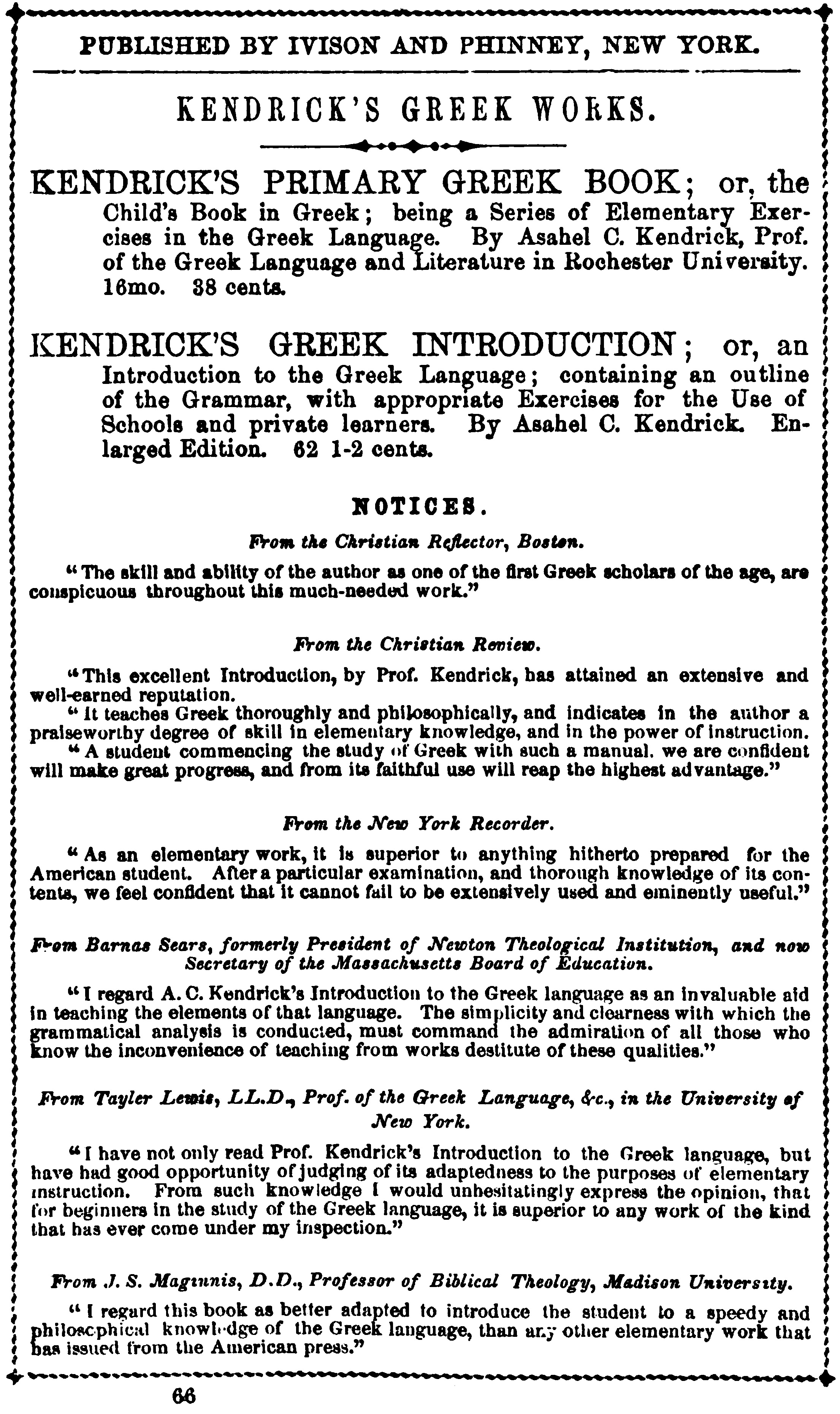
The above advert appeared at the back of Raphael Kühner’s truly dreadful An Elementary Grammar of the Greek Language: Containing a Series of Greek and English Exercises for Translation, with the Requisite Vocabularies, and an Appendix on the Homeric Verse and Dialect 13th edition, translated by Samuel H. Taylor (New York: Ivison & Phinney, 1857).
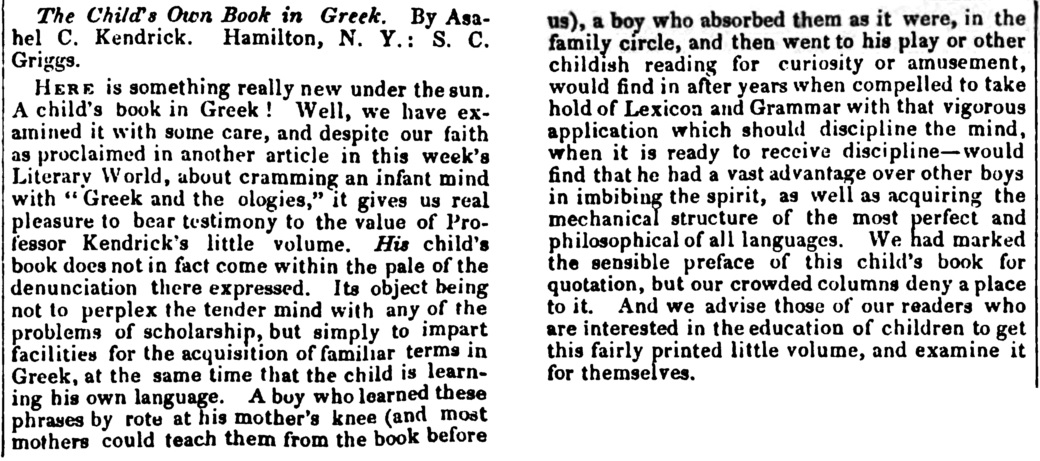
The Literary World: A Gazette of Authors, Readers, and Publishers
no. 37, Saturday, 16 October 1847,
Got it!
The University of Rochester lends out a bound photocopy via Interlibrary Loan.
Hoorah. I have liberated it! It needed liberating!
Asahel Clark Kendrick,
The Child’s Book in Greek, Being a Series of Elementary Exercises in the Greek Language
(the actual scan of the actual photocopy of the actual book, but I added highlights –
Hamilton, NY: S. C. Griggs; and New York: Mark H. Newman & Co., 1847).
Not only did I liberate it, I repaired some broken type and I also highlighted typographical errors, which would otherwise cause students terrible confusion.
Tiniest little thing, about 5 ¾" tall by about
3 15/16" wide.
Exactly what I needed when I was a kid, but who knew it even existed?
It’s the most beautiful book I’ve ever seen in my life.
As I was reading it aloud, I found myself bursting out with laughter in relief from a lifetime of stress.
This is what I wanted. This is what I needed. This would have changed my whole life.
When my sixth-grade teacher saw that he had sparked my interest,
why didn’t he tell me about this booklet? Why didn’t he know about this booklet?
Why didn’t anybody know about this booklet?
It’s only a few pages long, but don’t expect to get to the end for quite a while.
You really need to dwell on each page for hours or more, repeating it aloud ceaselessly.
Every mommy in the world should use this booklet to teach her children.
So there.
We can see from the advert above that Ivison & Phinney reissued this Child’s Book a decade later.
We can also see from the title page
of the 1855 edition of Kendrick’s Introduction to the Greek Language that Ivison & Phinney were the
“successors of Newman & Ivison, and Mark H. Newman & Co.”
Apparently this was a consolidation, as Ivison & Phinney’s branches were S.C. Griggs of Chicago;
Phinney & Co. of Buffalo; Moore, Wilstach, Keys & Co. of Cincinnati; and Seymour & Co. of Auburn.
Ooooo. My mouth is watering. If I still lived round those parts, I would write an article about this.
Since I no longer live round those parts, you should write an article about this.
Submit it as your master’s thesis and then publish it and go on the lecture circuit and make some money.
Since I had access only to a sad photocopy, which rendered some of the print barely legible, I decided to do the right thing.
I retyped the entire book.
Pages 3 and 4 drove me nuts, and so I altered them, and I added some small notes about things that would confuse a pupil new to the topic.
Something tells me that Uncle Asahel wouldn’t mind.
I also added a graphic that I stole from Divry’s Greek Made Easy.
Better yet, I corrected a whole mess of typos.
I read through it several times, and I cannot spot any more errors.
Hope I’m not stupidly missing something dumb.
The Greek lead font that S.C. Griggs of Hamilton, NY, and Mark H. Newman & Co. of NYC employed
(Monotype Greek 91 Lipsías/Lipsiakos,
or Teubner if you will)
has been digitized but I can’t spare the money at the moment. Soon.
Finding the English font, on the other hand, was a greater challenge. After a diligent search
(read: scanning a sample page into Fontspring Matcherator)
I discover that it is nearly identical to Adobe Caslon, though I would need to adjust the leading quite drastically to force a match,
and I don’t know if that can be done with Unicode Greek and Adobe sharing the same lines.
I’ll try it. Not now. Soon.
(Closer still is a font scanned from an 1865 reprint of Oliver Twist, which was set in Clarendon, which is different from the Clarendon TrueType font.
In honor of the book, the scanned font has been dubbed “Artful Dodger.”
I can’t use it, since it hasn’t been tweaked and retains the imperfections of the old printing processes.)
Anyway, I gave up and resorted to modern fonts.
The photocopy I received from the University of Rochester Library did not include the covers or end papers.
Fortunately, I have a fair collection of antiquarian books,
and so I pulled Year’s Work in Classical Studies 1910
from my shelf and scanned its cover and end papers instead,
simply to provide my forgery with at least some little feel of an original.
If you find any typos, just give me a holler.
Thanks!
Here we can do a bit of detective work.
Kendrick published his Introduction to the Greek Language in 1841 and again in 1846.
Though designed to be taught orally, the printed text still followed the “traditional” charts-and-rules format.
It was immediately after submitting his 1846 edition that he discovered Ollendorff.
We can be certain of that, because his Child’s Book of 1847 was entirely Ollendorffian,
and he was openly hesitant about taking this new direction.
Wrote he in his Preface:
|
Should these introductory lessons be favorably received,
the author will soon follow them with another book, constructed on the same plan,
and designed to lead on pupils from the point where the present leaves them.
|
His book was indeed favorably received, though the evidence for the favorable reception can be only conjectural.
I have found a mere single review, reproduced above.
There are only four copies listed in the OCLC,
one of which has missing pages,
and I have never been able to find one on the used market.
No library is listed as possessing the Ivison & Phinney reissue.
If this work of first-rate scholarship was favorably received,
there is a surprising dearth of originals floating about —
or, perhaps, that is not so surprising after all, since Uncle Asahel’s tome was small and was handed out to children.
What happens when you give small children small objects?
There you have it: The obliteration of history.
Now, Bill Rouse (as we shall see below) insisted that there is no ancient authority for using the printed grave ` accent.
Anytime a grave accent is printed, it should be pronounced as an acute, he said.
Uncle Asahel, on the other hand, stated something quite different:
|
3. When a word, whose last syllable is accented,
stands in connexion before other words,
the acute is softened down, and is expressed
by the grave; thus,
ὀργὴ
δὲ
πολλὰ
δρᾶν
ἀναγκάζει
κακά.
When therefore the student meets
with the grave accent on the last syllable of a
word, he will remember it is merely a softened
acute.
|
As I do the exercises, I discover that Uncle Asahel was right, and Uncle Bill was wrong.
No two ways about it.
Though I am not a historian, I can see what happened.
By the third century BCE, many Greek dialects had lost the eccentric pitch accent.
When giving recitals of Homer, younger speakers were at a loss,
but the legendary
Aristophanes of Byzantium (or whoever he really was) came to the rescue.
He invented a new system of marking the accent on each syllable.
In the early manuscripts that followed this new system, the grave accent was placed over every syllable that did not have an acute or circumflex.
Oh, what I wouldn’t give to see those old manuscripts!
That practice was redundant, and soon enough (hundreds of years? a thousand years? three weeks? I do not know)
the written grave was put to a new purpose, namely, to help speakers recognize which acute accents were not quite so acute as others.
There is no other possible explanation.
I am unable to find an illustration of an early manuscript that uses these diacritics,
but I do find Antonius Nicholas Jannaris’s
An Historical Greek Grammar, Chiefly of the Attic Dialect as Written and Spoken from Classical Antiquity down to the Present Time:
Founded upon the Ancient Texts, Inscriptions, Papyri and Present Popular Greek
(New York: The Macmillan and Co., Limited, 1897).
Jannaris was confused about the Classical pronunciation
(he did not understand the letter Ζ, nor did he understand the concept of pitch, and instead conflated it with some variation of stress),
but he did publish some really interesting information, for instance:
You will discover that, when you pronounce every ` as a ´,
you can never force the ` quite as high as a ´.
That is the explanation for the `,
there is nothing more to it than that.
In essence, the ` is a redundant diacritic.
Now let’s get back to Uncle Asahel.
Upon the success of his Child’s Book, Kendrick felt confident in trying something new.
He recast his Introduction to the Study of the Greek Language and turned it into
something a self-learner could master outside a classroom, in the absence of guided conversation.
He dispensed with the overwrought grammatical theories and substituted for them practice,
English-to-Greek and Greek-to-English, spoken aloud.
The practice was sufficiently copious to permit a self-learner to make rapid progress.
The result was his
Greek Ollendorff; Being a Progressive Exhibition of the Principles of the Greek Grammar:
Designed for Beginners in Greek, and as a Book of Exercises for Academies and Colleges
(NY: D. Appleton & Co., 1851).
I cannot help but wonder if it was the directors of the late Daniel Appleton’s firm
that approached Kendrick about creating such a work,
or if it was Kendrick who, having chanced upon some of Appleton’s unauthorized Ollendorff editions,
proposed the work to the publisher.
His biography,
An American Scholar: A Tribute to Asahel Clark Kendrick, D.D., LL.D., 1809–1895, written by his daughter,
Florence Kendrick Cooper (NY: privately printed, 1913), makes no mention of her father’s Greek Ollendorff.
I cannot know, but my educated guess is that the Greek Ollendorff, fine as it was, resulted in some legal problems,
and that may have been reason for his daughter to omit it from her narrative. That’s just a guess, nothing more.
Despite the title, Kendrick’s volume was not an Ollendorff.
It did not use Ollendorff’s text at all, and it used Ollendorff’s name without authorization.
It was a much shortened, much simplified attempt at something along Ollendorffian lines,
with no attempt made at being a complete grammar:
|
The present work is what its title indicates, strictly an
Ollendorff, and aims to apply the methods which have
proved so successful in the acquisition of the Modern
languages to the study of the Ancient Greek, with such
differences of course as the different genius of the Greek,
and the different purposes for which it is studied,
would suggest. It differs from the modern Ollendorffs
in containing Exercises for reciprocal translation, in
confining them within a smaller compass, and in a
more methodical exposition of the principles of the
language. It differs, on the other hand, from other
excellent elementary works in Greek, which have
recently appeared, in a more rigid adherence to the
Ollendorff method, and the greater simplicity of its
plan; in simplifying as much as possible the character
of the Exercises, and keeping out of sight every thing
which would divert the student’s attention from the
naked construction.
The object of the Author in this work was
|
As with the real Ollendorff books, there are no stories, just random sentences, preposterous sentences,
none of which could conceivably be spoken in real life, some of which don’t even make sense.
“Our mother is not in the village, but in the house.
She is either in the porch, or on the seat.
The ball lies either on the gate, or in the spring.
My staff does not lie on the cloak, nor on the rocks.
The roots of the thorns are in the rocks.
The cows lie in the gate.
Who runs?
I and you run.
I and the boy run.
Both we and the cows run.
Either you run, or the cows.
You do not run, but we.
I do not run, but the boy and the girl.
How much money have you in the chest?
Much.
There is much blood in the body.
Much blood flows through all the body.
The mouth has one tongue and many teeth.
We eat and drink with our mouth.
Just as we see with our eyes and hear with our ears, so we eat with our mouth.
Nobody eats without teeth.
The orator has not spoken without a tongue.
I have caught all these squirrels.
This young man’s ears have run together into his tongue.”
Completely nutty. Nonetheless, it works.
Self-learners who wish to go through this book, after bracing themselves for several hundred pages of such staccato nonsense,
would probably gain a great deal and enjoy lots of laughs at the unintentional humor.
(Under no circumstances should you follow the modern audio recording, which is pronounced as Modern Greek with a thick American accent. Avoid.)
Now we come to the usual inexplicable.
Classical Greek was a pitch-based language, yet Uncle Asahel did not bother with the pitch.
Why? Why? Why?
He made a mistake on page 17 of his 1847 Introduction to the Greek Language:
“One syllable in every Greek word has an accent, i. e. is pronounced with a slight elevation and stress of voice....”
No.
Sometimes the elevation coincided with the stress, but more often not.
This is the most common mistake I hear when I listen to demonstrations of the “restored” pronunciation on YouTube and elsewhere.
In English, French, German, Italian, Spanish, stress and higher pitch always appear together, never is there one without the other,
and so Brits, Americans, French, Germans, Italians, Spaniards, Méxicans, with brute violence,
force Classical Greek to do the same, and the result causes paint to peel off of walls and mirrors to shatter.
Dogs howl, cats shriek, neighbors start arguing, cars crash, horses escape to the next county, birds fall from the sky in response to that inhumanly harsh cacophony.
Worse, in his 1851 Greek Ollendorff, after so carefully and half-way accurately explaining the pitch,
he concludes (p. 14) with a dismissal of its importance:
“The Greek accent-marks influence our pronunciation only so far as they indicate the quantity of the syllable....”
After all that work to get it right, why does he give up?
I have many more gripes about the alleged “restored” and so-called “Erasmian” pronunciations below.
Uncle
Asahel’s
Greek Ollendorff remained in print for rather a while,
both in the US (primarily by Appleton) and also in England (by
Trübner).
Here is a reissue from 1859
(also here),
and another from 1861,
and still another from 1869
(also here),
and finally another from 1883.
The original 1851 printing contained a number of typographical errors, and it is clear that Uncle Asahel caught them rather quickly.
The cost and time to reset from scratch each page that contained an error, and to create new stereotypes, was surely prohibitive
(though I have no details or anecdotes to support this statement).
It seems that the author was offered the opportunity to make only a small amount of corrections,
and it would not surprise me in the least if he agreed to be billed for the service.
Most errors would have to stand.
He chose to rectify only some of the more serious offenders.
On page 82, line 12, of the 1851 and 1852 printings we see
χρῡσοῖν, αῖν, αῖν,
but by the time of the several 1857 printings, this was corrected to
χρῡσοῖν, αῖν, οῖν.
The 1851 and 1852 printings, on page 144, line 10, introduce the word
ἥκουον,
and that reduced me to tears and loud wailing throughout the night.
I didn’t understand how that form could be.
The 1857 printing happily corrected this:
ἤκουον.
I slept better once I saw that.
On page 158, lines 24—25, a declarative sentence mistakenly concluded with a question mark in the 1851 and 1852 printings:
“I shall find my cloak?”
This was corrected by the 1857 printing: “I shall find my cloak.”
On page 162, line 10, we find
τῂν, an impossibility.
This was corrected to
τὴν by the time of the 1857 printing.
This is the sort of tedious detail that would bore the skin off of anybody else’s teeth,
but it entirely ensorcels me.
Before too long, I shall here publish a full errata sheet.
|
Ἐὰν
μὴ
ἔλπηται
ἀνέλπιστον
οὐκ
ἐξευρήσει,
ἀνεξερεύνητον
ἐὸν
καὶ
ἄπορον.
— Heraclitus, fragment DK B18
What does that mean? I don’t know. I haven’t learned enough.
One online translation renders this as,
“If you do not expect the unexpected, you will not find it; for it is hard to be sought out and difficult.”
Not so inspiring.
Another online translation is a little more fun:
“If one does not hope, one will not find the
|
An instructor in Classical languages just sent me an email message
with the startling news that, not only were there two imitation-Ollendorff courses for Attic Greek, there were actually three.
The course in question is the terrifying tome by Dr. Raphael Kühner, but this time with addenda by Dr. Charles W. Bateman,
who updated and expanded Kühner’s work in 1863
(see The New York Times of 29 October 1863).
The following spring saw the unveiling of Elementary Greek Grammar, Containing a Series of Greek and English Exercises for Translation, with the Requisite Vocabularies,
and an Appendix on the Homeric Verse and Dialect. By Dr Kühner, translated by S. H. Taylor, LL.D.
A New Edition, Revised and Edited, with Numerous Emendations and Additions, Including Upwards of a Thousand Examination Questions,
by Charles W. Bateman, LL.B. Sometime Scholar of Trinity College, Dublin (London: Simpkin, Marshall & Co., 1864).
Here is a review of this work:
The above volume remained in print at least until 1867:
So where can we find this volume?
It has not been posted online anywhere.
It is not listed in the OCLC.
Yet it is listed at the
University of Leeds Library, Special Collections.
Is it worth seeking out?
Maybe not.
You see, the Key is posted online,
and from it we can discern that, while an assiduous student determined to plough through to the end would surely succeed,
it is not a pleasant ride.
A Key to the Exercises in Kühner’s Elementary Grammar of the Greek Language. By Charles W. Bateman, LL.B., Sometime Scholar of Trinity College, Dublin
(London: Simkin, Marshall and Co. and David Nutt; Dublin: W.B. Kelly; Edinburgh: Oliver and Boyde, 1864)
contains such everyday thoughts as,
“It concerns sailors about the sea.
Fly, O Persês!
Every disgrace follows vice.
Bear poverty easily.
Thunder springs from brilliant lightning.
Keep from the wasp!
The gods send prodigies to men.
Death is the remedy of the ills in old age.
The earth blooms with vernal flowers.
The three hundred with Leonidas died fighting bravely.
Relieve me, O friend, of my troubles, dissipate my cares, and turn me again to gladness!
Xenophanes used to say that the earth was compounded of air and fire.”
Yes, it can be done.
The sentences, like the sentences in Ollendorff, are peculiar, but unlike the sentences in Ollendorff, they do not concern our daily lives.
There is nothing here about cooking dinner or visiting a neighbor or mending clothes or friends blowing their brains out
or wives jumping out of windows to drown themselves in the river
or fathers selling horses and purchasing oxen
or masters beating lazy students
or traveling companions too frequently stopping off at inns to indulge in libations.
I can relate to those situations. No prob.
Bateman’s sentences are all abstractions.
Maybe some students would find this delightful.
I would find it extremely difficult, as my mind would never cease wandering.
Speaking of my new Classicist acquaintance, take a look:
Patreon Greek and English Method (with a hybrid pronunciation)
and
Latinum.
Pay attention to his little note:
“Examples of these ancient Attic vowel pronunciations persist in various locales in Modern Greek dialects, although no one place has them all.”
I thought that would be the case. Of course, I couldn’t know for certain, since I have never been able to visit Greece, and probably never shall.
Hopelessly beyond my means. Been trying to save up the money for forty years. It’ll never happen.
Where was this guy when I was eleven? I needed him when I was eleven.
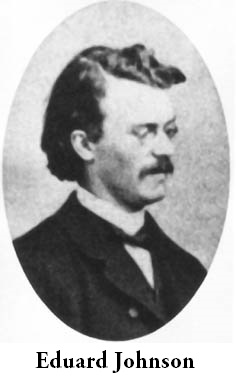 I just now discovered this fascinating
Res Græcæ page,
which lists sources for those wishing to learn the language.
An item that interests me greatly is a book by Eduard Johnson, who Græcized his name to E. Joannides:
Sprechen Sie Attisch?
with an added English column by Carl Conrad and Louis Sorenson.
This is a phrasebook, much like phrasebooks used by tourists, but in Attic Greek!
Leave it to the Germans to publish something this clever!
Maddeningly, the English version was removed from the Internet after only pages 20 through 66 of the 80-page booklet had been completed.
The
WayBackMachine graciously captured pages 20 through 66.
There’s also
a PDF edition minus the German column.
I’m looking through it and, oh, it’s worth its weight in gold!
Would some kindly soul be good enough to complete this English edition for the rest of the world?
This is exactly what’s needed to bring a “dead” language back to life.
This is exactly what a teacher would need to help with class conversation.
These are the little everyday things we need in order to pick up the language,
and these are the little everyday things that other texts completely avoid, intentionally,
so that we’ll never feel comfortable in the language.
I just now discovered this fascinating
Res Græcæ page,
which lists sources for those wishing to learn the language.
An item that interests me greatly is a book by Eduard Johnson, who Græcized his name to E. Joannides:
Sprechen Sie Attisch?
with an added English column by Carl Conrad and Louis Sorenson.
This is a phrasebook, much like phrasebooks used by tourists, but in Attic Greek!
Leave it to the Germans to publish something this clever!
Maddeningly, the English version was removed from the Internet after only pages 20 through 66 of the 80-page booklet had been completed.
The
WayBackMachine graciously captured pages 20 through 66.
There’s also
a PDF edition minus the German column.
I’m looking through it and, oh, it’s worth its weight in gold!
Would some kindly soul be good enough to complete this English edition for the rest of the world?
This is exactly what’s needed to bring a “dead” language back to life.
This is exactly what a teacher would need to help with class conversation.
These are the little everyday things we need in order to pick up the language,
and these are the little everyday things that other texts completely avoid, intentionally,
so that we’ll never feel comfortable in the language.
 Who knew that in 1587
Johannes Posselius did sort of the same for Latin speakers?
Yes, he did.
Well, it wasn’t actually a phrasebook; it was a series of bizarre dialogues:
Οἰκείων
διαλόγων
βιβλίον
ἑλληνιστὶ
καὶ
ῥωμαιστί.
Familiarivm colloqviorvm libellvs graece et latine.
auctus & recognitus.
Acceſsit & vtilis Dialogus de ratione ſtudiorum recte inſtituenda,
Item Oratorio de ratione diſcendæ ac docendæ linguæ Latinæ & Græcæ (Wittenberg: Zacharias Lehman, 1587 –
the illegible font is called Grecs du Roi,
based on the calligraphy of a Cretan named
Ange Vergèce).
This was reprinted in
1590,
1601,
1614, and
1623.
Fortunately, someone named Professor Diane Johnson,
who should win a medal of honor, transcribed a 1656 reprint of Posselius’s book and added an English column!
Here it is!
Some students caught some typos,
and so one of them posted an amended version of Johnson’s text
here.
By the way, Posselius’s book remained in print at least through 1681.
There was a market for these critters back in them thar days.
And oh gee oh wow, golly gee wilikers, I just found a 1710 reprint on Abe Books.
Couldn’t help myself.
A shrink would call this a personality disorder or something.
To heck with shrinks. I can’t live without this thing.
Only a century note, so hey.
Who knew that in 1587
Johannes Posselius did sort of the same for Latin speakers?
Yes, he did.
Well, it wasn’t actually a phrasebook; it was a series of bizarre dialogues:
Οἰκείων
διαλόγων
βιβλίον
ἑλληνιστὶ
καὶ
ῥωμαιστί.
Familiarivm colloqviorvm libellvs graece et latine.
auctus & recognitus.
Acceſsit & vtilis Dialogus de ratione ſtudiorum recte inſtituenda,
Item Oratorio de ratione diſcendæ ac docendæ linguæ Latinæ & Græcæ (Wittenberg: Zacharias Lehman, 1587 –
the illegible font is called Grecs du Roi,
based on the calligraphy of a Cretan named
Ange Vergèce).
This was reprinted in
1590,
1601,
1614, and
1623.
Fortunately, someone named Professor Diane Johnson,
who should win a medal of honor, transcribed a 1656 reprint of Posselius’s book and added an English column!
Here it is!
Some students caught some typos,
and so one of them posted an amended version of Johnson’s text
here.
By the way, Posselius’s book remained in print at least through 1681.
There was a market for these critters back in them thar days.
And oh gee oh wow, golly gee wilikers, I just found a 1710 reprint on Abe Books.
Couldn’t help myself.
A shrink would call this a personality disorder or something.
To heck with shrinks. I can’t live without this thing.
Only a century note, so hey.
 Another unexpected find is John Stuart Blackie’s
Greek and English Dialogues for Use in Schools and Colleges. Amazing! Why did I never know about this before?
While certainly not everything I wanted, I could have worked with this and had the time of my life!
It would not have been easy, because it would have required me to use one of those horrid “traditional” grammars as a reference,
but I would have done it just to revel in these simple readings.
Again, if teachers would only use this as a basis for classroom conversation, oh how my heart would flutter!
In my teens I had searched around for graded readers, and I found a few, and they were horrible.
Again, they were designed only to intimidate, not to teach.
Another unexpected find is John Stuart Blackie’s
Greek and English Dialogues for Use in Schools and Colleges. Amazing! Why did I never know about this before?
While certainly not everything I wanted, I could have worked with this and had the time of my life!
It would not have been easy, because it would have required me to use one of those horrid “traditional” grammars as a reference,
but I would have done it just to revel in these simple readings.
Again, if teachers would only use this as a basis for classroom conversation, oh how my heart would flutter!
In my teens I had searched around for graded readers, and I found a few, and they were horrible.
Again, they were designed only to intimidate, not to teach.
Now I discover that there was once upon a time a superb graded reader!!!
Francis David Morice’s
Stories in Attic Greek.
Aaaaaarrrgggghhhhh. Missed out five times over.
Six books were available when I was a teen.
As a teen I was fantasizing that if only such books had existed....
Such books would have changed my life for the better.
If I had spotted them on a library shelf, I would have devoured them. I never knew about them!
Most and Pine, and now Kendrick and Blackie and Morice. They were all there. I never knew.
Should I feel elated that I have finally discovered them,
or should I feel deflated that my entire life has gone down the drain because I didn’t know about them in time?
Ohhhhhhhhh. Another discovery.
Richard Augustus Agincourt Beresford and Robert Noel Douglas created a slender little volume called
A First Greek Reader
(London: Blackie and Son Limited, [1902]).
Baby steps. Infant level. Oooooooooooooooooooooooooooooo.
This is what would have made me swoon back in sixth grade.
My fantasy about a nonexistent past:
At the end of the day, when Mr. Smith dismisses class, he calls me over to his desk and quietly says,
“I see this interests you. Here, borrow these books,”
as he hands me Kendrick’s Child’s Book in Greek and Greek Ollendorff
and Beresford & Douglas’s A First Greek Reader,
and secretly tells me how to pronounce the words as they were spoken 2,500 years ago.
I would have been glued to the books. I would have stopped watching TV, instantly and forever.
Alex Lee
has a helpful page, which points out to us yet one more invaluable text, of which I had been in total ignorance:
Francis Henry Colson’s
Stories and Legends: A First Greek Reader.
My heavens!
All language classes should be primarily (or exclusively!) spoken,
and if texts are used, they should be texts like Colson’s and Blackie’s and Morice’s,
for it is texts such as these that allow students to lose themselves.
Why doesn’t anybody teach this way?
Why do all language courses have to be grammatical drills and fill-in-the-blanks and flash cards and written translations?
That is so dreadful, especially since better methods are now freely available at the click of a mouse.
I just discovered another course that is better than the average:
William R. Harper and William E. Waters,
An Inductive Greek Method
(NY, Cincinnati, Chicago: American Book Company, from the Press of Ivison, Blakeman & Company, 1888).
This was intense, it stressed writing above all, and it assumed fluency in Latin.
It opened with the first sentence of Xenophon’s Anabasis, which was then broken apart and analyzed in depth.
This was followed by quizzes and practice.
The second lesson was the second sentence of the Anabasis, with more and more drills.
The point, as you can probably guess, was to bring students quickly to an understanding of the Anabasis, and I’m sure it would work.
Not every student would prefer this method.
It would drive some students batty.
A good teacher could make this course come to life.
A self-learner would not have such an easy time,
but a self-learner would nonetheless greatly prefer this to most other courses.

I see one other reader that looks quite promising indeed:
J. Surtees Phillpotts and G. Cyril Armstrong,
Fact and Legend from the Father of History Offered in Easy Attic Greek (London: Rivingtons, 1930).
This is still protected by copyright, so just purchase a copy or get one from a library.
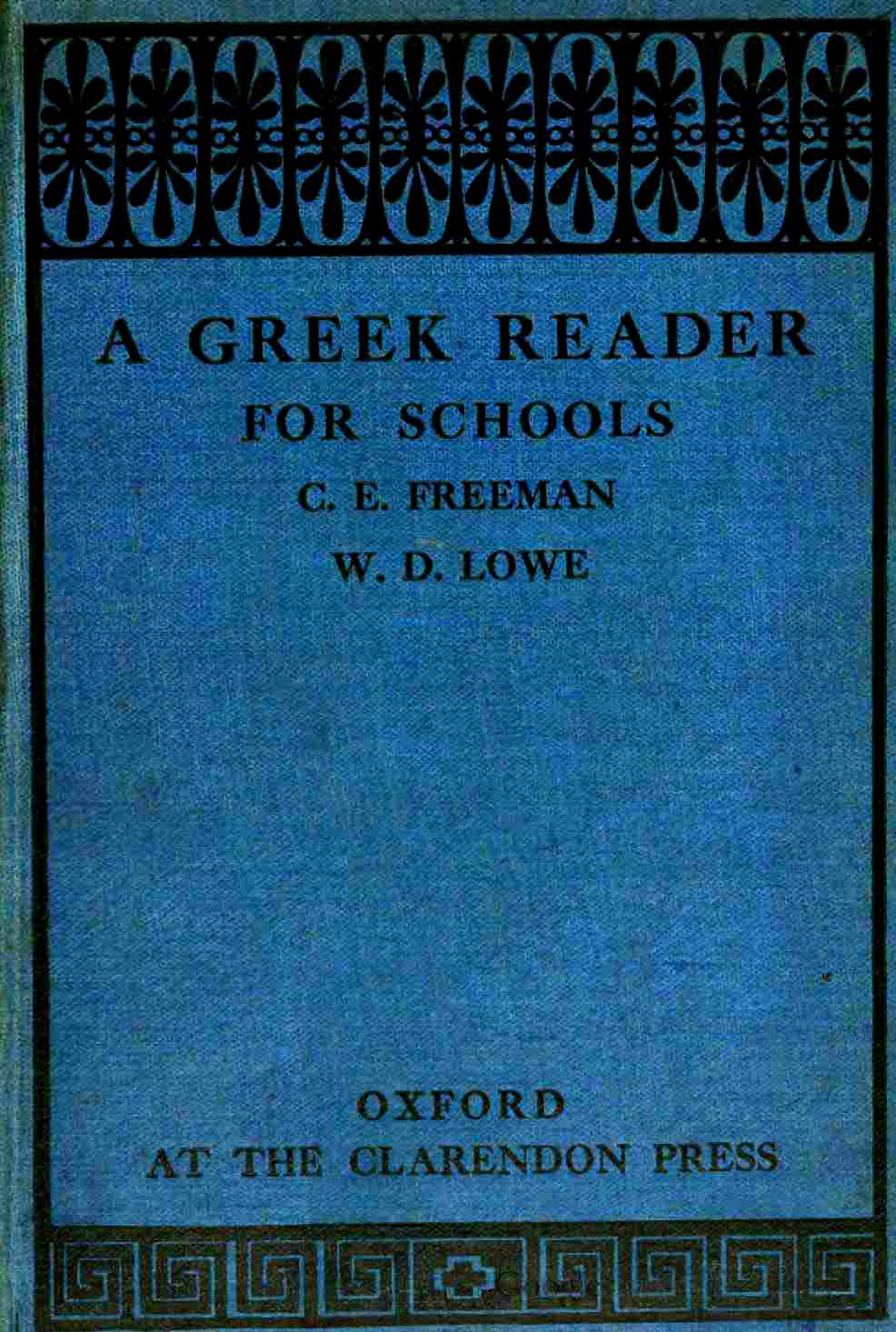
Another promising freebie is C.E. Freeman and W.D. Lowe’s
A Greek Reader for Schools
(Oxford: Clarendon Press, 1917).
As I’ve been learning these past few weeks,
the resemblance between Classical Greek and Modern Greek is nearly nonexistent.
Knowledge of one will not help with learning the other in any way at all.
If anything, as I’m discovering to my dismay,
knowledge of one would probably impede the learning of the other — seriously impede.
Classical Greek is not quite as distant from Modern Greek as
Beowulf is from Vonnegut,
and that is a pity, because if it were that distant it would be easier to learn.
As to how the language sounded, except for Rouse’s 78’s,
all recordings of ancient Greek pronunciation and pitch accent that I have found range from meh to dead wrong.
I’ve never heard one that was in the least bit convincing.
They are all forced, they sound inhuman, and most get the vowels and even the consonants wrong.
When I find my cassette tape of Rouse’s 78rpm shellacs I’ll upload it.
It’s somewhere among my hundreds and hundreds of boxes in storage 800 miles away.
When I first got it back in 1982 it made my jaw drop.
To my naïve 22-year-old ears Rouse’s delivery made the pitch and quantity sound perfectly natural.
I felt as though the millennia-dead had been reborn in this humble chubby five-foot white-bearded school teacher.
Now, though, after learning more, I disagree almost in toto with Rouse’s reconstruction of the pitch.
I’ll explain why a little below.
Of course, as I stated above, immediately upon acquiring that cassette I found myself working 100+hrs/wk as a wage slave. Oy vey.
Oh, if you ever find a Greek textbook that deletes the accents and keeps vowel lengths a secret from you, throw it away. Worthless.
Oh. Never mind.
Someone else uploaded Bill Rouse’s recordings.
“The Sounds of Ancient Greek” and
“Passages from the Greek Classics” (London: The Linguaphone Institute, 1932).
In anticipation of the inevitable when this gets taken down, I made backups:
The Sounds of Ancient Greek, side 1:
I would embed it in this web page, but in some browsers it will begin playing the moment you open the page. The same codes that prevent “autoplay” or “autostart” in one browser will force all the audio recordings simultaneously to autoplay or autostart in another browser. Sheesh.
So, click here instead.
I would embed it in this web page, but in some browsers it will begin playing the moment you open the page. The same codes that prevent “autoplay” or “autostart” in one browser will force all the audio recordings simultaneously to autoplay or autostart in another browser. Sheesh.
So, click here instead.
As I listen to these again after all these decades, I’m much less impressed than I was at age 22.
I’m catching countless howlers, the exaggerations are ludicrous, and the delivery is anything but natural,
but yet the way Bill Rouse spoke the language was such a vast improvement over previous reconstructions that it paves my way.
It should pave your way too.
Rouse’s pronunciation was infinitely superior to any other pronunciation I have ever heard in any context from anybody.
As horribly wrong as he was, we should pay attention to what he got right.
By the way, after Bill Stanford heard Bill Rouse’s pronunciation, he got this right too.
What Bill and Bill got right is important, because what they got right is what NOBODY ELSE ever got right.
Listen to Bill Rouse’s pronunciations of
ϑέλω,
χέω,
ϑάλασσα,
κόβᾱλος,
ὀπαδός,
κάμῑνος,
φλυᾱρίᾱ,
Μαῖα,
λέγει,
Τροῖα,
ἡμετέρη.
He pronounced these words awkwardly, but he got the relation of pitch and length pretty much right. Hoorah.
Maybe he picked this up from Vedic Sanskrit? Maybe?
I am also thrilled that he pronounced the iota subscript.
Too many scholars refuse to pronounce it. Too many scholars are wrong.
As for most of the rest of the contents of these records, oy vey.
Further, as I discover from
The Teaching of Greek at the Perse School, Cambridge (London: Eyre and Spottiswoode, 1914),
the absurdly exaggerated pitches and quantities and chanting and rhythms on display in these recordings
were used only in the early weeks of Rouse’s course.
Once the students had latched on to the concepts, the pronunciation became more normal.
It is too bad that Rouse chose to utilize the exaggerated rather than the normal pronunciation for his Linguaphone records.
Or did he?
If what he recorded onto these discs represented his normal pronunciation, then heaven help those who endured his exaggerated pronunciation.
(Immediately after discovering this online edition of Rouse’s Greek recordings,
I saw that an original set was on Hong Kong eBay for an astonishingly low price.
I did a “Buy It Now” so quickly.
The package arrived just a few days later, in its original antique shipping box, no less!)
When I go on to YouTube and various blogs and whatnot to listen to ancient Greek,
I invariably shut each recording off after just a few seconds,
because it is too painful for me to endure.
The attempts are all dead wrong.
How can they all get it wrong?
It doesn’t seem possible.
It would seem to me that somebody would get it right, but no.
These recordings add a stress to the high pitch, though the acute frequently did not have any stress.
Often the slight stress fell on the syllable right before or right after the acute, and once in a while on some other syllable.
As far as I am aware, this is not a rule you can find in any ancient authority; it’s just the only possible way to do it.
Nothing else sounds remotely natural.
So Δικαιόπολις
has its primary stress on και
and its secondary stress on πο.
There’s no other possibility.
The circumflex, though, was indeed stressed, but only slightly.
So, I listen to these alleged reconstructions and I cringe.
These alleged reconstructed pronunciations are as painful to me as being punched in the stomach.
Why does nobody else even try to approach Rouse’s level? It’s not hard to do.
It’s not hard to do considerably better.
The ancients wrote that the difference between grave and acute was roughly a fifth.
Even that explanation was more metaphorical than actual, because people don’t speak by singing.
What is the spoken version of a fifth?
The difference between the two instances of twinkle in “Twinkle Twinkle Little Star.”
A better example of a spoken fifth would be roughly the difference between fish and tank in the word “fishtank.”
Put that word into a sentence, any sentence:
“Yesterday morning I awoke to see the fishtank chasing the mice around the ceiling and up the ladder.”
Say that aloud.
Your school teachers trained you to notice that there is the slightest stress on fish, but forget about the stress.
Pay attention to the pitch.
The fish syllable is just the tiniest bit higher than the tank syllable.
That’s what the ancients would have referred to, metaphorically, as a fifth.
Fish is acute, and tank is grave.
So much for the difference between grave and acute.
We also know the difference between an acute and a circumflex.
The middle syllable of resemble is an acute (which in English, of course, is epoxied to the stress, unfortunately).
The phrase lousy recording has a circumflex in each word.
Do you hear how it drops the tiniest bit?
We also know the difference between long and short.
What is the difference between a long and a short?
Fit is short, as it has a short vowel and is surrounded by consonants that don’t take a long time to pronounce.
Fish is long, because, despite the short vowel, the sh sound at the end takes a microsecond longer to pronounce than the t at the end of fit.
Unlike Classicists who record themselves on audio, you don’t deliberately hold the word fish twice as long as you hold the word fit.
You just say the words, and they take the time they take. That’s all.
So, we have a fifth and the length.
Two little ingredients. That’s it. Just two.
Better yet, we’ve all heard
Swedish, which has a vaguely similar pitch with quantity, or Norwegian.
¿A cinch, que no?
Why does nobody bother?
Admittedly, Swedish and Norwegian are much heavier-sounding languages than Greek, filled as they are with thuds
(not as thudding as English, the all-time champ, but still pretty thudding all the same).
Modern Greek is delicate, as light as a feather. Classical Greek was even lighter.
More importantly, we have a powerful new tool nowadays, something called YouTube,
and on this YouTube tool, we can listen to demonstrations of other languages that have pitch accents and tonal accents,
for instance Japanese,
Navajo, and
Yorùbá.
Watch those videos, carefully, several times each. Imitate them.
Once those lessons begin to sink in, Greek would not offer you any difficulty.
(As for the claims that Swedish, Norwegian, Serbo-Croatian, and so forth, are pitch languages, NO THEY ARE NOT!!!!!!
They are stress languages, with pitches laid over the stress.)
Let us pay attention to the first example in the Japanese video.
We have two words, one for “rain” and one for “candies.”
They can be perfectly — perfectly — transcribed into Attic Greek, thus:
ἄμε and
ἀμέ.
Rouse insisted that Classical Greek did not have stress. Rubbish.
Your teachers insist that English is devoid of quantity (longs and shorts) and pitch.
Your teachers are clueless.
Yes, English does have pitch, as well as tone, just as it has longs and shorts.
Unless you are talking through a speech synthesizer or through an electrolarynx, you would find it impossible to speak without pitch,
just as you would find it impossible to speak without stress or without longs and shorts.
Unless I am mistaken, the difference between a pitch-based language and a stress-based language
is simply, and only, that in a stress-based language, stress and high pitch are invariably combined.
In a pitch-based language, pitch and stress can drift apart from one another and land on different syllables.
Nõw, lét’s exámine sõmething.
When “Erãsmians” attémpt to speãk Greẽk, they eĩther sĩng or chãnt, quĩte ãwkwardly.
Éven when oũr belóved Dóctor Bĩll spoke Greẽk, he chãnted.
Nõ lãnguage is náturally chãnted.
Cértainly nõ lãnguage is éver náturally sũng.
Lãnguages are spõken.
Ãll lãnguages háve a pítch accent. Ãll of them. Nõ excéption.
Ín Énglish, of coũrse, the hĩgh and círcumflex pítches correspõnd with lõng, stréssed sýllables.
Ín Clássical Greẽk, on the óther hãnd, ás in Swẽdish and Norwẽgian,
the hĩgh pítch júst as õften lánds on shõrt, únstressed sýllables,
which lénds the lãnguage a delĩghtful sýncopated rhýthm.
Thát is the áspect of the lãnguage that was neãrly lõst as eãrly as twénty-threẽ hundred yeãrs agõ.
Pãy atténtion, toõ, to ãll the Énglish pítches betweẽn the hĩghs and the lõws.
Wé háve neãrly an entĩre mũsical scãle embédded into oũr lãnguage,
and yét we don’t sĩng when we tãlk, nõr do we chãnt.
We speãk, and we dõn’t even nõtice that we are speãking with a pítch áccent.
Thẽre you gõ. Peóple háve been wóndering sĩnce 1486.
Ãrguments galõre. Fĩghts. Screáming mátches.
Boõk áfter boõk áfter boõk, loũsy recõrding áfter loũsy recõrding áfter loũsy recõrding.
Proféssors and óther Ph.D.’s cãlling it quíts and concéding defeãt,
decíding to pronoũnce Áncient Greẽk as Módern Greẽk õr as Énglish õr as Látin õr as sõmething ẽlse.
Ãll for whãt?
Ĩ’m cértainly nót a histõrian, but fróm whát líttle Ĩ knõw, Ĩ can fígure oũt whát háppened.
Õnce Greẽk spĩlled oũt fãr pást the bõrders,
and õnce a goódly númber of speãkers leãrned Greẽk as a sécond lãnguage, the stréss shífted to pítched sýllables.
Whỹ? Becaũse peóple compélled to stúdy the new lánguage were tõld to raĩse their voĩces on cértain sýllables,
but they thoũght that meánt to máke those sýllables loũder.
Thát’s ãll. Thát’s ĩt. Nóthing mõre.
Aristóphanes of Byzántium óffered the diacrítics as a hẽlp to thõse who neẽded to gĩve públic recitãtions of the eãrlier téxts.
Mỹ õh mỹ hõw thát’s beẽn õverintẽrpreted.
Bỹ the wãy, Ĩ should poĩnt sómething oũt.
Íf you grẽw úp speãking Návajo,
yoũ will nót neẽd ányone to explaĩn to yoũ what the Greẽk acũte and círcumflex mãrkings meãn.
Yoũ will knõw alreády.
Nóbody would éven neéd to poĩnt to the squíggles and sãy to yoũ:
“Thát’s an acũte, thát’s a grãve, and thát’s a círcumflex.”
Ít would gõ withoũt sãying,
and twó or threé mínutes ínto your fĩrst lésson you’d rẽalize
that the wrítten grãve, pecúliarly, is álmost idẽntical to the spóken acũte.
Ĩ nõw conclũde, for a cẽrtainty, thát thẽre is nót nõw, nõr has thẽre éver beẽn,
a pẽrson flúent in bõth Návajo and Clássical Greẽk.
Perháps it’s tĩme to chánge that situãtion?
“English makes use of pitch variation over the length of an entire utterance rather than within one word.” —
Teaching Pronunciation: A Reference for Teachers of English to Speakers of Other Languages (Cambridge University Press, 1996), p. 184.
That emphatic prescriptive/descriptive rule would be correct if the last five words were to be cropped off.
Anyone with ears to hear can discern that pitch varies within individual English words, and that grave, acute, and circumflex are fixed, not interchangeable.
Though emotional mood and subtle nuances will vary the pitch over the course of a sentence, this does nothing to vary the relative pitch within any specific word.
The three paragraphs above demonstrate this, I hope.
I suppose that most native English speakers, though, would be deaf to the subtle variations that differentiate grave, acute, and circumflex in individual words.
If we were to pronounce “fãll” as “fáll,” the meaning would be identical, but we would raise eyebrows,
and people would wonder if we were ill, or about to suffer a fit of madness.
If we were to pronounce “sýncopated rhýthm” as “sỹncopated rhỹthm,” people would understand us,
but they would blink in confusion and scratch their heads and ask us if we were, perchance, one over the eight and in need of a lift home.
Grammars and dictionaries mark primary and secondary stress, but make no distinction between the two different types of stress in English words: acute and circumflex.
It does not surprise me too much that this part of English pronunciation is generally neglected in grammars and dictionaries.
After all, native English speakers are unconscious of the difference,
though at a subconscious level they are completely aware, for in speaking they never mistake one for the other.
It is unfortunate that it is native English speakers who write the grammars and dictionaries, hence the blind spot — or the deaf spot, as it were.
What does surprise me is that I have never found a reference work, anywhere, that makes mention of this pitch variation in individual words.
I would have supposed that someone would have noticed it. Someone. Somewhere. Sometime. Wrong.
Oh, I suppose there’s an obscure article about it in some obscure academic journal that nobody will ever find,
but, really, this aspect of the language should be more openly discussed.
Probably the best way to get an idea of what pitch means is to hear someone mispronounce English by placing pitch on syllables that don’t take stress.
Fortunately for us, we have two examples of this, if we but betake ourselves to YouTube.
There are surely more examples, but these are the only two I’ve found. I would love to collect more.
Here are two guys from India who learned English as a second or third or fourth or eighth language.
Quite obviously their native tongues are primarily pitch-accented, and so they misapplied that technique to English.
Listen carefully, though, as each of these videos gives but a single example.
Here we have Svaanik Kumar give us a little lecture on “Slavic Sanskrit.”
Pay especial attention to him at 0:21, at which moment he correctly places a stress on the first syllable of “formulas,” but neglects to put an acute pitch on it.
Instead, he wrongly moves the acute pitch to the second syllable, and then, for good measure, he lengthens the final syllable:
“formúlās.”
Isn’t that wonderful?
Then listen to this video of “Candidate: OR 5916.”
At 0:49 the candidate does the same thing that Kumar did:
He correctly places the stress on the first syllable, but incorrectly leaves off the acute pitch, which he mistakenly shifts to the second syllable:
“everýwhere,”
So there you go. That’s the Greek acute. That’s it. That’s all there is to it.
It’s not any more complicated than that. It’s simple. Anybody can do it.
It does not sound forced. It does not strain the vocal cords.
Though it is akin to Swedish, it is different.
William Harris of Middlebury College
noted that colleagues complained about a restored pronunciation:
“And I have heard linguistic-ethnicists object, saying they didn’t want their Greek to sound like Chinese, or the soundtrack of a Bergman film.”
Where on earth would anybody get the idea that a restored pronunciation would sound like Chinese or a Bergman film?
Do scholars think that a pitch accent necessitates an imitation of Chinese or Swedish?
Why would anybody think that? What are these people smoking?
So, are you still wondering about the Greek circumflex — you know, this ͂ squiggly thing?
Scholars who attempt to reconstruct Classical Greek pronunciation have a dreadfully difficult time with it.
They do the most peculiar things with their voices when they land on these syllables.
What is the difficulty? Why do all the scholars get it completely wrong?
Let us journey to Nigeria to listen to the Yorùbá language, for Yorùbá has the Greek circumflex, but written ` rather than ͂ .
Here is a lesson contrasting “DòDò,” “ReRe,” and “MíMí.”
We can knock at the house next door and hear another teacher giving the same lesson.
Pay attention to both lessons, and then think.
You see? Do you perceive what I perceive?
Simple: We have exactly the same thing in English.
Why has this never occurred to anybody?
It’s simple: a slight falling pitch. How slight? Very slight. The pitch glides down the tiniest little bit. Simple.
As you can see from the above enhanced paragraphs, we use the Greek circumflex in English every day, all the time.
It’s nothing unusual. We do this without even noticing.
Read my three paragraphs above, aloud, as naturally as you can, and pay attention to what your voice does to the syllables I have marked with the ͂ .
Don’t do anything out of the ordinary. Just read the paragraphs aloud as normally as you would read anything else.
This is what you should notice: On the syllables with ͂ you will put a slight emphasis and slightly high pitch
EITHER as you let your voice fall (glide down) the smallest little bit, OR as you have a slight diminuendo, or BOTH.
Now that I’m beginning some Greek, I cannot help but notice that the ͂ often requires a diminuendo rather than or in addition to the falling pitch.
It’s very slight, though; extremely slight — and we do this in English all the time!
The difference between acute and circumflex at first will be imperceptible.
Try it again a few times, and you will probably begin to perceive it, but the difference will become only barely perceptible.
Well, that’s the difference: barely perceptible.
You’ve done this all your life, and you’ve heard everyone else do this all your life,
but you never paid any attention because it just wasn’t important, was it?
Now try reading those ͂ syllables without allowing your voice to glide down or diminish.
Difficult, isn’t it? Nay, well-nigh impossible. Try it anyway.
Just punch your voice straight up as you do for the ˊ syllables.
Sounds peculiar, doesn’t it?
Want to make it even crazier? Swap the acutes with the circumflexes.
If you do that, you’ll sound like an intoxicated Swede struggling with English.
Now that I’ve made you self-conscious, you’ll notice when you use the circumflex, and you’ll notice when others use it.
Good.
Now that you’ve watched the two YouTube videos with the misplaced pitch, listening carefully for the anomaly,
now that you have at last trained your ears to detect that anomaly,
now that you have witnessed explicit demonstrations in Yorùbá of the falling pitch as opposed to the acute,
now that you have read aloud the three marked paragraphs above and paid attention to your voice modulations,
now that you have swapped acute for circumflex and gotten so tongue-twisted as to sound worse than the neighborhood souse,
and now that you can finally discern the subtle difference between the acute and circumflex accent in English,
take it one step further with this experiment
(which only works if you do not have a Southern or Texan accent, for in the Southern and Texan accents pretty much all stress accents are circumflex):
Pronounce “falling” and pronounce “Fallbrook.”
Which has the acute, and which has the circumflex?
You can’t hear the difference, can you?
Try it a few dozen times.
Try it again tomorrow. Then try it again next week.
Keep trying.
Once you detect the slight difference, swap the pitch in “falling” with the pitch in “Fallbrook,”
and then you’ll hear the difference so loudly and so clearly that it will scream at you.
It’s a small, almost undetectable difference, but suddenly it will be as noticeable as a thunderclap.
It is only after training yourself to hear the difference that you can appreciate the finely tuned ear of Aristophanes of Byzantium (or whoever he really was).
Then, at last, you will know not to overinterpret his analysis of the sounds of the language,
not to worry yourself sick about exaggerating acute and circumflex in an attempt to distinguish one from the other,
and you will never sound as awful as the examples you can hear on YouTube.
I am certain that the Greeks of Classical times were for the most part unaware of the difference between acute and circumflex,
and I am certain that the two were barely different from one another.
Let us add one more exercise, as we hearken back to the Mitch Miller video in the link near the top of this page:
Sing Along with Mitch.
Note that in speaking normally, we would say,
“Fĩve-foŏt-twõ, eỹes ŏf blũe,”
but that in singing, though we keep the stress where it belongs, we shift the pitch to syllables that receive no stress:
“Fĩve-foŏ́t-twõ, eỹes ŏ́f blũe.”
Okay, now try to do that without singing.
For those who would wish to build up a straw man by overinterpreting my statements:
No, I’m not arguing that English is a pitch language.
In spoken English, pitch always coincides with stress, and so it is a stress language.
In English, stress predominates.
Yet like words in all spoken languages, English words have pitch.
Now I’ll probably receive hate mail telling me I’m entirely wrong and that there is no invariable acute or circumflex in English words,
that I’m just imagining what isn’t there and that I need to check myself into a psychiatric ward before I do someone an injury.
English words have stress only, the complainants will insist, and pitch varies only according to mood or nuanced meaning over the course of a full sentence.
Yeah, whatever.
Some Ph.D. somewhere will probably plagiarize me, and then other Ph.D.’s somewhere will probably write angry refutations,
and the blame will devolve upon my unpedigreed self, and I’ll be pilloried in the village square.
Yeah, whatever.
Once you attune your ears, though, and you clearly hear the subtle differences among grave, acute, and circumflex in individual English words,
you’ll have no problem pronouncing Classical Greek.
You’ll be as good as Erasmus, which is why all the Erasmians will hate you forever.
As for quantity (meaning long and short syllables), try to force yourself to remember what your teachers taught you in third grade.
Your teachers told you about scansion, but they mentioned only the stress.
They were wrong.
This is more than a matter of stress.
If the scansion you learned in third grade doesn’t ring a bell, go to Wikipedia.
Pay close attention, and you will notice that the long syllables are literally held just the tiniest fraction of a second longer than the short syllables.
You do this without being told to do it, without even being aware that you’re doing it.
As an experiment, try to pronounce each syllable of the below verse at exactly the same length.
Can’t do it, can you?
It’s painfully difficult not to lengthen the stressed syllables.
If you succeed, you’ll sound like a machine, only worse.
The princely palace of the sun stood gorgeous to behold
On stately pillars builded high of yellow burnished gold....
˘ ¯ ˘ ¯ ˘ ¯ ˘ ¯ ˘ ¯ ˘ ¯ ˘ ¯
On stately pillars builded high of yellow burnished gold....
˘ ¯ ˘ ¯ ˘ ¯ ˘ ¯ ˘ ¯ ˘ ¯ ˘ ¯
Now try reversing the longs and shorts, thusly:
The princely palace of the sun stood gorgeous to behold
On stately pillars builded high of yellow burnished gold....
¯ ˘ ¯ ˘ ¯ ˘ ¯ ˘ ¯ ˘ ¯ ˘ ¯ ˘
On stately pillars builded high of yellow burnished gold....
¯ ˘ ¯ ˘ ¯ ˘ ¯ ˘ ¯ ˘ ¯ ˘ ¯ ˘
That’s enough to reduce you to tears, isn’t it?
Length is an inherent part of the words, and it is not easy to alter it.
Pitch is an inherent part of the words, and it is not easy to alter it.
Now when you surf YouTube for “Erasmian pronunciation” you’ll be as irritated and furious as I am.
BasicsDesiderius Erasmus, De recta Latini Graecique sermonis pronuntiatione, eiusdem Dialogus cui titulus, Ciceronianus, ſiue, De optimo genere dicendi. Cum aliis nonnullis, quorum nihil non eſt nouum (Lyon: Sebastianus Gryphius Germanus, 1528). Wikipedia summarizes that the first known disagreement with the contemporary pronunciation of Greek occurred in about 1486. Three scholars are named in this entry: Antonio of Lebrixa, Girolamo Aleandro, and Aldus Manutius, names until now unknown to me (though the last of these, as we remember, became the mascot of PageMaker). Hooray for them. They could not help but notice that the descriptions of the language provided in the ancient literature ofttimes contradicted the pronunciation given them by the scholarly refugees who had fled Constantinople after the Ottoman invasion. It was Desiderius Erasmus who organized these discoveries into a lengthy dialogue, a dialogue between a bear and a lion. I never thought I would see this. I mean, did you ever think you would see it? I didn’t think so. Well, here it is on Google Books. Like I say, we live in a different world now. To my surprise, this has been translated into English as part of the University of Toronto’s “Collected Works of Erasmus.” It is included in “Literary and Educational Writings, Volume 4.” In reading the English translation of his work, I discover that the later scholars have added next to nothing new. Erasmus divined it all, and quite easily. His was a Sir John Cheke, Pronuntatione Graecae potiſsimum linguae diſputationes cum Stephano Vuintonienſi Epiſcopo, ſeptem contrarijs epiſtolis comprehenſae, magna quadam & elegantia & eruditionerefertae (Baſel: Nicol, Epiſcopium iuniorem, 1555). John Foster, An Essay on the Different Nature of Accent and Quantity with Their Use and Application in the Pronunciation of the English, Latin and Greek Languages: Containing Remarks on the Metre of the English; on the Origin and Aeolism of the Roman; on the General History of the Greek; with an Account of Its Ancient Tones, and a Defense of Their Present Accentual Marks. With Some Additions from the Papers of Dr. Taylor and Mr. Markland. To Which Is Subjoined, the Greek Elegiac Poem of M. Musurus, Addressed to Leo X, with a Latin Version and Notes (Eton: J. Pote, 1762; reprinted London: J.F. Dove for Richard Priestley, 1820). John Walker, A Key to the Classical Pronunciation of Greek and Latin Proper Names; in Which the Words Are Accented and Divided into Syllables Exactly as They Ought to Be Pronounced, According to Rules Drawn from Analogy and the Best Usage. To Which Are Added Terminational Vocabularies of Hebrew, Greek, and Latin Proper Names, in Which the Words Are Arranged According to Their Final Syllables, and Classed According to Their Accents; by Which the General Analogy of Pronunciation May Be Seen at One View, and the Accentuation of Each Word More Easily Remembered. Concluding with Observations on the Greek and Latin Accent and Quantity; with Some Probable Conjectures on the Method of Freeing Them from Obscurity and Confusion in Which They Are Involved, Both by the Ancients and Moderns, 1st ed. of the 3rd London ed. (Philadelphia: Hopkins and Earle, 1808). An early attempt. Not very good, but worth a look. John Pickering, An Essay on the Pronunciation of the Greek Language, as Published in the Memoirs of the American Academy of Arts and Sciences (Cambridge, Massachusetts: Hilliard and Metcalf, 1818). Interesting musings from a former Erasmian who had recently been convinced by the modern Greeks of the error of his ways. Nathaniel Fish Moore, Remarks on the Pronunciation of the Greek Language: Occasioned by a Late Essay on the Same Subject by John Pickering (NY: James Eastburn and Literary Rooms, 1819). A refutation of the above. Sir Uvedale Price, An Essay on the Modern Pronunciation of the Greek and Latin Languages (Oxford: Baxter, 1827). John Stuart Blackie, The Pronunciation of Greek; Accent and Quantity. A Philological Inquiry (Edinburgh: Sutherland and Knox; London: Simpkin, Marshall, and Co., 1852). Problematic, but a nice try. James Arthur Davies, Pronunciation of Greek and Latin, Intended as Prolegomena to the Greek and Latin Grammars (London: Bell & Daldy, 1855), 36pp. — not online probably because it’s too hard to find a copy. I think I’ll take a whack at it. Nathan Perkins Seymour, “The Pronunciation of Greek,” The Congregational Review 11 no. 59, May 1871, Friedrich Blass, The Pronunciation of Ancient Greek, tr. by Walter John Purton (Cambridge: University Press, 1890). This one’s good. I mean, this one is really good. Blass settles lots of issues once and for all. For instance, spelling conventions were not formalized until much later times. Despite that, there are traditions, traditions which reveal that, at a time lost to us, there were reasons for the later spellings, reasons that must have been more or less phonetic. No two cities, no two villages, and no two generations pronounced Greek the same way, and some dialects even dropped the rough breathing, though the local dialects were all pretty much mutually intelligible. Blass writes at great length Edward Vernon Arnold and Robert Seymour Conway, The Restored Pronunciation of Greek and Latin: With Tables and Practical Explanations, 2nd ed. (Cambridge: University Press, 1896). Good. Sensible. Not quite realistic, but justifiable. One problem here is that Arnold and Conway wrongly equate the Greek ο with the English o of “cannot,” “consist”, “monologue.” Isn’t that bizarre? They couldn’t hear the difference in the o in those English words. Two of them are pronounced ah, one is pronounced aw, and the other two are pronounced ə. They are not the same at all. English does not have the pure o sound in isolation, though “obey” comes vaguely close in some regions. When the o occurs in English as a vowel, we either crunch it down to a schwa, or we change it into an ah sound as in “not.” Elsewhere, we weld it together with a long u (long u as in flute); hence our pronunciation of “boat,” “goat,” “float,” “mote,” “tote,” “note,” which come out as a diphthong, a diphthong that the Greeks once upon a time, somewhere in the lost past, would have spelled ου. If you were brought up speaking US or British English, you probably can’t hear the diphthong. Fine. Have you ever visited Canada? Remember how Canadians pronounce “There’s a mouse running about my house”? There you go. The Canadian ou in Ingram Bywater, The Erasmian Pronunciation of Greek and Its Precursors: Jerome Alexander, Aldus Manutius, Antonio of Lebrixa (London: Henry Frowde, 1908). Edgar Howard Sturtevant, The Pronunciation of Greek and Latin: The Sounds and Accents (Chicago: The University of Chicago Press, 1920). Charles William Emil Miller, “The Pronunciation of Greek and Latin Prose, or Ictus, Accent, and Quantity in Greek and Latin Prose and Poetry,” Transactions and Proceedings of the American Philological Association, Vol. 53, 1922. Antonín Bartoněk, Development of the Long-Vowel System in Ancient Greek Dialects (Prague: Státní pedagogické nakladatelství, 1966). Not online. William Bedell Stanford, The Sound of Greek: Studies in the Greek Theory and Practice of Euphony (University of California Press, July 1967). A ha!!!!!!! This was it! This was my very first introduction to the reconstructed sounds of Classical Greek! I couldn’t remember the title or the author, and so I never thought I’d be able to find this again, but months of diligent web browsing revealed this treasure, which I just ordered from Abe. The book is quite good, if memory serves, and there’s a tiny vinyl record tucked into the front cover. I checked the book out from Zimmerman Library way back around 1981, when dinosaurs still roamed the earth and when we still cranked our cars, plopped the disc onto my pitiful portable picnic player, and what I heard was bloody awful! This was not speech; it was a sort of ἐξίσταται δὲ νυκτὸς αἰανὴς κύκλος τῇ λευκοπώλῳ φέγγος ἡμέρᾳ πλέγειν I listened to it countless times, following along in the printed text, and by the end I could do better than Stanford. Nonetheless, my better, despite being better, was still bloody awful. It was not until I heard Bill Rouse’s Linguaphone records that I began to get the hang of it. William Sidney Allen, “The Oral Accentuation of Greek,” Didaskalos 2 no. 2 (1967), William Sidney Allen, Vox Graeca: A Guide to the Pronunciation of Classical Greek (Cambridge: University Press, 1968) — not online, at least not legally. Received the 1981 reprint of the 1974 second edition just now. Excellent text. Now that I see it, I can remember reading this way back when. Allen postulates that in some Francis T. Gignac, “The Pronunciation of Greek Stops in the Papyri,” Transactions and Proceedings of the American Philological Association 101, 1970, Alan H. Sommerstein, The Sound Pattern of Ancient Greek (Oxford: Basil Blackwell, 1973). Not online. Sven-Tage Teodorsson, The Phonemic System of the Attic Dialect 400–340 B.C. (Göteborg: Acta Universitatis gothoburgensis, impr. 1974). Thesis/dissertation. Not online. Purchase here. Sven-Tage Teodorsson, The Phonology of Ptolemaic Koine, vol. 36 of “Studia Graeca et Latina Gothoburgensia” (Göteborg: Acta Universitatis gothoburgensis, impr. 1977). Not online. Ivars Avotins, “Artemidorus of Daldis on the Pronunciation of Greek,” Glotta 55 nos. 3/4, 1977, Stephen G. Daitz, The Pronunciation of Ancient Greek: A Practical Guide: Demonstration Texts and Practice Exercises to Accompany the Recording (NY: Jeffrey Norton, Department of Classics, City University, 1981). Not online. As I search through the OCLC and various book vendors, I come to the conclusion that this is a |
So much for the attempts at reconstructing the pronunciation(s). Now for the language.
|
INTERJECTION:
A professor wrote to me out of the blue to inform me about a course modeled after Arthur M. Jensen’s “Nature Method” series:
Mario Díaz Ávila’s Alexandros, to Hellenikon Paidion.
I received it and put it aside.
I just now began to read it.
My heavens! This is lovely!
The problem, sadly, is that a newcomer would not be able to use it for self-study. I requires a tutor.
It shouldn’t.
It is so bloody close to being suitable for self-study that I just want to SCREAM.
I see exactly how to fix it. Darn!
Nonetheless, I know enough of the grammar now that I can sail along. Nice. Refreshing.
The online recordings that accompany the course, predictably, stress the acutes.
Thus is the
Better yet, Seumas Macdonald is currently creating an Attic adaptation of Hans Ørberg’s Latin course,
and you can see the beginnings here,
but he’s got a long way to go.
This looks like it will eventually become one of the most promising courses of all.
My dream is a course in Attic Greek that uses the methodology of Jean Manesca or William G. Most, but taught primarily orally.
There is no such animal.
|
Modern Discovery # 1
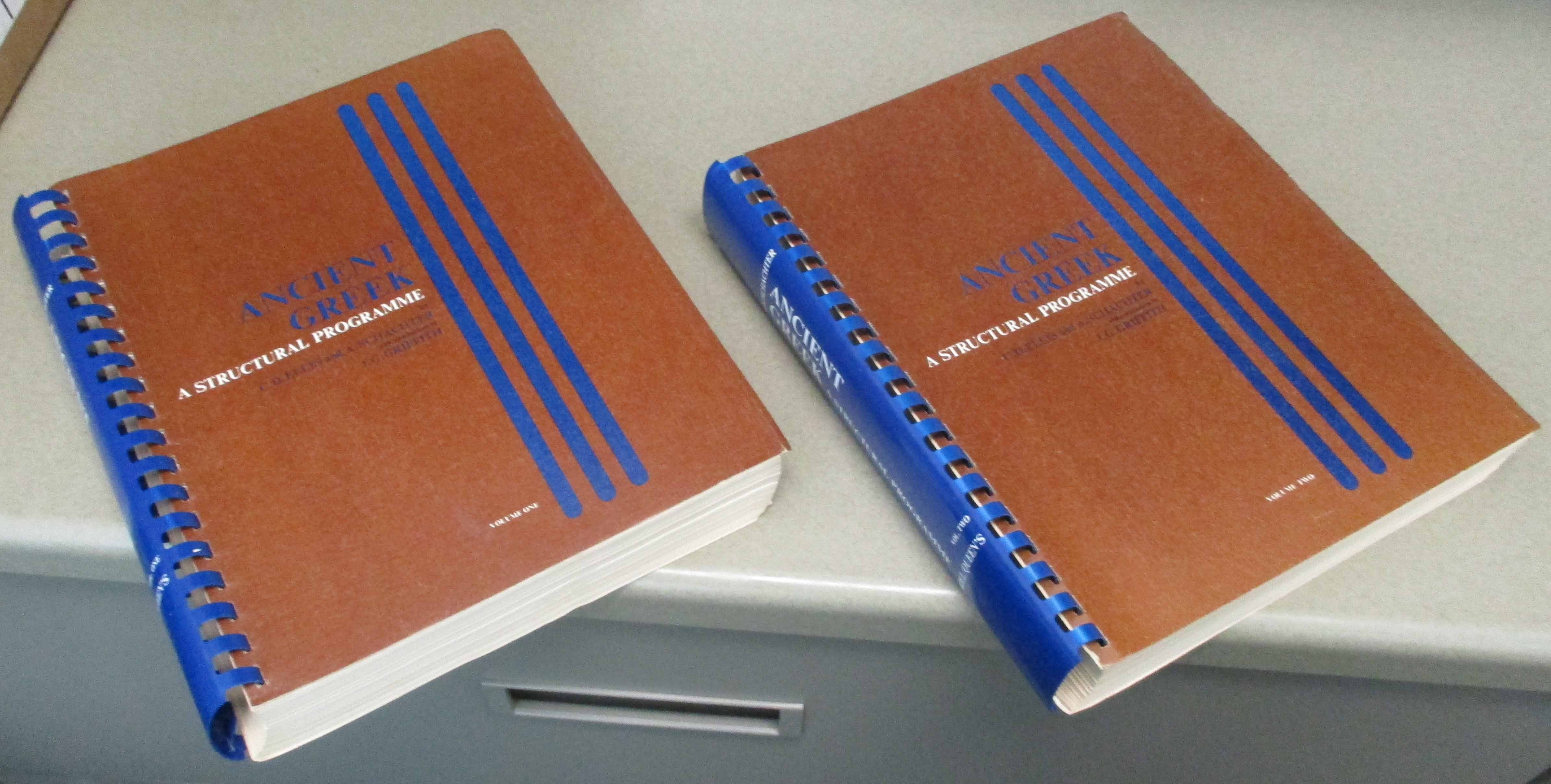

Also in 1969, Clarence
Douglas Ellis,
Albert Schachter, and
John Godfrey Griffith
(1913–1991) issued Ancient Greek: A Structural Programme through McGill-Queen’s University Press,
as 1,400 or so loose unnumbered pages with a free teacher’s manual and
50 reel-to-reel language-lab audiotapes
or 50 (not 57) audiocassettes.
The instructors taught Attic Greek
as a spoken language, though, as most scholars do, they put the emPHASis on the wrong syLLABle.
|
NOTE ADDED ON TUESDAY, 26 JANUARY 2021:
Amazing things have happened.
The two students’ volumes are now available for download, for a $75 each volume, from
dés Libris.
The first volume is available for free download here.
The Teacher’s
Manual is nowhere to be found, though.
The tapes, which nobody in the entire world could find,
which the authors, the publisher, the universities, the language labs, and all the libraries discarded,
were recently rediscovered and they have been uploaded to
Archive.org.
The tapes have degraded terribly since the 1970’s, alas.
It is Professor Schachter’s voice on those degraded tapes,
and he does not merely raise the pitch of the acute vowel, he stresses it as well, and that is so wrong.
This is the same mistake that Assimil makes, as do numerous other scholars.
Yes, a few acute accents really do get a stress — single-syllable words such as
τίς, for instance —
but they are the exceptions.
Bill Rouse was absolutely right when he placed the extremely mild stress outside the acute syllables.
Again, listen to the way Rouse pronounced the following words:
ϑέλω,
χέω,
ϑάλασσα,
κόβᾱλος,
ὀπαδός,
κάμῑνος,
φλυᾱρίᾱ,
Μαῖα,
λέγει,
Τροῖα,
ἡμετέρη.
For those eleven words, and only for those eleven words, he was almost right.
Despite the fault with the tapes, Ellis/Schachter is still a good course.
I had quit it in heartbroken despair when I reached page 111,
Unit Three Section E, Griffith’s first “Composition Exercise,”
because it was far, far, far, far beyond my level of competence.
Now, though, the same professor who discovered the tapes also discovered the answer keys to Section E!
And he sent them to me!
If I can get permission, I’ll post them. Let us see.
Here is a recent bulletin posting about the Ellis/Schachter course and its rediscovery:
Textkit Greek and Latin Forums.
|
As I went through Unit One, I was genuinely surprised to find information I was not expecting, information that contradicts most other texts.
Ellis/Schachter (1A, 7.2, p. 11) follow Friedrich Blass in maintaining that ζ is indeed zd,
except in those words derived from a dy sound that later shifted to dz.
That is almost certainly close to the truth, though there were undoubtedly exceptions from one village to the next.
Where, oh where, is a dictionary that supplies the archaic forms of the words?
Without such a dictionary, I have no way of distinguishing one from the other.
Unfortunately, the difference is not marked in the Ellis/Schachter text,
but illustrated only on the tapes. Fiddlesticks!!!!!
Oh. Here we go. All I had to do was type into Google:
“δι becomes ζ.”
There it was, right in front of me.
That is how I learned about John Peile’s An Introduction to Greek and Latin Etymology, 3rd ed. (London: Macmillan and Co., 1875),
which, in turn, introduced me to
Georg Curtius’s Principles of Greek Etymology, tr. by Augustus Samuel Wilkins and Edwin Bourdieu England (London: John Murray, 1875),
vol. 2, pp. 249–269.
This gets a bit more complicated than Ellis/Schachter or Blass let on,
as there was more at play than the mere difference between zd and dz.
Apparently, as I vaguely suspected, there was once a j sound in Greek,
j as in jam, jelly, Georgine, Jeremiad, Jumpin’ Jehosaphat, Jumpin’ Jive.
For want of an alternative, this was written as ζ and the sound evolved to dz, at least in some dialects.
I’m on the verge of convincing myself that in some dialects the sound remained a j.
Commenting on one particular set of contradictory evidence, Curtius adjudges:
“M. Schmidt Ztschr. XII 217 justly
recognizes in these different forms only different attempts
to express one sound, which defied exact expression through
the medium of the Greek alphabet.”
Oh, that puts a smile on your face, yes?
Ζ=dz in the following words, together, of course, with their related forms
(there are redundancies because Curtius had redundancies, and who am I to go against him?):
| Verbs ending in -αζω | Ζάκανϑα | ζητητῶν | κυανόπεζα |
| Verbs ending in -ιζω | Ζάκανϑος | ζητούντων | |
| ἀγαπάζω | ζακόπεια | ζητόρων | ληΐζομαι |
| Ἀϑήναζε | Ζακόσιοι | ζητρεῖον | λιϑάζω |
| ἀποικίζειν | ζάκοτος | ζητρός | |
| ἀεκάζομαι | ζαχρηής | ζία | μιγάζομαι |
| ἀργυρόπεζα | Ζάκυνϑος | ζίεται | Μουνυχίαζε |
| ἀριζήλη | ζάκυρος | ζίζυφον | |
| ἀρίζηλοι | Ζάλευκος | ζοέσϑω | νεμεσίζω |
| ἀρίζηλος | ζαμενής | Ζόννυξος | |
| ἀρπάζω | Ζαντός | ζοσέσϑω | Ὀλυμπίαζε |
| αὐλίζομαι | ζάπεδον | ζούσϑω | ὀπίζομαι |
| Ἀφίδναζε | ζαπληϑής | Ζυγ | |
| ζάπλουτος | ζυγόν | παίζω | |
| βήσαζε | Ζάς | Ζύγρα | πεζός |
| βιάζω | ζατρεφής | ζύμη | πειράζω |
| ζάχολος | ζωμός | πλάζω | |
| δειπνίζω | ζάχρυσος | ζῶμα | πολίζω |
| δίζημαι | ζάω | ζώνη | πρωιζός |
| δίζομαι | ζᾱωεκέως | ζώννυμι | |
| δίζω | ζεά | ζωννύναι | ῥέζω |
| δίζημαι | ζειά | ζωννύσϑω | |
| δικάζω | ζειαί | ζώπυρος | σχάζει |
| δοκάζω | ζείδωρος | ζῶσαν | σχίζω |
| ζείω | ζωστήρ | ||
| ἕζομαι | Ζευ | τοξάζεσϑαι | |
| ἔραζε | ζεύγνυμι | Θήβαζε | τράπεζα |
| ἐρίζω | Ζεύς | Θριῶζε | Τροιζήν |
| ἐταιρίζομαι | ζέω | ϑύραζε | Τροιζήνη |
| Ζη | Τροιζήνιοι | ||
| ζά | ζῆλον | ἱππάζεσϑαι | |
| ζαβάλλειν | ζημία | ὑβρίζω | |
| ζάβατος | Ζῆν | κακίζω | |
| ζάδηλος | Ζῆνα | καπνίζω | χάλαζα |
| ζάγκλη | ζητεῖν | καλήζω | χαμᾶζε |
| ζάγκλον | ζητεῖται | κάρζα | χέζω |
| ζάει | ζητέω | κιϑαρίζω | χϑιζός |
| ζαελεξάμαν | ζητητόρων | κνυζᾶν | |
| ζάϑεος | κρίζειν |
Despite my minor gripes, this course looks so good that I’ll forgive it.
I’ll even forgive it the fill-in-the-blank exercises.
As with Harper & Waters’s An Inductive Greek Method, this Ellis/Schachter course is intensely challenging.
It plunges you straight into Plato’s Euthyphron and Xenophon’s Symposium, one tiny little bit at a time,
and drills, drills, drills, drills, drills, for pages and pages and pages and pages,
line by line, word by word, phrase by phrase, with numerous spoken exercises.
It’s not the easiest way to learn, not by a long shot, and it is not for the faint of heart, but I think it should prove effective.
It’s very much like the old FSI courses, except that what would be Lesson 51 in FSI is Lesson 1 in Ellis/Schachter.
It’s possible to learn from this, though. It can be done. Really.
Here is an excerpt from a negative review by an instructor who had taught from the Ellis/Schachter/Griffith course for two years.
Edward Phinney,
“Ellis & Schachter: Two Years After,” The Classical Journal vol. 67 no.3, February–March 1972,
pp. 254–258 :
|
The authors, I assume, thought that they
were saving the hardest till last. A good idea
in principle, but actually they had deprived
students of varied reading material for eight
months, and then, at the moment when students
became most bored, Ellis & Schachter
overwhelmed them, not only with too many
tenses at once, but also with an avalanche of
irregular verb-forms. To my mind, the hardest
part of knowing ancient Greek is remembering
the plethora of irregular
In summary, I will say that Ellis & Schachter
is a good elementary text, but badly paced
and organized. Because it comes in
|
Perhaps the first edition was different from the second edition that I hold in my hands. Yes, it is true that many verb forms are delayed until the second half of the course, but the second half of the course has well over 400 pages of practice with those irregulars. So, I doubt it would be as horrendous as Phinney suggests. It is true that this does not appear to be the most exciting course on earth. Then, of course, neither was Ollendorff. It does appear to be the most thorough course on Classical Greek, certainly.
Fortunately, Phinney includes a footnote at the end that provides us a clue about the validity of the accompanying language-lab tapes.
Professor Phinney here refers to himself in the third person:
|
The tapes accompanying Ellis & Schachter
teach pitch-accent: high tones for acutes, low
tones for graves, combined tones for circumflexes.
In the classroom, pitch-modulation enriched the
sound of the Greek language and made it easier
for students to remember by ear the proper
placing of accent-marks. But the tapes, like all
drill-tapes, were heartless. The teacher, I hope,
knew when to stop drills, change them, or use
them in a game. The teacher could laugh with
the student when the drills seemed slightly silly.
The teacher knew which drills the students could
skip. The tape knew nothing. If we let it, it
talked on and on.
|
Here is the opening from a positive review (badly OCR’d)
by
Louis
Gerard
Kelly,
as
published in
Echos du monde classique: Classical News and Views (University of Toronto), vol. XV no. 1,
January 1971, pp. 41–42 :
|
BOOK REVIEWS /
COMPTES RENDUS — ANCIENT GREEK: A STRUCTURAL APPROACH by C. D. Ellis and A. Schachter, with contributions by J. G. Griffith. Montréal, 1970. pp. 1400 (approx.). Obtainable from the McGill University Bookstore. $7.50. Tapes for copying (fee $25.00) and Teacher’s Manual (free) from A. Schachter, Dept. of Classics, McGill U., Montréal.
Structural approaches to the learning of foreign languages are now commonplace and the course under consideration is a good example of the type.
In its present form it includes a teacher’s manual and thirty learning units backed up by supplementary material (including language laboratory tapes)
which summarize the accidence and syntax of the language.
Though the pupils’ material is in cyclostyled form, it is attractive, well set out
and, within the limits imposed by the nature of the course, very comprehensive.
The course aims are clearly set out for both teacher and pupil.
The key concept from the foreword of the teacher’s manual is that of “firm operating control”.
As defined, it has two facets, that of immediate recognition of Greek as a language
and unhesitating use of the resources of Greek when asked to write or speak.
In a very real sense, the authors of this course aim at producing Greek-English bilinguals.
The implications of the aim are as one might expect.
The first is the use of formal grammar as a consolidation tool, instead of as an introduction to concepts of structure.
Thus each unit and
It is at once intriguing and gratifying to see the question of accentuation taken as a basic resource of the language
instead of as a series of arbitrary rules
The gradation of the course is good.
It can be assumed that most beginners in Greek will have had some introduction to Latin, but the authors have preferred to take nothing for granted:
a wise precaution considering the present state of classical studies.
In any case the mechanisms of flexion often need revision, and always adaptation to the exigencies of a new language.
The second implication is the
Thirdly, stylistic considerations are postponed.
The choice of texts, Plato and Xenophon, is meant to lay the basis for later stylistic development.
This sort of underhand conditioning is essential at the early stage of learning a language,
especially in a rhetorically oriented tradition like that of the classical languages.
Yet, as the authors point out in reply to comment F on poetry,
one must not overload the pupils at this early stage by stylistic considerations,
or by exceptions occasioned by dialect or genres of
From my own point of view, that of a person who sees bilingual behaviour as the ultimate end of even the classics classroom,
this is a linguistically excellent enterprise.
I would have liked to see more emphasis on the cultural aspects of Classical Greece concomitant with language learning.
However, the course is flexible enough to allow an enterprising teacher to add this.
Likewise, both teacher and pupil have the utmost liberty in varying the pace of the course to fit pupil needs.
I see no gaps in this course, nor are there any....
|
Nor are there any what? The online fragment leaves off right there. I can’t find any library anywhere that has this particular issue.
Modern Discovery # 2
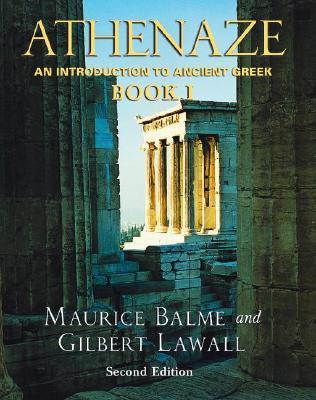



We now also have the Oxford course by
Maurice Balme and Gilbert Lawall, Athenaze: An Introduction to Ancient Greek Book I, second edition and
Athenaze: An Introduction to Ancient Greek, Book II, second edition (2003) —
(Ἀϑήναζε = to Athens).
Here is a recommendation from the “Introduction”:
“For demonstration of the restored pronunciation, including the pitch accents, students should consult the cassette recording of Stephen G. Daitz,
The Pronunciation and Reading of Ancient Greek: A Practical Guide, 2nd ed., 1984, Audio Forum, Guilford, CT 06437 (U.S.A.).”
No! Scream! Rant! Rage! Fury! No! Have mercy! Please!
This course originally came with audio recordings. Forget about them. The first one is (was) on
YouTube
and I quit listening after three seconds because the narrator horribly mispronounced
Ἀϑήναζε.
That’s not the restored pronunciation, despite the claim of being such.
It is an atrocious mangling that no ancient Greek would have recognized as Greek.
Laughably bad, but I have no energy to laugh anymore.
On YouTube you can find other people reading aloud from this book.
Oh, don’t even go there.
Someday I’ll do my own recordings. Someday.
Apart from the horrid demonstrations of pronunciation, this course is pretty cute.
The single drawback in the first lessons is the inadequate explanation of
οὖν,
γάρ,
δέ.
A student could understand these easily enough when they appear in the text,
but if asked to employ them in original sentences during class exercise, the poor student would be flummoxed.
This leads to a correlative problem:
The learning is a bit too passive.
Students will be able to follow along, but assured competence with speaking and writing won’t happen.
Other texts are needed for that.
Nonetheless, it’s a really cute course, from what I have seen so far.
More importantly, it led to something better:
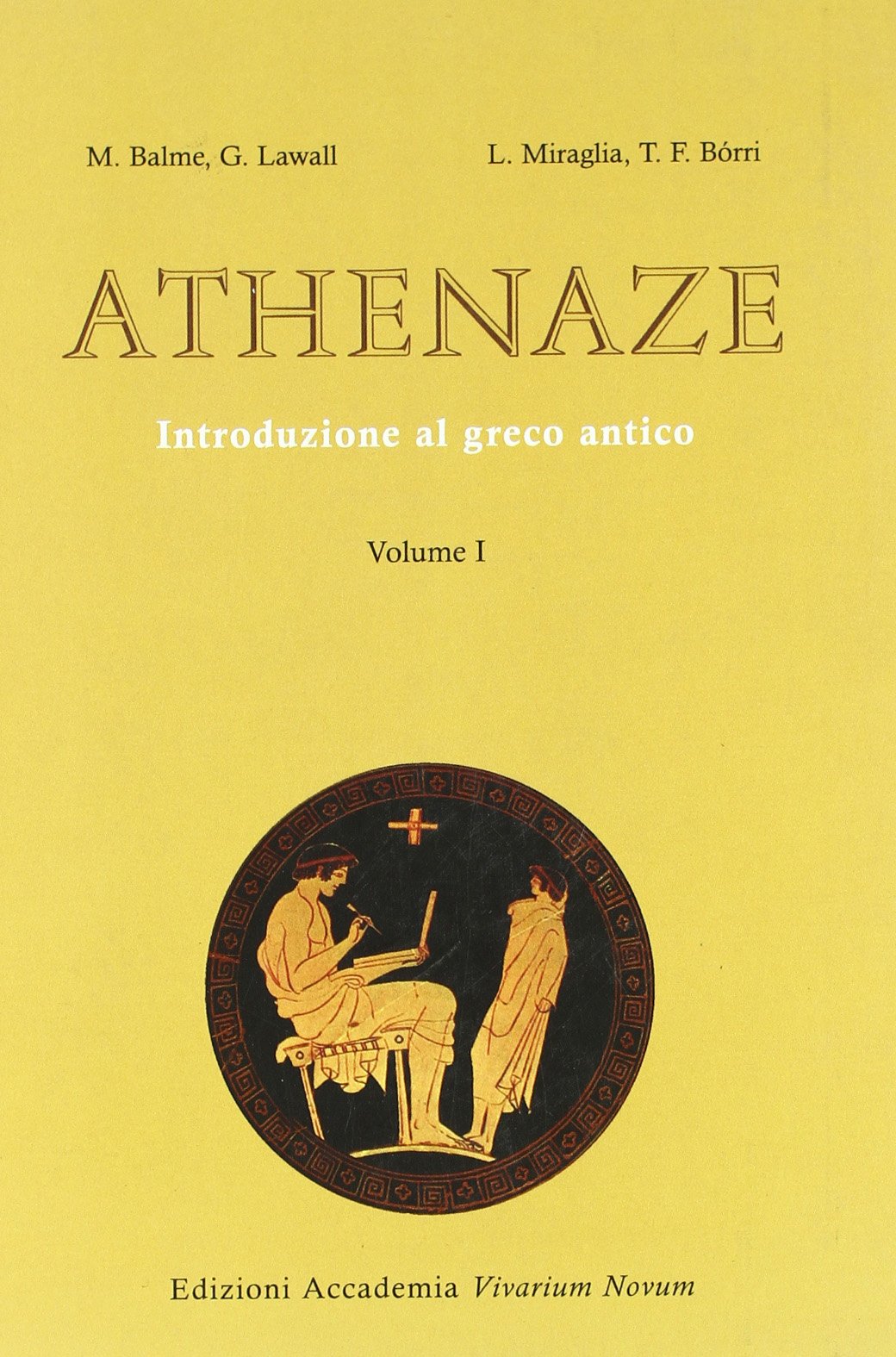
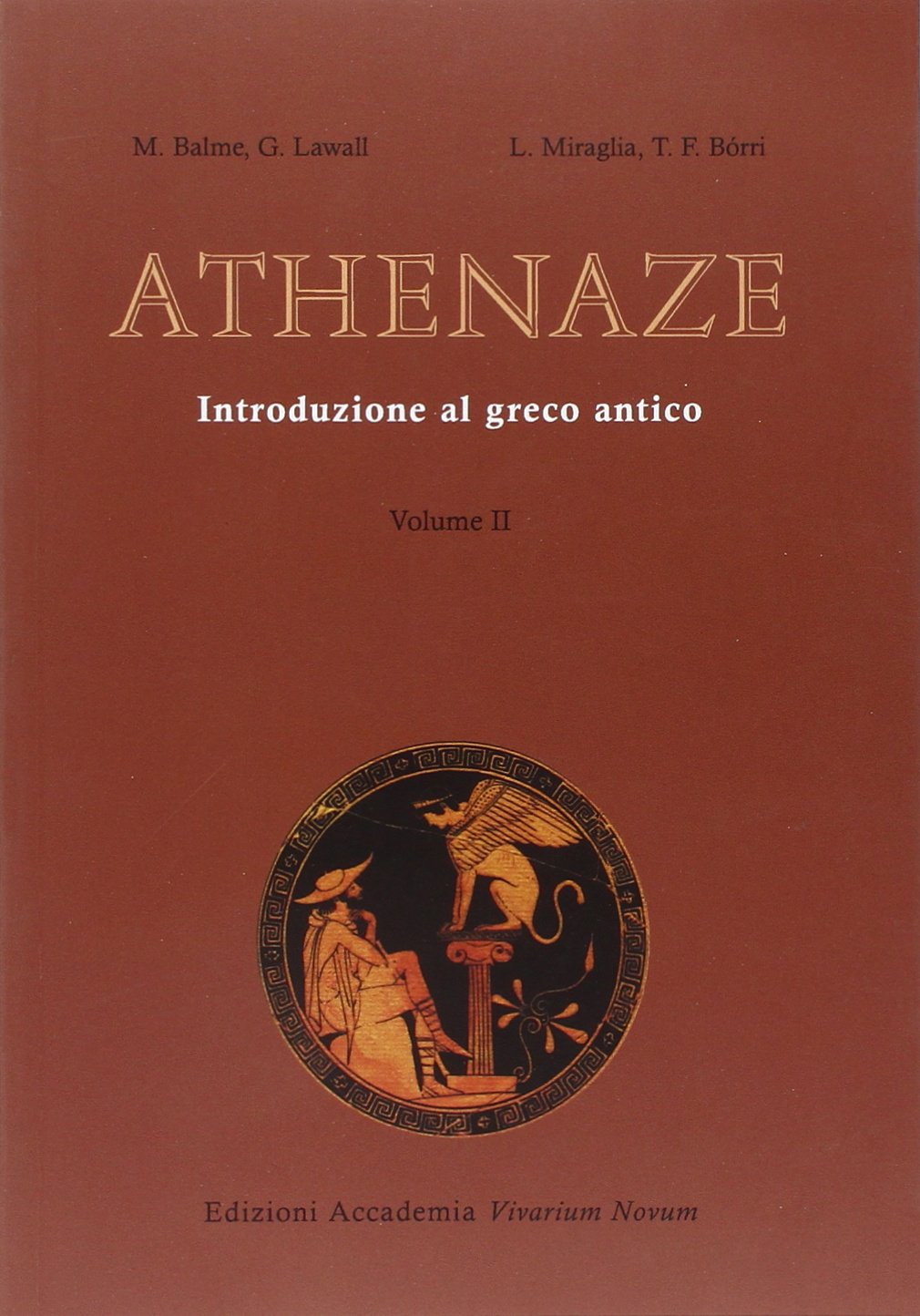
The Balme/Lawall course was significantly improved by Luigi Miraglia and Tommaso Francesco Bórri for the Italian edition,
available only
here and
here.
Once I complete Kendrick’s pseudo-Ollendorff,
I’ll start on Miraglia/Bórri’s too, merging it with Ellis/Schachter.
It looks really nice.
It’s the only course still in print that, to my eyes, looks really nice and easily approachable.
It’s the only course still in print that follows pretty much the same system as Father Most,
whose method in turn closely resembled that of Jean Manesca (of whom more below).
Miraglia/Bórri’s course is not as good, but it’s still better than many other courses.
Miraglia/Bórri borrowed the cartoon format used by
Arthur M. Jensen in the 1930’s,
but, alas, they rid themselves of the endless repetitions in ever-varying wordings,
which was Jensen’s powerful tool (and Manesca’s, and Most’s).
Oxford’s course requires explication in English, and it has copious vocabulary lists,
whereas Jensen had ingeniously worked out ways to make vocabulary lists unnecessary.
Miraglia/Bórri add only a hint of the Jensen method.
The problem is how to purchase this course.
I ordered both volumes from Italian Amazon back in about July 2018, but only the second volume arrived.
So, in September I ordered another copy of the first volume from an eBay-Italy vendor,
and then heard nothing until mid-November when I got a message that it was just mailed, and no tracking number was provided.
This can be extremely frustrating.
Yes, you should order it, but you should be prepared to be swindled, and you should also be prepared to wait forever and a day.
The first volume eventually arrived, too many months later, but at least it arrived.
CORRECTION: Oh. Never mind. Forget Amazon and eBay.
I just learned that the publisher seems still to sell this course: Volume One and Volume Two. Go for it.
Other Modern Courses,
Inferior to the Two Above
Inferior to the Two Above
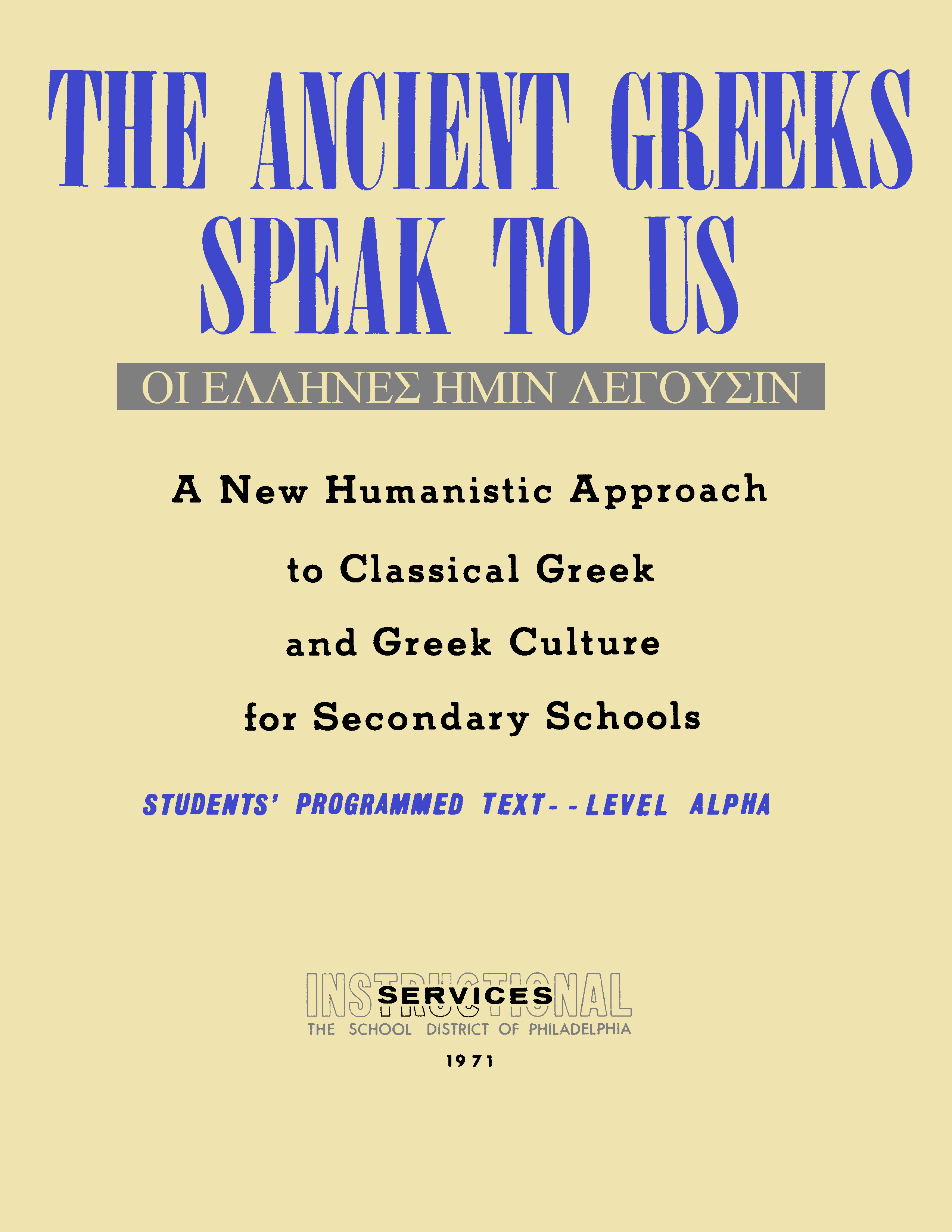
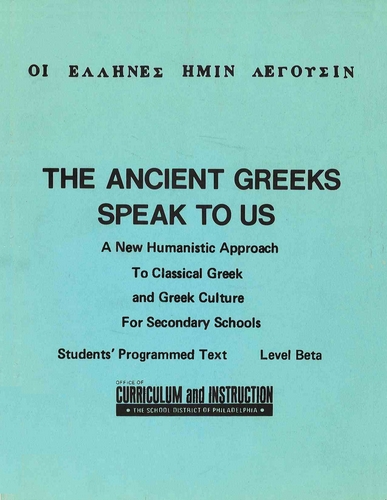
When I bumped into this on the Internet, my mouth began watering.
No longer.
I just received the second volume on Interlibrary Loan, and it is terribly disappointing.
First, though, let’s tell the story.
In 1969 the School District of Philadelphia, Pennsylvania, developed a course of spoken Classical Greek for junior-high students.
This was principally under the guiding hand of Rudolph Masciantonio,
and the promising title was The Ancient Greeks Speak to Us,
Οἱ
Ἕλληνες
Ἡμῖν
Λέγουσιν: A New Humanistic Approach to Classical Greek and Greek Culture for Secondary Schools.
Others involved in the creation of this course were
I. Ezra Staples and
Eleanor L. Sandstrom
(see also this).
There were other contributors as well, and they all seem to have moved on to the great hereafter.
The course consisted of “Visual Cues,”
along with “Tapes to Accompany the Student Programmed Texts” as well as “Supplementary Tapes.”
Where are the tapes? Do they still exist?
Unfortunately, the teachers simply stressed the syllables that carried written pitch accents.
“Tonal treatment of accents should not be attempted in view of the difficulties inherent in such treatment and in view of the scholarly uncertainties on it.”
Aaaarrrgggghhhh.
What difficulties? What uncertainties?
Anybody who has heard a mere two unrelated pitch languages demonstrated by native speakers
would recognize exactly how Classical Greek was pronounced, without difficulty, without uncertainty, without doubts:
Cree,
Punjabi
(or more explicitly here if you skip ahead to 11:47),
Cherokee,
and especially Japanese — the list goes on— though each has its differences,
would offer sufficient guidance to reconstruct the Greek pronunciation exactly.
Even Navajo, despite its differences, offers us a close analogy to Classical Greek.
The pitch pronunciation is not in any way at all like what you hear in
this instructional video, which ain’t even close, not even a little bit;
nor is it in any way at all like what you hear in this other instructional video, either.
¡Ay chihuahua!
I am so mellow and laid-back and easy-going ,
but when I hear these recordings, my temper bursts into such roaring flames that the neighbors call 911.
Oh well.... Nobody’s ever gonna listen to little ol’ me.
Someday, someday, someday, when I get a bit better at this, I’ll record some demonstrations and post them here.
Not now, though. Please not now.
|
By the way, pay attention to an anomaly in the Punjabi video by Harjeet Singh Gill.
(Judging by his name, he’s probably a billionth cousin a trillion times removed.)
He writes some words on a blackboard, contrasting the Punjabi words with their close Hindi equivalents:
Watch that video a few times, and you will see what’s crazy about it.
The professor sees nothing wrong, because he’s blind and deaf to the contradiction.
Though the grave accent is written over the first vowel in
pā̀ī,
tòbī,
čā̀ṛu,
kòṛa,
we can clearly hear the professor pronounce the grave over the final vowel.
In the Hindi column, there is no written accent, and so the professor does not hear that he is pronouncing the final vowel in each word with an acute.
Is that bizarre? No, that is not bizarre at all.
We are guilty of the same.
There are English speakers who swear that “all” and “awl” are pronounced entirely differently,
or that “fair” and “fare” are pronounced differently,
or “peddle” and “pedal,” or “coarse” and “course,” and will go to great pains to demonstrate clearly,
perplexed that the listener cannot detect the nonexistent difference.
English speakers also tend to believe adamantly that they are pronouncing a long o in “provider” when in fact they are pronouncing a schwa:
prəvidər.
From what I’m learning of Classical Greek, though, this cannot be the case.
The written accents are exact.
Aristophanes of Byzantium (or whoever it really was), well, bless his little heart.
|
The surviving texts of the Philadelphia junior-high course are of little help in reconstructing what went on in class,
nor are they any help in learning the language.
There were two “Student Programmed Texts” —
Level Alpha and
Level Beta (not yet online),
as well as a “Teacher’s Guide” for
Level Alpha and
Level Beta.
This course was never formally published, and the printed portions of the course are just parameters, not instruction.
As the Teacher’s Guide explains, “It utilizes additional multisensory materials available from commercial publishers.”
What might those have been?
The “Teacher’s Guide” for Level Alpha goes on to state its mission, which reads, in part:
|
The course outlined in this curriculum guide is a radical departure from the traditional approach to the teaching of Classical Greek in the following respects:
|
Sounds nice, yes?
So, this proves that there are still people, even teachers, who have a fluent speaking knowledge of Attic Greek.
I learned about this course only on 6 August 2018, and so I immediately Googled Rudy Masciantonio, only to discover
this.
I missed him by just two years.
He is briefly quoted in this loveliest of articles:
Victoria Balfour,
“Latin Is Alive and Well in Grade School,” The New York Times, 9 January 1983.
Where were these teachers when I was in school?
So, since this description sounds so promising, why am I disappointed?
The reason is disheartening.
The second volume, Students’ Programmed Text, Level Beta, proves, definitively, that Greek was seldom used in the classroom.
This was a history course, as basic as could possibly be, in which literary excerpts were taught only in English translation.
There are a few Greek words sprinkled here and there, as well as a few paradigms.
The translations are occasionally paralleled with snippets from the Greek originals, but the students were never meant to read those Greek originals.
They were there, mostly, as a tease, in the hopes that the students would develop sufficient interest to pursue their study in later years.
Did even one of those students pursue this line of study?
You don’t need to be a shrink or a psychic to know the answer: Not a chance.
Others involved in creating this course:
Mrs. Helen Gizelis, Teacher of Classical and Modern Greek and World History, Arsakeion High School, Psychicon, Athens, Greece.;
Dr. James T. McDonough Jr., Associate Professor of Classics, St. Joseph’s College, Philadelphia, Pa;
Mrs. Elissa Wantuch Sklaroff, Teacher of Latin, Lower Merlon High School, Ardmore, Pa.;
Dr. Walter Frieman, Professor of Classical Languages, West Chester State College, West Chester, Pa;
Dr. Vincent J. Cleary, Associate Professor of Classics, Ohio State University, Columbus, Ohio;
Mrs. Allison Pyle, Elementary School Teacher, Willingboro Public Schools, Willingboro, N.J.;
Dr. Cordelia Birch, Professor of Classics, Chairman of the High School Greek Committee of the Pennsylvania Classical Association, Geneva College, Beaver Falls, Pa.;
Alfred Chapman, Teacher of Latin and Greek, Episcopal Academy, Philadelphia, Pa.;
Brother Lance Strittmatter, T. O.R.,Teacher of Greek and Latin, St. Francis Seminary, Loretto, Pa.;
Dr. Philip T. Heesen, Associate Professor of Classics, Millersville State College, Millersville, Pa.;
Dr. J. Hilton Turner (19 April 1918 – 2 October 2013), Professor of Classics, Westminster College, New Wilmington, PA.
Those are our clues.
Perhaps some descendants would have more materials, tapes, teachers’ logs, something.
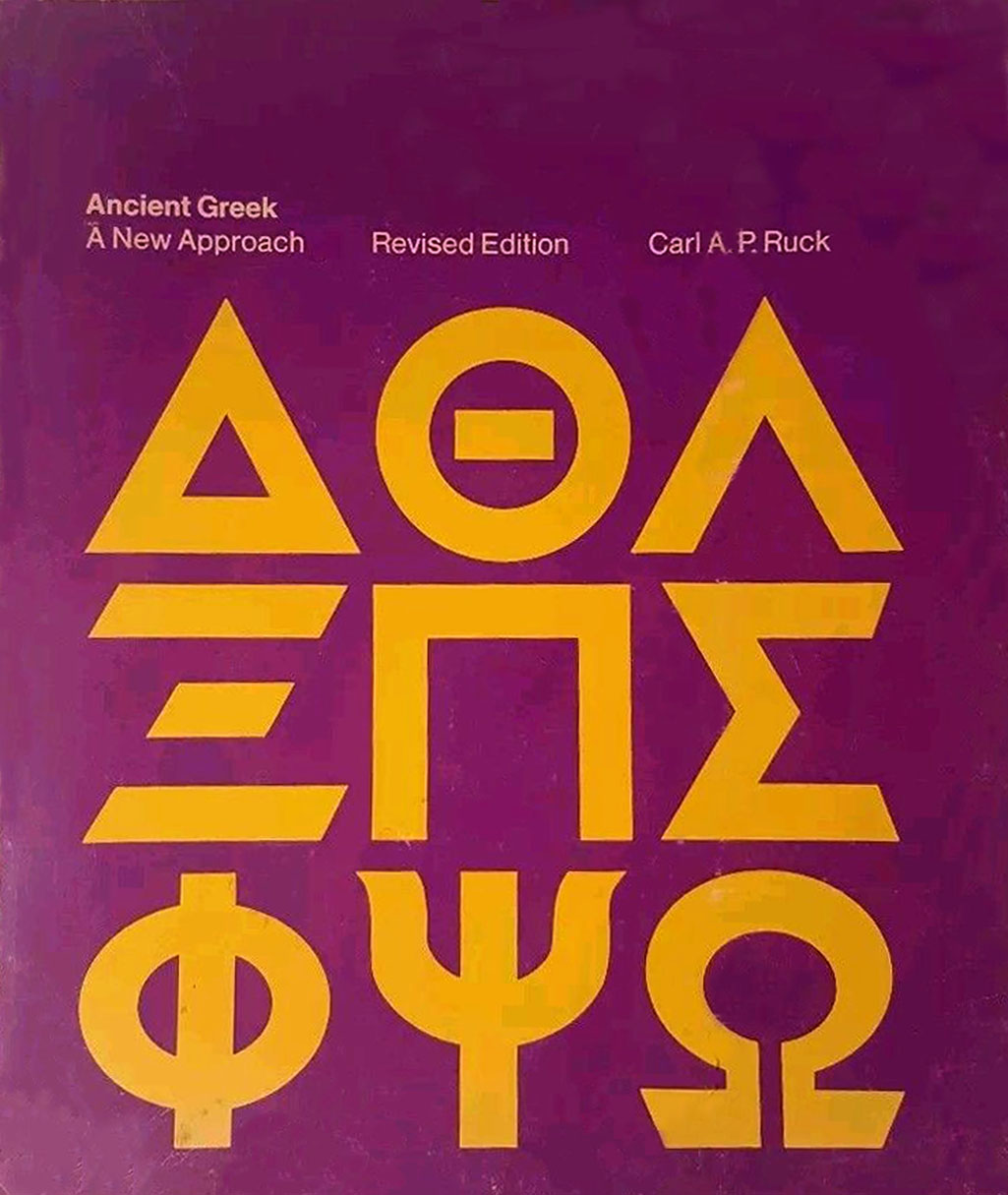
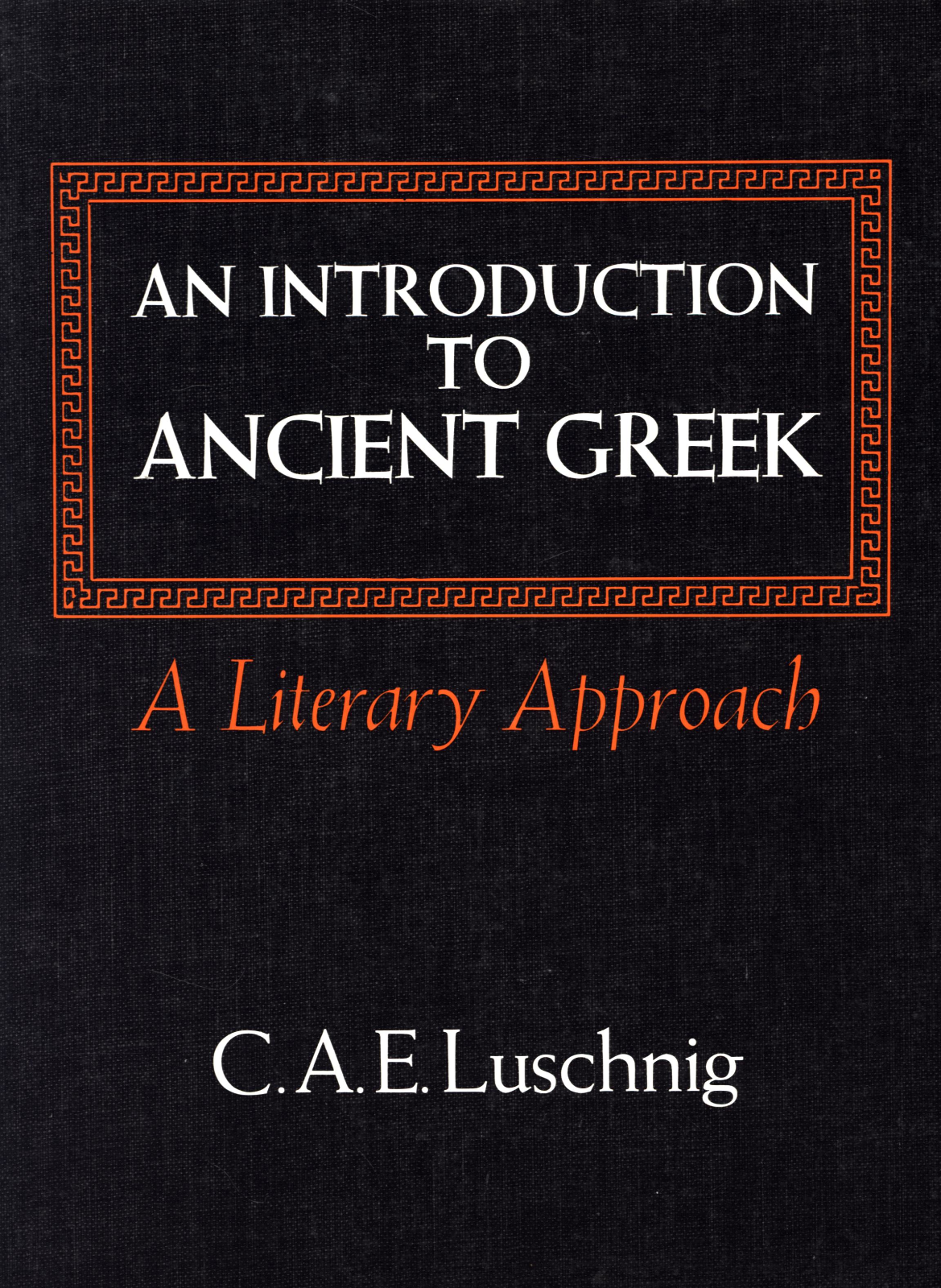
At UNM’s Zimmerman Library, decades ago, I saw a library-rebound oversized volume on the shelf
that promised to teach Classical Greek somewhat more intuitively.
My memory was playing tricks on me.
My memory conflated Ruck’s book with Luschnig’s book, and turned them into a single book.
My memory took a paragraph on page 13 of Luschnig’s book, exaggerated it,
and then made it refer to the opening of the Gospel according to John,
printed in Luschnig page 51 and in Ruck page 9.
(Why are scholars so obsessed with that opening verse? It leaves me cold.)
|
About the readings: It is not expected that the student will ‘get’
everything in these early readings on his own. Many hints have to be provided
and references made to pages of the English text where the point has been
treated. But the readings from the ancient authors should be read not once
only, but again and again, as more information comes under the student’s control.
These selections from Dionysius were chosen to impress on the student’s
mind certain grammatical points, and to give them the respectability of age.
They were chosen too because they were felt by the author to be interesting
and amusing: the student may soon come to believe that a grammarian’s sense
of fun is somehow distorted.
|
It/these looked good, but it/they demanded an instructor.
It/they could not be used for self-study , at least not easily.
I remember it/them giving me migraines.
My heavens, it takes Luschnig 48 pages of grammar lessons before we get to our first exercise!
Granted, her explanations of grammar are admirably clear and easy to understand,
infinitely superior to other such explanations,
but she has so much explanation that, by the time we get to the first exercise on page 49,
we are deeply intimidated and ready to drop of fatigue.
Her book is good, no doubt, but it is brutally difficult.
I don’t think she realizes that.
She probably thinks her book is easy as pie. Nope.
It’s torture.
OCTOBER 2018: I just went to Zimmerman again, where I was surprised that I had completely forgotten something:
Along the walls of the modern staircase are illustrations of ancient writing on stone,
including examples of Phoenician.
So, I looked through the shelves, and a ha!!!! there it was!!!! except that it wasn’t.
The rebound cover is just like I remembered.
The size is just like I remembered.
The typography is just like I remembered.
The title sounded right.
Yet, because I had almost entirely misremembered the paragraph quoted above,
I could not find what I was looking for.
Besides, I was looking at the wrong book: Carl Anton Paul Ruck Junior’s Ancient Greek: A New Approach, 2nd ed. (MIT, 1972).
Yes, I had apparently looked through that book as well, back sometime around 1980, and I must have checked it out.
There is a misprint near the beginning that I was startled to see crossed out with a black Bic pen and corrected in my own handwriting.
So, I must have begun to use this book, but I can see now that I would had given up in hopeless despair,
and, looking at it anew, I am probably right to guess that it was page 53 that killed it for me.
If I were an instructor, I would never lob that at a student.
I would break it into about 35 parts and drill extensively on each part, and then and only then would I give the full passage to the students.
Also, he has endless technobabbly gobbledygook that would frighten any mere mortal away.
Instead of saying that genitive usually means “of” and sometimes means “some,”
Ruck says something different:
“An adjective, as you know, qualifies a noun; it is adnominal.
The second example in each of the preceding pairs has substituted a noun
in this adnominal function to supply the same kind of information.
The noun in this adnominal function is signaled by a declensional suffix:
it is in the genitive case, the case that allows a noun to function as an adjective.”
I probably burst out in tears when I first read that some forty years ago.
Then there is too little practice. Way too little practice.
The intention was to have students achieve fluency by guided in-class conversation, but the execution was marred, to put it mildly.
Ruck’s book came with language-lab audiotapes, but there was a problem: “It is admittedly difficult for the student to learn these accents —
nor is it the most important task in the introductory stage of learning the language.”
¡Ay chihuahua!
Now, there is a gal at work who got curious when I received a book of Classical Greek in the mail.
She is not highly educated at all.
She wanted to know what the words sounded like, and so I read a little bit to her.
She could mimic me faultlessly.
She got the pitch and meter perfect, without even realizing she was doing it.
And she spoke the Greek words without an American accent.
When a book on the archæological finds in the Cyclades arrived, she asked how to pronounce Cyclades.
So I gave her the English pronunciation, the Modern Greek pronunciation, and the Classical Greek pronunciation.
She mimicked them all perfectly. PERFECTLY. No problem. She got the pitch perfect, and all the sounds, minus an American accent,
and she didn’t even realize that she was speaking Modern Greek and Classical Greek without an American accent,
nor did she realize that she spoke the Classical Greek version of the word with pitch.
But she did.
So much for the difficulty.
Then Ruck did things that were so right.
For instance, he beautifully explained the accusative, especially for those nouns in which the accusative has the same form as the nominative.
Lovely explanation. Puts students at ease. A goodly amount of practice.
Then, once the students feel relaxed and confident in this knowledge, he needlessly tosses out an explanation:
“The accusative neuter singular form of Type III nouns is signaled by an absence of any declensional suffix....”
It was going so well until then.
The explanation, entirely redundant, does not help, but only makes the students nervous again.
“What does that mean? Didn’t we know that already? Did I miss something?”
In Ruck’s subsequent second edition, still in print, he entirely gave up on the idea of fluency,
and instead decided to have students translate. His second edition is less than half the size of his first, and it is nothing special at all.
It seems to me that when the students of his first edition had too many difficulties in gaining fluency,
instead of fixing the problems, he just gave it up as a lost cause.
Terrible pity.
He was on to something really special, and didn’t even realize how close he was to perfection.
All he needed to do was break the lessons into component parts, one form at a time, not two, not three, not twelve,
and then quadruple the number of drills, not fill-in-the-blanks and not write-a-free-composition, but Greek questions and Greek answers,
and change-a-word-and-recast-the-sentence.
Had he done that, he would have revolutionized the teaching of Greek.
I was taken aback to discover, almost next door to Ruck’s book,
Cecelia Anne Eaton Luschnig’s Introduction to Ancient Greek: A Literary Approach (NY: Charles Scribner’s Sons, 1975),
which physically looked almost the same as Ruck’s book, as it, too, had been rebound by the library.
(I detest library rebindings, since they destroy the original covers.)
So, I wondered: Had I not noticed this before?
I had noticed it, and I had begun reading it, but had given up in despair.
Luschnig’s method is reading comprehension, minus fluency or conversation.
Luschnig (revised edition, 2007): “Stephen G. Daitz offers helpful suggestions in
The Pronunciation & Reading of Ancient Greek: A Practical Guide with accompanying tapes.
It is recommended that this be available in the library or language laboratory
and that the use of pitch accents be encouraged from the beginning.”
What can I say?
Yes, pitch should be used from the first moment that students enter the classroom door,
but, as we know, Daitz did not use the pitch accent.
He used a bizarre and nearly inhuman series of squeals of his own invention,
and somehow convinced himself that this was how the ancient Greeks spoke.
I am stunned (no, I am not stunned, really) that scholars the world over did not laugh this “reconstruction” out of existence.
I see that my memory fused the two books together.
Anyway, I got that out of my system.
Why do I bring this up? Just as an object lesson about trusting our memories.
Like I say, memory is the illusion that we can recall the past.
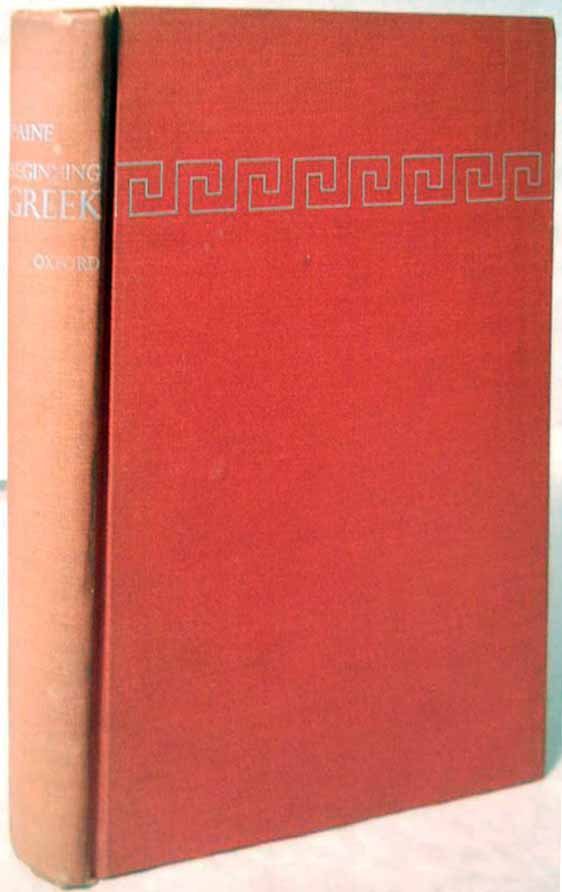
For years I was trying to remember the title, and then the above Ellis/Schachter title jogged my memory.
Unfortunately, it jogged a false memory.
That false memory induced me to place an order for
Stephen W. Paine’s
Beginning Greek: A Functional Approach (Oxford University Press, 1961).
Not what I was looking for, but it looks pretty promising, all the same.
It has rules for writing the accents, but no explanation of what they mean.


A course that seems promising is four-volume work once published by the Jesuit Educational Association.
Would a Jesuit publishing house, and presumably Jesuit authors, be as good as Father Wm. G. Most?
I wanted to find out.
Stephen V. Duffy (ca. 1918 – 20 March 2009).
Stephen V. Duffy’s The Way to Greek: A Lesson Grammar of Elementary Greek (1953, 1957),
Stephen V. Duffy’s Xenophon’s Anabasis (1951, 1958),
The Odyssey:
Selected Readings (1953, 1957, 1960, 1962; only 83 pages), and
Raymond York’s The Odyssey Handbook: A Companion to Selected Readings of the Odyssey (1953, 1957).
It looks a bit like T.K. Arnold’s course, though simpler, rather solid, but with exercises that few students would find absorbing,
all stuff about military manœuvers and whatnot.
When it comes to the spoken language, this course is especially defeatist (p. 4):
|
There are two schools of thought on pronunciation
methods for students of classical Greek.
One follows modern Greek, and places the stress on
the accented syllable. The other tries to recapture
quantity values, and places the stress on
the penult if it is long, or on the antepenult if
the penult is short.
Both methods, however, are in complete agreement
on one point, namely that it is impossible for
us to do justice to both the pitch and the quantity
values of the ancient pronunciation.
|
Oh, for heaven’s sake. Hire a Navajo!

What’s more, I found this too: Ari Feuer,
“It’s All Greek to Me:
Language Club Adapts to New Schedule,” The Lion’s Tale: The Student Newspaper of the Charles E. Smith Jewish Day School,
28 November 2016:
|
Down the science corridor lies a classroom that on Wednesday afternoons is the site of curiosity at work.
Under the guidance of science teacher Nick Miller, four freshmen learn how to read and speak classical Greek....
Each class, Miller tries to teach a section of vocabulary and a section of grammar,
both of which he gets from “A First Greek Book” by C.T. Ruddick Jr.
The students learn to read Greek sentences, pronounce letters and words correctly and translate between English and Greek.
The translation can be difficult as the structures of Greek and English are different, but Miller said that the students pick it up “well.”
|
Sigh. Some kids get all the breaks. C.T. Ruddick, Jr.’s, First Greek Book, huh?
So, who is this C.T. Ruddick, Jr.?
I was not familiar with his book, and could find no descriptions anywhere.
Copyrighted in
1966.
The 1970 second edition is held at
Baylor U,
Concordia Theological Seminary,
U Tennessee,
Oberlin College,
UNC–Chapel Hill,
Bryn Mawr,
City College,
Queens College, and the
U of South Africa.
The 1972 second edition is held at
U Missouri and at
Gordon-Conwell Theological Seminary.
The 1977 second edition is held at
Cincinnati Christian U.
I found one and only one copy for sale, the 1974 printing, and ordered it right away.
Why did this so intrigue me? Three reasons:
First, Nick Miller uses it for the high-school club, and he insists on correct pronunciation (though I have no clue what his correct pronunciation is).
Second, since he gets the kids to speak Greek, I thought his choice of Ruddick’s text, in preference to a text still in print, probably meant something special.
Third, it is typed and comb bound, and as such it reminded me of Father Most’s typed and spiral-bound Latin course. Hmmmmmmmm.
Then it arrived. Not so hot. It’s okay as an outline that a teacher could employ as a departure point.
A good teacher could work wonders.
Indeed, in his preface Ruddick writes, “The exercises marked ‘practice’ are intended to at least suggest the sort of oral drill
which is so essential to the rapid and effective learning of any language.”
The text is mostly in English, there’s minimal practice, and there’s barely any vocabulary, a mere 600 words or so.
He has no explanation of the pitch.
Not for self-learners.
Oh well. So much for that.
Yet I learn more.
There is a course called the IDYLL METHOD,
short for Institute for Dynamic Language Learning.
Among the courses that “the language doctor” Klaus Bung could theoretically offer is “Greek (Classical).”
Dr. Bung’s method is conversational. Hooray.
I also discover that there is a
Professor Juan Coderch who, as a help to students of Classical Greek,
offers random news stories translated into Attic Greek:
Acropolis World News.
He also translates children’s books into Attic.
From all I can gather, he teaches in the target language at the University of St. Andrews in the UK.
So, hoping that Coderch’s published course would be similar to Father Most’s Latin course,
I ordered his grammar
and his workbook,
but, predictably, they are not for self-learners. They are not much different from the others — just charts, rules, and fill-in-the-blanks. Oh well.
Coderch: “...the way in which accents affected pronunciation remains unascertained;
the usual way to read them aloud is to raise the pitch of the syllable on which you find any accents.”
I guess it would be fun to take his class, but that’s hopelessly beyond my means.
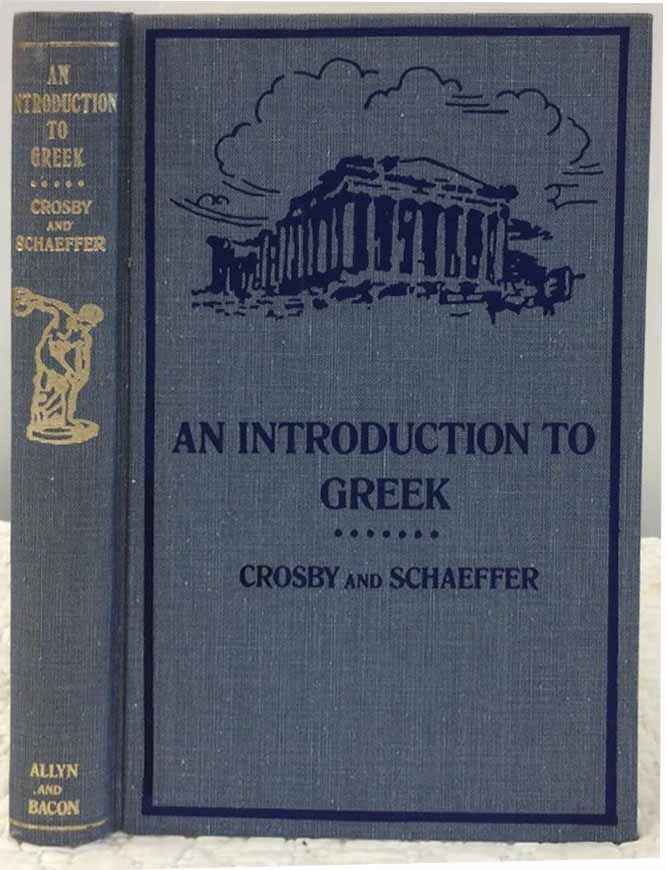
Henry Lamar Crosby and John Nevin Schaeffer’s
An Introduction to Greek (1928) is back in print,
and many teachers and students swear by it.
I’m looking through it right now.
The problem, as usual, is that there are so few exercises, and they are too short.
These two authors, like so many authors, were tremendously excited by the grammar and succeeded in making it seem a thousand times more intimidating than it really is.
This is such a common problem.
When a teacher teaches by numerous spoken examples,
and engages the students in conversation to illustrate the principles,
the grammar comes naturally, and the technical explanations, when later given, are simple and understood instantly, intuitively.
When, instead, the student is slammed with page upon page upon page of technical terms and parsing tables,
prior to any exposure to the actual examples, the result is catastrophe, as I witnessed in person in too many courses.
Crosby & Schaeffer saw no need for spoken comprehension, but only ability to translate on paper.
This is the same problem that I encountered in every language course I ever took, in high school, at university, and from private tutors,
who taught in English rather than in the target languages.
In a just world, this would be a capital offense.
Since Crosby & Schaeffer’s only concern was written translation, they cared nothing for pronunciation:
“There are three accents — acute (´) , grave (`), and
circumflex ( ͂ ). They do not affect the pronunciation....
Pronounce the Greek words of §§I–II,
stressing each syllable that bears an accent; then write in English letters.”
A talented teacher who could use the structure of this book to invent guided conversation would do well.
A teacher who simply assigns written homework based on the exercises will hand out a bunch of A’s and B’s
to a class of 30 or so students who will graduate from the course unable to understand a sentence of Greek.
From leafing through this volume, I would guess that a self-learner who spends many hours on each page,
doing the brief exercises an infinite number of times, aloud, with eyes closed, would profit thereby.
Well, the illustrations are nice; I won’t deny that. There are better courses.
Incidentally, as an illustration, and thank heaven not as an exercise,
Lesson One begins with the opening lines of the Gospel according to John.
Hmmmmmmmm. Was the computerized course I took in college based partly on Crosby & Schaeffer’s course?
Crosby & Schaeffer enjoy mixing koine with Attic, which I don’t think is a good idea at all.
I mean, if you want to teach your Albanian friend English, would you mix newspaper prose with Chaucer?
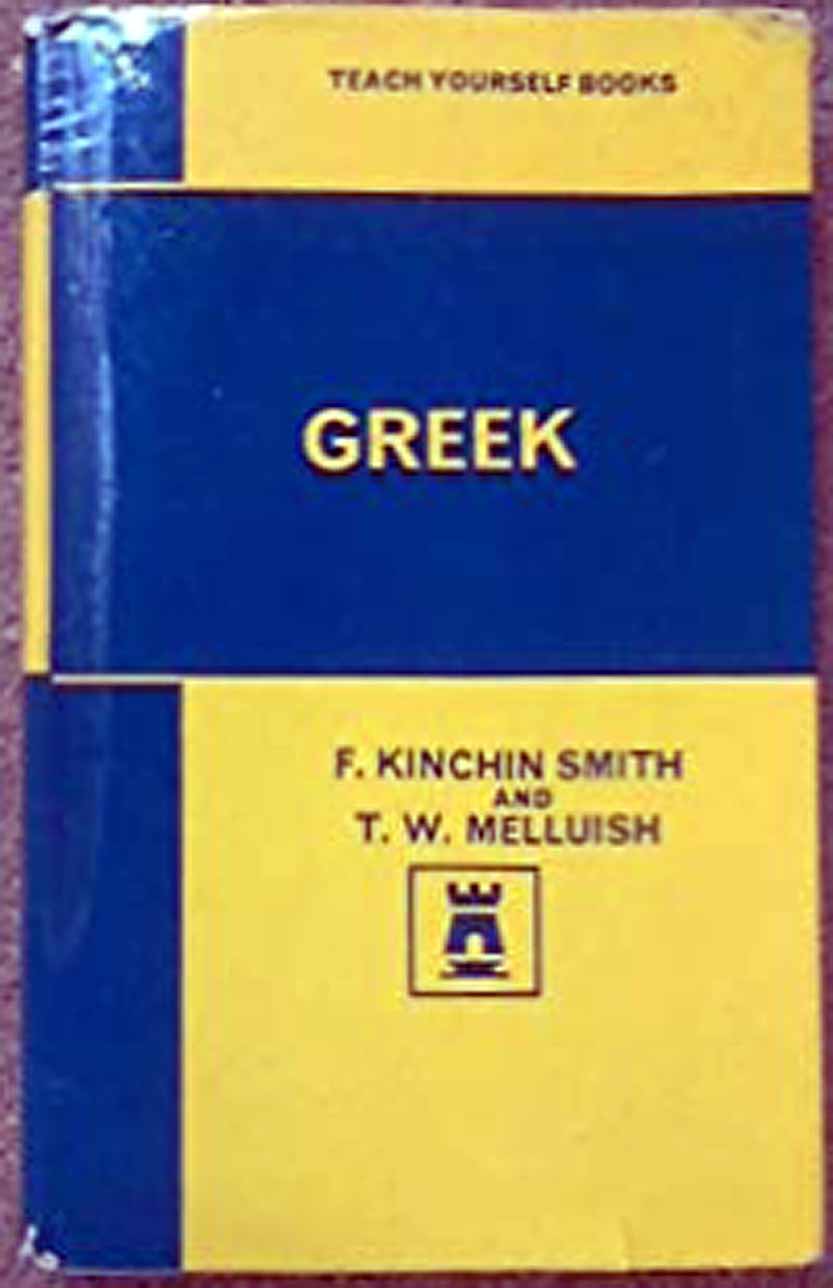
We should also consider the “Teach Yourself” series, so easily available.
Once upon a time, long long ago, I had a little book by
Francis John Kinchin-Smith and
Thomas William Melluish entitled
Teach Yourself Greek
(London: English Universities Press), first published in 1947 and continually in print through at least 1993.
(In some printings, the title page, Ancient Greek: A Foundation Course, disagrees with the generic series cover.)
I purchased it in some excitement, but, when I got home, I looked through it and quickly gave up.
Maybe someone who already speaks 15 languages would find this slightly helpful, but for dummies like me, no, there was nothing to grasp onto.
It deleted all diacritics save the breathings and subscripts.
It’s impossible to pronounce the words if you don’t know long vowels from short ones, and if you don’t know which pitch goes where.
Yes, the ancient Greeks could do it, but only because they learned the spoken language when they were babies.
They didn’t need the diacritics. They didn’t, but we do.
Nonetheless, Kinchin-Smith and Melluish:
Accents. — If you have seen Greek written elsewhere,
you will be surprised at this book, because
Greek is here written without accents. This has
been done deliberately. The writing of accents on
Greek is a conservative tradition from which we
might with advantage break away. The ancient
Greeks themselves never wrote them. They are said
to be the invention of a grammarian named Aristophanes
of Byzantium (260 B.C.)
who wanted to guide
his readers in the reading of Homer. Accents do not
appear in manuscripts before the seventh century
A.D.
The Greek language, however, is quite intelligible
without accents. Sappho and Plato did
not need them. We may well be rid of an unnecessary burden. |
Following this logic, we may similarly choose to teach foreigners English through writing only, and without any aids to pronunciation.
We could justify this decision by arguing that since native-born English speakers do not need pronunciation aids, foreign learners have no need of them either.
In truth, Kinchin-Smith and Melluish would have had a good point in making this argument,
provided that the language were to be taught orally, but they were opposed to that as well!
I just ordered another copy of the book, for the heck of it. The back cover brings back memories, and brings shivers to my spine:
This book provides a totally original
approach to the language for the many
readers who feel repelled by the tedium
and austerity of the traditional Greek
course.
Believing that most students wish to
read, and not to write, Greek, the
authors include no translation from
English into Greek; instead, the
essential grammar and vocabulary are
illustrated with simple passages of
authentic Greek. The close connection
between English and Greek is stressed,
and the reader should finish the book
with a sufficient understanding of the
language to approach the wealth of the
ancient Greek literature with confidence
and enjoyment.
|
My heavens! Let’s break that down, shall we?
Yes, the “traditional Greek course” was a horror to behold.
It was six hundred pages or so of paradigm tables to be memorized,
together with several thousand rules to be memorized, by name.
Mixed into this atrocity was a vanishingly small amount of practice, at best, and it was all written, never spoken.
The “traditional” course was a work of austerity, indeed!
It was good to get away from this.
Yet these authors choose to get away from this basically by reducing the practice even further.
As for students wishing to read the Classics without the bother of learning enough of the language to use it, we can make another analogy.
Suppose your Albanian friend insists upon learning only enough English to read Shakespeare’s Sonnets, and nothing else.
Your Albanian friend wants to know nothing about how to speak the language, or converse in it, or use it in any way, except to read Shakespeare’s Sonnets.
As we all know, that is an impossible goal.
We learn to use the language first, and then, and only then, do we slowly move towards more difficult works such as Shakespeare’s Sonnets.
Suppose your Albanian friend insists, further, that he has no interest whatever in knowing how to pronounce any of the words,
and steadfastly refuses to learn, being satisfied simply with knowing how they look on the printed page.
This, of course, would be preposterous.
Even a deaf person would need to know at least how to mouth the words to get a sense of the rhythm.
Words on a page, minus the sounds, convey nothing.
The same applies to Classical Greek.
First, we need to know how to say Hi. We need to know how to ask What’s for breakfast?
We need to be able to shout out that we are in the back by the well, not in the barn.
It is not until after we are comfortable with these basics that we can move on to Aristophanes.
Frankie and Tommy had Ph.D.’s, which I lack, and shall continue to lack, deliberately, and largely for this very reason.
The two professors saw no need for fluency, but only for bare-bones translation skills.
I should not have been surprised to discover that the book has its fans,
and at least one gal went so far as to say that it changed her life.
I, too, confess that I thoroughly enjoyed the little comic strip included in Chapter XXII on “Prepositions.”
It is wonderful, and a beautiful teaching tool.
If only the whole book had been constructed along such lines, it would have been a gem.
Alas, the rest of the book provides endless paradigm tables and lots of rules, devoid of any clues about how to pronounce even a single word.
I enjoy Martin Bernal’s memory, published in
Geography of a Life (XLibris, 2012):
“The academic guide was a splendid drunken classicist F. Kinchin Smith.”
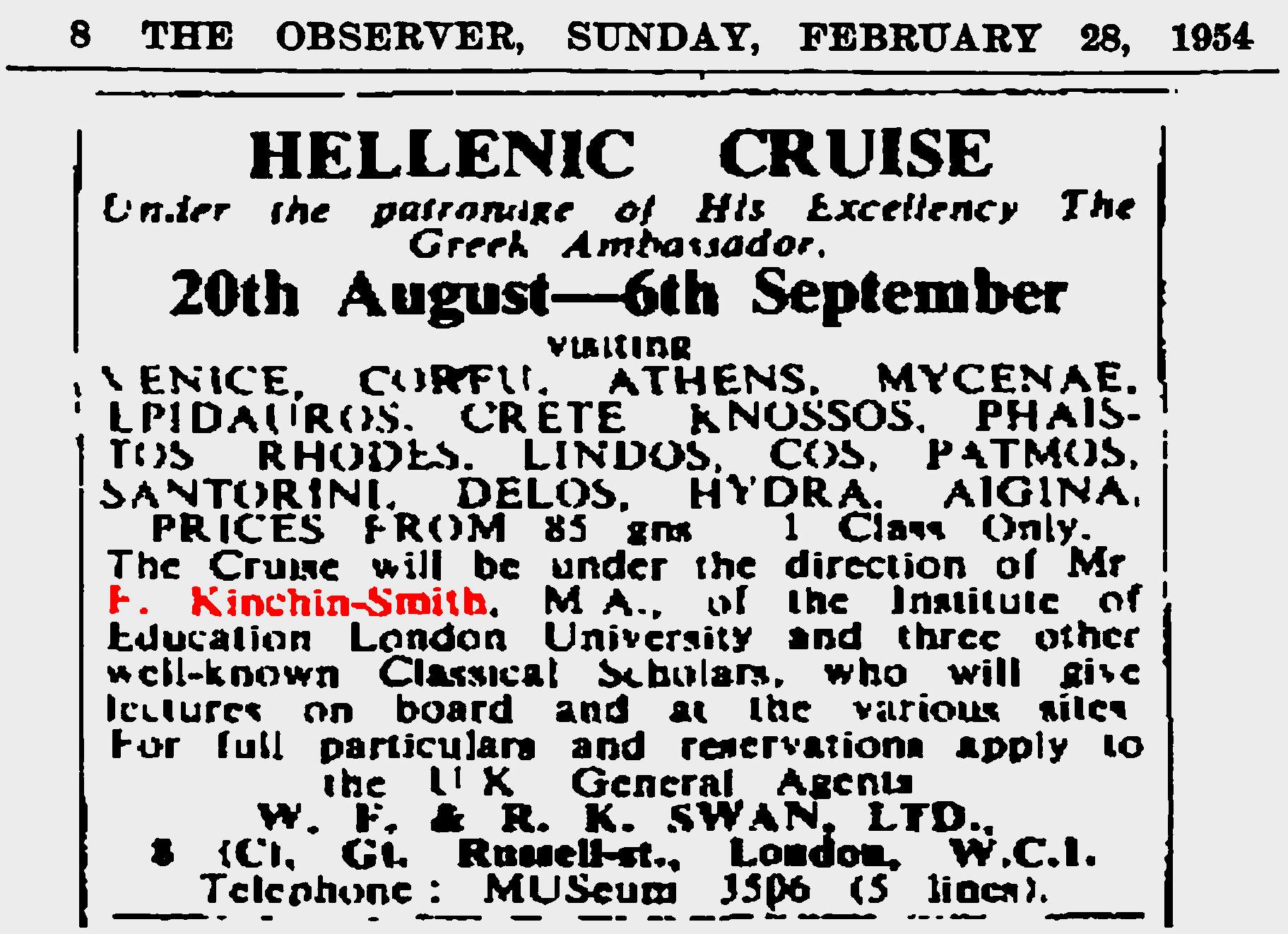
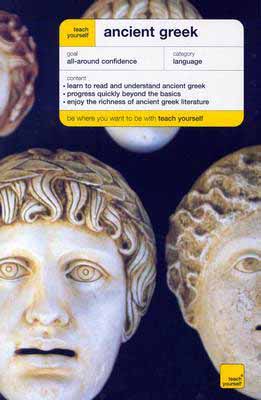
By the 1990’s Kinchin-Smith/Melluish’s slender volume was justly out of print, and its copyright was not renewed.
Before letting it go out of print, the publisher in 1989 offered a replacement volume entitled
Teach Yourself Ancient Greek,
this one authored by Gavin Betts and Alan Henry (London: Hodder; NY: McGraw-Hill), slightly longer, and this time with all the diacritics.
It’s about on par with Crosby & Schaeffer’s Introduction.
If you’re already intimately familiar with grammatical terms and parsing tables from having studied other languages, yes, this will do some good.
At least it has 36 little practice stories — very little.
Read each sentence a few dozen times aloud, memorize each story, and then recite it multiple times until it’s about as easy as English.
Recite each reading, every day, without looking at the printed text.
If you do that, I suppose this course would work, I guess, maybe, but my heavens, if this is your introduction to language study, you may well give up in despondency and despair.
You’ll drown in technobabble before you can grasp onto the twig-sized narrative life raft.
Nonetheless, this is definitely an improvement — a vast improvement over Kinchin-Smith/Melluish,
and a vast improvement over nearly every previous schoolbook on ancient Greek.
For no reason I can discern, Betts and Henry prefer the lunate Ϲ and ϲ to the more ancient Σ and the medieval σ and ς.
Yes, some ancients used the lunate Ϲ, but such use in a modern introductory text would serve only to confuse students after they graduate and pick up real Greek texts.
This is by no means a major criticism, but only the smallest one — not a big issue, but merely a minor irritation.
Betts and Henry offer a defense of their choice, but not a compelling defense, and in more recent years they abandoned this practice at the urging of their students.
Betts and Henry see no need for spoken mastery, and discourage any attempt at proper pronunciation:
“For purposes of pronouncing Greek words, each of the three accents should be treated alike and given a simple stress accent as in English.”
Yech, yuck, ew, icky! Still, though, a creative teacher could put this text to use as the basis for a spoken course.

Another “Teach Yourself” title was by a missionary named Donald Foster Hudson,
who in 1960 complemented Kinchin-Smith/Melluish’s Attic course with a vanishingly brief volume devoted to the Common Greek of early Christian times,
Teach Yourself New Testament Greek.
In this volume, he committed the same sins.
I should point out that he objected to the “Direct Method,”
but only because he had not the foggiest idea what it was!
His defense of the charts/rules method, devoid of conversation, was based on a straw man:
For the last thirty or forty years there has been a lot of
argument about the method of teaching languages and
much has been said in favour of the “Direct Method”.
It is argued (and rightly) that the natural way to learn a
language is the way by which a child learns its mother-tongue —
by picking up the names of things, and by imitation.
What is often forgotten is that no child is really
fluent in its mother-tongue, which it hears spoken around
it all the time, until it is in its teens. If, therefore, you can
spend ten or a dozen years in an environment in which the
language is spoken all the time, you can depend solely on
the Direct Method! With Hellenistic Greek the question
of environment is somewhat difficult until Mr. H. G. Wells’
Time-machine becomes a reality, and in any case no one
wants to spend ten or a dozen years learning it. Nor is it
necessary, for the adult has powers of reasoning and |
Hudson also copied the Kinchin-Smith/Melluish excuse, justifying it by a frightful admission:
Accents Printed Greek also has accents on words, ` ´ ͂ , but these were invented by a grammarian in the third century B.C. to help people read the poetry of Homer. They do not appear in manuscripts before the seventh century A.D., so if people managed to read the New Testament without them for five or six hundred years, we can probably do the same. In a few cases they distinguish words which have different meanings, but the differences can usually be inferred from the context. In some cases they are completely arbitrary, and the present writer confesses that after thirty years he is still shaky on accents! |
Completely arbitrary?
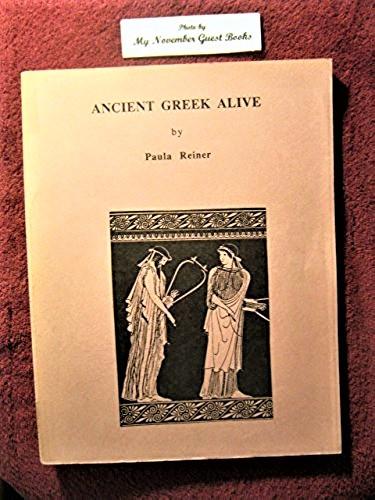
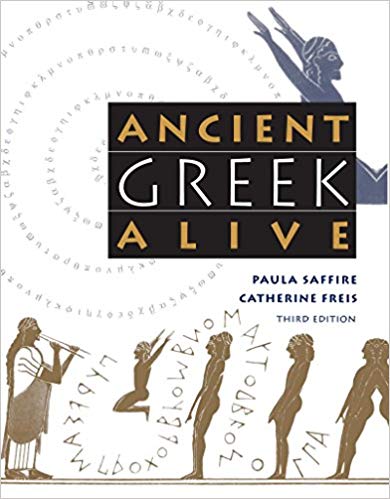
Leaving aside “Teach Yourself” and moving on to textbooks designed for university use, we now also have
Paula Saffire and Catherine Freis, Ancient Greek Alive (1999), a revision of Ancient Greek Alive (1992),
which itself was a revision of Beginning Ancient Greek (1972), published under Saffire’s earlier name, Reiner.
As with Athenaze, this is strictly for classroom use, not self-study.
The authors mention in their introduction that the students are without exception deeply disappointed when,
after the first two weeks, conversation is dropped in favor of written exercise.
The students all say that what they learned by conversation is what they remember best, not what they learned by written exercise.
If that’s the case (and how could it not be the case?), then why do the teachers drop conversation?
Why don’t they drop the written exercises instead?
The opening of the introduction hints that teachers could never be expected to exhibit such “boldness” as to make the spoken language come to life again.
Hey, that’s how students learn.
Teachers are supposed to push themselves to enable students to learn as best they can.
That’s a teacher’s job, yes?
That is the entire explanation, which should be okay, theoretically, since the first few lessons in class are spoken.
Of course, any scholars who argue that the grave indicates no change in pitch at all are hardly scholars.
If you are curious, you can hear Professor Freis read excerpts from her lessons at
Ancient Greek Alive.
Aaaaaarrrrgggghhh.
“There are three marks indicating pitch: |
(´) acute — pitch up ( ͂ ) circumflex — pitch up and back down (`) grave — slight rise in pitch (or no change at all, as some scholars believe).” |
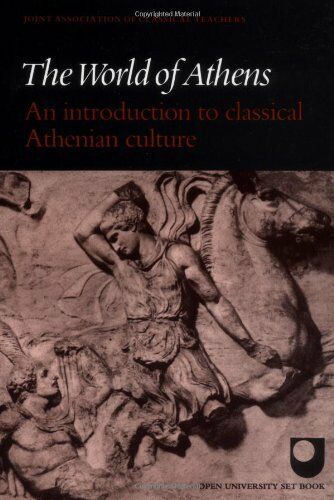
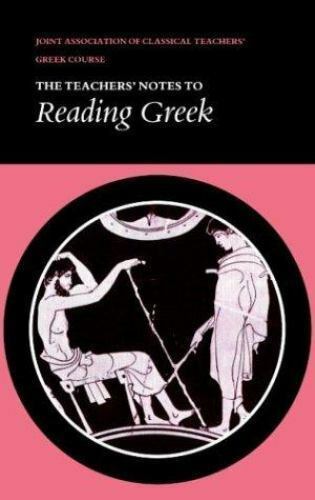

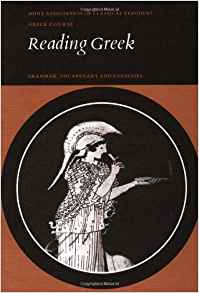
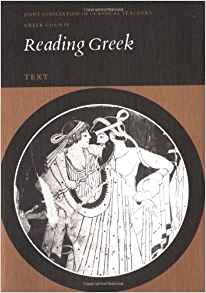



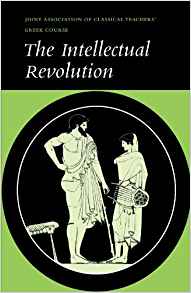
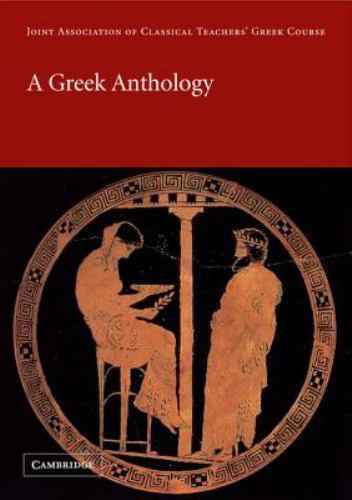
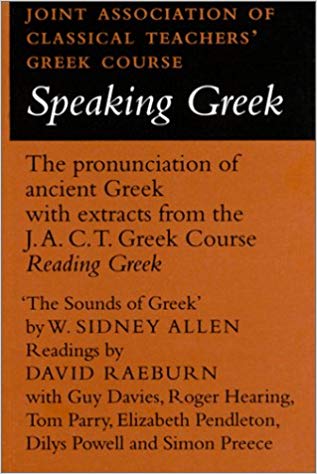
First editions above. Second revised editions below.
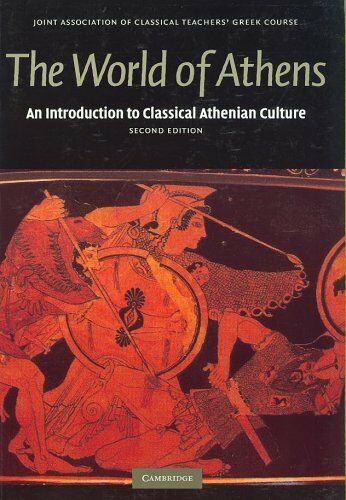
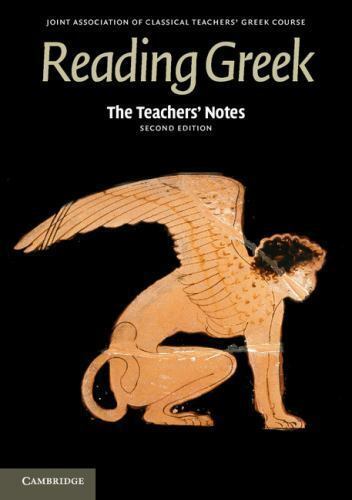


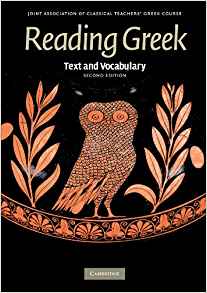
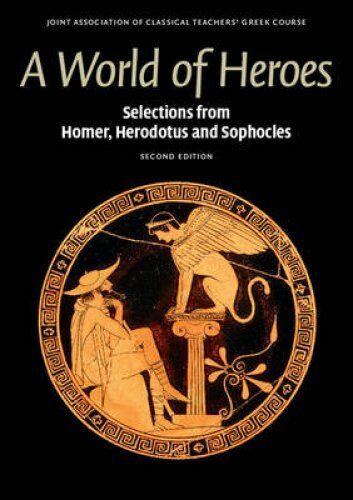
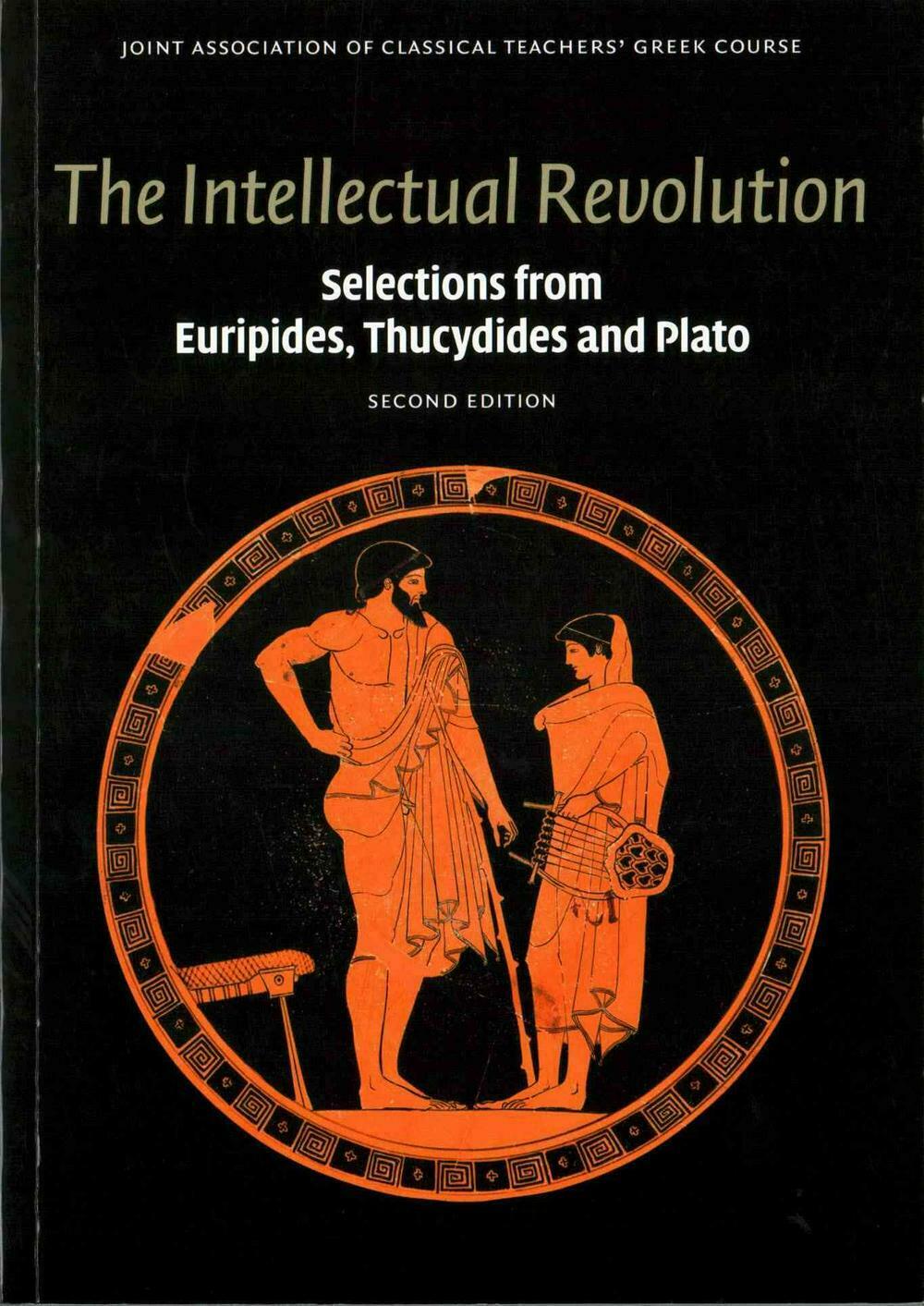

There is another new course that has some practical application, namely
Reading Greek, written collectively by the Joint Association of Classical Teachers, or JACT for short.
JACT is now defunct, and its remains have been folded into The Classical Association.
Reading Greek: Text and Vocabulary (2007),
Reading Greek: Grammar and Exercises (2007), and
An Independent Study Guide to Reading Greek (2008).
This multi-volume course is pretty good, though borderline impossible for students who have no background.
I decided that I would eventually give the first three volumes a try.
Shortly after I made that decision, I went to my favorite used-book shop and two of the initial three volumes were right there,
staring at me, whistling and pointing their thumbs at their dirt-cheap price tags.
I got the third on Amazon.
These volumes look good, but they are terribly cumbersome, awkward, burdensome, confusingly arranged.
It would require quite a bit of determination to make it through profitably.
A student who begins Greek study with this Reading Greek set may quickly give up in despair and agony, and then soon swear off the topic forever.
The grammar is disorganized and the vocabulary lists are overwhelming and intimidating.
I don’t think any new student could be expected to follow a narrative, no matter how simple, on the first day of class.
Simple conversations should come first, and narratives only a little bit later.
On the positive side, for students who have even a little bit of background, being tossed straight away into a Greek narrative can be refreshing.
Grammar is introduced piecemeal, only enough to guide you through each reading.
Depending on your educational background, that can be either a boon or a deal killer.
If you’re ready for the loads of vocabulary, then, since it is all incorporated into narratives, it is difficult to forget.
In that respect, this course is superior to Kendrick’s pseudo-Ollendorff ,
which has sentences rather than dialogues or stories.
It is also pretty much on par with Miraglia/Bórri’s Italian edition of Athenaze.
It is also similar to, but far less demanding than, Ellis/Schachter’s Structural course and Harper/Waters’s Inductive course.
There are further volumes in the series, consisting of selected readings from the Classics.
From what little I have experienced so far, I would say that, of all the courses currently in print,
Reading Greek and the Italian edition of Athenaze are the best, hands down.
(If my opinion changes, I’ll make that clear when the time comes.)
I just started Reading Greek. Not bad at all.
It’s a massive annoyance to have to juggle three volumes just to get through a single lesson, but that’s the price we need to pay, I guess.
Warning/confession: Had I not gotten a third of the way through Asahel Kendrick’s pseudo-Ollendorff ,
I think Reading Greek would have reduced me to tears.
Indeed, a reduction to tears appears to be a common result, as we learn from a blog conversation entitled
“Frustrated with JACT ‘Reading Greek,’”
Reddit r/Ancient Greek, 2017.
With Kendrick’s lessons in the background, though, this Reading Greek course is quite easy for me to follow — so far, anyway.
So, once again, I must say: Start with Kendrick. No other course will do.
Kendrick is the secret key that unlocks the door to the magical treasures inside Reading Greek.
Another count against this course is the accompanying recording, Speaking Greek,
which, I hear tell, has poor actors sometimes substituting stress for pitch and speaking with thick British accents.
The mere existence of that CD originally made me gravely suspicious of the course.
Here’s a sample that causes me apoplexy.
It would be difficult to make it more wrong.
Now, let’s look at one of the volumes, Reading Greek: The Teacher’s Notes (2nd ed., p. 6):
|
Choosing between the accents
Before the teacher can read the Greek aloud, he or she must choose between the
melodic accent, used before AD 300, and the dynamic accent, used later (and still
in modern Greek). The differences between these two accents are explained by
Professor Langslow in track 6 of his talk, ‘Pronouncing Ancient Greek’, on tracks
1–8 of the Speaking Greek CD which is sold with the RG Course. (See also the
written explanation of the two accents in Chapter 6, ‘Accent’, of W.S. Allen’s Vox
Graeca (2nd edn, Cambridge University Press, 1974).) Teacher and students alike
may hear the difference between the two accents by listening to track 8 of the CD.
By listening to these comparative readings, the listener will note that the
melodic accent, though it contributes to vivid performance, is difficult for
English speakers and demands considerable practice before perfected....
|
Shudder. If it’s difficult for English speakers, then it’s dead wrong.
There is nothing difficult about it, not even for English speakers, if it is done correctly.
Portions of the CD are posted on YouTube, presumably without permission.
One such is here,
and the massacre begins in earnest at 30:17. I did not make it past 30:20.
It was too much for me.
It sounded like a ten-year-old’s mockery of Chinese.
I’ve heard worse. I’ve heard much worse, yes, but oh Heavens to Betsy!
A major drawback of the first editions of the Reading Greek course (1970’s) is the refusal to differentiate
ᾰ from ᾱ, ῐ from ῑ, and ῠ from ῡ. Phooey!
The current edition (2000’s) corrects this oversight.
A high-school teacher who responded to this page pointed me to a YouTube video by Professor Joseph Conlon, which knocked the wind out of me:
You really need not scramble for the modern materials.
Ellis/Schachter, yes, get it if you can.
Miraglia/Bórri, yes, get it if you can.
Reading Greek, yes, if your bank account is large enough,
and if you can stand living your life as a Marx Brothers’ routine, yes, get it if you can.
Other than those, though, there’s no urgency.
The old public-domain materials available at the click of a mouse are quite excellent.
Stick with the free stuff — Kendrick’s
Child’s Book and
pseudo-Ollendorff ,
Beresford/Douglas,
Blackie,
Colson,
Morice,
supplemented with composition books, which you can find on Google Books.
The below books were designed for classroom use only.
They cannot be used for self-instruction.
The first-level courses, such as A First Greek Course, were designed for beginners.
“Beginners,” as you probably don’t know, were students who had already mastered
French and Latin, and often German and Sanskrit as well.
Back then to “master” meant to speak fluently, write eloquently, and compose verse easily.
Not until students had mastered those languages were they were considered “beginners.”
When you open a dictionary and look up the word “beginner,” it does not say
“beginner [bɪ-'gi-nər] noun :
a person who has thoroughly mastered spoken fluency and verse-composition skills in French and Latin,
and, often, German and Sanskrit as well. [early 14th century, in the sense of “founder, originator,” agent noun from begin;
first known use of present meaning is from the late 15th century].”
No, that’s not what it says at all. See how definitions change?
Teachers were expected to use the below books as guides
to help them organize their lectures, which were all given in Attic Greek, of course.
As you can see, most of these books are available for free download.
Again, that’s not an advantage we had years ago.
If we wanted these books, we had to search forever via the NUC and OCLC
to find libraries that had them and were willing to ship them out for a short time.
Then we had to put in requests through Interlibrary Loan.
If we were lucky, a few months later we would receive a postcard saying that the book had arrived
and that we had seven days to look at it before it was returned.
By the time we got the postcard, two or three days had passed already,
which left us only four or five days.
We’d fill a jar with nickels and dash down to the library and Photostat the book (the double-sided option was always disenabled),
and then traipse on over to Kinko’s to have the Photostats cut, trimmed, and comb bound.
If we were lucky, we could find a mom-and-pop binding shop that still had century-old equipment,
which would do a job hundreds of times better than Kinko’s possibly could.
Nowadays the whole process is different. Most of the books are available at the click of a mouse.
See how the world has changed?
Pre-ROUSE
Edmund Squire,
Exercises for Greek Verse, Second Edition.
London: Whittaker, Treacher, & Arnot, 1833. PDF
The Reverend Benjamin Wrigglesworth Beatson,
Progressive Exercises of the Composition of Greek Iambic Verse, with a Treatise on the Dramatic, Tragic, Metrical Systems, the Iambic Metre, and an Outline of Attic Prosody, for the Use of the Kings School, Canterbury (5th ed.).
Cambridge: W.P. Grant; and London: Whittaker & Co. and Simpkin & Co., 1847. PDF
Frederick Jacobs,
The Greek Reader.
London: Rivingtons, 1877. PDF
Arthur Sidgwick,
Key to Greek Prose Composition with Exercises.
London: Rivingtons, 1877. PDF
Herbert Kynaston,
Exercises in the Composition of Greek Iambic Verse.
London: Macmillan & Co., 1879. PDF
Herbert Kynaston,
Key to Exercises in the Composition of Greek Iambic Verse.
London: Macmillan & Co., 1880. PDF
Arthur Sidgwick,
Introduction to Greek Prose Composition with Exercises.
Third Edition, Revised.
London: Rivingtons, 1880. PDF
Arthur Sidgwick and F.D. Morice,
Key to Greek Verse Composition.
London: Longmans, Green, & Co., 1883. PDF
Arthur Sidgwick and F.D. Morice,
An Introduction to Greek Verse Composition with Exercises.
Sixth Edition.
London: Longmans, Green, & Co., 1895. PDF
Arthur Sidgwick,
Introduction to Greek Prose Composition with Exercises.
Thirteenth Edition.
Boston: Ginn & Co., 1908. PDF
Arthur Sidgwick, FULL LIST OF ONLINE BOOKS.
London: Whittaker, Treacher, & Arnot, 1833. PDF
The Reverend Benjamin Wrigglesworth Beatson,
Progressive Exercises of the Composition of Greek Iambic Verse, with a Treatise on the Dramatic, Tragic, Metrical Systems, the Iambic Metre, and an Outline of Attic Prosody, for the Use of the Kings School, Canterbury (5th ed.).
Cambridge: W.P. Grant; and London: Whittaker & Co. and Simpkin & Co., 1847. PDF
Frederick Jacobs,
The Greek Reader.
London: Rivingtons, 1877. PDF
Arthur Sidgwick,
Key to Greek Prose Composition with Exercises.
London: Rivingtons, 1877. PDF
Herbert Kynaston,
Exercises in the Composition of Greek Iambic Verse.
London: Macmillan & Co., 1879. PDF
Herbert Kynaston,
Key to Exercises in the Composition of Greek Iambic Verse.
London: Macmillan & Co., 1880. PDF
Arthur Sidgwick,
Introduction to Greek Prose Composition with Exercises.
Third Edition, Revised.
London: Rivingtons, 1880. PDF
Arthur Sidgwick and F.D. Morice,
Key to Greek Verse Composition.
London: Longmans, Green, & Co., 1883. PDF
Arthur Sidgwick and F.D. Morice,
An Introduction to Greek Verse Composition with Exercises.
Sixth Edition.
London: Longmans, Green, & Co., 1895. PDF
Arthur Sidgwick,
Introduction to Greek Prose Composition with Exercises.
Thirteenth Edition.
Boston: Ginn & Co., 1908. PDF
Arthur Sidgwick, FULL LIST OF ONLINE BOOKS.
William Henry Denham Rouse, Litt.D., instructor in Classics at the Perse School, designed his language-learning books for classroom use only.
There is no way on earth that they can be used for self-instruction,
though I suspect they might be helpful for students who have already mastered the basics.
That applies especially to his Greek Boy and
Vocabulary and
Chanties.
In the list below, I just include Rouse’s Greek and Latin items.
Bill Rouse was a prolific author/editor, and his collected works could fill a house.
Originally, I referenced every work I could find, but that got out of hand, especially as I kept finding more and more and more.
I’ll publish a rather full illustrated bibliography on a separate page in the near future.
When browsing through his countless volumes, one gets the idea that he must have had a pretty darned interesting career.
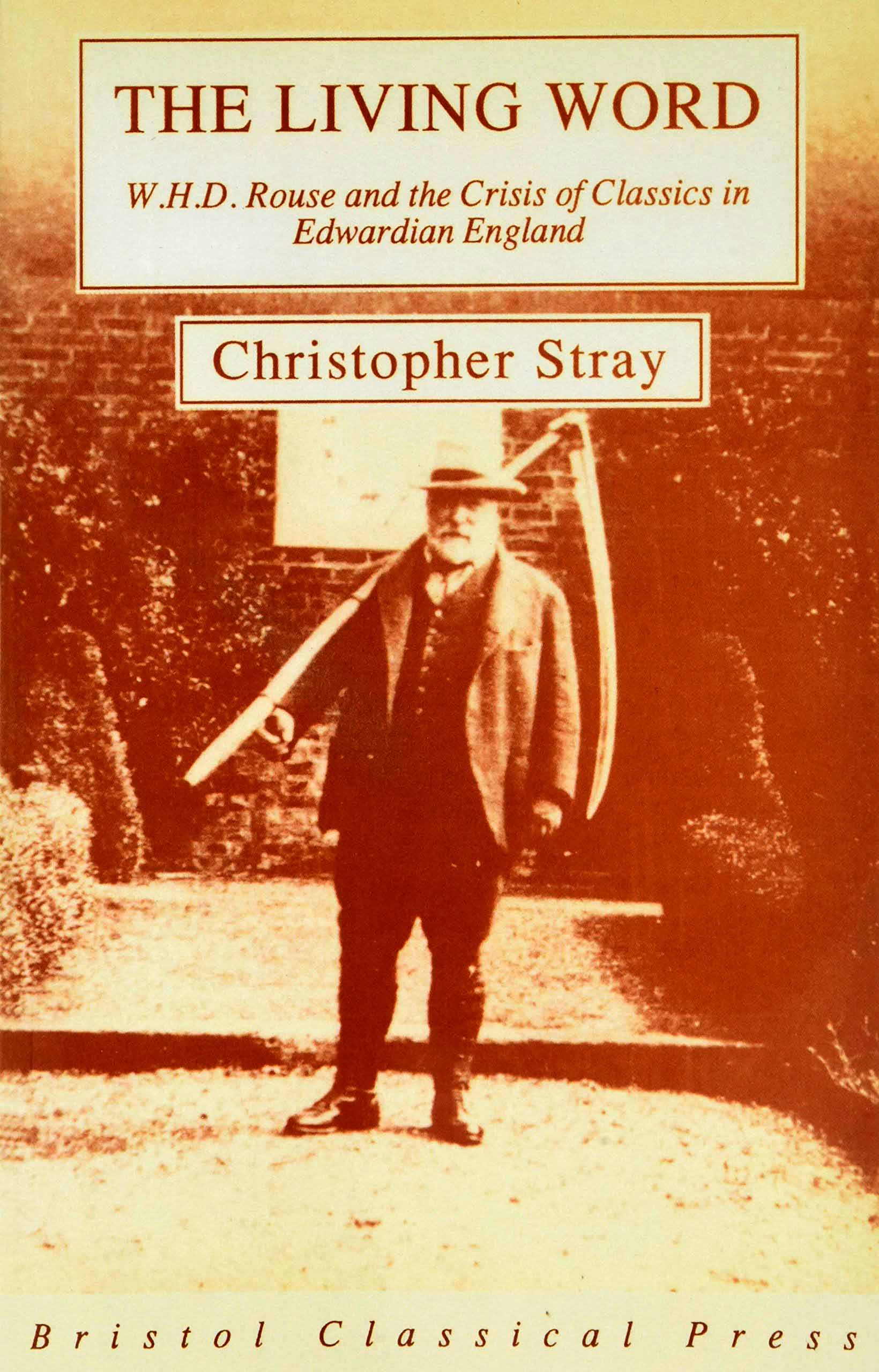
A researcher by the name of Christopher Stray recently wrote about Rouse.
First, he did
an article, and then he published a pamphlet.
Well, 1992 is recent as far as I’m concerned.
He called it The Living Word: W.H.D. Rouse and the Crisis of Classics in Edwardian England.
Fun stuff.
Rouse taught his introductory classes in living and “dead” languages strictly by the “direct method”:
no English, no translation.
Writes Stray of Rouse’s Latin and Greek courses:
|
The elementary paradigms of language were learnt through involvement in
dialogue, accompanied by activity. As a pupil got up from a seat, walked
away from it, returned to it and sat down again, he uttered, and pragmatically
learnt, the words surgo, ambulo, revenio, sedeo. Second and third
persons were learnt in similar fashion: |
|
| A. | Surgo Chorus (to A, pointing) Surgis. Chorus (to Master, pointing at A) Surgit. |
| B and C. | Surgimus Chorus (to B and C) Surgitis. Chorus (to Master) Surgunt. |
In a memorandum submitted to the Curricula Committee of the Classical
Association in January 1906, Rouse spelled out his reasons for basing
the teaching of Greek on the spoken word: | |
|
1. It is natural. Language is the means of communicating between
tongue and ear, and written letters are only a means of storing up the
material of language.... They bear the same relation to speech as a
musical score to the performance. 2. It is living. The written word has no means of compelling attention; the spoken word, if well spoken, and if intelligible, commands attention, and creates a lasting impression in proportion to the force of the speaker’s character.... 3. It is speedy. It allows of many times as much practice in a given time. 4. It is intelligent. The difference of person, number etc. between a master and pupil cause[s] the response to be, not a parrot echo, but something new made on the spur of the moment. |
Disbelievers from all over England and Europe visited his classroom
to witness the astonishing spectacle of teens conversing fluently and easily and even casually joking around in Classical Greek.
The kids thoroughly enjoyed the class. In no time at all they were reading Thucydides and other Classical writers with ease.
Now ain’t Rouse exactly the sort of teacher you’d just dream of having?
Wouldn’t such a teacher have made school tons of fun rather than a dreaded chore?
Wouldn’t such a teacher have made class an exciting and fulfilling adventure rather than a meaningless bore?
Isn’t that the sort of teacher who no longer exists?
Rouse retired in 1928, but, constitutionally incapable of devoting the remainder of his days to fishing,
he opened several summer schools and kept active with new supplies of students.
I don’t know how long that went on, but I do know that he died in 1950.
That was the end of that.
His innovative and effective methods have never been revived anywhere in the world as far as I know.
If a modern-day Rouse existed, I would save all my pennies to enroll in class.
No modern-day Rouse exists. ’Twas but a brief shining moment, lost to the mists of time.
(Apologies to Lerner & Loewe.)
Now, at long last, I have discovered the official explanation for why Rouse’s sort of “direct method” is no longer used.
Take a look at M.J. Russell’s
“The
Direct Method in Teaching Latin — Some Objections,”
from The Classical Journal vol. 12 no. 3, December 1916.
When Rouse was a visiting instructor at Columbia, Russell sat in on his class for six weeks
and agreed that the “direct method” gave splendid results.
That is why he advocated that the “direct method” be abandoned.
You see, he argued that since no Latin instructor could speak the language,
it was too difficult to follow Rouse’s example.
Of course, Russell did not think to argue that Latin instructors should be able to speak Latin.
Heaven forbid! Why should a teacher know his subject? Oh, perish the thought! That would be so hard!
I mean, we have to be fair, right?
Those poor teachers! We need to think about them.
It would be soooooooooooooo difficult for them to learn the topics that they teach their students.
We should have some mercy, after all.
You know, that explains all of my schooling, from kindergarten through the senior year of college.
All of it. Explained. Perfectly.
I do credit Russell, though, for making me aware of Mr. Dooley’s aphorism:
“It doesn’t make much difference what ye teach children, so long as it is disagreeable to them.”
(Mr. Dooley — real name Finley Peter Dunne — wrote a humorous column in the Chicago papers in the 1890’s.)
Funny thing about Latin teachers not being able to speak Latin:
Did you know that there are clubs devoted to speaking Latin?
Here’s the most extreme:
Nova Roma.
Here’s one that might be a little more fun:
Circulus Latinus Seattlensis.
There’s even one in anti-intellectual Los Ángeles of all places:
SALVI: Latin for the Living.
I can’t find a correlative club for Classical Greek —
but there is this most tantalizing this statement from a Markos:
“My friends and I speak Ancient Greek.”
Hmmmmmmmm.
A Partial W.H.D. Rouse Bibliography
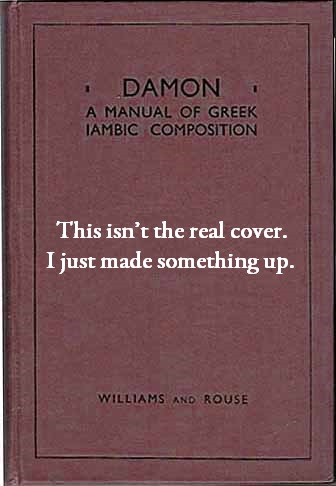
John Herbert Williams,
Damon, a Manual of Greek Iambic Composition. Second edition, revised by W.H.D. Rouse. Rivington & Percival: London, 1894.
|
J. Herbert Williams,
Key to Damon: Containing the Greek Version of the Exercises.
Second edition, revised by W.H.D. Rouse. London: Rivington, Percival & Co., 1895.
|
|
John Herbert Williams and
W.H.D. Rouse, Damon, a Manual of Greek Iambic Composition. Third edition. London: Blackie & Son, 1906.
|

John Herbert Williams and
W.H.D. Rouse, Key to Damon. Third edition.) London, Glasgow: Blackie & Son, 1906.
|
“In Athens,” a poetical satire by W.H.D. Rouse, published in 1896.
|
Argyris Ephtaliotis [pseud. for Kleanthes Michaelides],
Tales from the Isles of Greece Being Sketches of Modern Greek Peasant Life. Translated from the Greek by W.H.D. Rouse. London: J. M. Dent & Co., 1897.
|
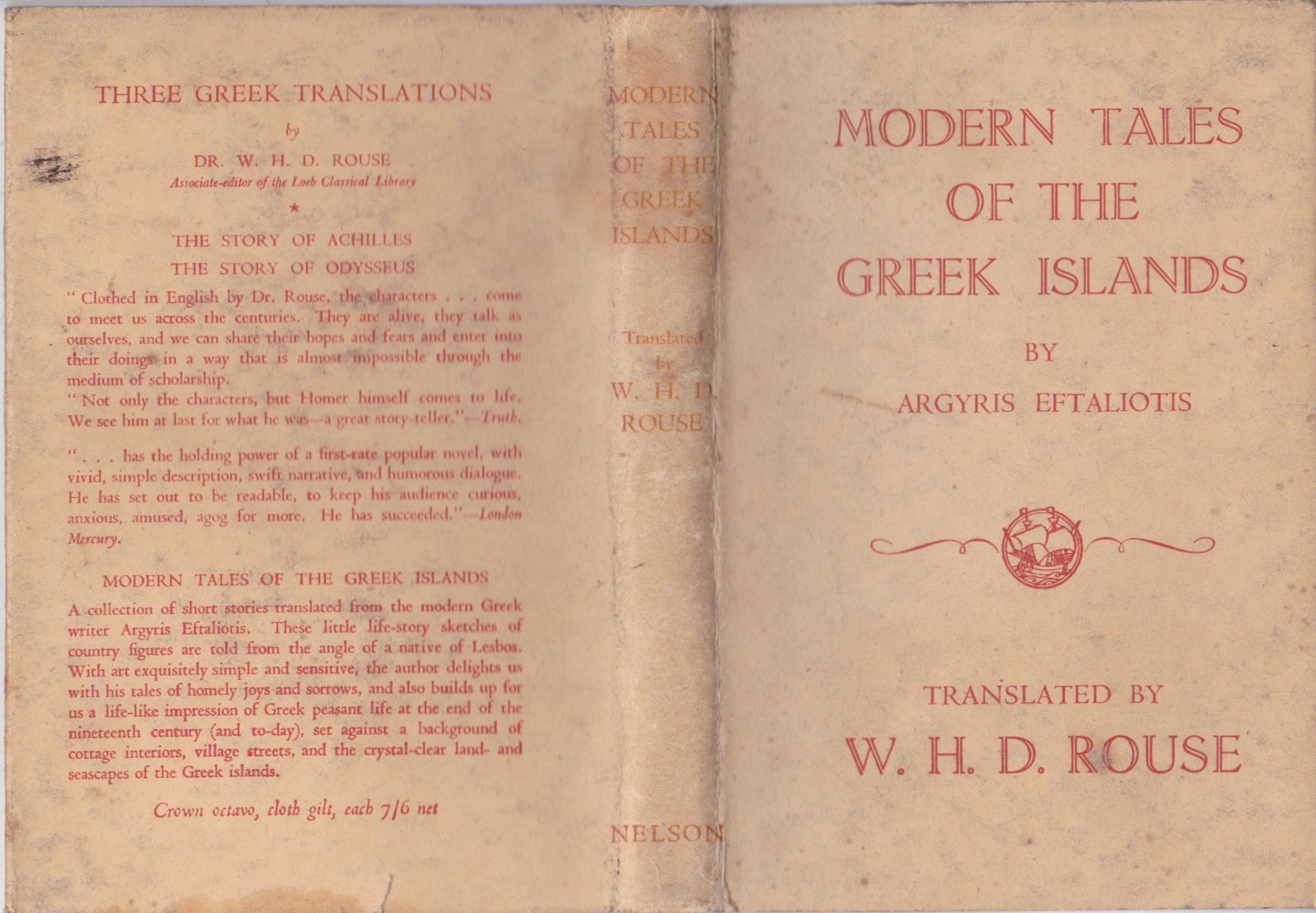
Argyris Eftaliotis [pseud. for Kleanthes Michaelides],
Modern Tales of the Greek Islands. Translated by W.H.D. Rouse. London: Thomas Nelson, 1942. (Reissue of 1897 edition.) Still very easy to find.
|
Peculiarly, the original Greek book is nowhere credited in the translation.
I have identified it:
Νησιώτικες ἱστορίες
(Athens: Estias [Ἑστίας], 1894).
At
Ἀνέμη –
Ψηφιακὴ
Βιβλιοϑήκη
Νεοελληνικῶν
Σπουδῶν
we can also download a horrible photocopy of
Ἐκλεχτές
Σελίδες·
Φυλλάδες
τοῦ
Γεροδήμου,
Νησιώτικες
ἱστορίες,
Ἀπὸ
τὴν
Ἐϑνικὴ
μας
ἱστορία,
Παλιοὶ
Σκοποί
(Athens: Yannaris, 1921), which contains several of the same stories,
recycled from the earlier collection.
|
W.H.D. Rouse,
Atlas of Classical Portraits: Greek, with Brief Descriptive Commentary.
London: J. M. Dent & Co., 1898.
|
W.H.D. Rouse,
Atlas of Classical Portraits: Roman, with Brief Descriptive Commentary.
London: J. M. Dent & Co., 1898.
|
W.H.D. Rouse, Peasant Life in Modern Greece:
A Lecture Delivered before the Ruskin Society of Birmingham, 1st February 1899.
[Birmingham?] [1899].
A Lecture Delivered before the Ruskin Society of Birmingham, 1st February 1899.
[Birmingham?] [1899].
| 1 known copy at a library, OCLC 81091229 : |
Widener Depository Q 269, Harvard College Library, Cambridge, MA 02139 |
W.H.D. Rouse,
“Folklore from the Southern Sporades,”
Folk-Lore, a Quarterly Review of Myth, Tradition, Institution, & Custom, Being the Transactions of the Folk-Lore Society, and Incorporating The Archæological Review and The Folk-Lore Journal vol. X, June 1899, pp. 150—185.
Folk-Lore, a Quarterly Review of Myth, Tradition, Institution, & Custom, Being the Transactions of the Folk-Lore Society, and Incorporating The Archæological Review and The Folk-Lore Journal vol. X, June 1899, pp. 150—185.
| Download | 2nd Copy | 2nd Copy Again | 3rd Copy | 4th Copy |
| Download | Second copy Download |
|
W.H.D. Rouse and
John Millington Sing, Exercises in the Syntax and Idioms of Attic Greek. London: Rivingtons.
|
W.H.D. Rouse and
John Millington Sing, Key to Exercises in the Syntax and Idioms of Attic Greek. London : Rivingtons.
|
W.H.D. Rouse,
Greek Votive Offerings:
An Essay in the History of Greek Religion.
Cambridge University Press, 1902.
An Essay in the History of Greek Religion.
Cambridge University Press, 1902.
| Download | Second copy Download |
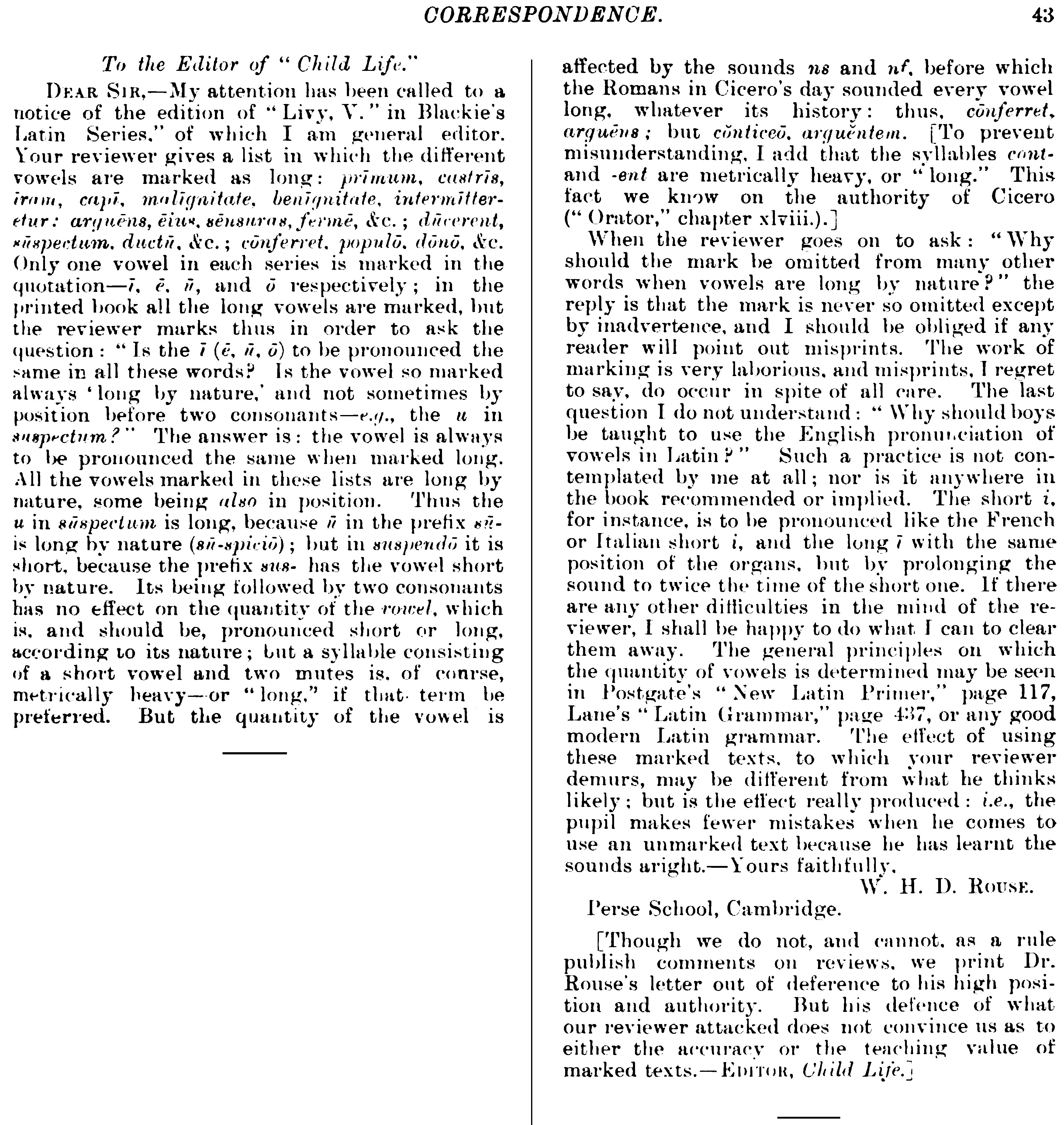
Child Life vol. VIII, no. 29, 15 January 1906, p. 43.
Rouse was general editor of the Blackie’s Latin Texts series.
W.H.D. Rouse,
A First Greek Course.
London: Blackie & Son,[1st ed., 1906],
[2nd ed., 1908],
[3rd ed., 1916].
London: Blackie & Son,
A poor photocopy of an early printing of the third edition is available on the Internet.
The covers are not included.
This does not include the errata slip pasted onto p. 115, which pointed out errors on p. 114.
That errata slip postdated this particular sale.
This printing also contains an erroneous footnote on p. 145, which incorrectly reads “First Aor.” rather than “Second Aor.” This mistake was corrected in later printings.
Four different sites post this exact same scan: |
|
| First posting |
|
| Second posting (identical with the above) Download | |
| Third posting (same as above, but split into a single-page layout) | |
| Fourth posting (same as previous, but with library stamp and notation on title page erased) Download | |
When I first saw this book at age 22 or 23, it scared me half to death.
It tossed too much grammar at the student from the very first page, with insufficient practice to allow anything to stick.
Worse, it explained nothing, since it was not written for students.
There were parts that no student could have understood without a tutor’s assistance.
For instance, the unattributed quote from Menander (p. 11) makes my head spin.
I just spent forever on it and got nowhere.
Finally, I gave up and plugged the first line into Google.
After a while I found an English translation,
and it took me a few moments even to understand that.
After reading the translation, I was able to go over the Greek again, slowly, and I had some difficulty grasping the logic of the word order.
This book really requires a preceptor.
|
Λύπης ἰατρός ἐστιν ἀνϑρώποις λόγος· ψυχῆς γὰρ οὗτος μόνος ἔχει ϑελκτήρια· λέγουσι δ’ αὐτον οἱ πάλαι σοφώτατοι ἀστεῖον εἶναι φάρμακον καὶ χρήσιμον. |
Speech is a doctor of grief to men;
for this alone has charms for a soul; and the wisest men of old say that it is a nice and useful remedy. |
Only a handful of libraries hold this title.
By the dumbest luck, though, I just managed to purchase an original, via Abe Books, from AnyBook.biz.
Decades and decades of searching, and then, lo and behold, there it is. Okay.
Arrived on Monday, 27 February 2017.
I just did a raw, rough scan. When/if I ever find the time, I’ll rotate and clean up the pages.
I doubt I’ll ever find the time.
So right-click and download.
As is often the case with Blackie books, there is no date anywhere — no copyright or publication or printing date —
nor is there any indication of which edition it is.
Yet I have determined that this is a reissue of the third edition, though it nowhere so states.
Oh, and right after I sent in a payment for the book, a second one was listed!
I found it when I was searching for something else.
I was clicking through pages and then I froze when my slow mind finally caught up: “Did I see what I think I just saw?”
I hit the Back button, and yup, there it was!
So, I bought that one too, via Abe, from D2D Books.
It arrived the day after the first one arrived.
Five months later a third copy popped up, from Plurabelle Books!
The differences among these three printings are only slight.
From examining these three impressions, I can determine that this book was continually in print from 1916 through probably the 1970’s,
and I assume it was reprinted, with small corrections when necessary, at the beginning of each school year.
My Plurabelle issue is the earliest of the three, and so I assume it dates from not long after 1916, at a time when copies of the second edition were surely still readily available.
It is letterpress, and it contains the following on page vi:
NOTE TO THE THIRD EDITION
In the third edition a few minor corrections have been made,
and the list of Parts of Common Irregular Verbs has been
considerably extended.
W. H. D. ROUSE
February, 1916. |
The title page reads:
LONDON
BLACKIE & SON, LIMITED, 50 OLD BAILEY, E.C.,
GLASGOW AND BOMBAY
BLACKIE & SON, LIMITED, 50 OLD BAILEY, E.C.,
GLASGOW AND BOMBAY
The reverse of the title page contains a box listing the four books by W.H.D. Rouse available from
BLACKIE & SON, LTD., LONDON, GLASGOW, BOMBAY.
My Plurabelle impression also contains a pasted-in errata slip on p. 115, pointing out the errors on the facing page:
ERRATA
Page, 114, col. 2— τρισκαιδέκατος τετταρεσκαιδέκατος πεντεκαιδέκατος ἑκκαιδέκατος ἑπτακαιδέκατος ὀκτωκαιδέκατος ἐννεακαιδέκατος |
Finally, my Plurabelle impression has the error in the footnote on p. 145 that I mentioned above:
“First Aor.” should correctly be “Second Aor.”
The AnyBook impression is a library discard from the Huddersfield Technical College Library.
It had been presented as a gift:
“PRESENTED BY THE PARENTS OF THE LATE JAMES T. KENWORTHY, B. COM. A.C.I.S.”
It is identical to the above impression except that it deletes the “Note to the Third Edition.”
That would seem to indicate that this impression dates from the 1920’s or 1930’s,
at a time when copies of the second edition were growing scarce.
It too is letterpress, and the errors on pp. 114 and 145 were corrected.
The title page is simplified:
BLACKIE & SON, LIMITED
LONDON AND GLASGOW
LONDON AND GLASGOW
On the reverse of the title page is the same box as previously, but reset.
This time, though, there is text above the box:
BLACKIE & SON LIMITED
50 Old Bailey, London
17 Stanhope Street, Glasgow
BLACKIE & SON (INDIA) LIMITED
Warwick House, Fort Street, Bombay
BLACKIE & SON (CANADA) LIMITED
Toronto
50 Old Bailey, London
17 Stanhope Street, Glasgow
BLACKIE & SON (INDIA) LIMITED
Warwick House, Fort Street, Bombay
BLACKIE & SON (CANADA) LIMITED
Toronto
In March 2019 I chanced upon yet a fourth copy of this book, sold by Keogh’s Books of Stroud.
It is essentially identical to the edition I purchased from AnyBook, but there are advertisements at the end, which happily list prices.
One of the prices listed in that little catalogue is for A First Greek Course, 3s. 6d.
So, if I could ever determine when this book was sold for that price, I could gauge better when this was printed.
This copy was definitely used, but was treated with the most impeccable manners, and so it is in remarkably fine condition.
My D2D issue is a later impression, offset, which was less expensive and faster.
This copy has never been read and is in almost pristine condition.
The title page and its reverse are identical to the previous two copies.
It is a wartime reissue, and the paper is somewhat cheaper.
It includes a note on p. vi:
BOOK
PRODUCTION WAR ECONOMY STANDARD THE PAPER AND BINDING OF THIS BOOK CONFORM TO THE AUTHOR- IZED ECONOMY STANDARDS |
The last impression that I know about was an undated flex cover,
surely from the 1970’s, currently available on Abe Books, but a little bit out of my price range:
I have never seen a first or second edition.
The first edition from 1906 seems to be available at several libraries: |
|
| • |
M. Louis Salmon Library, North Wing, 3rd floor (PA259 .R68) The University of Alabama in Huntsville 301 Sparkman Dr Huntsville AL 35899 (256) 824-1000 |
| • |
The University of Arizona Libraries (PA258 .R68 1960) 1510 E University Blvd Tucson AZ 85721-0055 (520) 621-6442 |
| • | |
| • |
William T. Young Library, Books, 4th Floor (PA258 .R6 1960) University of Kentucky Lexington KY 40506-0456 (859) 218-1881 |
| • |
McPherson Library (PA258 R64) (date unknown, probably 1906) University of Victoria 3800 Finnerty Road Victoria BC V8P 5C2 (250) 721-7211 |
| • | |
| • |
Theology Library (Jan Lion-Cachet Library) Potchefstroom Campus (488 ROU) and (488 ROU c.2) (date unknown, probably 1906) Ferdinand Postma Library North-West University c/o Molen and Borcherd streets Building K11 2531 Potchefstroom SOUTH AFRICA +27 (0)18 299 2809 |
The second edition from 1908 seems to be available here: |
|
| • |
WRLC Shared Collections Facility (PA258 .R68 1908) George Washington University 2130 H Street NW Washington DC 20052 (202) 994-6558 |
| • |
Holland/Terrell Libraries Stacks (PA258 .R68 1908) WSU Libraries PO Box 645610 Washington State University Pullman WA 99164-5610 (509) 335-9671 |
| • |
The John P. Robarts Research Library (LaGr.Gr R863f) 130 St. George St. Toronto ON M5S 1A5 (416) 978-8450 |
Two libraries seem to have several editions each: |
|
| • | |
| • |
Leeds University Library 1st ed.: Thompson Collection 5 ROU [1st ed.] 2nd ed.: Thompson Collection 5/ROU [2nd ed.] 3rd ed.: Thompson Collection 5 [3rd ed.] The Brotherton Library University of Leeds Leeds LS2 9JT 0113 343 5663 |
There are other libraries that have editions of unknown vintage: |
|
| • | |
| • | |
Then, of course, other libraries seem to have the 1916 edition or later reprints thereof: |
|
| • |
Chinook Libraries (488.2 R76) 184 UCB 1720 Pleasant St University of Colorado Boulder CO 80309-0184 (303) 492-7521 |
| • |
Saint Meinrad Archabbey Library (PA258 .R6 1913) 200 Hill Dr St. Meinrad IN 47577 (812) 357-6611 Despite the call number, this is definitely a later printing of the 1916 edition, with the errors on pages 114 and 145 corrected. I should know, because I photocopied this back in 1982 or 1983. |
| • |
Elizabeth Dafoe Library Second Floor (PA258 R68 1916) University of Manitoba Winnipeg MB R3T 2N2 (800) 432-1960 |
Interestingly, a few years ago Anne Mahoney augmented the 1916 third edition of this book for Focus Publishing,
an outfit that has since been purchased by Hackett Publishing.
You can click here to order a copy.
The updating was necessary, since it is no longer a given that students approaching Classical Greek for the first time are already fluent in French and Latin
and intimately familiar with the technical grammar and all its complicated terms.
Rouse’s original book was filled top to bottom with charts and rules and technical names, and as such it served basically as emergency review and memory jogs,
as well as a rough outline for an instructor.
Rouse’s book merely hovered in the background during the teaching of his course, which was almost entirely oral, though with written homework, unfortunately.
Mahoney saw the drawbacks and so, while keeping nearly all of Rouse’s text, she sought to make it more of a “Direct Method” approach.
As I go through this book, I am at a loss to find any “Direct Method” anywhere in it.
Wrote she in her preface:
|
Students at the Perse started Greek at age 14 or 15, after three years of Latin and five of French.
They were thus already familiar with ideas like noun cases, verb moods, and agreement.
Rouse exploited this background in his original textbook;
for example, in chapter 8 we find “The Absolute Case in Greek is the genitive,
as ἐμοῦ λέγοντος,
‘as I was speaking.’”
This is the entire discussion of the genitive absolute, and the Greek readings in the chapter contain no examples.
For contemporary students, who may begin Greek before Latin, or relatively early in their study of Latin,
this is inadequate, so I have replaced this one sentence with half a dozen paragraphs and two focused exercises.
|
Despite this expansion and updating, it would still be a steep uphill battle for a self-learner to struggle through to the end of this course.
Steep. Like 90 degrees.
I’m sure it could be done, but I would not envy anybody who were to make the effort.
(I’ll give it a try in the foreseeable future, now that I’ve made some good progress in Asahel Kendrick’s course.)
I have not yet studied either Rouse’s original or Mahoney’s revision, though I have taken a good taste of both.
From what I can discern so far, it seems to me that Mahoney did not make Rouse’s course easier for modern students, but twelve times more difficult.
I’ll study both versions in the near future and report back, as my original impression may well change.
Mahoney’s book opens with about 30 pages of intensely complicated grammatical rules, almost entirely devoid of practice,
and asks students to perform exercises they have not yet been trained to do.
The insistence upon technical linguistic terminology is overwhelming.
It would not be overwhelming if there were more demonstrations, examples, and practice,
but demonstrations, examples, and practice are provided by the instructor, not by the printed text.
I really like Mahoney’s insistence upon students learning all six essential parts of each verb as it is encountered:
present active, future active, aorist active, perfect active, perfect middle/passive, aorist passive.
This would surely make later lessons easier. I’ve not seen any other instructor do this, but I think it’s good practice.
As with the original editions, this book is still merely an outline for a course taught orally and spontaneously.
Rouse wrote his text for teachers, not for students, and gave those teachers suggestions about conversations they could invent for the day’s instruction,
as well as suggestions on how to present the material, fully expecting every last instructor to conduct class in Greek.
A reviewer, “Ashtree,” at Amazon, warns of Mahoney’s revision:
“Emphatically NOT for beginners!!!” and provides a few samples to defend that assertion:
|
For example, if you’re a newcomer to language-learning, and hoping to teach yourself some classical Greek from this book,
how are you going to feel when (on page 15) you’re informed (with almost no further explanation) that:
“The nominative is used for the predicate nominative in copular sentences.”
What are you going to do when you turn to the exercises at the end of the chapter and hit the exercise
where it gives you a list of Greek verbs and the instruction to compare the verb endings with their Latin and Sanskrit equivalents (which aren’t provided!)?
I’m not kidding!!!
|
Ashtree was being a bit harsh, but I can see the point.
This book is overly demanding — not enough to intimidate me, but yes, it will certainly be a struggle.
You can also get Mahoney’s new edition of
A Greek Boy at Home while you’re at it.
As I browse through the catalogue, I see that there are some other titles at Hackett that seem quite promising, indeed.
W.H.D. Rouse, The Hellenic Traveller’s Club.
London: Hellenic Travellers’ Club, 1907.
London: Hellenic Travellers’ Club, 1907.
| 1 or maybe 2 known copies at libraries, OCLC 696111928 : |
The Worcester College Library Stack, XH.5.37(21) (apply staff) University of Oxford Oxford OX1 2HB |
This is probably a different volume: Princeton University Library Rare Books (Ex), Oversize 2008-0453Q 1 Washington Rd Princeton NJ 08544 |
| Download |
To my surprise, I just discovered that I had photocopied this back in 1982 or 1983, and yet I made no photocopy of the covers, and I always copy the covers.
So, it comes back to me now.
What I received was the original edition, which was an informal pamphlet, without covers.
| Download |
Bill Rouse, of course, compiled this little volume to accompany his First Greek Course.
Reproduced on this web page by kind permission of the Perse School Archive.
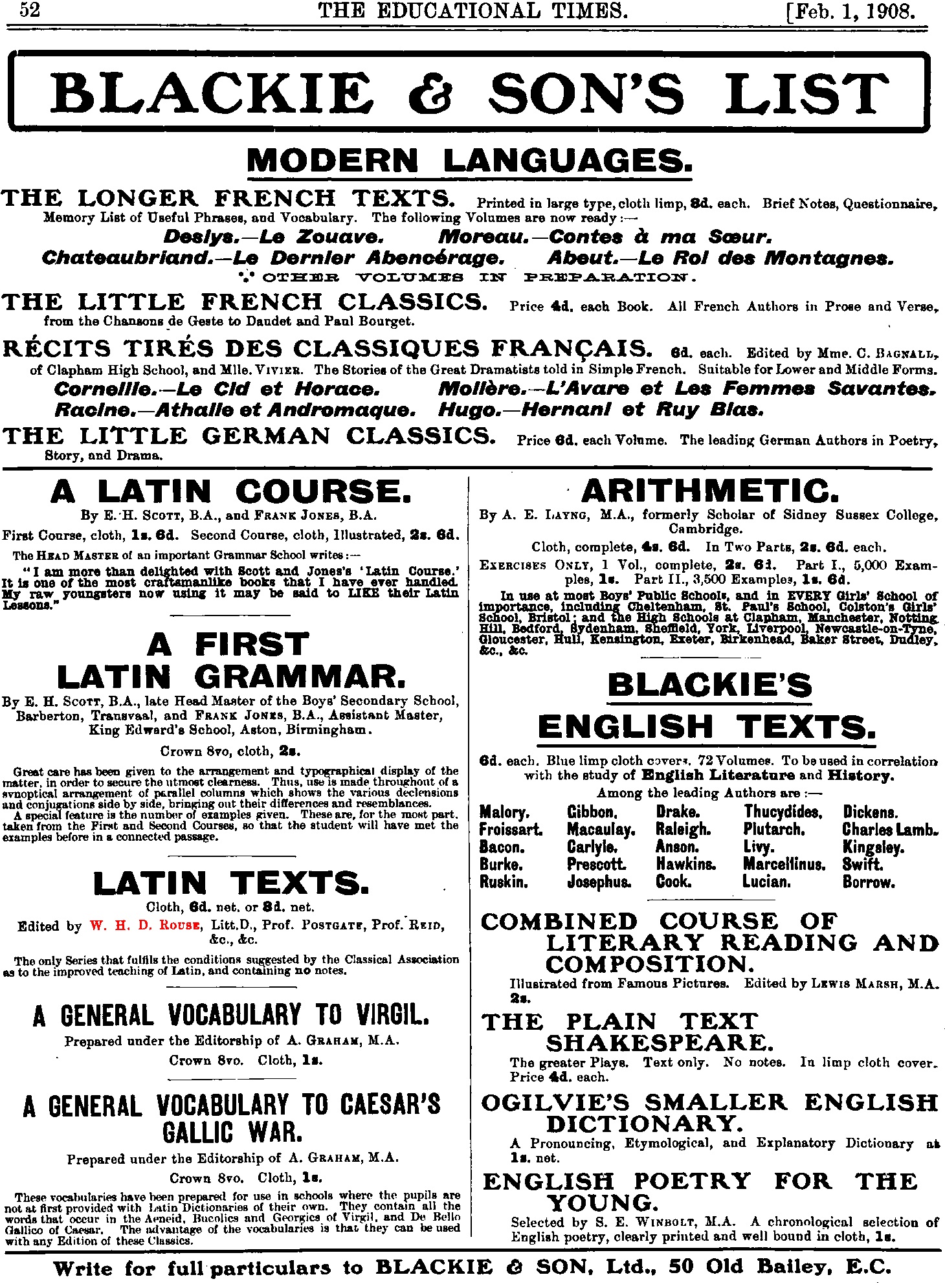
The Educational Times and Journal of College Preceptors
vol. LXI, New Series, No. 561, 1 January 1908, p. 35.
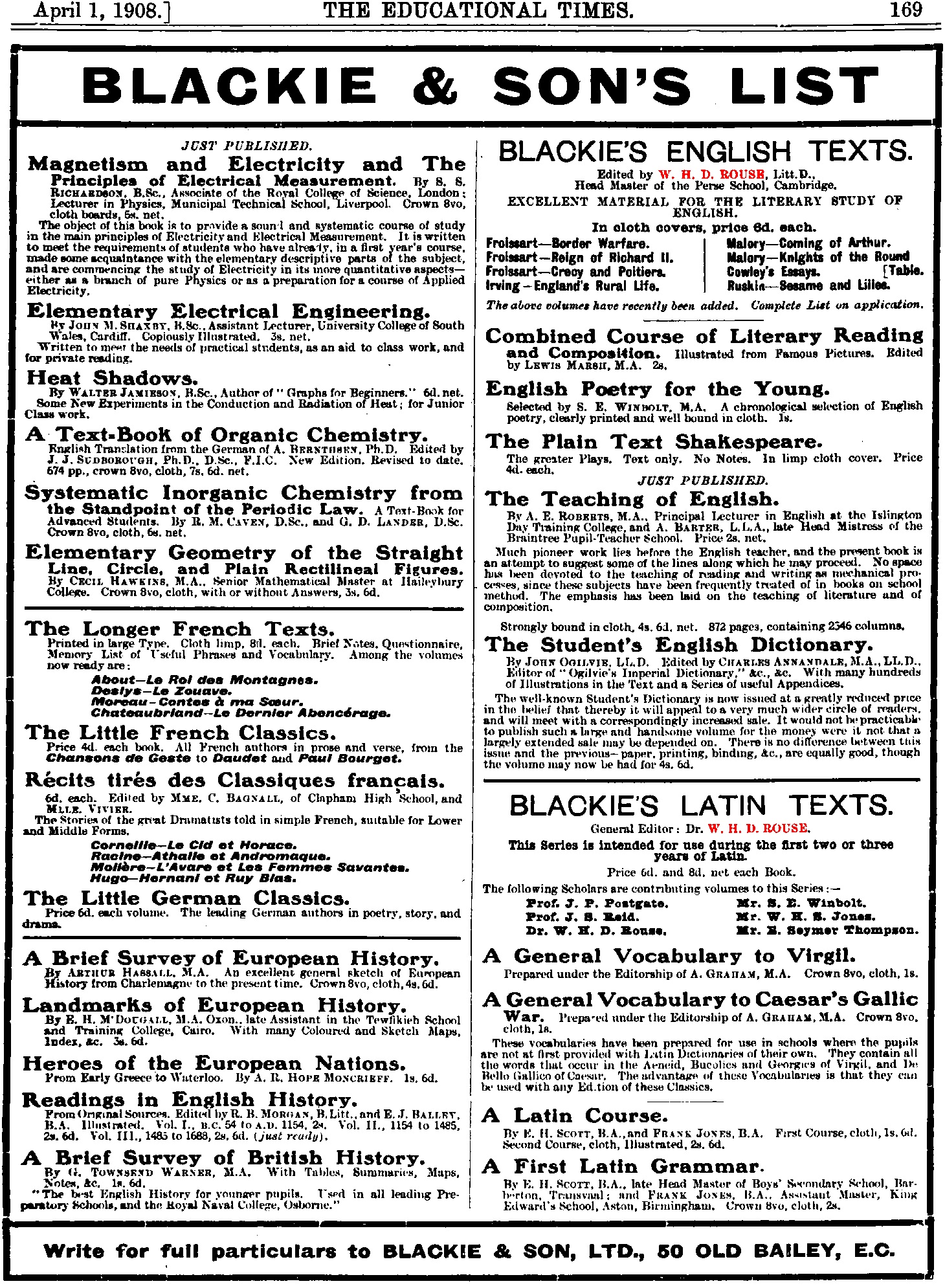
The Educational Times and Journal of College Preceptors
vol. LXI, New Series, No. 564, 1 April 1908, p. 169.
’Tis an interesting line-up, yes?
Shall we take a look at these four books?
 A. Graham, A General Vocabulary to Virgil (London: Blackie and Son, 1908) |
 A. Graham, A General Vocabulary to Caesar’s Gallic War (London: Blackie and Son, 1908) |
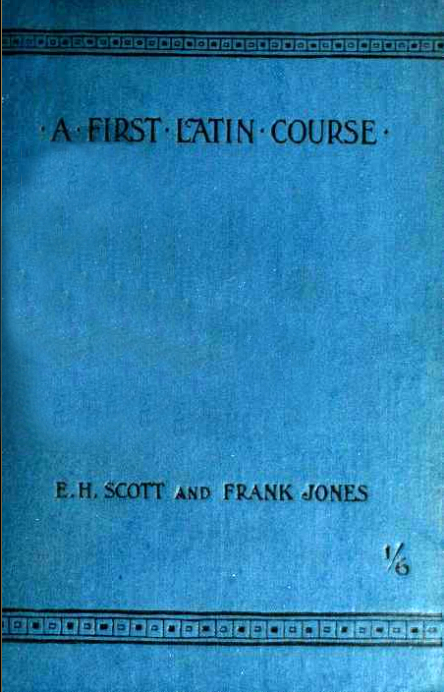 Ernest Howard Scott and Frank Jones, A First Latin Course (London: Blackie and Son, 1908) |
 Ernest Howard Scott and Frank Jones, A First Latin Grammar (London: Blackie and Son, 1908) |
W.H.D. Rouse, “Latin and Greek,”
in John William Adamson, The Practice of Instruction, a Manual of Method General and Special.
London: National Society’s Depository, 1907.
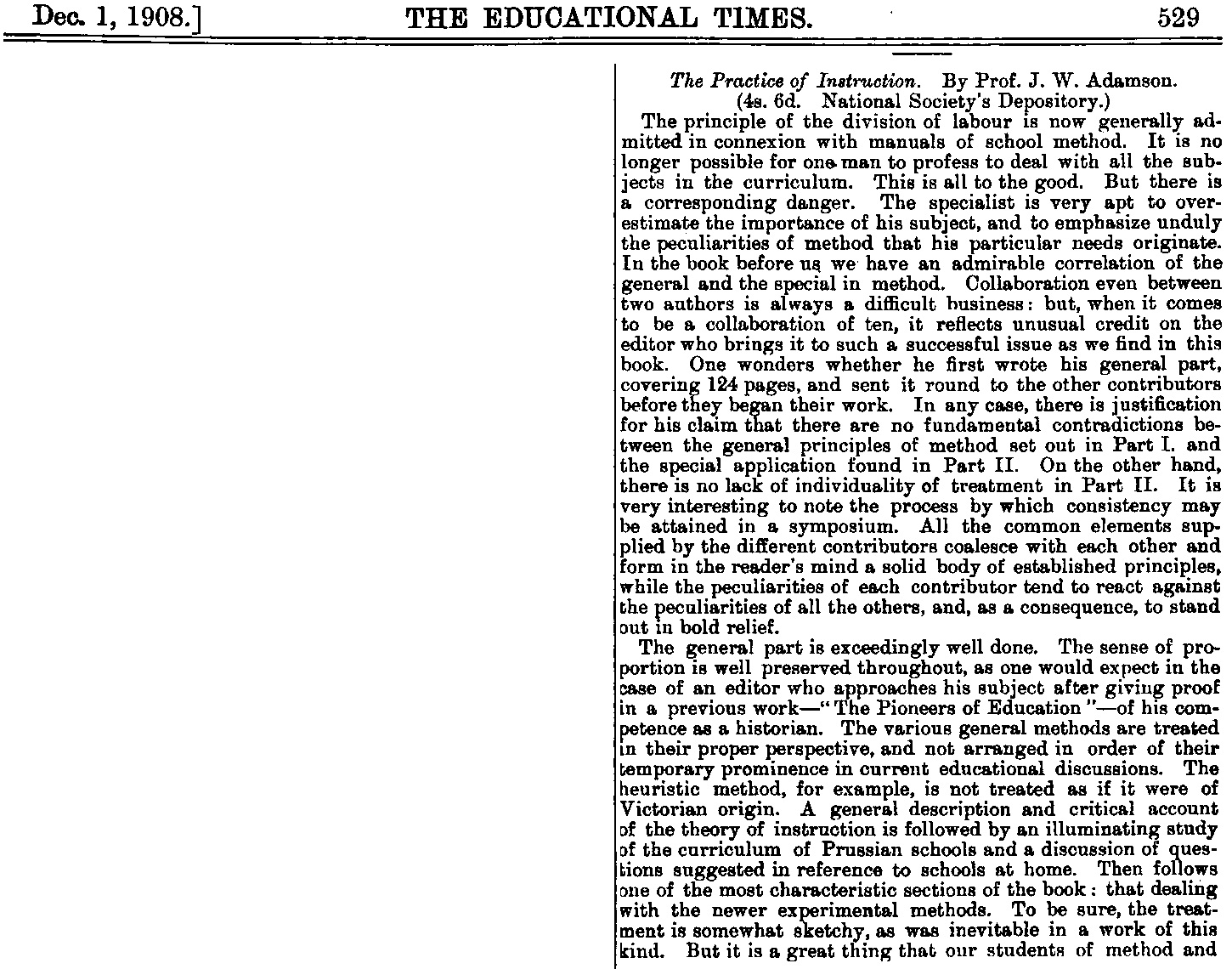

The Educational Times and Journal of College Preceptors
vol. LXI, New Series, No. 572, 1 December 1908, pp. 529–530.
| Download |
As with A First Greek Course, which this was meant to accompany, no printing contained a date,
and the volume was kept in print for many decades, probably issued at the beginning of each school year.
The stapled paperback Vocabulary was inserted into the inside back cover by means of a fiber band.
Libraries tend to separate these two volumes, which is a grave error.
I have four copies in my collection, and have not discovered any differences among them.
The final edition of which I am aware was a flex cover, surely from the 1970’s,
which I presume included both the text and the vocabulary in a single binding.
I would love to purchase it, but it is, again, just a bit out of my price range:
Ann Mahoney and Focus Publishing / Hackett Publishing have reissued this book:
W.H.D. Rouse,
Vocabulary to A Greek Boy at Home.
London, Blackie & Son, 1909.
This was inserted into the inside back cover of A Greek Boy at Home, but libraries tend to separate the Vocabulary.
London, Blackie & Son, 1909.
This was inserted into the inside back cover of A Greek Boy at Home, but libraries tend to separate the Vocabulary.
| Download |
W.H.D. Rouse, A Greek Reader.
New York: C.E. Merril, [191-?].
Reprint of the Blackie edition from 1907.
New York: C.E. Merril, [191-?].
Reprint of the Blackie edition from 1907.
| 1 known copy at a library, OCLC 29977178 : |
William Robertson Coe Library Stacks Level 3, PA260 .R687 1910z University of Wyoming 1000 E University Ave Laramie WY 82071 |
| Download |
Ah! After nearly four decades, I finally have enough information to decipher this mystery.
The “Lingua Latīna” series began in 1912 with several works in the works:
|
Theodora Ethel Wye,
Prīmus Annus: Vocābulata Explicāta, 1918
(not technically part of the “Lingua Latīna” series, but it belongs, nonetheless)
|
||
|
Reginald Bainbridge Appleton and William Henry Samuel Jones,
Puer Rōmānus, 1913 (intended for use after Prīmus Annus)
|
NO ILLUSTRATION AVAILABLE Edward M. Carter, “Vīlla Cornēliāna,” 1914. This is a color illustration to be hung on a classroom’s wall; it was designed in collaboration with the editors. Details: 40" × 60", unvarnished, The listing at OCLC 503797924, which links to The British Library, St. Pancras, General Reference Collection L.R.27.a.10 surely refers to this item, which may or may not also be at the Van Pelt Library at the University of Pennsylvania. |
|
|
Cyril Lyttleton Mainwaring & Walter Lionel Paine,
Secundus Annus, 1917. This was first announced in 1913 as forthcoming from William Henry Samuel Jones. What happened to that plan, I dare not guess. |
||
|
Reginald Bainbridge Appleton,
Lūdī Persiciī, 1921 (new edition; previous edition, date unknown, was published by W. Heffer and Sons, Cambridge)
|

Joannes Ludovicus Vives [Juan Luis Vives],
Scenes of School and College Life in Latin Dialogues, ed. by W.H.D. Rouse, 1931.
Again, I can’t find this anywhere, and I do not have an image of the cover, so I just faked it.
A few libraries seem to have this volume: http://www.worldcat.org/oclc/10177091.
|
As far as I can tell, that was the entire collection, though there were similar books by these and other authors that would fit in quite well with this series. For those who may be interested in such similar works:
|
Edward Adolf Sonnenschein,
Ora Maritima, a Latin Story for Beginners, with Grammar and Exercises (London: Swan Sonnenschein; NY: Macmillan, 1909) |
Edward Adolf Sonnenschein,
Pro Patria: a Latin Story for Beginners, Being a Sequel to ‘Ora Maritima’, with Grammar and Exercises (London: Swan Sonnenschein; NY: Macmillan, 1907) |
|
Reginald Bainbridge Appleton,
Some Practical Suggestions on the Direct Method of Teaching Latin (W. Heffer, 1913) |
Reginald Bainbridge Appleton,
Perse Latin Plays (London: W. Heffer, 1913) |
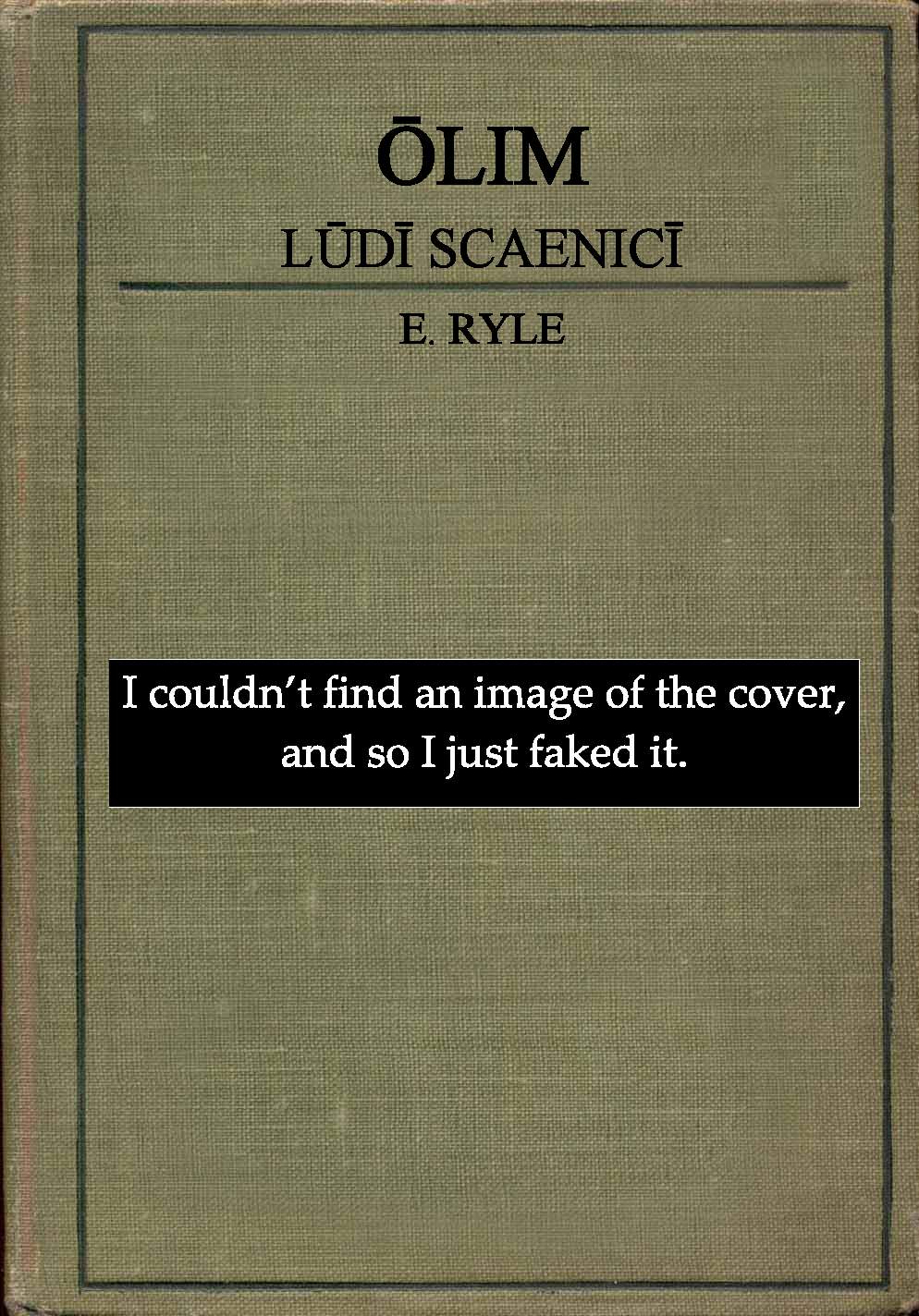
Not online, but there are a few library copies
here and
here.
She was Gilbert’s older sister,
not his daughter.
She is often and wrongly confused with Effie Ryle, and I only know of one other of her books:
The Teacher in the School (1917), held at only one library.
|
|
Reginald Bainbridge Appleton,
Fabulae: Virginibus Puerisque aut Narrandae aut Recitandae (London: G. Bell and Sons, 1914) |
Edward Conner Chickering and Harwood Hoadley,
Beginners’ Latin by the Direct Method (NY: Charles Scribner’s Sons, 1914) |
William Henry Samuel Jones,
“Cambridge Handbooks for Teachers”: Via Nova; or, the Application of the Direct Method to Latin and Greek (Cambridge: University Press, 1915) |
|
Reginald Bainbridge Appleton and William Henry Samuel Jones,
Initium: A First Latin Course on the Direct Method (Cambridge: University Press, 1916) |
Reginald Bainbridge Appleton and William Henry Samuel Jones,
Pons Tironum (London: G. Bell and Sons, 1924) |
For whatever it’s worth:
Karl Petraris,
A Handbook of the Modern Greek Spoken Language with Exercises.
Translated from the German by W.H.D. Rouse.
Heidelberg: Julius Groos, 1921.
This is Demotic Greek, though with continual references to the differences one would encounter in Katharevousa (“the literary language”). The explanations of the grammar are quite intimidating, but the exercises are sufficiently copious to compensate.
Translated from the German by W.H.D. Rouse.
Heidelberg: Julius Groos, 1921.
This is Demotic Greek, though with continual references to the differences one would encounter in Katharevousa (“the literary language”). The explanations of the grammar are quite intimidating, but the exercises are sufficiently copious to compensate.
This volume, by the way, is a companion piece to Petraris’s
Ἐγχειρίδιον
Διάλογων
τῆς
Καϑωμιλημένης
Νεοελληνικὴς
καὶ
Ἀγγλικὴς
Γλῶσσης /
A Manual of Modern Greek and English Conversation
(Leipzig: Otto Holtze’s Nachfolger, 1898),
which in turn is adapted from several other conversation guides,
notably Julius Cornet’s
Manual of Russian and English Conversation
(Leipzig: Otto Holtze’s Nachfolger, 1875) and, prior,
Léon Smith, Édouard-Henri-Emmanuel Adler-Mesnard,
Antonio Ronna, Eugenio de Ochoa & José Ignácio Roquette’s
Guide to English, German, French, Italian, Spanish and Portuguese Conversation
for the Use of Travellers and Students; Containg [sic]
a vocabulary of all words in ordinary use, the conjugations applied,
familiar and elementary phrases, dialogues, idioms, proverbs, models of letters and bills,
and a comparative table of the values of English, French, German, Italian, Spanish and Portuguese monies
(Paris: Charles Hingray, editeur, 1843).
Moving forward through time, Cornet’s Russian volume soon became
Erazm Lucyan Kasprowicz’s
Manual of Polish and English Conversation
(Leipzig: Otto Holtze’s Nachfolger, 1906/1912).
| Download |
|
W.H.D. Rouse,
Chanties in Greek and Latin: Written for Ancient Traditional Airs.
Oxford: B. Blackwell, 1922.
|
W.H.D. Rouse,
Chanties in Greek and Latin. Written for Ancient Traditional Airs.
Second edition, revised and augmented. Oxford: B. Blackwell, 1930.
|
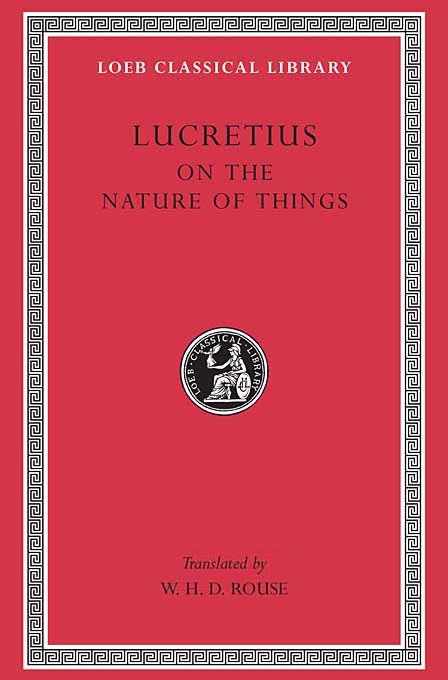
Lucretius,
On the Nature of Things translated by W.H.D. Rouse.
London: William Heinemann, Ltd., 1924.
London: William Heinemann, Ltd., 1924.
| Download |

Petronius with an English Translation by Michael Hezeltine;
Seneca Apocolocyntosis with an English Translation by W.H.D. Rouse.
London: William Heinemann, Ltd., 1925.
Seneca Apocolocyntosis with an English Translation by W.H.D. Rouse.
London: William Heinemann, Ltd., 1925.
| Download |
W.H.D. Rouse and Reginald Bainbridge Appleton,
Latin on the Direct Method.
London: University of London Press, 1925.

Photograph taken in 1931, posted at ARLT Weblog
Here is a surviving fragment of a letter he wrote to a former pupil.
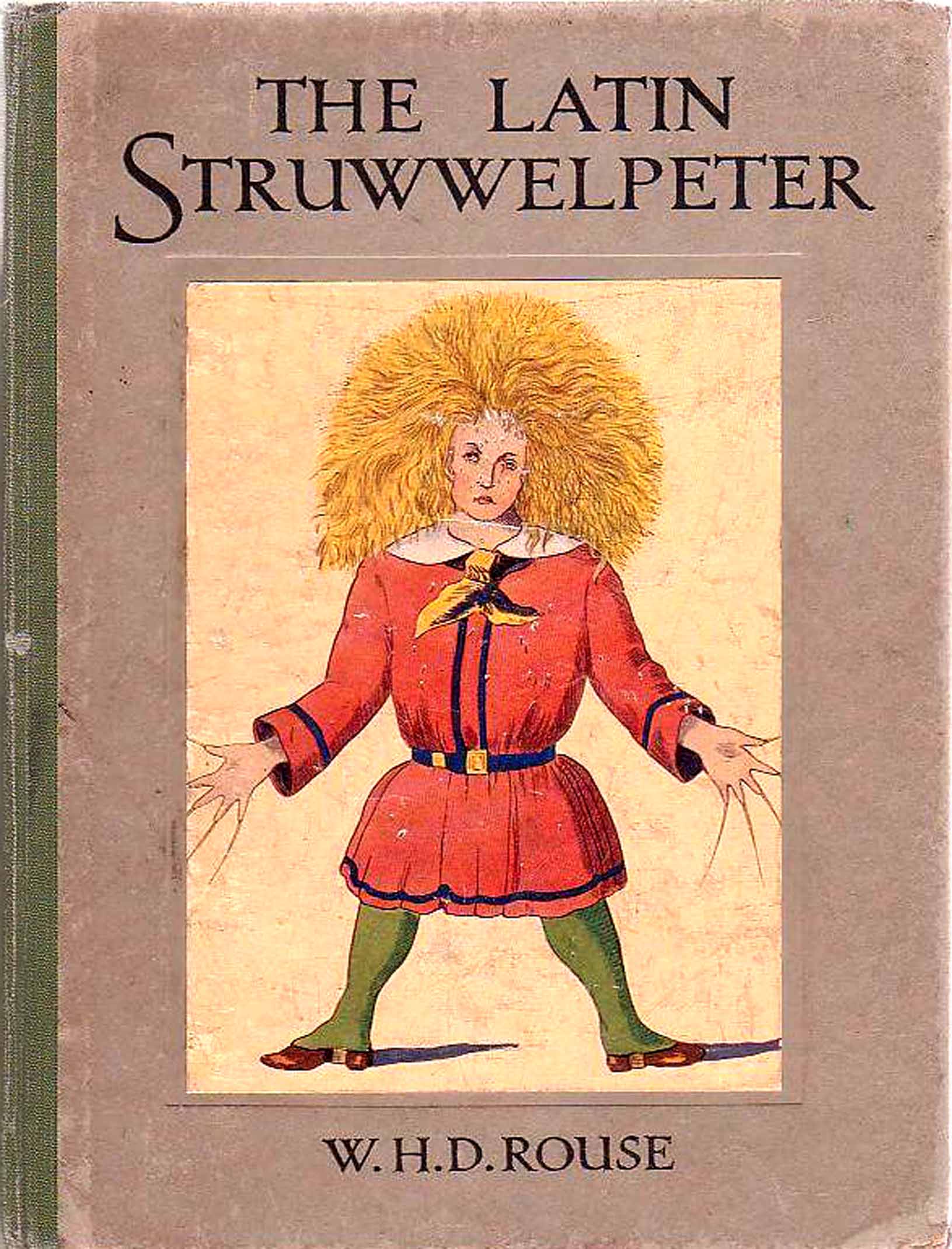
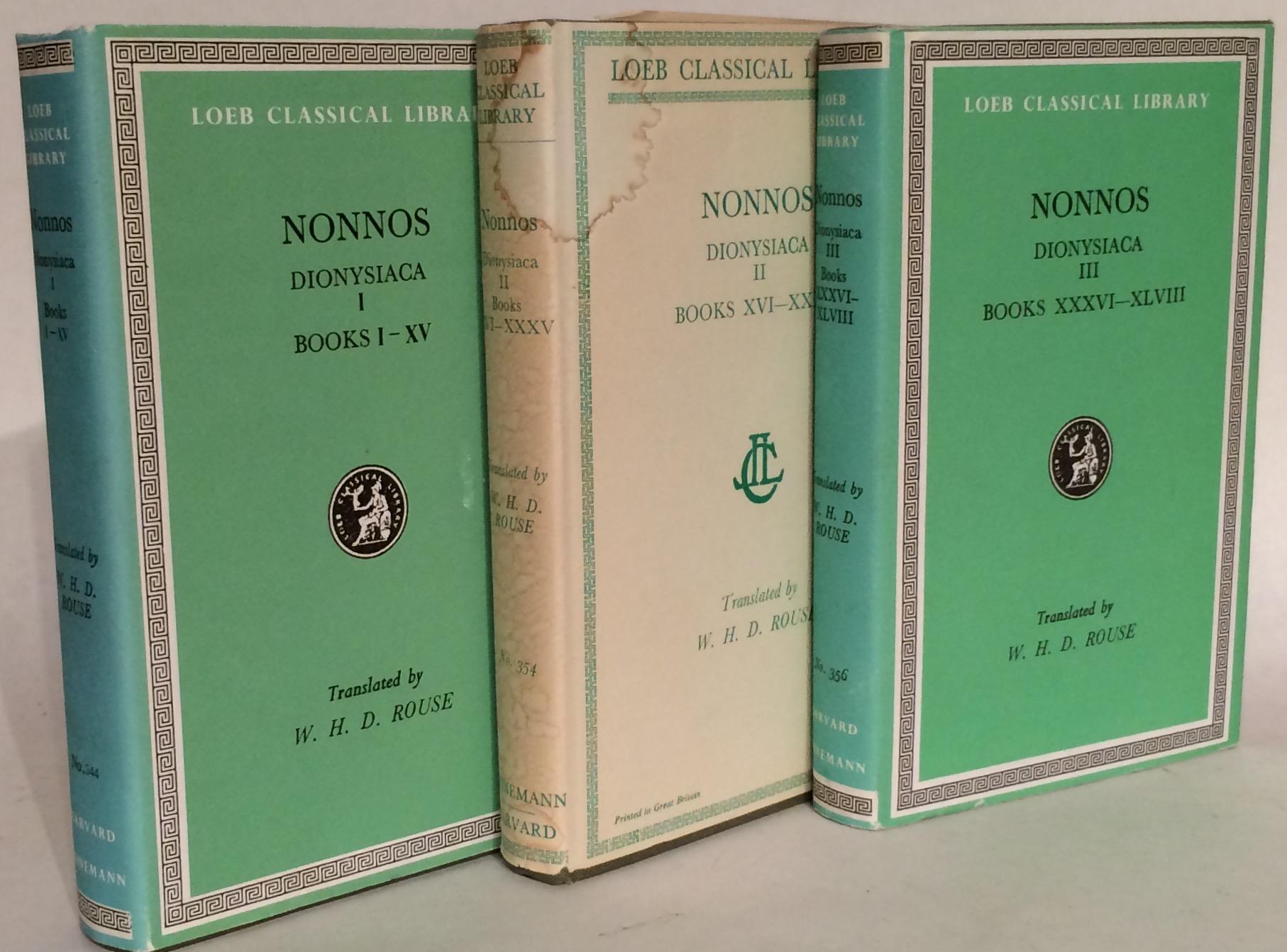
Did Herr Meidinger ever guess that this was the start of something big?
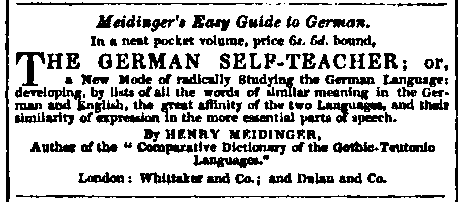
The Literary Gazette, and Journal of the Belles Lettres, Arts, Sciences, &c.,
no. 1321, Saturday, 14 May 1842, p. 335
 Jerome Nicholas Vlieland also reconfigured Meidinger père’s work for English speakers.
Actually, he seems to have taken considerably more from Ollendorff than from Meidinger.
An 1851 imprint of this work is available here.
Vlieland’s volume, predictably, is as irresistible as Ollendorff’s and Kendrick’s volumes:
“Our servant is stupid, more stupid than our coachman, who is the most stupid of all servants I know.
My grapes are good, but yours are better; and those we have here are the best of all grapes, because your sister has given them to us.
Gunpowder was discovered by a monk, in the year 1382.
Mr. Rumoni has squandered away all his property.
Yesterday he wanted to discharge his servants, but he could not pay their wages.
His creditors have sold his houses, his carriage, his horses, and his gardens, and have left him only his clothes and his dogs, which he loves more than his friends.
He begged lately one of his friends to lend him some money, who answered him:
I excuse your request, excuse (you) my refusal.
Your master has related all this to my aunt, begging her to keep it a secret.
My aunt has related it to her uncle, her uncle to his servant, his servant to my sister, and the latter to her lover; and he related it to me.
Pray tell it to no one but your wife.
Whilst they were talking one day of their good children, a cat, I think it was ours, took away the roast chicken, which the servant had put on the table.
That man is very fond of dogs, and of all those who are fond of them.
He will not marry his daughter but to him who has also that passion: he pities those who are not of his taste.
Why are your sisters always dull?
They are not always so; they are sometimes in a very good humour, particularly the youngest, who is sometimes so merry, that she makes me fear for her health.”
Oh, heavens above! This is marvelous composition!
Pray tell, what philosopher could write this well? What academic could write this well? What politician could write this well?
For what it may be worth, here is
an advertisement for Vlieland’s other works, some of which appear not to be at any libraries anywhere.
We can find his First Italian Reader on Dutch Google Books.
His Italian Grammar, though, appears to have vanished.
Jerome Nicholas Vlieland also reconfigured Meidinger père’s work for English speakers.
Actually, he seems to have taken considerably more from Ollendorff than from Meidinger.
An 1851 imprint of this work is available here.
Vlieland’s volume, predictably, is as irresistible as Ollendorff’s and Kendrick’s volumes:
“Our servant is stupid, more stupid than our coachman, who is the most stupid of all servants I know.
My grapes are good, but yours are better; and those we have here are the best of all grapes, because your sister has given them to us.
Gunpowder was discovered by a monk, in the year 1382.
Mr. Rumoni has squandered away all his property.
Yesterday he wanted to discharge his servants, but he could not pay their wages.
His creditors have sold his houses, his carriage, his horses, and his gardens, and have left him only his clothes and his dogs, which he loves more than his friends.
He begged lately one of his friends to lend him some money, who answered him:
I excuse your request, excuse (you) my refusal.
Your master has related all this to my aunt, begging her to keep it a secret.
My aunt has related it to her uncle, her uncle to his servant, his servant to my sister, and the latter to her lover; and he related it to me.
Pray tell it to no one but your wife.
Whilst they were talking one day of their good children, a cat, I think it was ours, took away the roast chicken, which the servant had put on the table.
That man is very fond of dogs, and of all those who are fond of them.
He will not marry his daughter but to him who has also that passion: he pities those who are not of his taste.
Why are your sisters always dull?
They are not always so; they are sometimes in a very good humour, particularly the youngest, who is sometimes so merry, that she makes me fear for her health.”
Oh, heavens above! This is marvelous composition!
Pray tell, what philosopher could write this well? What academic could write this well? What politician could write this well?
For what it may be worth, here is
an advertisement for Vlieland’s other works, some of which appear not to be at any libraries anywhere.
We can find his First Italian Reader on Dutch Google Books.
His Italian Grammar, though, appears to have vanished.
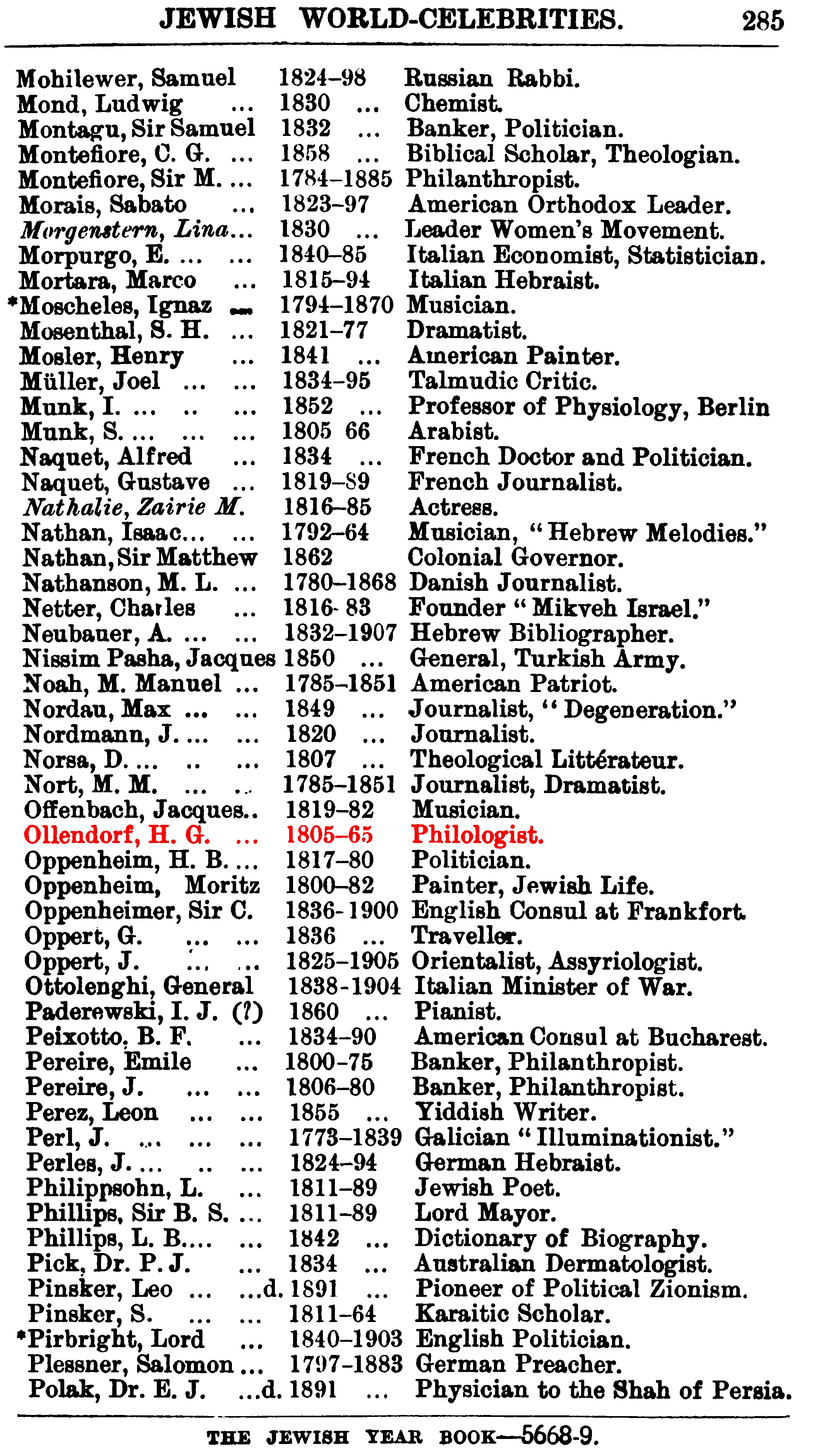
Rev. Isidore Harris, M.A., The Jewish Year Book. An Annual Record of Matters Jewish.5668-9.
(9th September 1907 – 31st December, 1908.)
(12th Year of Issue. London: Greenberg & Co., Ltd., 1907), p. 285
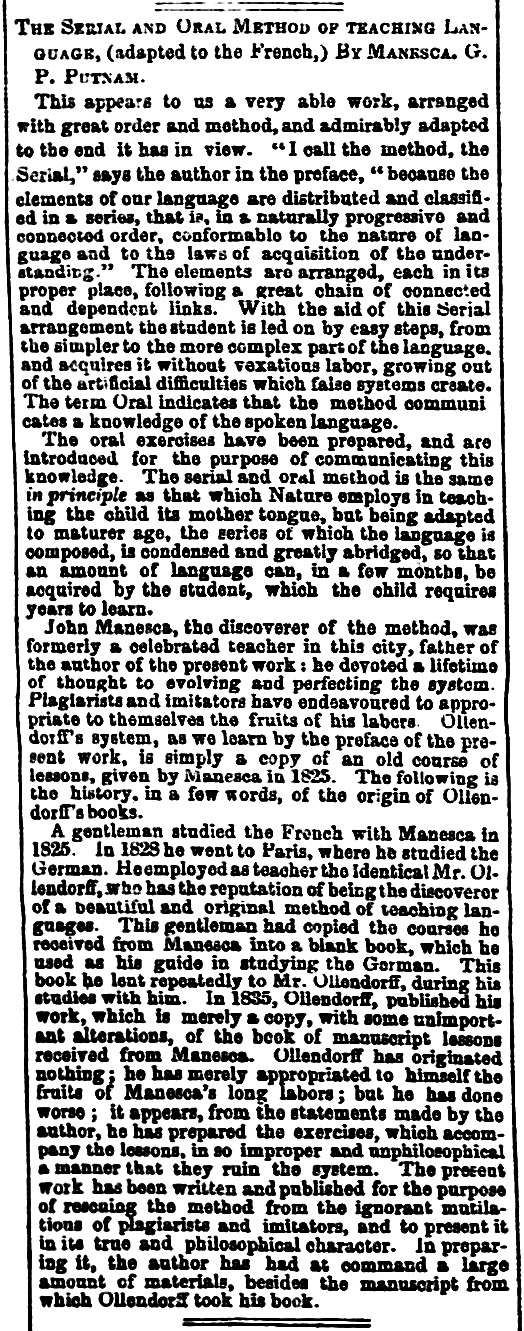
The Evening Post (New York, NY), Tuesday, 5 August 1851, p. 2.
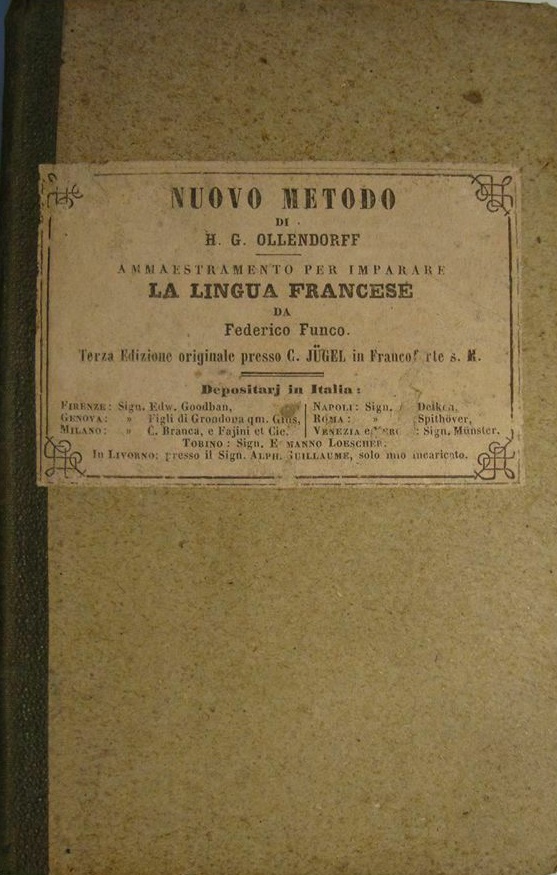
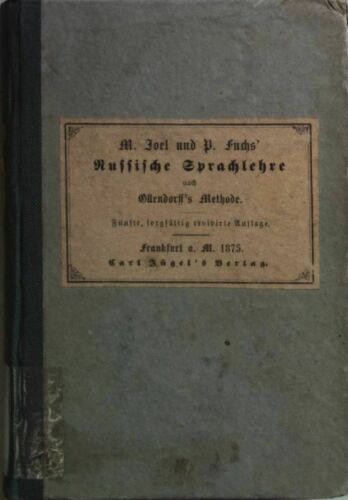


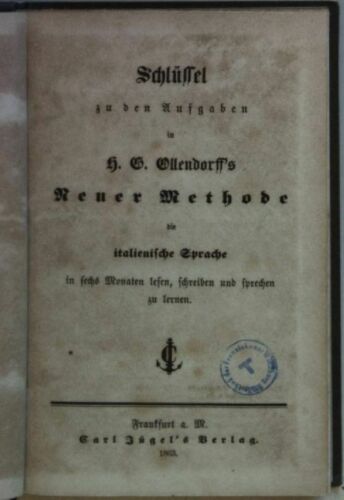

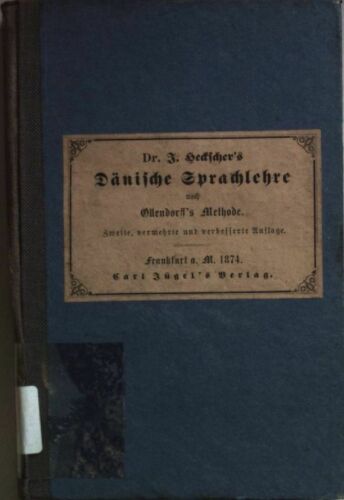
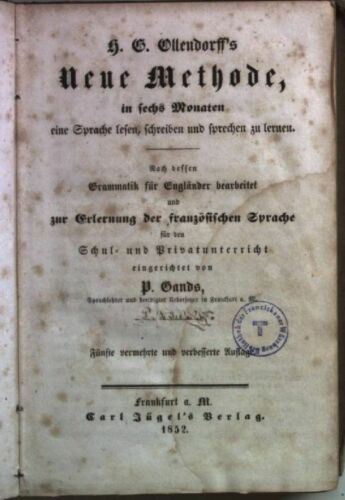

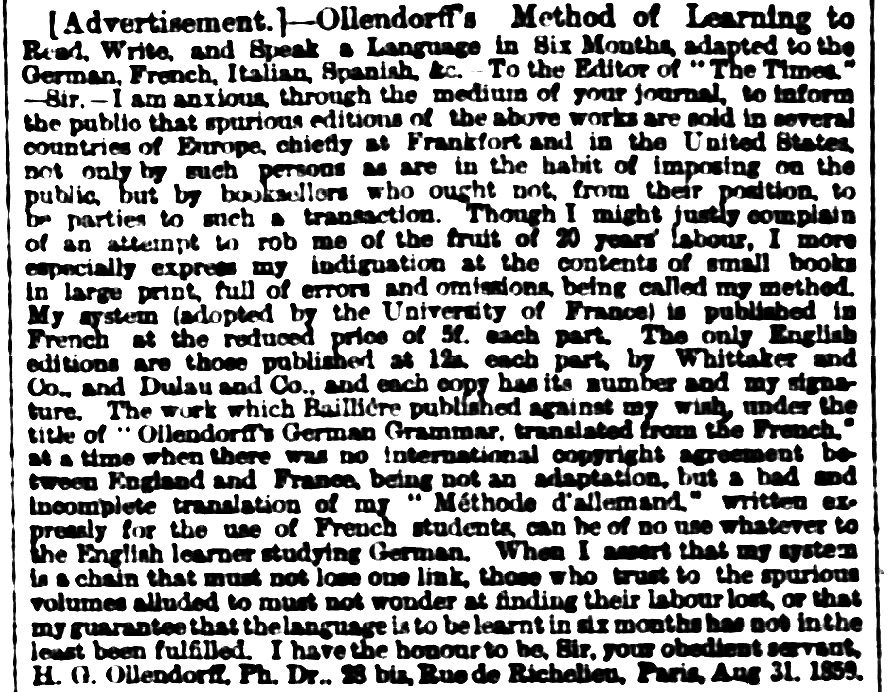
The Times, London, no. 23,403, Monday, 5 September 1859, p. 11, col. 4.
>

The Times, London, number 20,668, Tuesday, 10 December 1850, p. 7.
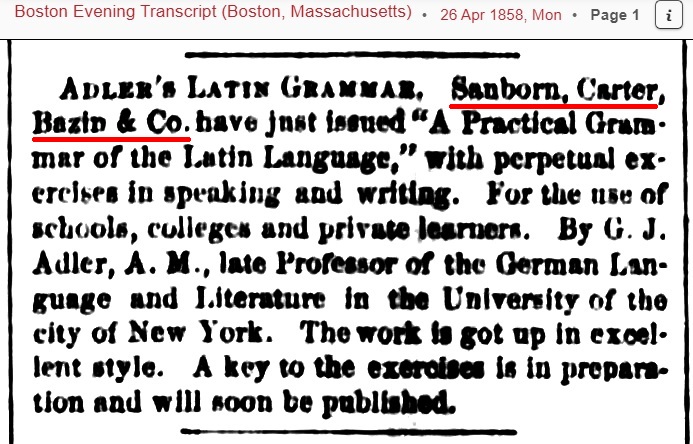
“Just issued”? Issued surely in late 1857. By the time this notice was published, Sanborn, Carter, Bazin had been reorganized and renamed.
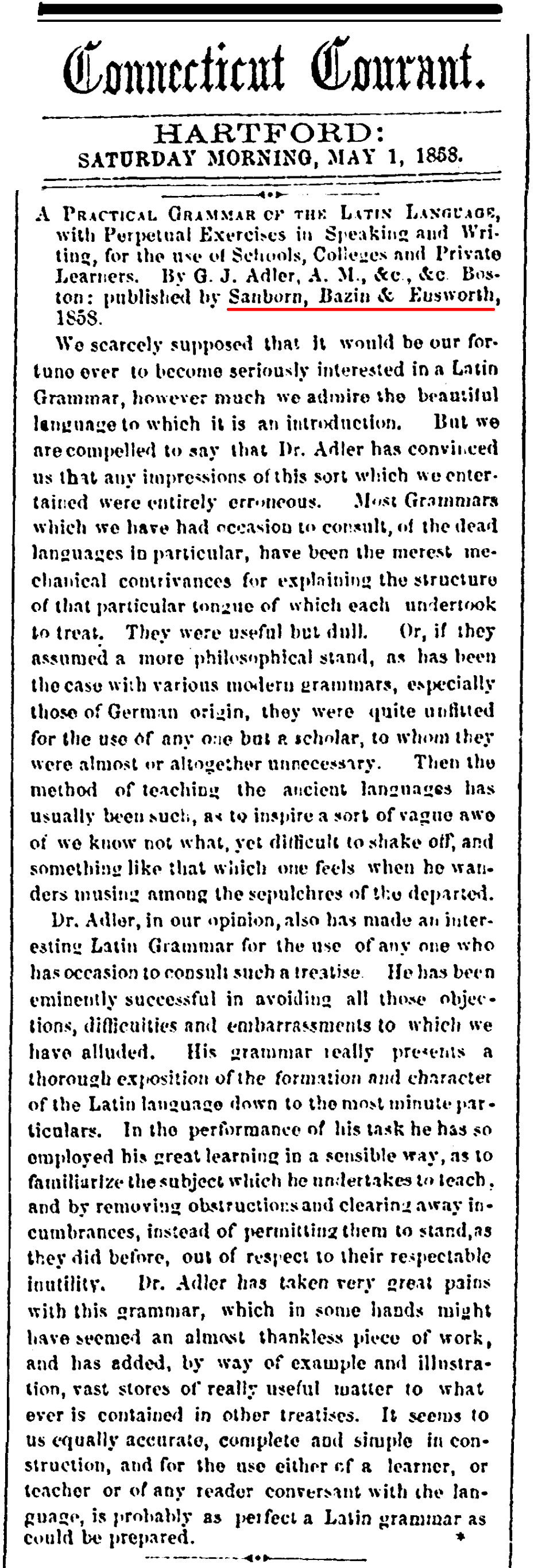
Here ya go. Five days after the previous notice, we see that Sanborn, Carter, Bazin was already Sanborn, Bazin & Ellsworth. See?
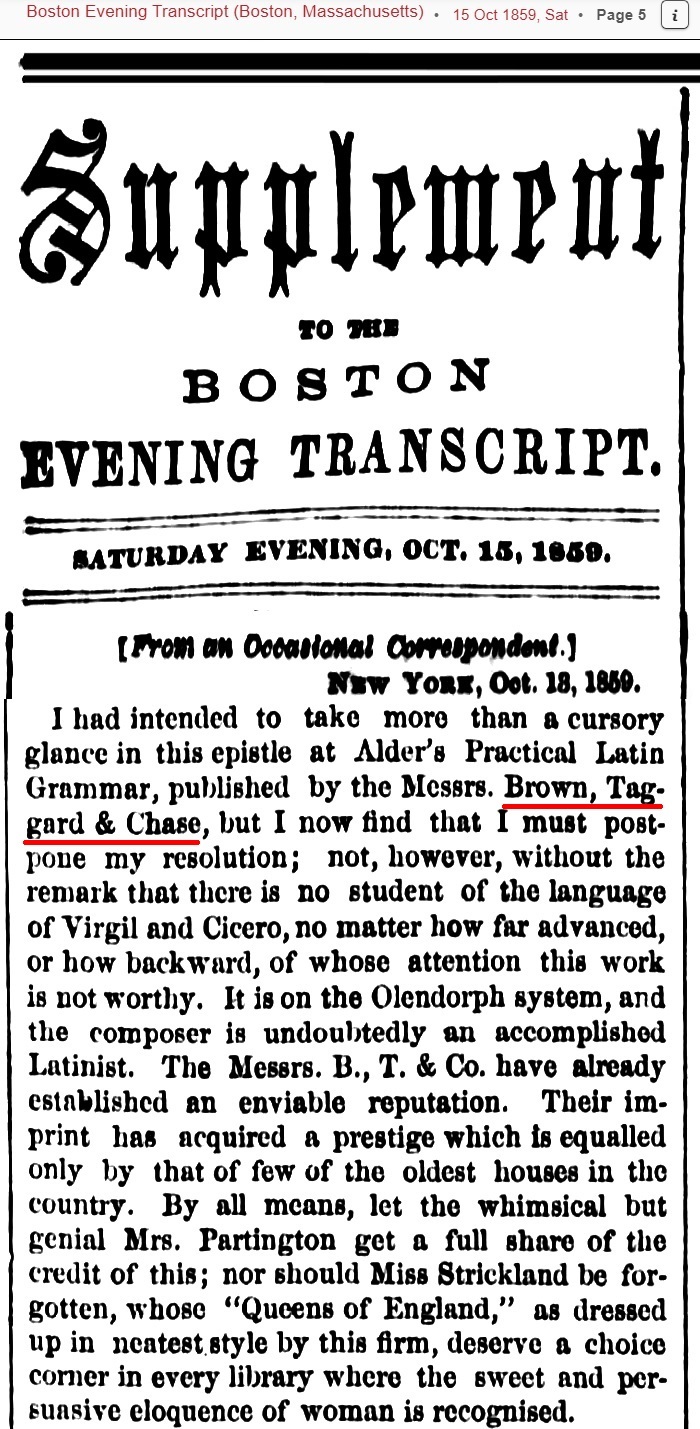
Brown, Taggard & Chase? Let me think. Sanborn, Bazin & Ellsworth closed up shop by sometime in 1859, as far as I can discern. This review would indicate that Brown, Taggard & Chase purchased the contract upon Sanborn’s closure, and I suppose that BTC purchased the entire stock as well, and I bet the entire stock was just five or ten copies. BTC probably just pasted its name over SBE’s name on the title page and maybe on the spine. A quick check reveals that BTC was operating at least as early as 1849 and lasted at least until 1866. It does not seem to have had much success. Only just now do I discover that SCB and BTC had already had business understandings:


Boring data, huh? Well, the boring data tell a little story if you know how to listen. After a decade and a half, Appleton began publishing just a few school textbooks. That was in 1844. We can infer that these were successful, and so in 1846 he decided to add the best textbooks of all to his catalogue. First would be Ollendorff’s German course, because there were lots of Germans around, and German was the principal language of scholarship. Everybody wanted to speak German, a notoriously difficult language. So, he would start with German. Besides, Ollendorff was all the rage in Europe, so why not jump onto the bandwagon? Schools all taught Latin, and the Latin texts were aversion therapy at best, but most were designed only as sadistic punishment. So, Appleton brought in the popular Arnold and decided to give Arnold’s text a tiny hint of that trendy Ollendorffian treatment. Once those two works were recognized, he brought in Ollendorff’s French course, since French was the Number Two language of scholarship, and it was a language that was rather widely spoken in the US and Canada already. The big languages in the US at the time, as you surely know, were English, Comanche, Spanish, and French. If you wanted to trade, you had to know all four. So, Appleton brought in French, even though the people who needed to know French pretty much all knew it already. Then it was time for Ollendorff’s Italian. Why? I don’t know. It just was. Probably just because the course was freely available for plundering, I guess. What about Spanish? No merchant could trade across the continent without having a command of Spanish, but the only decent Spanish course (Rabadan/Manesca’s) was out of print, and it seems that the American rights were tied up. So Appleton hired some guys to translate Ollendorff’s French course into Spanish. Problem solved. Vingut, who was working on an identical project, found himself a day late and a dollar short, and so he swapped words in Ollendorff’s sentences and scrambled the text and submitted histopsy-turvy result to a rival publisher.
Then Appleton croaked, and so the new directors, deciding that the Latin course was selling nicely,
brought in Arnold’s companion Greek intro as well,
and repeated Arnold’s false claim that the course followed Ollendorff’s basic method.
The new directors then did something truly bizarre.
Though they were already publishing Ollendorff’s French course, credited to Jewett,
they decided to publish a SECOND Ollendorff French course.
Why? I don’t know.
Jewett’s version was just a reprint of Ollendorff’s edition, with few changes.
Value’s rival version could thus not be a duplicate, and so it had to be revamped,
and, once again, the sentences were broken in two and reconnected in incoherent ways.
Whatever.
Arnold’s Greek course, alas, despite its claim of being Ollendorffian, was not doing the trick.
There was actually no good Greek course anywhere (to this day, there still isn’t).
So the Appleton firm hired Uncle Asahel to make a tiny little book vaguely reminiscent of a miniature Ollendorff,
and the directors liked it so much that, before he was finished, they hired Harkness to put it into Latin.
And now that Harkness was on contract, well, why not have him upgrade the Arnold/Spencer course, too?
Gladly!
Since a lot of Americans knew Spanish but needed to learn English and/or French (remember the Louisiana Purchase?),
the Appleton directors stole those courses from Ollendorff, too.
What about all the German families who didn’t know a word of English?
Well, why not steal Gands’s pirated Ollendorff, too? Sure.
Adler, who had started the ball rolling a dozen years earlier, now closed the cycle with a Latin course,
which he created by translating and re-rigging Ollendorff’s German course.
By the time he was done, well, Appleton was now on an Ahn kick and had lost all interest in bringing in new Ollendorffs or Ollendorff wannabes.
So, Adler submitted his MS to Sanborn, a minor publisher that was teetering on the edge of oblivion,
and that had no publicity budget, and so the book died without even having been noticed.
That’s the story that’s hidden in that boring data.




Fascinating, isn’t it? I mean, really, could you invent a story like this? Charles Rudy must have descendants. He must have heirs. Nobody in the know wants to talk with me, though. Dead silence. No responses. Stonewalled. Unless I can personally dig through the libraries and historical societies in the Schnecksville/Lehigh areas, I’ll never be able to trace anybody down. The money.... The time.... Oy vey.
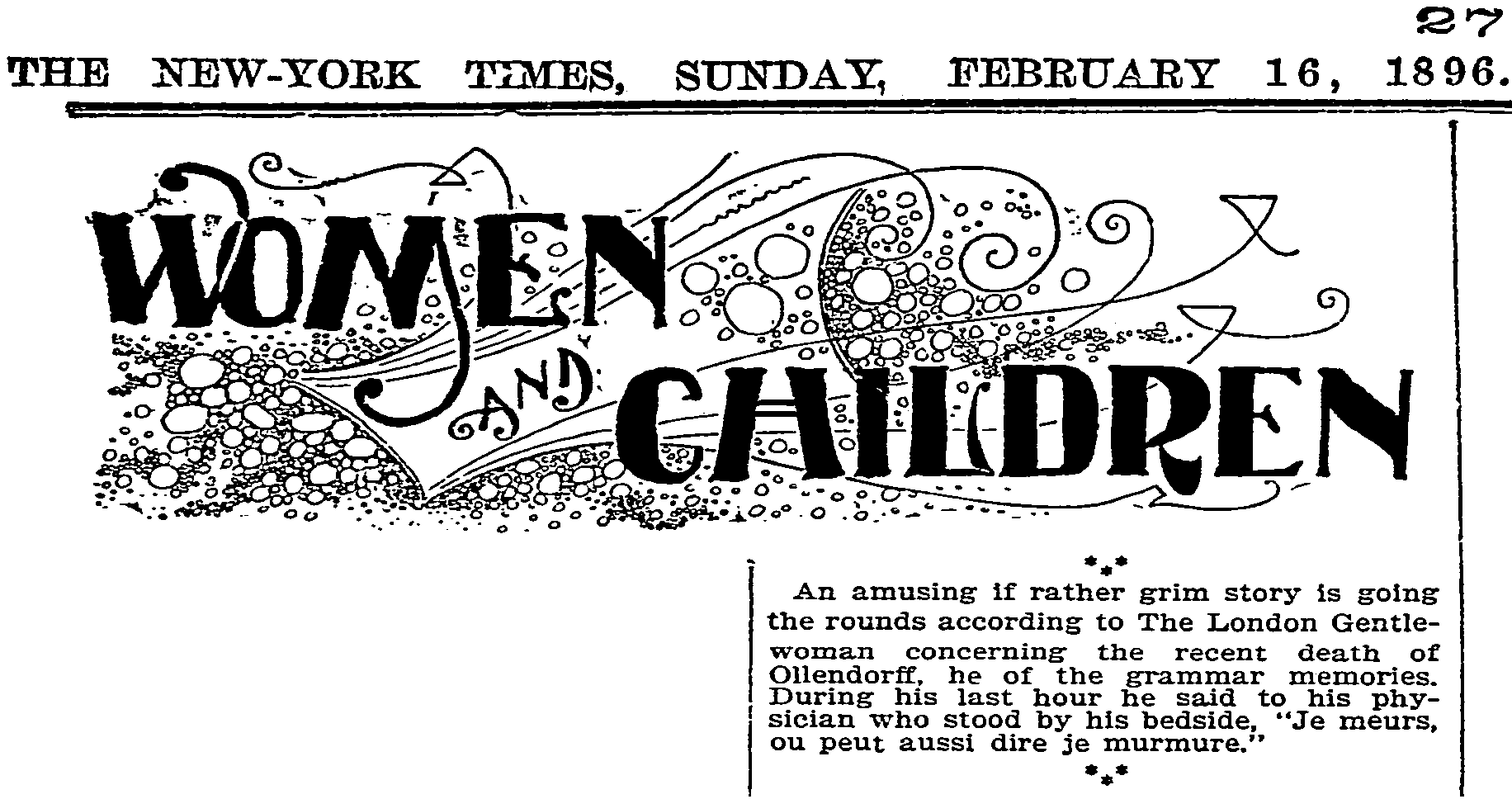

Latin on the Direct Method.
London: University of London Press, 1925.

Photograph taken in 1931, posted at ARLT Weblog
Here is a surviving fragment of a letter he wrote to a former pupil.
W.H.D. Rouse,
The Sounds of Ancient Greek
and Passages from the Greek Classics.
Linguaphone Institute: London, [1932].
and Passages from the Greek Classics.
Linguaphone Institute: London, [1932].
W.H.D. Rouse, Linguaphone: Latin Records; The Direct Method Applied to Latin.
New York: Linguaphone Institute, [1932].
The teacher’s manual is embedded below. If it is not visible on your screen, just look at it here: Vivarium novum.
New York: Linguaphone Institute, [1932].
The teacher’s manual is embedded below. If it is not visible on your screen, just look at it here: Vivarium novum.
Ready? Here we go. Linguaphone Latin Records by W.H.D. Rouse, M.A., D.Litt.
Here are the ten lessons, between two and a half and three minutes each.
Press the play button below, and follow along in the above teacher’s manual.
If you are unable to play the audio directly from this site,
download the file here.
If you’re on a Mac, control+click and save-as. If you’re on Windows, right-click and save-as.
Since these are now in the public domain, I paid an audio-engineer friend to run these through his magical billion-dollar machinery to clean them up
and make a dupe that sounds better than the original.
(Where else except on this Caligula site will you find this material so easily available?)
There is much of interest here.
First of all, Bill Rouse doesn’t pronounce Latin correctly.
He pronounces the v as an English v, which is correct for ecclesiastical Latin, but not for Classical Latin, when it was pronounced like a w (yes, I know I’m oversimplifying).
He often pronounces the long o as an Italian o but simply holds it three times as long. Wrong.
In Classical Latin, the long o sounded like awe, awful, caught, bought, fought.
In an effort to drill home the idea of long and short syllables, he makes the short ones super-short and the long ones super-long.
That sounds grotesque, but it does get the point across.
He had retired in 1928, but the three students were not students from four years earlier.
Their voices are awfully young, and so it is clear to me that they were current students.
Indeed, Rouse had opened some summer schools to pass his time away.
These three boys were probably already up to lesson 50 or more when they agreed to be recorded doing lessons one through ten.
That was a good decision, because they didn’t waste time struggling through their responses.
They were as quick as could be and got everything perfectly right.
We can hear that Bill Rouse was never in the least bit threatening, but was instead completely comforting and reassuring.
His simple sentences entirely removed the element of intimidation.
Most Latin teachers never speak Latin in class, or anywhere else, because they don’t know the language.
Rouse devotes his class time to speaking Latin, and he periodically hands teaching duties over to his students, one by one.
Other Latin teachers almost immediately plunge their hapless students straight away into Cicero and Vergil and Ovid.
That’s enough to scare any student to death. Those readings are far too difficult for any beginning student to master.
Rouse, on the other hand, starts with simple sentences about frogs and mice and maids,
and before the end of the first week he introduces his students to “The House That Jack Built.”
Remember that story? When we were little, that was one of the amusing exercises that helped us learn to speak English.
It serves the same purpose in Latin.
This is how languages should be taught. This is how languages are never taught.
Note something else as well.
Here we have students who are required to participate constantly.
There is no opportunity to sit in the back and doze off or scroll through Facebook messages.
There is no lecturing, and thus there is no need to scribble down illegible notes at a mad pace of 300 words/minute.
Since the students are all active participants, there is no way they can make more than a few mistakes,
and there is no way they can make those few mistakes more than a few times.
There is no way that a star student can outshine the others,
and there is no way that a dull student can lag behind.
The students must all keep pace, which is never difficult for them to do.
Since the students are, for all intents and purposes, performing perfectly, what good would a midterm exam or a final do?
What would a written test demonstrate? Nothing.
This is the finest example of teaching that I have ever witnessed.
Probably no teacher on the planet teaches like this anymore.
I certainly know of no one anywhere in the world who follows this example.
Why is this teaching method extinct?
Now, for 34 years I was certain I would never lay eyes on these shellac discs.
Then, just recently, I discovered that this set has popped up on various auction sites.
Amazing. At last I was able to acquire a set.
 |
 |
 |
 |
 |
I’m amused by the way this listing was echoed on eBay Spain and on eBay Hong Kong.
Note that this one, like one of the earlier listings, is in a generic Linguaphone album rather than in the |
Since this last item had no bidders, I was able to purchase it. Yay!
Linguaphone assured me by email that this is now public domain in the UK,
and, as far as they’re concerned, it’s public domain everywhere.
Since copyright laws vary from one country to another,
Linguaphone went further and gave me explicit permission to make and distribute copies of the recordings as well as of the teacher’s manual.
Now, this eBay item no longer included the teacher’s manual, but by the most astonishing coincidence,
a different eBay seller had that manual
on offer minus the records.
I did a Buy-It-Now and both the
manual
and the 78’s arrived on the same day. Reunited after heaven only knows how many decades.
As we all know, when it pours it rains.
Another copy, with the original cover but minus the instruction manual, popped up on Kijiji Canada, and I grabbed it so fast....
I just discovered that, in 1960, Horace Alfred Bevis White recorded a follow-up set:
Linguaphone. Latin Readings. A Selection of Well-Known Passages in Verse and Prose Read in the Restored Pronunciation.
A Handbook for Teachers. Written and Recorded by H.A.B. White.
I have the record set on order, but I can’t find the accompanying 45-page book.

Heinrich Hoffmann,
The Latin Struwwelpeter.
Translated by W.H.D. Rouse.
London and Glasgow: Blackie & Son, Ltd., 1934.
Translated by W.H.D. Rouse.
London and Glasgow: Blackie & Son, Ltd., 1934.
W.H.D. Rouse,
Latin Stories for Reading or Telling, to Wit: Beasts, Fools and Wise Men, the Famous Dinner-Party of Trimalchio, Horace’s Adventures on the Apulian Hills, with an Appendix of Greek & Latin Proverbs.
Oxford: Basil Blackwell, 1935.
Oxford: Basil Blackwell, 1935.

Nonnos Dionysiaca.
With an English Translation by W.H.D. Rouse. Vol. I.
London: William Heinemann, Ltd., 1940.
With an English Translation by W.H.D. Rouse. Vol. I.
London: William Heinemann, Ltd., 1940.
| Download |
Nonnos Dionysiaca.
With an English Translation by W.H.D. Rouse. Vol. II.
London: William Heinemann, Ltd., 1940.
With an English Translation by W.H.D. Rouse. Vol. II.
London: William Heinemann, Ltd., 1940.
| Download |
Nonnos Dionysiaca.
With an English Translation by W.H.D. Rouse. Vol. III.
London: William Heinemann, Ltd., 1940.
With an English Translation by W.H.D. Rouse. Vol. III.
London: William Heinemann, Ltd., 1940.
| Download |
Here are some lovely recollections of Bill Rouse’s life:
“In Memoriam:
William Henry Denham Rouse, Late Headmaster of the Perse School, Cambridge, and Founder of the Association for the Reform of Latin Teaching, Died 10th February 1950.
Resident of Frankfurt-am-Main, Johann-Valentin Meidinger
taught German, French, and Italian, via a standard grammar of his own creation.
His older brother, Johann Nicolaus Meidinger, did the same.
I have one of Nicolaus’s grammars in my possession, a course on Italian for French students.
It seems to be quite good, consisting of a little vocabulary, a little grammar, and then a half-page of French to put into Italian.
Valentin, in his own grammars, retained the typical 300 pages of fine-print technical rules,
but like his brother Nicolaus, and unlike typical instructors, he added some practice sentences.
The book with which we shall be concerned is his German grammar for French speakers.
Few copies are at
libraries,
but fortunately several editions are online for free and more are available for purchase from antiquarian booksellers.
Meidinger continually rewrote his volume, apparently as he matured and also as a response to problems in the classroom.
This book, in any version, certainly required a preceptor, as it was quite heavy-going,
with endless lists of grammar and endless lists of vocabulary.
The occasional dialogues and construing exercises were welcome reliefs from the austerity of the bulk of the course.
Nonetheless, this was definitely an improvement.
The posthumous editions, remarkably, were a further improvement still, with many more dialogues and much more practice.
Just for fun, I decided today, Sunday, 14 January 2018, to see what I could find for purchase on Abe Books
and for free download:
Did Herr Meidinger ever guess that this was the start of something big?
Meidinger’s son, Henry, reconfigured the course to be of use to English-speaking learners:
The German Self-Teacher; or a New Mode of Radically Studying the German Language (London: Whittaker & Co.).
I have not been able to get hold of this English edition.
If you happen to mosey on over to London or Frankfurt and are in the mood to copy it, I wouldn’t mind getting scans:
OCLC 561913035.
There must have been an antique copy on Amazon
once upon a time, but we all missed it.
Here are two advertisements for the book.
Note that the larger advert emphasizes the book’s handiness in procuring for the student a speaking knowledge of the language.
Such an emphasis would not be needed if this were a typical feature of a German grammar.

The Literary Gazette, and Journal of the Belles Lettres, Arts, Sciences, &c.,
no. 1321, Saturday, 14 May 1842, p. 335
 Jerome Nicholas Vlieland also reconfigured Meidinger père’s work for English speakers.
Actually, he seems to have taken considerably more from Ollendorff than from Meidinger.
An 1851 imprint of this work is available here.
Vlieland’s volume, predictably, is as irresistible as Ollendorff’s and Kendrick’s volumes:
“Our servant is stupid, more stupid than our coachman, who is the most stupid of all servants I know.
My grapes are good, but yours are better; and those we have here are the best of all grapes, because your sister has given them to us.
Gunpowder was discovered by a monk, in the year 1382.
Mr. Rumoni has squandered away all his property.
Yesterday he wanted to discharge his servants, but he could not pay their wages.
His creditors have sold his houses, his carriage, his horses, and his gardens, and have left him only his clothes and his dogs, which he loves more than his friends.
He begged lately one of his friends to lend him some money, who answered him:
I excuse your request, excuse (you) my refusal.
Your master has related all this to my aunt, begging her to keep it a secret.
My aunt has related it to her uncle, her uncle to his servant, his servant to my sister, and the latter to her lover; and he related it to me.
Pray tell it to no one but your wife.
Whilst they were talking one day of their good children, a cat, I think it was ours, took away the roast chicken, which the servant had put on the table.
That man is very fond of dogs, and of all those who are fond of them.
He will not marry his daughter but to him who has also that passion: he pities those who are not of his taste.
Why are your sisters always dull?
They are not always so; they are sometimes in a very good humour, particularly the youngest, who is sometimes so merry, that she makes me fear for her health.”
Oh, heavens above! This is marvelous composition!
Pray tell, what philosopher could write this well? What academic could write this well? What politician could write this well?
For what it may be worth, here is
an advertisement for Vlieland’s other works, some of which appear not to be at any libraries anywhere.
We can find his First Italian Reader on Dutch Google Books.
His Italian Grammar, though, appears to have vanished.
Jerome Nicholas Vlieland also reconfigured Meidinger père’s work for English speakers.
Actually, he seems to have taken considerably more from Ollendorff than from Meidinger.
An 1851 imprint of this work is available here.
Vlieland’s volume, predictably, is as irresistible as Ollendorff’s and Kendrick’s volumes:
“Our servant is stupid, more stupid than our coachman, who is the most stupid of all servants I know.
My grapes are good, but yours are better; and those we have here are the best of all grapes, because your sister has given them to us.
Gunpowder was discovered by a monk, in the year 1382.
Mr. Rumoni has squandered away all his property.
Yesterday he wanted to discharge his servants, but he could not pay their wages.
His creditors have sold his houses, his carriage, his horses, and his gardens, and have left him only his clothes and his dogs, which he loves more than his friends.
He begged lately one of his friends to lend him some money, who answered him:
I excuse your request, excuse (you) my refusal.
Your master has related all this to my aunt, begging her to keep it a secret.
My aunt has related it to her uncle, her uncle to his servant, his servant to my sister, and the latter to her lover; and he related it to me.
Pray tell it to no one but your wife.
Whilst they were talking one day of their good children, a cat, I think it was ours, took away the roast chicken, which the servant had put on the table.
That man is very fond of dogs, and of all those who are fond of them.
He will not marry his daughter but to him who has also that passion: he pities those who are not of his taste.
Why are your sisters always dull?
They are not always so; they are sometimes in a very good humour, particularly the youngest, who is sometimes so merry, that she makes me fear for her health.”
Oh, heavens above! This is marvelous composition!
Pray tell, what philosopher could write this well? What academic could write this well? What politician could write this well?
For what it may be worth, here is
an advertisement for Vlieland’s other works, some of which appear not to be at any libraries anywhere.
We can find his First Italian Reader on Dutch Google Books.
His Italian Grammar, though, appears to have vanished.
By the way, I would love to learn about Meidinger père et fils.
Wikipedia has a page about each,
Johann Valentin Meidinger and
Johann Heinrich Meidinger,
but the info is sketchy and minimal.
I want more more more more more.
Apparently, Henry Meidinger had a disciple (or clone?) in Sigmon Martin Stern. Take a look at
Studien und Plaudereien and
Studien und Plaudereien Im Vaterland.
Is that brilliant, or what?
Oh, there must be wonderful stories to tell here, but I don’t know most of them
and, even if I were to learn them, I wouldn’t have the time to share them.
Jean Manesca, or John Manesca as he called himself in New York, used something resembling the “direct method” in his classes.
It was more of a Q&A, with students taking copious notes.
Judging from what I can see on the printed page, I would make an educated guess that Manesca admired Meidinger’s texts and decided to go one further,
making his grammar and his teaching inductive rather than deductive.
Manesca’s progression of vocabulary was more or less the same as Meidinger’s, but he made a change in the method of presentation.
Meidinger had devoted the first hundred or so pages or so to tedious rules, before allowing students to explore the language proper.
Meidinger had brief dialogues and small collections of sentences for rendering into the other language.
He expected the instructors to make up for this deficit by the expedient of improvisation, engaging the students in spontaneous but carefully guided conversation.
Manesca instead took a cue from
Johann Heinrich Philipp Seidenstücker,
who penned a rival text based on elementary dialogues.
Manesca combined the two methods and improved upon them,
plunging the students straight away into simple sentences in the language —
pages and pages of simple sentences, each sentence building upon the previous ones.
For instructors only, Manesca published his French course for English speakers so that others could adopt his method.
His book was most definitely not for self-learners,
and yet it would work for self-learners, since the exercises are so copious.
Manesca’s French course is remarkably similar in style, structure, and technique to Father Most’s Latin by the Natural Method,
and so I assume that Father Most was familiar with Manesca’s work.
Manesca’s book, originally published in 1834, was revolutionary:
An Oral System of Teaching Living Languages; Illustrated by a Practical Course of Lessons, in the French,
through the Medium of the English. It looks like a great book.
I mean, come on, look at Lesson 2: “Avez-vous le rat? Avez-vous mon rat? Avez-vous votre rat? Quel rat avez-vous?
Avez-vous le gros rat? Avez-vous mon gros rat? Avez-vous votre gros rat?” Can life get any better than this?
A friend noted that this is like learning music.
When you take your first lesson on the piano, you don’t begin with Liszt’s “Hungarian Rhapsodies.”
You learn one note. Then you learn a second. Then you play them both. Then you learn a third.
Then you play them in every possible configuration and variation.
Then you learn a chord. Then you learn a second. Little by little you build up your skills.
Music teachers still teach this way. Language teachers still don’t.
Here’s a little tribute by his son, Louis Manesca, which prefaced the 1856 revised edition of his book:
Twelve years after its first publication, Manesca’s French course was reconfigured into a Spanish course:
Don Cárlos Rabadan,
Manesca’s Oral System of Teaching Living Languages; Illustrated by a Practical Course of Lessons in the Spanish Language,
through the Medium of the English (NY: Spanish Printing Office, 1846).
Looks dreamy. Wish I could find an original.

Rev. Isidore Harris, M.A., The Jewish Year Book. An Annual Record of Matters Jewish.
(12th Year of Issue. London: Greenberg & Co., Ltd., 1907), p. 285
This is when we meet Heinrich Gottfried Ollendorff, a
Prussian/Pole whose family had settled in Rawicz in 1806.
By the 1820’s he was living in Paris, earning his living as a German tutor.
Now that I look at Meidinger’s course again, I can detect Ollendorff’s thought processes.
He began his career as a language tutor while in his early 20’s, prior to 1828, teaching German to French students.
He chose as his text
Jean-Valentin Meidinger’s course,
which was the best available.
Like Manesca, He was also influenced by Johann Heinrich Philipp Seidenstücker.
He quickly discovered that his students were having trouble with German declensions,
which is a topic far more intimidating than nuclear physics.
He worked out a way to simplify the topic and make it approachable rather than terrifying,
and he then decided to publish a little booklet about the matter.
That was in 1831.
He hired a printer, published the volume himself, and sold it from his home:
La déclinaison allemande déterminée.
His name was misspelled on the title page.
By 1846, when he was on his seventh edition, he had changed the title to
Introduction à la méthode Ollendorf pour apprendre à lire, à écrire et à parler une langue en six mois,
appliquée à l’allemand, ou la déclinaison allemande déterminée; accompagnée d’un traité sur le genre des substantifs à l’usage de tous les établissements d’instruction, publics et particuliers, de l’un et de l’autre sexe.
You don’t care that he changed the title, do you?
Though a minor detail of no seeming significance, it will come to constitute an intriguing hint of evidence regarding the creation of his later Latin course.
This slender work was later published in English:
Introductory Book to Ollendorff’s New Method of Learning to Read, Write, and Speak a Language in Six Months, Adapted to the German,
Containing also a Definition of All the German Declensions and Rules on the Gender of Substantives: For the Use of Schools and Private Teachers
(London: author’s residence, 1841).
Now that he had made that much progress, he began to ponder a little more.
While instructing by means of Meidinger’s course,
he had to improvise, verbally, every day, all the time, in order to give his pupils practice.
Now that I’m losing myself in his thoughts, I can detect a little something more.
At the very beginning of his teaching career,
a student,
Albert Brisbane, Esq.,
insisted on being taught German in the same way that Manesca had taught him French.
Brisbane loaned his earlier classroom notes to Ollendorff, who used them as a template.
Ollendorff must have been stunned.
What he had been improvising, Manesca had fully scripted.
He saw that he could apply similarly full scripts to Meidinger’s plan.
He broke Meidinger’s lessons into smaller parts and then added ten or twenty times the practice.
That is how and why he decided to write his own course.
Meidinger opened his lessons with sentences about princesses and counts and castles.
Manesca, on the other hand, opened his lessons with sentences about hats and salt and tables.
Ah. Students could relate to this much better.
So, Ollendorff copied the vocabulary from Manesca’s first six lessons and made similar sentences,
but after that, he diverged from Manesca’s text.
It was the copying of some of Manesca’s early vocabulary that led to the vicious but widespread rumor
that he had done nothing more than plagiarize the earlier author.
Manesca had wanted his students to lose themselves in the new language.
That was fine and good for a “direct method” course under the charge of an instructor.
Ollendorff, on the other hand, considerably more influenced by Meidinger,
wanted his German grammar to be equally useful to the classroom and to the self-learner ,
which is why he abandoned the “direct method” for the next-best thing.
Instead of having students lose themselves in the new language, he would force them to convert their native language into the new language — aloud.
In this he followed Meidinger.
Beginning right at the beginning, he filled his volume with so much practice that a diligent student would not be able to fail.
In this, he followed Manesca.
Despite the copying, anyone can compare Manesca’s book and Meidinger’s book with Ollendorff’s books
to determine that Ollendorff was in many ways original.
Still, though, Ollendorff haughtily denied that he had taken anything at all from Manesca, and disparaged Manesca’s book as crude.
He gave all credit to Meidinger.
It’s a strange business, yes? (Humans, sigh, I’ve never understood humans.)
Manesca’s son Louis was not amused.
Some decades later, when he issued a revision of his father’s French grammar,
he had some harsh words for Herr Ollendorff:
This quickly became the received wisdom, and it is still echoed today, as we can see from
“Ollendorff’s Method: The Plagiary of Manesca?”
The Boston Language Institute, 22 February 2015.
Looking at Manesca’s French grammar side by side with an Ollendorff grammar reveals powerful similarities.
There is no question but that Ollendorff took inspiration from Manesca,
but he took even more from Meidinger.
To their formulæ he added much of his own.
In my judgment, I cannot dismiss Ollendorff a plagiarist.
He was building upon what had come before.
Remember also, as we discovered above, when Thomas Kerchever Arnold wrote his original (as yet unpublished) course in Classical Greek,
he openly admitted that he copied Ollendorff’s plan exactly.
When he did publish portions of his course, piecemeal, his claim did not raise eyebrows.
It did not elicit plagiary charges.
It did not result in legal action.
Arnold copied the plan. He did not copy the text.
The same holds true for Ollendorff:
He copied much of the plans laid out by Meidinger and Manesca, but he did not copy their texts or their exercises.
(Oh, and if you’re curious:
Albert Brisbane, Esq.
I do not know if he was any relation to the other
Albert Brisbane.
Oh, and as for the Mr. Pinney who earned Manesca fils’s ire,
he was Norman Pinney, A.M., author of
The Practical French Teacher; or, a New Method of Learning to Read, Write, and Speak the French Language [NY: Huntington & Savage, 1849]
and compiler of an
exercise book; and also coauthor with Juan Barceló of
The Practical Spanish Teacher; or a New Method of Learning to Read, Write, and Speak the Spanish Language in a Series of Lessons: with a System of Pronunciation; a Synopsis of Grammar; and a Table of Spanish Verbs [NY: Huntington & Savage, 1855].
Pinney did not copy Manesca at all.
He copied Ollendorff, though he altered and abridged the exercises.
Avarice is the word that comes to mind.
Methinks the younger Manesca was claiming too much probably in the hopes of convincing a cutthroat lawyer to siphon money for him.
If that was indeed his plan, it didn’t work.
For what it is worth, Louis Manesca’s revision of his father’s work is available
online, and you can follow along on
YouTube.)
As for Manesca père, I am not aware that he ever took legal action in this matter.
Even had he wanted to, I don’t think he would have had a case.
Remember, this was the 1800’s.
It was not a criminal offense to copy a template for an instruction book.
It was an offense to copy the text, to copy the exercises, yes;
but it was not an offense to copy the general plan.
To take this further, when we go to the library or the book shop and look at a dozen or so different instruction manuals in, say, German,
we discover that they are all about the same:
same method, pretty much the same vocabulary, pretty much the same presentation of grammar.
They all copy one another.
They don’t copy one another’s exercises or wording,
but they all copy one another’s basic template.
Nobody considers this plagiary.
(With a new legal precedent, this appears to have changed, at least in regard to pop music.
Robin Thicke was successfully sued for plagiary.
The court agreed with the plaintiff that “Blurred Lines”
was a copy of Marvin Gaye’s “Got to Give It Up.”
Not familiar with these pop tunes, I looked them up and listened to both.
I’ll be darned if I can find the smallest similarity.
An argument that prevailed in court was that the persistent percussion beat in the background is identical.
No it isn’t.
With this legal precedent in hand, theoretically anything we say or do or make can be considered plagiary.
I wonder what bearing that ruling has on
this brilliant gem.
This story puts me in mind of Roberto Rossellini’s suit against Gore Vidal for using the same public-domain source for a movie script.
We’ll never know how the court would have ruled, since RR died before the case could be heard.
It was an Italian case, and so I suspect that the ruling would have been worse than asinine, but, really, we’ll never know.
What has the world come to?)
Joining me now to add a middle-of-the-road perspective is the Reverend Samuel Osgood,
“Ollendorff’s German Method,” in The New-York Quarterly, January 1854:
So, as we see, though Rev. Osgood fully agrees with the charge of plagiary,
he nonetheless praises Ollendorff’s work to the hilt.
To the best of my knowledge, Herr Ollendorff developed
six and only six and no more than six courses.
Here are all eight of them, and we’ll get to the ninth later:
1833, German (for English, French, Italian, and Spanish pupils)
1835, French (for English, Italian, German, and Spanish pupils)
1846, English (for French, German, Italian, and Spanish pupils)
1846, Italian (for English, French, German, and Spanish pupils)
1857, Spanish (for English, French, and German pupils)
1866, Latin (for French and Spanish pupils, published posthumously)
1872, Russian (for French and German pupils, written probably by his son)
1883, Portuguese (for French pupils, written probably by his son)
1835, French (for English, Italian, German, and Spanish pupils)
1846, English (for French, German, Italian, and Spanish pupils)
1846, Italian (for English, French, German, and Spanish pupils)
1857, Spanish (for English, French, and German pupils)
1866, Latin (for French and Spanish pupils, published posthumously)
1872, Russian (for French and German pupils, written probably by his son)
1883, Portuguese (for French pupils, written probably by his son)
Here’s a thought.
I chew on it, but I don’t know what to do with it.
My best guess is that little H.G. grew up speaking Polish, Yiddish, and Hebrew as his native languages.
Why did he never cater to any of those three languages in his teaching career?
Let’s go through a few of his volumes.
In
1835, Ollendorff published
Nouvelle méthode pour apprendre a lire, a écrire et a parler une langue en six mois appliquée a l’allemand.
Ouvrage entièrement neuf, adopté par le Conseil Royal de l’Université, a l’usage des colléges et de tous les Établissements d’instruction,
publics et particuliers de l’un et de l’autre sexe.
Here is a later printing (1850) of
Volume 1 and here is a later printing (1857) of
Volume 2.
To top off these first two works, he also offered to help students with German handwriting,
another somewhat tricky topic:
German Writing Simplified, or, The Art of Acquiring German Writing in Two Lessons (Whittaker, 1838).
He would go on to incorporate his handwriting booklet as the first two lessons of his proper German course.
He paralleled his Introductory booklet on German with an introductory booklet on French:
A Complete Treatise on the Gender of French Substantives
(London: 1845).
He published another course for French speakers who wished to learn English:
Nouvelle méthode pour apprendre a lire, a écrire et a parler une langue en six mois appliquée a l’anglais.
Ouvrage entièrement neuf, a l’sage de tous les Établissements d’instruction, publics et particuliers, de l’un et de l’autre sexe.
Another hit. He was a sensation.
He continued to write more.
There was a
Nouvelle méthode pour apprendre a lire, a écrire et a parler une langue en six mois appliquée a l’espagnol
(Paris: chez l’auteur, 1857; OCLC 563937591) as well as a Key,
which we find here in a posthumous edition from 1870, also privately printed and available at the author’s residence — or, rather, at his widow’s residence.
He wrote an Italian course for French speakers:
Nouvelle méthode pour apprendre a lire, a écrire et a parler une langue en six mois appliquée a l’italien.
Ouvrage entièrement neuf, a l’sage de tous les Établissements d’instruction, publics et particuliers, de l’un et de l’autre sexe.
Ollendorff also wrote for German students.
In my collection, in nearly new condition, is the gorgeous
Neue Methode eine Sprache in sechs Monaten lesen, schreiben und sprechen zu lernen,
für das Englische zum Gebrauche der Deutschen bearbeitet
(Altenberg: Verlagshandlung H. A. Pierer, 1908).
This was originally published in 1856.
This is not online, sadly.
I shan’t scan it, because I wish it to remain in nearly new condition.
He found a part-time residence in England (23 Portsdown Road, Maida Hill West, London)
and entered into a contract with Henry Meidinger’s publisher, Whittaker & Co. of London, which issued
A New Method of Learning to Read, Write, and Speak a Language in Six Months Adapted to the German: For the Use of Schools and Private Teachers
(1838).
In 1841 he reissued the book, this time in two volumes, and in 1843 he issued those two volumes again.
The book must have continued to have healthy sales, since he issued it yet again in 1846:
Volume One (5th ed.),
in 1850–1851:
Volume Two (3rd ed.),
in 1855 (8th ed.),
and in 1857:
Volume Two (4th ed.).
He and Whittaker also published a
Key to the Exercises in Mr. Ollendorff’s Method of Learning German by the Author Himself
(1840).
As he continued to reissue the course, often with revisions, he reissued the key in
1844,
1850,
1852,
1854,
1857,
1859 (not online), and probably other years as well.
There was no reason to stop with German. Ollendorff and Whittaker proceeded to publish
A New Method of Learning to Read, Write, and Speak a Language in Six Months Adapted to the French: For the Use of Schools and Private Teachers
which was issued numerous times, certainly in
1846 (2nd ed.),
1851 (4th ed.),
1857,
1861 (9th ed.),
and surely other years as well.
There was also his
A New Method of Learning to Read, Write, and Speak a Language in Six Months Adapted to the Italian: For the Use of Schools and Private Teachers
which came out in 1846 and was reissued several times, certainly in
1851 (2nd ed.)
and in 1865 (5th ed., my collection, with uncut signatures that I don’t have the heart to slice open).
Ollendorff/Whittaker’s
A Key to the Exercises in the New Method of Learning to Read, Write, and Speak a Language in Six Months, Adapted to the Italian was issued several times,
certainly in 1853 (3rd ed.).
|
GENUINE OLLENDORFFS GERMAN, 1833
New Method of Learning to Read, Write, and Speak a Language in Six Months, Adapted to the German
Nouvelle méthode pour apprendre à lire, à écrire et à parler une langue en six mois, appliquée à l’allemand
Nuevo método para Aprender a Leer, Escribir y Hablar una Lengua en Seis Meses Applicado al Alemana (not online)
Nuovo metodo a leggere, scrivere e parlare una lingua in sei mesi, ammaestramento per imparar la lingua tedesca (not online)
FRENCH, 1835
New Method of Learning to Read, Write, and Speak a Language in Six Months, Adapted to the French
Nuevo Método para Aprender á leer, escribir y hablar una Lengua en Seis Meses, Aplicado al Frances
Neue Methode eine Sprache in sechs Monaten lesen, schreiben und sprechen zu lernen, für das Französisch zum Gebrauche der Deutschen bearbeitet (not online)
Nuovo metodo a leggere, scrivere e parlare una lingua in sei mesi, ammaestramento per imparar la lingua francese (not online)
ENGLISH, 1846
Nouvelle méthode pour apprendre à lire, à écrire et à parler une langue en six mois, appliquée à l’anglais
Neue Methode eine Sprache in sechs Monaten lesen, schreiben und sprechen zu lernen, für das Englische zum Gebrauche der Deutschen bearbeitet (not online)
Nuovo metodo a leggere, scrivere e parlare una lingua in sei mesi, ammaestramento per imparar la lingua inglese (not online)
Nuevo Método para Aprender á leer, escribir y hablar una Lengua en Seis Meses, Aplicado al Inglés (not online)
ITALIAN, 1846
Nouvelle méthode pour apprendre à lire, à écrire et à parler une langue en six mois, appliquée à l’italien
New Method of Learning to Read, Write, and Speak a Language in Six Months, Adapted to the Italian
Neue Methode eine Sprache in sechs Monaten lesen, schreiben und sprechen zu lernen, für das Italienische zum Gebrauche der Deutschen bearbeitet (not online)
Nuevo Método para Aprender á leer, escribir y hablar una Lengua en Seis Meses, Aplicado al Italiano (not online)
SPANISH, 1857
Nouvelle méthode pour apprendre à lire, à écrire et à parler une langue en six mois, appliquée à l’espagnol (not online)
New Method of Learning to Read, Write, and Speak a Language in Six Months, Adapted to the Spanish (not online)
Neue Methode eine Sprache in sechs Monaten lesen, schreiben und sprechen zu lernen, für das Spanische zum Gebrauche der Deutschen bearbeitet (not online)
LATIN, 1866
New Method of Learning to Read, Write, and Speak a Language in Six Months, Adapted to the Latin
Nouvelle méthode pour apprendre à lire, à écrire et à parler une langue en six mois, appliquée au l’latin
Nuevo Método para Aprender á leer, escribir y hablar una Lengua en Seis Meses, Aplicado al Latin (not online)
RUSSIAN, 1872
Now, what about that Russian course?
Neue Methode eine Sprache in sechs Monaten lesen, schreiben und sprechen zu lernen,
für das Russische zum Gebrauche der Deutschen bearbeitet.
This was later published by his son Paul as
Nouvelle methode pour apprendre a lire, a ecrire et a parler une langue en six mois applique au russe.
Was that really by H.G. Ollendorff?
We know it was published from his widow’s home,
and we know that it was later published by his son,
but was it really Ollendorff’s?
I would understand ONE of his courses being published posthumously, but I do not understand TWO of his courses being published posthumously.
Puzzling.
Very puzzling.
I was so puzzled that I purchased the only copy available from an online vendor.
It arrived, and it appears to be genuine, with the usual signature stamp to guarantee authenticity.
Okay, so it’s a genuine Ollendorff, okay, I guess, I get it, but bizarre.
Well, as I learn more, I am more and more inclined to think that it was actually written by his son Paul,
and that H.G. had nothing to do with it at all.
Was it a straight translation of one of the previous six courses?
No, it was not.
Now, all six of H.G.’s courses were remarkably similar, but they all had slight differences,
in order to accommodate the languages under study.
So, this Russian course, too, was adjusted.
Neue Methode eine Sprache in sechs Monaten lesen, schreiben und sprechen zu lernen, für das Russische zum Gebrauche der Deutschen bearbeitet (not online)
Nouvelle méthode pour apprendre à lire, à écrire et à parler une langue en six mois, appliquée à russe (not online)
PORTUGUESE, 1883
Zo, why do I think that the Russian course was actually by Paul, written after his daddy’s demise?
Because not only were there two posthumous courses, there were three!
|

The Evening Post (New York, NY), Tuesday, 5 August 1851, p. 2.
It was one matter for Ollendorff not to ask Jean Manesca for permission to adapt his book.
There was no need, legally or morally.
Perhaps inspired by this alleged breach of protocol,
or more likely just inspired by their own avarice,
others took this further and reprinted Ollendorff’s own books without asking permission.
These were not adaptations, nor were they expansions; they were piracies.
The result was that Ollendorff’s books were published hither, thither, and yon,
often with other authors’ names credited, often rewritten, and often incomplete and riddled with errors.
Copyright, then as now, was simply too much of a bother for those who were in the business of making money.
COUNTERFEIT OLLENDORFF PUBLICATIONS
This is awfully confusing.
As for Herr Ollendorff’s German course,
I see that a second edition of the fifth edition, “revised and considerably improved by James D. Haas,”
made its appearance courtesy of Hippolyte Bailliere of London in
1844.
The Key was published in
1840,
1842,
1850.
That was a flagrant violation, as Haas and Bailliere had no licenses whatsoever to Ollendorff’s work.
That waren’t nuthin’, though.
Frankfurt am Main apparently had no copyright treaty and so Herr Ollendorff’s books were all fair game.
Not only could Herr Ollendorff’s books be republished in Frankfurt am Main with impunity,
they could be exported to countries that did have copyright treaties,
and that is how Herr Ollendorff lost control of the market.
Now, a reputable publishing house (there is such a thing?) owned and operated by a conscientious publisher (there is such a thing?)
would, even if there were no copyright treaty, contact the author and work out a contract, regardless.
Please keep in mind that, when working for a disreputable company, employees go into survival mode,
and so they go along to get along; they psych themselves up to believe that everything the boss does is right
and that anybody who disagrees is THE ENEMY.
They all quickly become TRUE BELIEVERS and will lash out at any coworker who has a different idea.
Brainwashing is the easiest profession in the world, but not everybody can do it.
Only antisocial personalities can do it, and they all do it, and they do it remarkably well.
So, suppose that an employee at the publishing house suggests that the author be contacted to sign a contract.
Having worked for several publishers, I can tell you what the response would be:
Screaming laughter combined with mockery, within seconds evolving into vicious anger.
“Oh come on! Are you crazy? That’s nuts! Who cares? Stop bothering us!”
And that is why Carl Jügel (1783–1869) and his Carl Jügel’s Verlag Frankfurt a.M. set about plagiarizing every volume that Herr Ollendorff ever published.
Herr Ollendorff adjudged the Jügel editions as inferior, error-riddled, and abridged.
I have yet to see evidence that this was actually the case.
In Jügel’s defense,
he did hire top-notch linguists to revise some of Herr Ollendorff’s courses and to create courses for yet other languages,
all following the basic pattern set down by Herr Ollendorff.
Were these any good? I do not know.
For German students, there were the following courses, credited to the following professors:
Heckscher, Danish;
P. Gands, English;
P. Gands, French;
Gambs, Dutch;
Frühauf, Italian;
G. Traut, Latin;
Moritz Joel, Polish;
Anstett, Portuguese;
Moritz Joel and Paul Fuchs, Russian;
Schmitt, Swedish;
Funck, Spanish.
For English students, there were
G. Traut, German;
E. Tellering, French;
F. Gattino, Italian.
For French students, there were
G. Traut, German;
P. Fuchs, English;
Guidal, Spanish;
G. Simler, Italian;
P. Fuchs, Russian.
For Dutch students, there was
Gubitz, German;
For Italian students, there were
G. Frühauf, German;
Funco, French;
E. Cunradi, English;
Gaffino, Spanish.
For Russian students, there were
P. Fuchs, German;
P. Fuchs, French.
For Spanish students, there was
Lehmann, German.
There were more, too.
We’ll look at a few details below.
Here are just a few of the infinitude of the Jügel editions, piracies all:










The Times, London, no. 23,403, Monday, 5 September 1859, p. 11, col. 4.
One particular Jügel edition deserves some attention.
It was a translation of Ollendorff’s French fifth edition of the German course.
The work of translating the French original into English is credited to
G.H. Bertinchamp:
A New Method of Learning to Read, Write and Speak the German Language in Six Months. By H. G. Ollendorff,
Translated from the Fifth Edition by G. H. Bertinchamp, A. B. (Frankfort am Main: Charles Jügel, 1839).
Even though Herr Ollendorff had successfully sued some of those who had been purloining his work,
there was yet another attempt, in 1858,
(referenced here):
Ollendorff’s New and Easy Method of Learning the German Language, Translated, Unabridged, from the Original French Edition, by Henry W. Dulcken.
This was reprinted in a second revised edition in
1866 (David Nutt & Co., London).
Dulcken had something interesting to say in the Preface:
“The English students of Ollendorff’s ‘Method’ have hitherto always had to contend with one of two disadvantages —
the price has been too high, or the book incomplete....
In the present instance both these disadvantages have been overcome....”
Why am I surprised to find yet another?
Further, it was not an early edition.
It was published in 1860, long after Herr Ollendorff legally established his claim to his own works,
after he had successfully sued British plagiarists.
This 1860 edition was needlessly translated by F.F. Moritz Foerster from Ollendorff’s original French edition:
A New Method of Learning to Read, Write, and Speak the German Language.
New Edition, Translated from the Original French Edition, and Adapted for the Use of English Scholars
(London: T.J. Allman, 1860).
>

The Times, London, number 20,668, Tuesday, 10 December 1850, p. 7.
Daniel Appleton
D. Appleton & Co., of New York, was a noted publisher of counterfeit Ollendorffs.
When I do a basic search, I discover that a firm seemed to have begun operations in 1801 as Cushing & Appleton of Salem, Massachusetts.
Cushing was Joshua Cushing. Appleton, though, was certainly not Daniel (10 Dec 1785 – 28 Mar 1849) , though I would hazard a guess he was a relation.
Cushing & Appleton specialized in educational books, histories of the young United States, biographies,
and especially works of a Protestant, anti-Catholic, and Masonic nature.
The earliest book I have discovered is William Biglow’s
An Introduction to the Making of Latin: Selected Chiefly from Ellis’s Exercises,
and Adapted to the Rules of Adam’s Syntax (1801).
The firm also notably published Maurice Keatinge’s complete two-volume translation of Bernál Díaz’s
The True History of the Conquest of Mexico by Captain Bernál Díaz del Castillo, One of the Conquerors — Written in the Year 1568 (1803),
previously published in London by J. Wright in 1800.
Daniel Appleton at the time was running a dry-goods shop in Haverill, Massachusetts, and later in Boston.
He moved his business to New York City in 1825 and began importing books from England.
By 1831 Daniel Appleton had started up his own publishing firm in New York City at the newly constructed
Clinton Hall.
By 1834 Daniel had renamed his enterprise D. Appleton & Co.,
and by 1840 he was expanding his repertoire to literature and theatre and steel engravings and travelogue and poetry and natural history and geology and mineralogy and zoology.
In contradistinction to Cushing & Appleton, Daniel’s firm published the decidedly Catholic
Michael Agonistes; or, The Contest of the Spirits. A Song of the Catholic Church.
He worked together with his publisher son George Swett Appleton (1821–1878)
to copublish in Philadelphia.
Considering the success of Daniel’s firm, I have doubts that its owners intentionally set out to rob an author of his rights and royalties.
It would not surprise me in the least if the purloining of Ollendorff’s texts was entirely legal in a United States so recently divorced from the British Empire.
Further, judging from what I have witnessed of the movie and publishing businesses,
I could even imagine that Appleton did indeed purchase the US rights to Ollendorff’s books through an emissary,
who never bothered to inform Herr Ollendorff and simply kept the payments for himself.
So typical.
In any case, with the publication of Adler’s German volume in 1845, Daniel Appleton found a new niche.
He continued to publish ever-more language texts, several of them by Ollendorff,
others deceptively coöpting Ollendorff’s name.
Appleton’s Counterfeit German Ollendorff
1845 saw the appearance of a version overseen by George J. Adler:
Ollendorff’s New Method of Learning to Read, Write, and Speak the German Language;
to Which Is Added a Systematic Outline of the Different Parts of Speech,
Their Inflection and Use, with Full Paradigms and a Complete Table of the Irregular Verbs (NY: D. Appleton & Co.).
What are the differences between this New York edition and Ollendorff’s original London edition?
Simple: Adler omitted the two opening chapters on handwriting, he omitted the index, and he added a 124-page summary of grammar as an appendix.
Adler’s edition reappeared in
1846, then again in
1846 (3rd edition, revised and corrected).
This appeared again in
1847 (5th edition).
Then there was
1849 (8th ed.), reprinted in
1850,
1851,
1852,
1853,
1854,
1855,
1856 (here’s a different scan),
1857,
1859,
1860,
1861,
1864 (my collection),
1866,
1872,
1884, and maybe other years too.
The Key was published in
1846,
1847,
1850,
1852,
1853,
1854,
1857,
1859,
1862,
1867,
1887.
The chrestomathy was published numerous times. Here’s the edition from
1866.
It is Adler who provides us with a different evaluation of the spurious edition published by Jügel:
|
The book, as it is now presented to the public, is from the
Frankfort edition, which, in accuracy of expression, as far as
the English is concerned, in the wording of the rules as well
as in typographical arrangement, is so far superior to the London
edition, that it seems to be the work of a different author.
So striking was found to be the difference between the two editions
that the Editor, who at first was not in possession of a
German copy, and had already put into the hands of the printer
a considerable portion of the London copy revised, deemed it
afterwards his duty to recommence the stereotyping of the book
on the basis of the German.
|
Now, what in the bloody heckleandjeckle was Adler spouting on about?
Ollendorff’s original 1838 London edition is
here.
There were several Frankfort editions, all unauthorized.
First was the
1839 Frankfort edition, mentioned above, by Bertinchamp, which was not plagiarized from the 1838 London edition at all,
but was rather plagiarized from the fifth edition of Ollendorff’s original as published in Paris for French speakers who wished to learn German.
One of Ollendorff’s own students, Mr. G.H. Bertinchamp, A.B., translated this text to be of use for English speakers who wished to learn German.
Bertinchamp’s translated text, here and there, differed from Ollendorff’s original.
As a representative example, here is Ollendorff’s opening sentence to Lesson 3:
“In German every letter is pronounced.”
Bertinchamp’s rendering:
“All letters are articulated in the German language.”
By 1840, Jügel abandoned the Bertinchamp version,
and in its stead substituted Ollendorff’s London text of 1838, without changes, as far as I can see.
I have not checked the 1838 London edition against the 1840 Frankfort edition meticulously, line by line, but I did a quick spot check,
and I do not see any differences at all.
As for the typographical arrangement, the London edition is far neater, much easier on the eyes.
Adler’s edition is evidently not in any way adapted from the 1839 Frankfort text.
Now, Adler published his American edition in 1845.
Was he perchance looking at yet a different Frankfort edition?
I hardly think so.
Here is the
1846 Frankfort edition,
and a simple skim makes it appear identical to the 1840 edition and therefore identical to the 1838 London edition.
So, what had happened?
My guess (only a guess) is that Adler began by copying Bertinchamp’s 1839 Frankfort edition,
but then discovered Ollendorff’s original 1838 London edition, which was superior in every way,
and ordered the old plates destroyed, upon which he began afresh based on the London edition.
That I could believe.
Why, then, did Adler state the exact opposite?
Why did he say that he revised the text?
His revisions consisted only of deleting two lessons and the index,
and then adding a grammatical supplement.
Ollendorff’s text proper remained unchanged.
Nonetheless, Adler’s false claim continues to be believed.
As you check WorldCat and other online sources,
you will see that the Appleton edition of the German course is often attributed to three authors:
Ollendorff, Adler, and a certain P. Gands.
Why P. Gands?
Because he was one of Jügel’s favorite authors who was responsible for numerous
“Ollendorff Method” volumes.
Some librarian at some time simply assumed that if Adler ripped off the Frankfort edition,
then that Frankfort edition must have been by P. Gands.
WRONG!!!
Some Counterfeit French Ollendorffs
As we learned above, Charles Jügel issued a pirated French Ollendorff in or before
1843.
The Key was published in
1843,
1852,
1853,
1863.
Now that Jügel had gotten away with it,
it was time for the Americans to try their hand at snatching it away from Herr Ollendorff.
Appleton issued an unlicensed edition, bearing the name of John Light Jewett (29 Oct 1809 – 11 Jun 1873):
Ollendorff’s New Method of Learning to Read, Write, and Speak the French Language: with an Appendix, Containing the Cardinal and Ordinal Numbers,
and Full Paradigms of the Regular and Irregular, Auxiliary, Reflective, and Impersonal Verbs (NY: D. Appleton & Company).
It was almost exactly the same as Ollendorff’s original text.
This was first issued in
1846, then reprinted in
1847,
1848,
1850,
1851,
1853,
1856,
1857,
1870,
1873, and maybe other years too.
The Key was published in
1847,
1848,
1849,
1850,
1851,
1853,
1855,
1859,
1861,
1864,
1870.
The rival unlicensed French Ollendorff was also issued by Daniel Appleton,
but this time the title page bore the name of
Victor René
Value (1792 –
13 May 1859 [NOT 14 Apr]):
Ollendorff’s New Method of Learning to Read, Write, and Speak the French Language: with the Lessons Divided into Sections of a Proper Length for Daily Tasks,
and Numerous Corrections, Additions, and Improvements, Suitable for This Country.
To Which Are Added Value’s System of French Pronunciation,
His Grammatical Synopsis, a New Index, and Short Models of Commercial Correspondence (NY: D. Appleton & Company, 1850).
Judging from Mr. Value’s introduction, in which he wrote that Ollendorff did little but copy Manesca’s method,
I would hazard a guess that Herr Ollendorff was hot under the collar.
Interestingly, Mr. Value claimed to have invented, on his own, what would later come to be known as the Manesca/Ollendorff techniques,
and that he had done this before Manesca and Ollendorff had published their first works.
It gets interestinger and interestinger.
Victor Value and Jean Manesca had worked together!!!!!
In 1815 they wrote a book entitled
Historiettes nouvelles: a l’usage de la jeunesse des deux sexes et des écoles (Philadelphia: A.J. Blocquerst, 1815).
They mailed a copy to Thomas Jefferson.
This book seems to have been the first in a series of similarly entitled works.
I also find a later book,
Historiettes nouvelles (NY: G. Grattan, 1822), penned by Manesca alone.
Further, we see that John and Vic also co-penned
Historiettes morales: a l’usage de la jeunesse des deux sexes et des écoles (Philadelphia: P.M. Lafourcade, 1826).
Despite having created his own course, a course he claims to have employed for some two decades,
what Victor Value submitted to Appleton was simply a revision Ollendorff’s exercises, a rather clumsy revision, I think.
That may well have been at Appleton’s insistence.
This edition first appeared a year after the death of Daniel Appleton, in
1850, and was reprinted in
1851,
1853,
1856,
1857,
1860,
1864,
1871,
1873 (my collection — no idea what the previous owner did to it, but it smelled marvelous when it arrived; the entrancing odor, sadly, has since dissipated),
and maybe other years too.
The Key was published in
1850,
1851,
1852,
1853,
1856,
1860,
1868,
1872,
1881.
I cannot find chrestomathies for any of the above.
Appleton’s Counterfeit Italian Ollendorff
There was only one US version of Felix Foresti’s
Italian Ollendorff:
Ollendorff’s New Method of Learning to Read, Write, and Speak the Italian Language: Adapted for the Use of Schools and Private Teachers.
With Additions and Corrections (NY: D. Appleton & Co., 1846).
This is in my collection, and it’s a breathtaking thing to behold.
I’d love to know what that font is.
It’s similar to Whittingham, but it is not the same.
That question mark is the loveliest question mark I have ever seen, and I can find nothing similar in any computer font.
I assume this was a custom-made Appleton font, and no two occurrences of a character seem to be exactly the same.
Enlarged and enhanced:


Do you operate a digital foundry? If so, here’s your answer key!
Appleton’s Dictionary of Machines, Mechanics, Engine-Work, and Engineering. Illustrated with Four Thousand Engravings on Wood.
In Two Volumes. Volume II
(NY: D. Appleton and Company, 1858), p. 787:
In case you’re curious, all your questions and more will be answered by
“Font Size,”
but we can summarize a little bit here:
Great Primer 18pt
English 14pt
Pica 12pt
Small Pica 11pt
Long Primer 10pt
Bourgeois 9pt
Brevier 8pt
Minion 7pt
Nonpareil 6pt
Pearl 5pt
Diamond 4½pt
Great Primer 18pt
English 14pt
Pica 12pt
Small Pica 11pt
Long Primer 10pt
Bourgeois 9pt
Brevier 8pt
Minion 7pt
Nonpareil 6pt
Pearl 5pt
Diamond 4½pt
Now here’s what confuses me.
Compare this unlicensed Foresti first edition from 1846 with
Ollendorff’s authorized and signed second edition from 1851.
I haven’t checked these against one another word by word, but a quick glance reveals no differences.
So, what was Foresti’s contribution apart from the introduction?
What were these “Additions and Corrections”?
In 1890 the
American Book Company was formed as a merger, and it gobbled up Appleton.
Its issue of
Foresti’s edition, still erroneously sporting an 1846 publication date,
suffered from broken type and lead plates that had filled in with gummy ink and paper fibers, especially in the letters e, h, i, m, and s.
Strangely, when we dig back a few decades, we discover that this inferior, broken, dirty edition had already appeared from Appleton(!) in
1847,
1849,
1870,
1877 (my collection),
1878, and possibly other years too.
The Key was published in
1846,
1848,
1850,
1852,
1853 (3rd ed.),
1856 (my collection),
1871, and
1884.
Here’s the chrestomathy.
Appleton’s Counterfeit Spanish Non-Ollendorff
D. Appleton & Co. of NYC issued the unlicensed Spanish Ollendorff
by Mariano Velázquez and Teodoro Simonné (1848):
Ollendorff’s New Method of Learning to Read, Write, and Speak:
The Spanish Language: With an Appendix, Containing a Brief, but Comprehensive Recapitulation of the Rules,
as Well as of All the Verbs, both Regular and Irregular; so as to Render Their Use Easy and Familiar to the Most Ordinary Capacity.
Together with Practical Rules for the Spanish Pronunciation, and Models of Social and Commercial Correspondence.
The Whole Designed for Young Learners, and Persons Who Are Their Own Instructors.
This book entirely fooled me.
I thought it was based on Ollendorff’s Spanish course, but it was not.
It was based on Ollendorf’s French course, but minus the final three exercises, 250 through 252,
and with a grammatical recapitulation appended.
It was not at all based on Ollendorff’s Spanish course, because Ollendorff had not yet written it!
Velázquez and Simonné just translated Ollendorff’s French course into Spanish.
Then, as a final insult, they, or much more likely Daniel Appleton, peddled it as a genuine Ollendorff,
which it most definitely was not.
This was reprinted in
1849,
1850 (my collection),
1851,
1852,
1854,
1861,
1863,
1868,
1875 (my collection),
1876,
1882,
1883,
1898, and probably other years too.
The Key was published in
1848,
1852,
1853,
1860,
1864,
1880,
1884.
This was offered in a revised edition in 1901 and stayed in print until at least
1916.
The chrestomathy was published numerous times. Here’s the edition from
1849.
There was also an accompanying conversation guide, published in
1851 and probably other years too.
The Rival Counterfeit Spanish Non-Ollendorff
Again, this fooled me.
It starts off as Ollendorff’s French course translated to Spanish, but the exercises soon diverge.
My guess is that Vingut planned to have Appleton publish his book, but was beaten to the punch.
My further guess is that he then altered the text a little bit in order to avoid legal challenges,
and then submitted the result to a different publisher.
Despite being a mutilated translation of a text by Ollendorff, the title as given on the spine reads:
OLLENDORFF’S NEW METHOD OF LEARNING TO READ, WRITE, AND SPEAK SPANISH.
Shameless.
This course made its appearance from Clark & Austin, then later from
D. Fanshaw, and later still from Roe Lockwood & Son of NYC in
1848.
It was reprinted in a “Second Improved Edition” in
1850 (referenced here), then later in
1853 and
here,
1855, and
1856,
and was revised and enlarged by Luis F. Mantilla in
1871.
The Key was published in
1851
and surely in other years too.
It would seem that there was never an accompanying chrestomathy.
Multiple Counterfeit Latin Ollendorffs All Go to Battle against One Another
It’s hard to counterfeit something that doesn’t exist,
but multiple authors and publishers counterfeited something that didn’t exist.
As with the two duelling Spanish courses that were masquerading as Ollendorffs,
there would now be a series of contending Latin courses that would masquerade as Ollendorffs.
Latin Counterfeit Number One.
First up was William Henry Pinnock’s
First Latin Grammar and Exercises on Ollendorff’s Method (London: Whittaker & Co., 1844),
which is nothing more than the “traditional”
technical-jargon/rules/charts sort of tedious grammar, devoid of practice,
the very antithesis of everything Ollendorff stood for.
Herr Ollendorff was incensed, as we can see from his letter to The Times, reproduced above.
As soon as the book was published it was out of print.
My guess is that his lawyers threatened to take Herr Ollendorff’s business elsewhere
unless Whittaker ceased publication immediately and destroyed all traceable copies.
If my guess is correct, then good riddance.
Latin Counterfeit Number Two.
Daniel Appleton in New York was desperate for a Latin Ollendorff,
but there was no Latin Ollendorff that he could steal.
Appleton in 1846 published the US edition of
Thomas Kerchever Arnold’s
Henry’s First Latin Book (1839)
and the sequel,
A Second Latin Book (1841).
Simply to republish the British editions was not good enough.
The American editions needed to be different.
That is why Appleton hired the Reverend J.A. Spencer, A.M., to revise and Ollendorffianize it,
and the result was two volumes, shortly thereafter combined into a single volume:
A First and Second Latin Book and Practical Grammar.
It was not terrible, but my heavens was it rough going!
Much too much concentration on grammatical terminology, and far too little practice with the language itself.
Arnold and Spencer apparently felt that it was up to the teachers to offer the practice.
As we have learned, rare is the teacher who would dream of doing any such thing.
Teachers, most of them anyway, are remarkably lazy and simply give written assignments, leaving their hapless students to fumble about on their own.
Latin Counterfeit Number Three.
In late 1850, the Appleton firm contracted
Albert Granger Harkness (6 Oct 1822 – 27 May 1907)
to convert Kendrick’s new Greek course into Latin.
The title was essentially identical.
Kendrick’s counterfeit was called
Greek Ollendorff: Being a Progressive Exhibition of the Principles of the Greek Grammar.
Designed for Beginners in Greek and as a Book of Exercises for Academies and Colleges.
Harkness’s title? Predictable:
Latin Ollendorff: Being a Progressive Exhibition of the Principles of the Latin Grammar.
Designed for Beginners in Latin and as a Book of Exercises for Academies and Colleges.
Appleton’s advertisement announced:
“Latin Ollendorff; on the plan of Kendrick’s Greek Ollendorff.”
This book was published at about the same time in London by the brand-new
Trübner & Co.
It was first published in 1851 and I still see advertisements as late as
1882;
so it was in print for more than thirty years, possibly longer than that.
Yet I have never found a copy.
WorldCat lists only a single copy, which is held at the
Brotherton Library at the University of Leeds.
Latin Counterfeit Number Four.
At exactly the same time that Appleton had Harkness convert Kendrick’s book into Latin,
the firm also had Harkness revamp Arnold’s course once again.
Apparently, the directors of the late Daniel Appleton’s firm
concluded that Spencer had not gone far enough in revising Arnold’s course,
and decided to take the idea further.
There must have been some interesting politics here,
and we’ll probably never be privy to what really happened behind the scenes.
Harkness rearranged the book entirely and added more exercises,
though still only the smallest fraction of the exercises contained in a genuine Ollendorff, and not nearly as useful.
The first volume of Harkness’s work was called
Arnold’s First Latin Book: Remodelled and Rewritten, and Adapted to the Ollendorff Method
(NY: D. Appleton & Co., 1851), and it retains most of the problems of the earlier editions,
but surprisingly it nonetheless looks pretty good —
not great, not nearly enough practice, but it looks okay.
It would be better put to use as a basis for classroom conversation; it’s pretty useless for self-study.
This first volume nowhere claimed to have been an authorized Ollendorff;
it claimed rather to be a popular book now “adapted” to the Ollendorff Method,
a claim that was hardly reasonable, as the result did not resemble an Ollendorff at all.
The second volume reached the presses in
1853, and it nowhere made mention of Ollendorff.
The second volume did not need to mention Ollendorff,
for the simple reason that it was not a grammar, but a chrestomathy with copious exercises.
The two-volume set stayed in print through many editions.
Latin Counterfeit Number Five.
We learned above about George J. Adler,
who had presented the much-lauded counterfeit German Ollendorff.
Now he set himself a new task.
He took his unauthorized edition of Ollendorff’s German course and converted it into a Latin course.
The process took him several years and probably took several years off of his life.
The result is regarded as the finest Latin course for English speakers — ever.
A Practical Grammar of the Latin Language; with Perpetual Exercises in Speaking and Writing.
For the Use of Schools, Colleges and Private Learners
(Boston: Sanborn, Carter, Bazin & Co., 1857; also posted
here and
here and
here and
here).
Here’s the
Key, and
here and
here and
here.
There was no chrestomathy.
Unlike the other Latin pseudo-Ollendorffs, this one was based on everyday language,
rather than on the rarefied simplifications of sentences pulled at random from Cæsar and Cicero.
Since it is based (absurdly based, but based nonetheless) on everyday language, it is a thousand times easier to follow.
In all likelihood, Adler assumed that Appleton would be thrilled to accept this masterwork.
Instead, it seems that Appleton responded that we-already-have-a-satisfactory-Latin-course-thank-you-very-much.
Furthermore, the heyday was over.
Appleton had ceased acquiring any further Ollendorff titles or Ollendorff look-alikes by this time,
and instead began issuing the rival courses by Franz Ahn.
With Appleton a no-go, Sanborn, Carter, Bazin & Co. agreed to take on the contract,
but that was a microscopic and insignificant firm that had published no other Ollendorffs and never would.
As a matter of fact, it published hardly anything at all.
That this is the publisher that signed the contract, well, that was the first mistake.
This is a rare Ollendorff that did not do well.
It was never adopted for classroom use, as far as I can tell,
and only thirty libraries hold a copy.
It is clear that Sanborn, Carter, Bazin & Co. simply didn’t have clout with school boards.
Sanborn, Carter, Bazin & Co. did publish school books, but only a few.
As a general rule, school boards sign contracts with large publishers, not with fly-by-nights.
Anyway, many school boards already had contracts with Appleton,
which had for six years been flooding the market with its own Latin courses (it had several).
Nonetheless, the Adler course was reprinted in a second edition two years later,
in 1859,
and this edition is currently held by but a single library, in England.
In 1858, there was a reorganization, and the company became Sanborn, Bazin & Ellsworth, and then it dissolved.
It had opened up shop in 1835 or thereabouts, I think, and then in 1859 it gasped its last, and that was the end of that.
Because Sanborn, Carter, Bazin was a minor publisher with a catalogue that would fit on the head of a pin,
original copies of Adler’s Latin book are now incredibly difficult to find,
and the book was probably incredibly difficult to find even when it was in print.
I begin to doubt that there are any copies other than those held at the thirty-one libraries.
Too bad, because it’s one of the few Latin courses that’s any good.
Incidentally, Adler is also the author of
Letters of a Lunatic, or a Brief Exposition of My University Life, during the Years 1853–1854 (privately printed, 1854).

“Just issued”? Issued surely in late 1857. By the time this notice was published, Sanborn, Carter, Bazin had been reorganized and renamed.

Here ya go. Five days after the previous notice, we see that Sanborn, Carter, Bazin was already Sanborn, Bazin & Ellsworth. See?

Brown, Taggard & Chase? Let me think. Sanborn, Bazin & Ellsworth closed up shop by sometime in 1859, as far as I can discern. This review would indicate that Brown, Taggard & Chase purchased the contract upon Sanborn’s closure, and I suppose that BTC purchased the entire stock as well, and I bet the entire stock was just five or ten copies. BTC probably just pasted its name over SBE’s name on the title page and maybe on the spine. A quick check reveals that BTC was operating at least as early as 1849 and lasted at least until 1866. It does not seem to have had much success. Only just now do I discover that SCB and BTC had already had business understandings:

Recently Adler’s Latin course was recorded onto MP3 and for $150 you can
purchase the 197 hours’ worth of recordings!
How’s that for progress?
Not a bad price when you think about it.
I mean, a 48-hour Pimsleur course costs about $1,000.
Here you’re getting 197 hours for $150.
I like this sort of economics.
I would never begrudge the guy his $150 a pop. He did the work. He deserves it.
I guess I need to start saving my pennies.

At last, a Genuine Latin Ollendorff.
Herr Ollendorff decided to fight fire with fire.
He took his earlier Introductory Book to Ollendorff’s New Method... German
and converted it to a short booklet on the Latin declensions.
That was in 1862:
Introduction à la Méthode Ollendorff pour apprendre à lire, à écrire et à parler une langue en six mois, appliquée au Latin, ou la déclinaison latine déterminée; accompagnée d’un traité sur le genre des substantifs à l’usage de tous les établissements d’instruction, publics et particuliers, de l’un et de l’autre sexe (Paris: Chez l’Auteur, 1862, 1870)
He published it in London as well:
Introductory Book to Dr. Ollendorff’s New Method of Learning to Write, Read, and Speak a Language in Six Months, Adapted to the Latin; or, the Latin Declension Determined (London: Whittaker and Co.; Paris: At the Author’s, 1862).
His full Latin course was not published until almost exactly a year after his death.
The text is in many ways original, not a mere recasting of one of his previous courses.
He refashioned it to fit the peculiarities of Latin, but he still retained sentences adapted from everyday speech
rather than sentences about kings and sandals and swords and chariots and battle formations.
Nouvelle méthode pour apprendre a lire, a écrire et a parler une langue en six mois appliquée au latin.
Ouvrage entièrement neuf, a l’sage de tous les Établissements d’instruction, publics et particuliers
was submitted to the French authorities in March 1866, which would indicate a first printing immediately thereafter.
A copy of the 1871 printing of the
Key is online.
The course and its key were issued solely from what was by now his widow’s house at 28 bis, rue de Richelieu, Paris.
This was reprinted in 1872 and yet again in 1886.
It seems not to have done much business,
and it seems to have been the first Ollendorff course that was never adopted for classroom use.
(The posthumous Russian course, which I am nearly convinced was written by his son Paul,
seems also never to have been adopted for classroom use.
Ditto with the Portuguese course.)
This same Latin course and its key were also published as
Nuevo método para aprender a leer, escribir y hablar una lengua en seis meses applicado al Latin
(and the attendant Llave...),
also published from his widow’s house in August 1871 and republished in 1872 and 1878 and 1879 and perhaps in other years as well.
That August 1871 copyright date leads me to wonder if Herr Ollendorff himself did not put his course into Spanish,
but turned that duty over to his wife.
In any case, if we are to judge from the Introductory volume,
it was Herr Ollendorff’s intention to offer this Latin course for English students,
but he died before he could create an English edition.
Methinks it is at long last time to honor his intention.
Now let us combat the endlessly repeated claim that with a “dead” language such as Latin,
only reading skill is required, and speaking skill is a needless burden that should be avoided.
Think a moment: Would you be able to read English if you did not first speak it comfortably?
That brings us to a rival book by a rival author, Edwin Abbott Abbott,
Via Latina: A First Latin Book, Including Accidence, Rules of Syntax, Exercises, Vocabularies, and Rules for Construing, rev. ed.
(London: Seeley, Jackson, and Halliday, 1892).
Abbott Abbott had no interest in teaching his students to speak, but only to parse,
and he drilled drilled drilled drilled drilled his students to parse parse parse parse parse until they could parse no more.
In his introduction, he wrote of students who had passed Latin class.
He was dismayed when he presented these students with a simple sentence for translation into English.
Admittedly, it was a bizarre sentence, but it was undeniably simple.
Although two or three very fair Latin “First Books”
are already in existence, yet the present results of Latin
teaching are not so satisfactory as to necessitate an apology
for a new attempt. For a very long time the Author (in
the course of a weekly entrance-examination of a most
elementary kind) had been in the habit of asking those
boys who profess to have learned Latin — almost all of
whom are over thirteen years of age, and have learned
Latin two, three, four, or five years — to construe the
sentence “Oppida magna boni agricolae habent”; and not
one in five has been able to construe these few simple
words correctly. The Examiner would have been well
content with the translation “They have the great towns
of the good husbandman”: but almost all have succumbed
to the temptation of treating “oppida” as Nominative,
and have then “plunged” to the rendering “Great towns
have good husbandmen” — or something worse.
|
It did not occur to Abbott Abbott that the problem was the construing (translating) itself, construing in the absence of speaking.
Students trained solely in construing would almost inevitably make this mistake.
Had these students learned Latin conversationally, they would never have made this mistake.
When one speaks fluently, one does not need consciously to parse parse parse parse parse — the parsing would be unconscious and automatic.
I’m curious to make a table of the relevant publications by Appleton and others,
because I want to get a sense of what was on the directors’ minds,
because I want to get a sense of why they made their decisions when they did.
Boring data, huh? Well, the boring data tell a little story if you know how to listen. After a decade and a half, Appleton began publishing just a few school textbooks. That was in 1844. We can infer that these were successful, and so in 1846 he decided to add the best textbooks of all to his catalogue. First would be Ollendorff’s German course, because there were lots of Germans around, and German was the principal language of scholarship. Everybody wanted to speak German, a notoriously difficult language. So, he would start with German. Besides, Ollendorff was all the rage in Europe, so why not jump onto the bandwagon? Schools all taught Latin, and the Latin texts were aversion therapy at best, but most were designed only as sadistic punishment. So, Appleton brought in the popular Arnold and decided to give Arnold’s text a tiny hint of that trendy Ollendorffian treatment. Once those two works were recognized, he brought in Ollendorff’s French course, since French was the Number Two language of scholarship, and it was a language that was rather widely spoken in the US and Canada already. The big languages in the US at the time, as you surely know, were English, Comanche, Spanish, and French. If you wanted to trade, you had to know all four. So, Appleton brought in French, even though the people who needed to know French pretty much all knew it already. Then it was time for Ollendorff’s Italian. Why? I don’t know. It just was. Probably just because the course was freely available for plundering, I guess. What about Spanish? No merchant could trade across the continent without having a command of Spanish, but the only decent Spanish course (Rabadan/Manesca’s) was out of print, and it seems that the American rights were tied up. So Appleton hired some guys to translate Ollendorff’s French course into Spanish. Problem solved. Vingut, who was working on an identical project, found himself a day late and a dollar short, and so he swapped words in Ollendorff’s sentences and scrambled the text and submitted his



THE INTERNATIONAL “OLLENDORFF” PARADE
As Ernie Kovacs said, when you find a formula that succeeds, beat it to death.
As Bob Guccione would later learn, there’s no need to bother about permissions or license fees.
Chances are, first, that nobody will have the funds or the leisure time to file suit,
and, second, if perchance somebody does, a powerful publisher has powerful lawyers who always prevail by banging on the table more loudly.
This works wonders, especially when the opposing parties are on opposing sides of the Atlantic Ocean.
Publishers around the world stole the Ollendorff brand name and hammered it in flashing neon letters onto whatever they pleased.
Why am I surprised to discover that YIDDISH speakers had their own volumes?
Yes, the Hebrew Publishing Company of New York City issued an
English Ollendorff for speakers of Yiddish. (Here’s the
Key.)
This is Ollendorff’s style, but it’s not his text.
Why am I further surprised to find that Poland published a Russian Ollendorff for Yiddish speakers?
It’s referenced
here.
GERMANY had access to
yet even more Ollendorffs — among them a
Danish Ollendorff, a
Swedish Ollendorff, a
Dutch Ollendorff, a
Russian Ollendorff, a
Polish Ollendorff, a
Hebrew Ollendorff, a
Romansch Ollendorff, a
Portuguese Ollendorff, and, yummiest of all, a
Hungarian Ollendorff!
SPAIN had its own series — an
English Ollendorff (and its
Key), a
Hispano-Bikol Ollendorff, a
French Ollendorff, a
German Ollendorff, an
Italian Ollendorff, and a
Bisaya Ollendorff.
Many of the books in the Spanish series seem to have been under the leadership of
Eduardo Benot.
So did SWEDEN — an
English Ollendorff, a French Ollendorff
(referenced
here), and a German Ollendorff
(referenced here).
There are indications that POLAND had
a German Ollendorff
(referenced here),
an Italian Ollendorff
(referenced here),
and
a French Ollendorff
(referenced here).
There was also an English course, as I know, because one popped up on eBay and I purchased it.
It was published in Chicago, not in Poland.
Teoretyczno-praktyczna metoda nauczenia się czytać, pisać i mówić po angielsku w sześciu miesiącach z oryginalnej edyeyi przerobiona i do użytku Polaków zastósowana, Volume 1: Gramatyka (Chicago: Nakladem i Drukiem Wladyslawa Dyniewicza, 1895) and Volume 2: Klucz (1894, which I can’t find online).
This is an exact translation of Ollendorff’s Neue Methode eine Sprache in sechs Monaten lesen, schreiben und sprechen zu lernen, für das Englische zum Gebrauche der Deutschen bearbeitet.
The course (or something like it) had also been published in
Warsaw, I discover, and here’s the
key as published in Warsaw.
Now, I was not expecting this:
German, French, Italian, and Russian courses, presumably translated from Ollendorff’s originals, are online!
PORTUGAL published Methodo para aprender a ler, fallar e escriver a lingua franceza em seis mezes pelo Dr. H. G. Ollendorff arranjado para uso dos portuguezes F. Adolpho Coelho,
quinta edição, correcta e augmentada (Porto Livraria Universal de Magdalhães & Moniz—Editores, 12–Largo dos Loyos—14, 1885).
I see a copy on eBay and nowhere else. Tempting. There must have been a key, but heaven only knows where to find it, though I suppose it would be identical to the other French keys.
TURKEY published a
French Ollendorff, and there was a proposal there for a Persian Ollendorff and for an Arabic Ollendorff as well,
though whether these happened or not I don’t know.
(See “Education in Turkey,” The [London] Morning Post, Friday, 16 March 1866, p. 7, col. 3.)
There was even an
English Ollendorff for
CHEROKEE speakers, which was begun (but maybe not finished?) in serial form, but most issues of that periodical may be lost.
It was prepared by two preachers who were probably brothers or father/son: Reverends
John B. Jones and Evan Jones.
GREECE published a
French Ollendorff in
1857,
1859,
1861,
1865,
1867,
1870,
1873,
1886,
1895,
and 1907
(OCLC 317746567 and
OCLC 37367077) with
Key.
This French course closely followed Ollendorff’s own
A New Method of Learning to Read, Write, and Speak a Language in Six Months Adapted to the French.
In a quick comparison, I find only a few minor differences,
which may be the result of the Greek version being based on an earlier or later edition of Ollendorff’s original,
but it deletes the final exercise, in which the student would put an entire literary narrative into French.
I suspect that the Greek publishing house
(Βιϐλιοπωλεῖον Ν. Β. Νάκη)
simply did not wish to pay a professional to convert the English/French story into Greek.
Greece also published an
Italian Ollendorff in
1877 and
1891
(OCLC 880481895) with a
Key.
This Italian course was identical to Ollendorff’s
A New Method of Learning to Read, Write, and Speak a Language in Six Months, Adapted to the Italian,
except that, predictably, it deleted the final lesson, 85, as well as the index.
Again, this was likely because the publisher did not want to pay somebody to translate that elaborate English/Italian narrative into Katharevousa.
Published in Ukraine but for the Greek market was a
Russian Ollendorff,
Νεώτατη
μέθοδος
Ὀλλενδόρφου
ἐφηρμοσμένη
εἰς
τὴν
’Ρωσσικὴν
γλῶσσαν
καὶ
διδάσκουσα
τὸ
ἀναγινώσκειν
(OCLC 30959588), about which I know nothing.
Also published for the Greek market (from Smyrna) was an
English Ollendorff by a certain Nikolaos Kontopoulos (a/k/a Nicholas Contopoulos), whom we shall meet again:
Μέϑοδος
Ὀλλενδόρφου
πλήρης,
ἐφηρμοσμένη
εἰς
τὴν
Ἀγγλική.
Unfortunately, this book is fraudulent.
Up through the end of Lesson 58, the text is identical to
Nouvelle méthode pour apprendre a lire, a écrire et a parler une langue en six mois, appliquée a l’anglais
(Paris: chez l’auteur, 1863).
It omits Lessons 59 and 60, and that, of course, renders the remainder of the book incomprehensible.
Lesson 59 in the Greek edition is Lesson 61 in Ollendorff’s French original,
and the exercises (186 through 189) are omitted.
Lesson 60 (62 in Ollendorff’s original) is also missing the exercises (190 through 195),
and the final 21 pages of practice are missing, as is the index.
The
1869 third edition is online here, the
1879 fourth edition is at the Cutter Collection, Memorial Library, University of Wisconsin–Madison, call number
X34J OL4
(OCLC 671600033), which I uploaded
(right-click and save-as) .
The 1890 fifth edition is not online, but
I know it exists.
The
1893 sixth edition is available for download here.
The 1895 reprint of the 1893 edition is held at Johns Hopkins University (OCLC 50947645),
and at Harvard College Library, HCL Technical Services (OCLC 81066762).
There was also a Key; a copy of the 1870 edition is held at the British Library
(OCLC 560402573)
and a copy of the 1876 edition is held at the University of Wisconsin–Madison’s Memorial Library
(OCLC 60502697).
A freelance researcher from Madison, for a bargain price, scanned the Key for me.
Here it is!
Κλείς
τῆς
Ἀγγλικῆς
Ὀλλενδορφεῖου
μεϑόδου
(Smyrna: V. Tatikianos, 1876).
Oh. Little did I realize this was already posted online at OpenArchives.gr.
Here’s
precisely where the book is buried at the
Ἀνέμη –
Ψηφιακὴ
Βιβιοϑήκη
Νεοελληνικῶν
Σπουδῶν page
(digitization date, 5 June 2007; each page of the book is filed as a separate PDF document).
Ah.
The entire book as a single PDF was later loaded here.
So, if you want to learn Katharevousa Greek the way it was spoken 140 years ago, you can now do so.
Just use the Key as the Exercises and the Exercises as the Key.
Problem solved! Except that, of course, after lesson 59, you’re on your own.
Not to be outdone, RUSSIA published an English Ollendorff, referenced
here and
here,
and a German Ollendorff, referenced
here and
here.
The list goes on. We’ll never find them all.
THE OLLENDORFFIAN PSEUDEPIGRAPHA
The counterfeits got out of hand, which is why Ollendorff quickly took to placing a warning on the inside:
“Copies
not bearing the signature of the Author will be considered counterfeits;
and all vendors of such will be prosecuted with the utmost rigour of the law.”
That warning was there at least as early as 1838.
Publishers and authors around the globe called his bluff.
They issued unauthorized editions anyway.
Some publishers utilized a loophole: They published books that did not follow Ollendorff’s text at all,
but just blithely used his name on the cover or in the ads anyway.
Other publishers hired translators to put Ollendorff’s canonical works into different languages.
The German market was infiltrated by a counterfeit Ollendorff volume for
nine languages all rolled into one:
Joh. Nep. v. Szöllösy,
Sprachlehre, um Nach Ollendorff’s Methode mittelst Selbstunterricht
in der kürzest möglichen Zeit französich, deutsch, englisch, italienisch, russisch, spanisch, ungarisch, walachisch und turkisch
geläusich sprechen und verstehen zu lernen mit Gesprächen des gesellschaftlichen Umganges, Redensarten und Vocabulären in allen neun Sprachen (Barra, 1850).
Charts and rules and charts and rules and charts and rules and charts and rules and charts and rules....
England had a counterfeit
French Ollendorff by C.L. Lasègue:
Introduction to French Prose (After Ollendorff’s System) Consisting of One Hundred and Six Exercises, Fifty-Six Notes,
(of the Greatest Use,) and a Dictionary Containing Fifteen Hundred Words — Which Are So Often Repeated in the Exercises (Which May Be Written, or Done Vivâ Voce),
As to Leave No Doubt of the Student’s Success (London: J.G.F. and J. Rivington, 1841).
Charts and rules and charts and rules and charts and rules and charts and rules and charts and rules....
I see
an ad for a
Danish Ollendorff by Elise C. Otté and a
Portuguese Ollendorff by the Reverend Alexandre J. D. D’Orsey, assisted by Marcelliano R. De Mendonça.
Otté’s Danish Grammar isn’t an Ollendorff in any way at all, nor does it pretend to be.
That was false advertising.
Its actual title is A Simplified Grammar of the Danish Language
(London: Trübner & Co., 1883) and the name Ollendorff appears nowhere.
It is just charts and rules, nothing more.
The D’Orsey volume isn’t really an Ollendorff either, but, as it says in the preface:
“The work is somewhat on the plan of Arnold’s and Ollendorff’s books.”
The actual title is
A Practical Grammar of Portuguese and English in the Form of Progressive Exercises,
So Planned as to Exhibit a Complete Comparison of the Idiomatic Peculiarities of Both Languages (London: Rolandi; Lisbon: Bertrand, 1859).
The Sinhalese Ollendorff was certainly inspired by Ollendorff as well, but it was a new work, despite the title:
An English and Singhalese Lesson Book on Ollendorff’s System by The Rev. Charles Carter Designed to Teach Singhalese through the Medium of the English Language
(Colombo, Ceylon: William Skeen, 1860).
The
Hebrew Ollendorff, on the other hand, bore no resemblance whatsoever to an Ollendorff,
being, again, just technical jargon and rules, without any meaningful practice:
The Rev. G. M. Cohen,
The Hebrew Language, Demonstrated on Ollendorff’s Method (NY: J. M. Jackson, 1850).
Charts and rules and charts and rules and charts and rules and charts and rules and charts and rules....
Québec published a counterfeit English Ollendorff,
Nouveau course de langue anglaise selon la méthode Ollendorff by an Abbé A. Nantel
(Montréal: Librarie Beauchemin, 1868), which remained in print until at least 1909:
OCLC 19481560.
There’s also a key:
OCLC 456378405.
This course is a little bit like Ollendorff, but much shorter.
I shall soon scan and upload these short volumes.
As you would have guessed, there was also a counterfeit
Tamil Ollendorff that even misspelled Ollendorff:
The Rev. G. U. Pope,
First Lessons in Tamil: or a Full Introduction to the Common Dialect of that Language, on the Plan of Ollendorf and Arnold.
For the Use of Foreigners Learning Tamil, and of Tamulians Learning English. With Copious Vocabularies (Tamil-English and English-Tamil),
Appendices Containing Analyses of Letters, Deeds, Complaints, and Official Documents (Madras: The American Mission Press, 1856).
On the other hand, Robert Young’s
Gujarati Exercises; or a New Mode of Learning to Read, Write, or Speak the Gujarati Language on the Ollendorffian System
(London: Trübner & Co., 1860) follows Ollendorff’s text rather closely.
It seems to be pretty good, though it’s too bad that it is essentially pirated.
Surely you knew that there was also an unlicensed Lessons in the Shanghai Dialect, from Ollendorff’s Systems, which receives a brief mention
here.
It was by Benjamin Jenkins,
in six volumes, published circa 1850, and of which a grand total of one copy is listed in the
OCLC.
Already mentioned above is Kendrick’s counterfeit
Greek Ollendorff; Being a Progressive Exhibition of the Principles of the Greek Grammar:
Designed for Beginners in Greek and as a Book of Exercises for Academies and Colleges
(Appleton, 1851).
The title was remarkably similar to the title of Harkness’s Latin book as later published by Trübner & Co.
The Greek Ollendorff reached book shops at the same time as
Harkness’s First Latin Book Adapted to the Ollendorff Method (Appleton, 1851).
Kendrick opened his introduction by remarking,
“The present work is what its title indicates, strictly an Ollendorff....”
One can only imagine Herr Ollendorff’s feelings about this misappropriation of his name and trademark,
especially for a book that did not even use his text.
We see here a printing from 1859,
one from 1869,
and another from 1883.
Kendrick’s book also saw print in 1857 in London through Trübner & Co.,
as we can see here.
The listing in that link may well be that of the only surviving copy.
Interestingly, Kendrick’s counterfeit Classical Greek course was
translated into Modern Greek by our old friend Nikolaos Kontopoulos
so that Greeks themselves could learn the ancient form of their language.
The exact same scan is also posted here.
Kendrick’s Greek Ollendorff also made its way to México in 1879.
What a mess!
Kendrick’s name was deleted from the title page, though he did get a vague acknowledgment in the introduction.
More than half of his exercises were deleted, and many of his explanations were deleted, too, rendering the book useless.
There was also much added, needlessly and confusingly.
Sheesh.
Rafael Romero, León Malpica Soler; Francisco Rivas,
Método para estudiar la lengua griega por el Sistema Ollendorff: obra de texto en la Escuela Nacional Preparatoria
(México: Ignácio Escalante, 1879).
Only one library is known to possess this book,
but I just received a copy from a shop in México, and I scanned it.
Sadly, a previous owner glued the half-title page and the back fly leaf to the covers.
I’ll eventually see if Adobe Photoshop and other tools would enable me to recover the half-title page.
There is one particular pseudepigraphal Ollendorff with which I feel comfortable,
for the simple reason that it honestly admits,
even on its title page, that it is pseudepigraphal, that it is merely
“based upon the Ollendorffian System of Teaching Languages,” a perfectly true statement.
This book is by Henry Riola,
How to Learn Russian: A Manual for Students of Russian
(Trübner & Co.,
1878).
This was reissued in
1883 (OCLC 504129175 and 56707580),
1890 (4th ed.),
1901 (London: Kegan Paul, Trench Trübner, 6th ed., completely revised),
1913 (OCLC 499153532),
1915 (new ed., London: Kegan Paul, Trench, Trübner & Co.), and
1917 (8th ed.) (OCLC 499153544).
A brief glance reveals what appears to be a superb book.
I looked through a number of Russian-instruction books in younger years, and they were all bloody awful,
designed only to instill mortal fear and induce cardiac arrest.
Once upon a time, yes, it would really have been a boon for me to have known Russian.
As a matter of fact, it may still help.
For the sake of my sanity, I think I just may want to hide out in a tiny cabin in the Russian Far East for a few years,
away from all communications with the outside world, away from all roads, away from all machines, away from all civilization.
This Riola book is the one that would have grabbed my youthful attention, but I never knew about it.
Again, nobody knew about it.
“Have you my ram or that of my cook?”
“I have neither your ram nor your cook’s.”
“Whose ram have you?”
“I have the captain’s ram.”
“Has he enough cheese?”
“He has not enough cheese, but he has plenty of good wax.”
Oh, heavens be praised!
The Key was published in
1878,
1886,
1903
(OCLC 5638543),
and
1917 (new ed., completely revised).
There was a chrestomathy,
A Graduated Russian Reader with a Vocabulary of All the Russian Words Contained in It (Trübner & Co.,
1879),
reissued in
1891 (2nd ed.),
and 1915
(new ed., London: Kegan Paul, Trench, Trübner & Co.; NY: E.P. Dutton & Co.).
By the way, can anybody find
Русский
язык
по
методу
Натура (Russian Language by the Nature Method)
by Oleg Andrejevich Objedoff-Koefoed
under the supervision of Arthur Marinus Jensen?
No library has this. Both publishers folded.
We need to find this. Like right now.
If you want to learn more about the clues, click here.
México had yet another counterfeit, one that should have been something amazing: an
Aztec Ollendorff!!!!!!!!
Dario Julio Caballero,
Gramática del idioma Méxicano, segun el sistema de “Ollendorff” por el Presbítero
(México: Filomeno Mata, 1880).
Too bad it’s not a real Ollendorff, though.
It’s basically a long tourist’s phrase book.
It uses none of Ollendorff’s techniques.
This isn’t the Nahuatl spoken during the days of empire, but modern Nahuatl.
(Nahuatl, the language of the Aztec empire,
is related to Ute, Shoshone, Comanche, Tübatulabal, and Kizh, among others.
These are endangered languages all, and need to be rescued.
I hear tell that a new book, Michel Launey’s
An Introduction to Classical Nahuatl, is superb.
It looks quite good, though methinks it could use some Ollendorffianization.
We shouldn’t have a mere half a page of sentences to Nahuatlize per lesson,
but five full pages, at least.)
Another interesting, though regrettably inferior, counterfeit was from Italy, namely, the
Illyrian Ollendorff!!!!!
Andrea Stazich,
Grammatica illirica: pratica secondo il metodo di Ahn e di Ollendorff spiegata dal maestro della III. classe nella Scuola Normale
(Spalato: M.V. Piperata E. F., 1855).
How could that be? Illyrian is truly a dead language, as effectively no literature survives.
Well, this is how.
“Illyrian” was used as another name for Croato-Serbian. I never knew about that. Did you?
THE OLLENDORFF OUTLIER

Finally, about two years after Ollendorff’s death, his widow
Margaret granted permission to
Charles Rudy to create a Mandarin course.
Rudy spent some six years laboring over the text, translating Ollendorff’s distinctively European sentences
into a language that would normally have no concern
with such matters as sous and crowns and exchanges among Spaniards and Belgians.
While Rudy’s course of action may seem silly, he had a reason for his choice of baseline.
He had licensed the Ollendorff name from Ollendorff’s widow,
and so his book had to follow Ollendorff’s text;
specifically, it was an exact translation of
Neue Methode eine Sprache in sechs Monaten lesen, schreiben und sprechen zu lernen, für das Englische zum Gebrauche der Deutschen bearbeitet.
Rudy sought help from a native scholar, Mr. Teh-Ming, to perfect his text, and at long last, in 1874, his masterwork was ready.
The first 40 lessons (121 exercises) of his A New Method of Learning to Read, Write and Speak a Language by H.-G. Ollendorff, Ph. Dr., Adapted to
the Chinese Mandarin Language
made their appearance in the first two issues of a publication by
François Auguste Turrettini called
Ban Zaï Sau: pour servir à la connaissance de l’extrême orient
(here
combined into the 1874 annual).
Subscribers to this periodical waited in vain for the appearance of the promised lessons 41 through 61 (exercises 122 through 195),
though they did get the chance to purchase the first 40 lessons rebound as a two-volume book.
The book version was published by a certain
Paul Ollendorff —
click here and click your page counter down to 358.
Here is the book version of
Volume One, lessons 1 through 20
and here is the book version of
Volume Two, lessons 21 through 40.
As we can see, the book consists simply of the signatures from Ban Zaï Sau
pulled from the magazine and stitched into hard covers.
(See also
WorthPoint).
The Ban Zaï Sau second year (1875) and
third year (1876) had no Rudy or Ollendorff material.
It would be four years until the next issue came out.
In despair, or maybe just as a space-filler, the
June and December 1877 issues of L’extrême orient receuil de linguistique d’ethnographie et d’histoire
repeated lesson 21 through the middle of lesson 24.
Ban Zaï Sau fourth issue (1880), predictably, filled empty space yet again
by reprinting lesson 21 through the beginning of lesson 31.
Finally, we get a hint of what may have been going wrong, since we discover that there was a hiatus before
Ban Zaï Sau’s fifth and final issue made its way into print in 1889.
This fifth issue reprinted the middle of Rudy/Ollendorff’s lesson 31 all the way through 40.
That was the end of that. Something awfully wacky was going on, and we’ll never know what.
Thanks to the wackiness, Charles Rudy’s remaining lessons, 41 through 61,
were never published, though they were surely written and surely submitted to Paul.
Now that we know this, we get an idea of how Paul came to publish the Russian and Portuguese courses
that bore his daddy’s name and mechanical signature, but which his daddy never wrote.
Does anybody maintain an archive of Rudy’s papers?
It is vitally important to recover and publish his remaining lessons.
If this work is lost, then it is imperative that someone take on the duty of translating the remaining lessons (41 through 61) of
Neue Methode eine Sprache in sechs Monaten lesen, schreiben und sprechen zu lernen, für das Englische zum Gebrauche der Deutschen bearbeitet
into Mandarin!
As for tracing Charles Rudy’s heirs, sheesh, my messages go unanswered.
Charles Rudy is still quite well known in Pennsylvania’s Lehigh Valley,
and people have researched his life.
We have several amusing pieces:
• |
“A Penna. German in Paris:
Remarkable Career of a Lehigh County Boy in France. The Story of the Wonderful Life of One Who Became One of the World’s Foremost Educators —
His Struggles and Successes,” The Reading [Pennsylvania] Times, Saturday, 15 July 1893, pp. 1, 4. |
• |
“How
Lehigh Boy Became Famous Paris Teacher: Founded University Where Linguistic Instruction of Many Nations Featured,”
The Reading [Pennsylvania] Eagle, Sunday, 8 March 1925, p. 22. |
• |
Frank Whelan,
“Schnecksville
Native Made a Name for Himself in 19th-Century France,” The [Allentown, Pennsylvania] Morning Call, Sunday, 27 February 2000.
|
Fascinating, isn’t it? I mean, really, could you invent a story like this? Charles Rudy must have descendants. He must have heirs. Nobody in the know wants to talk with me, though. Dead silence. No responses. Stonewalled. Unless I can personally dig through the libraries and historical societies in the Schnecksville/Lehigh areas, I’ll never be able to trace anybody down. The money.... The time.... Oy vey.
Here comes the convergence.
You see, I have read that Classical Greek’s pitch accent surely resembled the Chinese tonic accent.
So, I listened to some instructions on
YouTube about the Mandarin tones, and they did indeed put me in mind of the Classical Greek pitches.
They were not the same. No, no, not the same at all.
Tone is not the same as pitch, and English, too, like all languages, has tones.
In Mandarin, though, tones follow a different set of rules.
Yangyang Cheng explains this:
Learn Mandarin Chinese Tones the Fun Way! — Beginner Conversational — Yoyo Chinese.
Funny, isn’t it?
Now, here we have four Mandarin tones, all of which surely exist in all spoken languages.
As you can hear, Yangyang clearly demonstrates that we have them in English.
A ha, I thought, perhaps this is a clue about Classical Greek.
Then I began to think. Thinking hurts. I don’t recommend it. Nonetheless, I began to think. Nope, I was wrong.
Yes, Classical Greek had a high, a falling, and a low pitch, distinguished by diacritics.
Of course, all languages have a high, a falling, and a low pitch — yes, including English.
Then it dawned on me that since English has a high pitch, a falling pitch, and a low pitch,
everybody in the world has been going about reconstructing Classical Greek in the wrong way altogether.
We have had well over 500 years of careful study, and yet every modern scholar has gotten it wrong. Well, hey.
(Erasmus got it right, but “Erasmians” sound like braying donkeys.)
As you saw above, I put Greek diacritics onto three English paragraphs, and they work.
When I get better with Italian, I’ll do the same with a few Italian paragraphs too, because Italian, of course, has a pitch accent, with high, falling, and low.
French has the same. So does Spanish. So does Russian. So does every language I have ever heard.
As I mentioned above, the difference is that in Classical Greek, as in some other languages,
high pitches often landed on unstressed vowels.
That’s pretty much the only difference.
Classical Greek is a quite a bit bouncier than English,
and so I can well understand why Ellis & Schachter classified it as a tonal rather than a pitch language,
but pitch is what matters in Greek.
Anyway, there are other comparisons we can make.
Though the Japanese tone differs from the Classical Greek pitch, there is nonetheless a similarity.
Take a listen.
Another similar pitch accent is in Vedic Sanskrit.
I linked to two videos above, in which we hear Svaanik Kumar mispronounce “formulas”
as “formúlās,”
and in which a job applicant mispronounces “everywhere,”
as “everýwhere.” Watch them again.
Do I point this out to poke fun at them? No, not at all.
I point this out because these two gentlemen offer us English speakers perfect examples of pitch accent.
In English, the high pitch and falling pitch always land on the stressed syllable — always.
I can think of no exceptions.
I have been racking my brains for years trying to find a single English example anywhere, in any dialect, that would show stress and pitch landing on separate syllables.
I have searched comedy routines and doggerel, and I scoured Google until it got sore, but no luck.
Any examples we discover will be incorrect and unintentional, and we should count them as blessings.
So “fórmulas” becomes “formúlās,”
and “éverywhere” becomes “everýwhere,”
and these two wonderful mistakes tell us what the Classical Greek pitch was.
So there.
I know not a single word of Sanskrit, but I have leafed through some books (horrible books) on the topic.
William Dwight Whitney’s Sanskrit Grammar (Boston: Ginn and Co., 1896), in IV:81,
provides some information that would appear to make Vedic Sanskrit and Classical Greek identical in terms of pitch accent.
|
81. The primary tones (svara) or accent-pitches are two:
a higher (adātta raised), or acute; and a lower (anudātta
not raised), or grave. A third (called svarita: a term of
doubtful meaning) is always of secondary origin, being (when
not enclitic: see below, 85) the result of actual combination
of an acute vowel and a following grave vowel into one
syllable. It is also uniformly defined as compound in pitch,
a union of higher and lower tone within the limits of a
single syllable. It is thus identical in physical character
with the Greek and Latin circumflex, and fully entitled to
be called by the same name.
|
That’s all fine and good, but then a few pages later we run across this:
|
91. The system of accentuation as marked in the Vedic texts appears
to have assumed in the traditional recitation of the Brahmanic schools
a peculiar and artificial form, in which the designated syllables, grave and
circumflex (equally the enclitic and the independent circumflex), have acquired
a conspicuous value, while the undesignated, the acute, has sunk into
insignificance.
|
What does that mean?
Confusing me even more is this instructional video, “Lesson 43 — Vedic Sanskrit — Accents — 1,”
with an instructor who pronounces English largely with a pitch accent.
He explains that, whereas Classical Sanskrit uses a stress accent (it does?),
Vedic Sanskrit uses strictly a pitch accent.
Then, at 2:44, he illustrates the pitch accent by putting a stress on the syllable marked with the acute accent.
See why I’m confused?
NON-OLLENDORFFS
In the interest of fairness, I should point out that others attempted to do what Ollendorff had done, but made adjustments, generally resulting in significantly less practice.
There was Hossfeld, there was Theodore Robertson, there was the Meisterschaft System which was later renamed the Rosenthal System,
and there were probably others too.
The one that appears, at first glance, to be really good is the one by Charles/Karl Marquard Sauer.
NO GOOD THING NEEDS TO COME TO AN END,
BUT ALL GOOD THINGS COME TO AN END ANYWAY
BUT ALL GOOD THINGS COME TO AN END ANYWAY

Hints, hints, hints. Let us examine the family tree.
Heinrich Gottfried Ollendorff, or Henri Godefroy Ollendorff as he frequently signed himself,
was the son of Gerschen Ollendorff (born ca. 1760).
Heinrich’s siblings were
Jacob, Nathan, Marcus, and Joseph Gerschel.
(By the way: Gerschen = Gottfried = Godefroy.)
The first appearance of the German name Ollendorff in Rawicz was in 1806.
So, in all likelihood the Ollendorff kids grew up speaking German, Yiddish, Polish, and Hebrew.
Remember, kids who grow up speaking multiple languages can learn further languages almost without effort.
Heinrich’s first wife was Dorothéa Pincus,
born in 1820 in Rawicz.
They married surely right around 1848.
Their children were
Minna Ollendorff,
about whom I can learn nothing except for what’s on Geni;
Gustav Ollendorff (born 4 March 1850, France; died 19 September 1891, France); and
Paul Ollendorff
(born 24 February 1851, Paris; died 15 December 1920, Paris).
Before Paul even learned to walk, Dorothéa dumped Heinrich.
It is not difficult to figure out that Heinrich was two-timing her.
Right after the divorce, Heinrich married a Scottish gal named
Margaret Ramsay, born 12 April 1816 in Edinburgh.
They were married at St. Mary’s Cathedral in Edinburgh on 10 August 1851.
As far as I know, Heinrich and Margaret had only one child,
Herrmann Ollendorff, born 22 August 1853 in Midlothian.
Now let us return to Paul.
When we turn to Wikipedia,
we discover that in 1882 he founded La Librarie Ollendorff, likely a successor to his father’s self-publishing outfit.
In 1889 his brother Gustave nominated him to be named Chevalier of the Legion of Honor, a title that was indeed bestowed upon him.
In 1898 Paul cofounded La Société d’Éditions Litéraires et Artistiques.
La Librarie Ollendorff gave up the ghost by 1904, but not before the 1903 establishment of Paul Ollendorff, Éditeur.
Paul also took on a position at a newspaper called Gil Blas,
a post he kept from 10 January 1903 through 1911.
His personal publishing house faded into silence by the time of his death in 1920.
Another publisher, Les Éditions Albin Michel, raised funds to revive La Société d’Éditions Litéraires et Artistiques in 1924,
but this second incarnation filed for bankruptcy in January 1940.
Wikipedia also informs us that Paul’s daughter,
Jeanne Ollendorff Hirsch, was the mother of Gilbert Grandval (12 February 1904 – 29 November 1981), the Minister of Labor under de Gaul.
That brings us up almost to the present.
Someone, someone, someone in that family just might still have a copy of Rudy’s volume three in a trunk in the attic — without even realizing it.
It was probably in 1861 that Heinrich decided that he had tired of watching Margaret’s paint chip off,
and so he traded her in for a newer model, fresh off the assembly line.
His third wife was
Maria Elise Mathilde Strauch,
born circa 1828 in Frankfurt am Maine (see also Geni).
Heinrich and Mathilde had two children,
Frederick Parrot Ollendorff,
born 22 August 1862 in Devonshire; and
Bertha Victoria Parrot Ollendorff,
born 8 June 1864 in Exeter (see also Geni).
Those two kids never got to know their dad, who died in Paris on 8 April 1865.
Paul Ollendorff kept at least some of his dad’s books in print for several decades.
Since Charles Rudy obtained copyright permission from Heinrich’s second wife Margaret,
we can assume that she owned the rights to her ex’s other books as well.
Margaret died in 1891,
and by then almost nobody was interested in maintaining Ollendorff’s publications, which by the early 1900’s all vanished from print and rapidly faded from memory.
From being a household name from the mid-1830’s through the mid-1860’s, Ollendorff was pretty much forgotten by the 1880’s.
His courses came to be ridiculed by those who preferred to teach the rules/ charts/ tables method with endless lists of vocabulary to be memorized.
See, for instance,
The China Review, or, Notes and Queries on the Far East, vol. 7, July 1878 – June 1879, p. 404,
which lambasts the Ollendorff method as “very monotonous and stupid.”
The New York Times Saturday Review of Books and Arts went even further, printing what amounts to a seeming calumny,
though the use of the name “Ollendorff” here, I suspect, is simply wry sarcasm,
contrasting common errors with the meticulousness of Herr Ollendorff:

Many of the works of Ollendorff and his counterfeiters are now available via print-on-demand.
I have not seen these and probably don’t want to.
The publishers warn that pages may be blurry or missing, that any fold-outs are deleted (as they are in the online versions),
that only the first volumes of multivolume sets are available, and that imperfections are not corrected.
Pathetic.
I presume these are taken from the online scans, but I can’t be sure.
There’s more than enough Ollendorffian material here for a book.
Maybe I’ll write it, or maybe you’ll beat me to the punch.
If you’ve read this far, then you’re pretty darned interested in old things. So, take a look at these:




